
Admin
-
Posts
7,477 -
Joined
-
Last visited
Content Type
Profiles
Forums
Events
Store
Gallery
Community Map
Posts posted by Admin
-
-
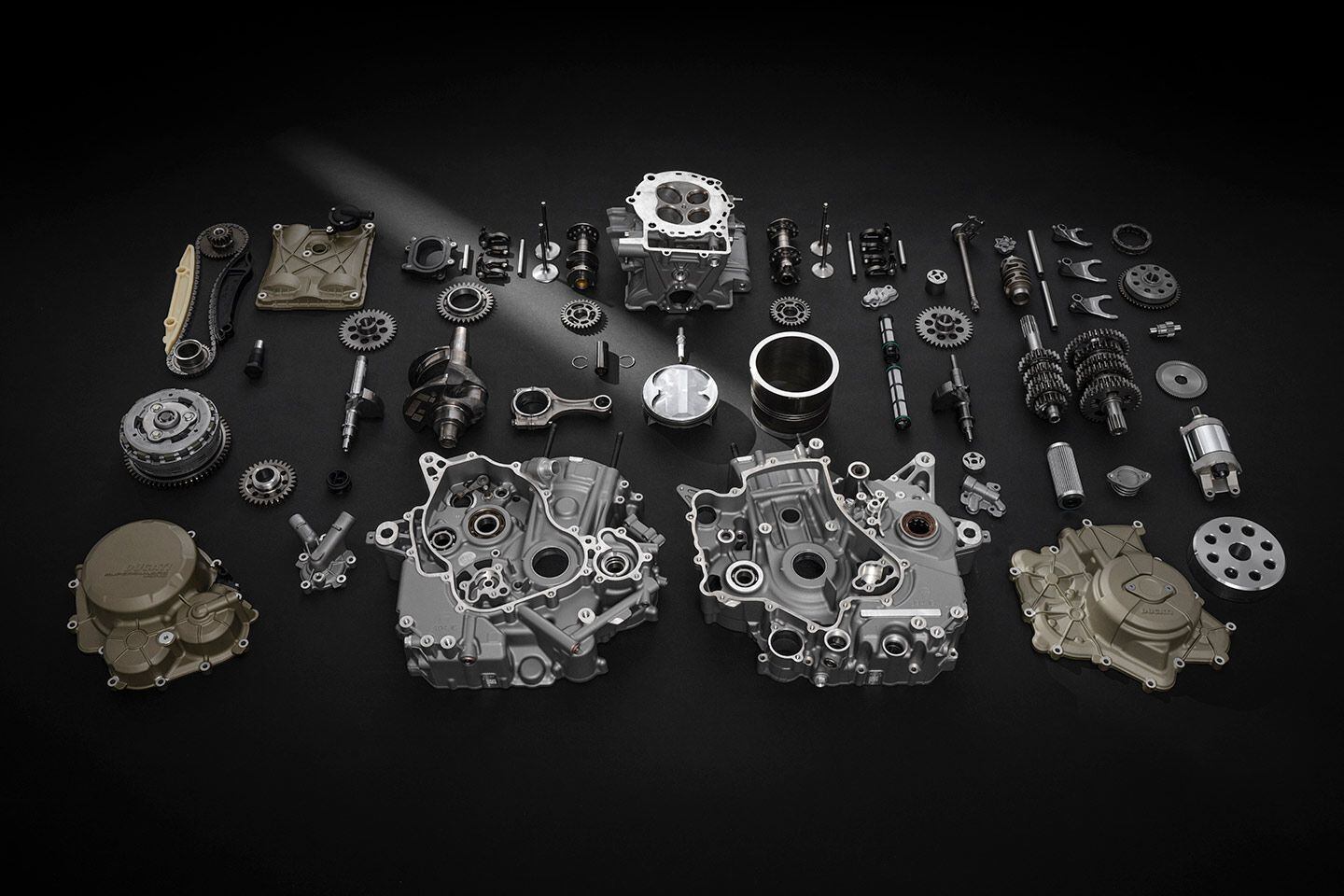
One piston, one rod, two balancers, and a desmo head—Ducati’s 659cc Superquadro Mono engine creates a claimed 77 hp. (Ducati/)Many industries are now motivating buyers with lower prices, and a trusted technique is reduced parts counts. From fewer stages in multimillion-dollar large fan engines for airliners, to the proliferation of twin-cylinder motorcycles in place of traditional fours, this is a clear trend.
Until the coming of Ducati’s recent V-4 engines, the company focus was on meeting or exceeding four-cylinder performance with light, high-revving 90-degree V-twins. Doesn’t it now make sense for Ducati, confronted by the parallel-twin revolution, to use its established less-is-more technology to build high-performance singles?
The key to performance for Ducati’s V-twins was high rpm, made possible by reducing vibration. Ducati quelled the vibration that had kept traditional twins from operating at such high revs by orienting the cylinders at 90 degrees to each other, making it possible to achieve full primary balance.
The Superquadro’s design begins with the least expensive technology: that which is already paid for. That is the cylinder head from its 1299 Panigale, placed atop a new, compact and short front-to-back, vertically split die-cast single-cylinder crankcase. Its name means oversquare, and at 116mm bore by 62.4mm stroke, for a bore/stroke ratio of 1.86 it is more oversquare than any engine in MotoGP (where the limit is set at 1.67). The separate cylinder liner is hard-plated aluminum, as it is in the Superleggera.
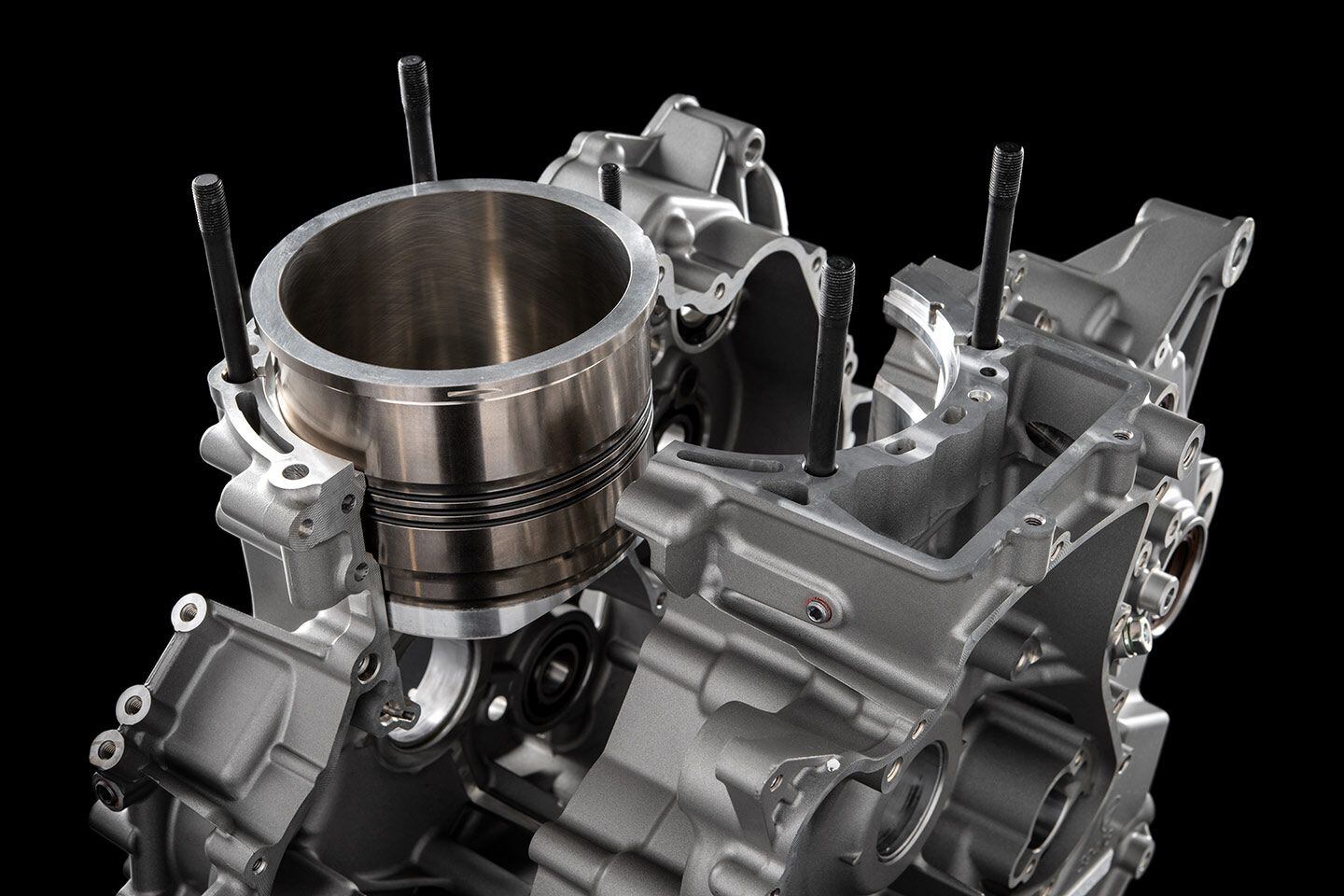
A hard-plated aluminum cylinder is used in the Superquadro. (Ducati/)Engine side covers are of cast magnesium, which has only two-thirds the density of aluminum.
People speak of “oversquare” as if it were a mystic essence, but in fact all a big bore does is make room for valves big enough to fill its cylinder well in the ultrashort times allowed by high rpm. A byproduct of this is a short stroke that, at a given rpm, reduces piston acceleration and the inertia loads on bearings.
By now the reader may object, “But didn’t Ing. Massimo Bordi already design a balanced high-performance Ducati single—the engine of the 1993 Supermono?”
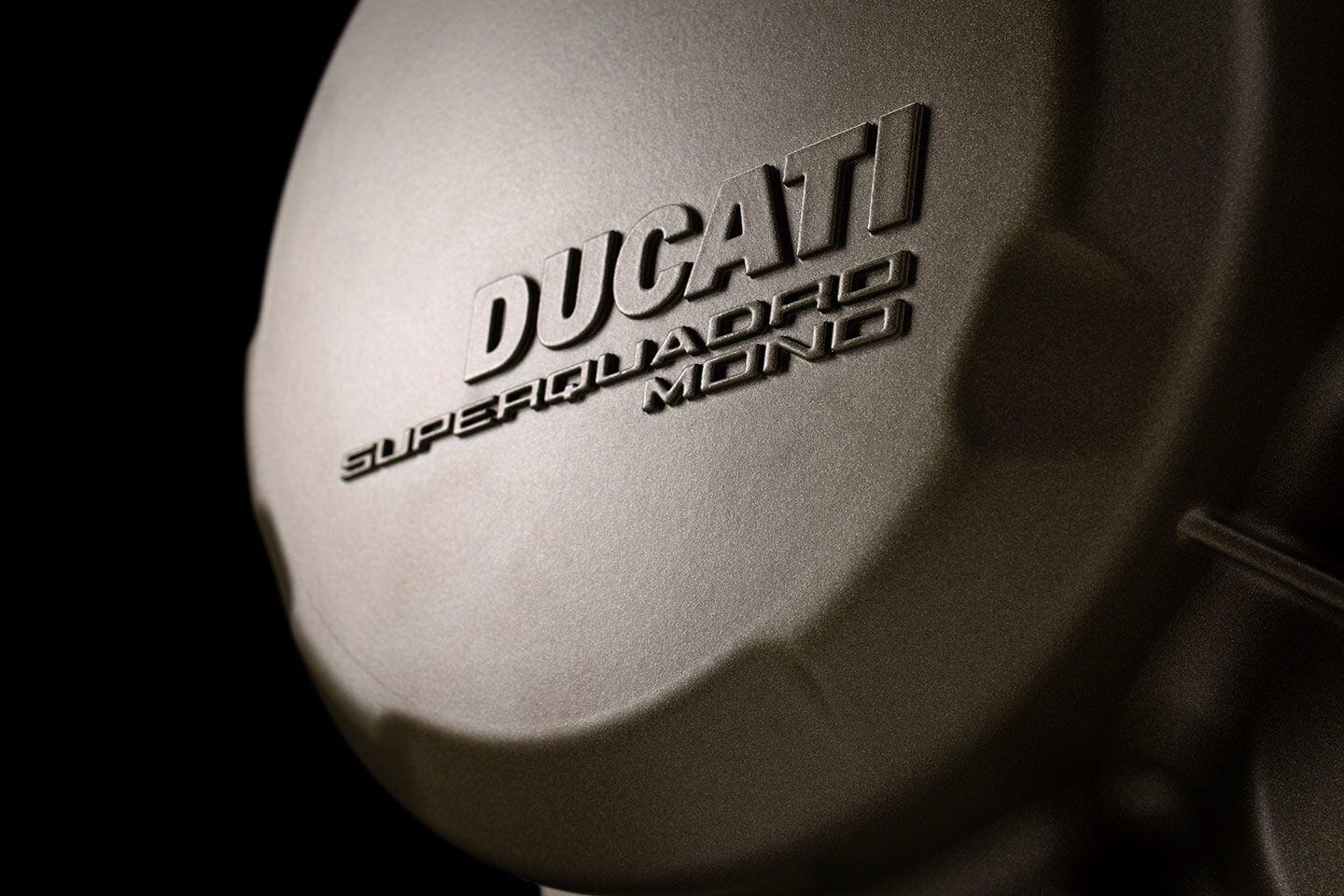
Side covers are magnesium. (Ducati/)That engine was indeed given complete primary balance by providing a second connecting rod, pulling and pushing a piston-simulating weight that oscillated on a lever. But that second rod occupied space that made the engine less compact. Today’s engines in many cases save even more development money by being usable in multiple applications. That requires them to be compact, providing options useful in positioning them in more than one variety of motorcycle.
For that reason, primary balance is achieved in Superquadro via a pair of gear-driven crank-speed shafts—one ahead of the crank, one behind—carrying eccentric weights. In the words of the press release, this “allows the first-order inertia forces to be completely balanced.”
The pumps for liquid coolant and oil are driven from these ball-bearing balance shafts. As in many race engines, an oversized scavenge pump also pulls crankcase pressure down to a partial vacuum.
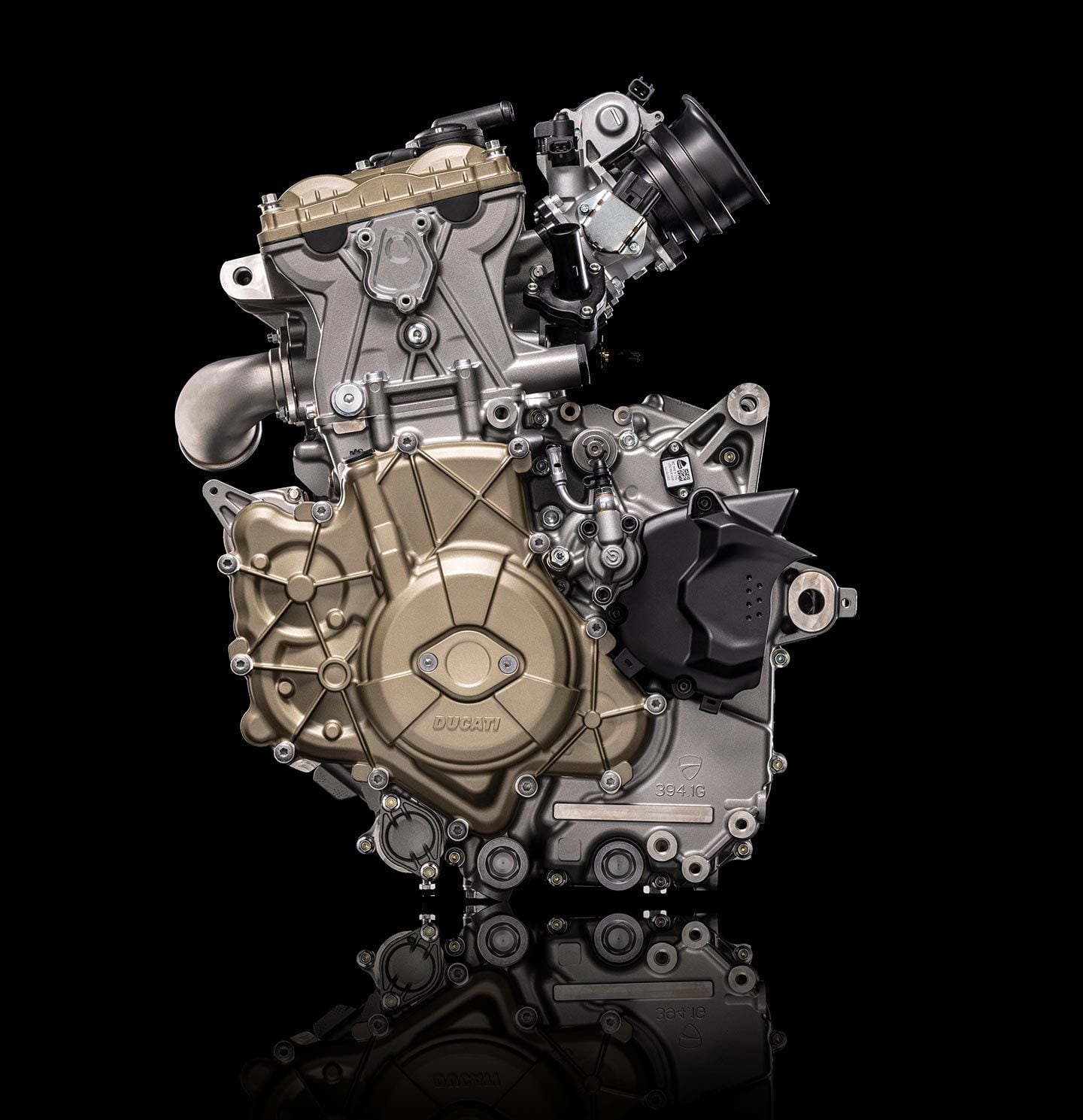
The crankcase is split vertically on Ducati’s Superquadro Mono. (Ducati/)Claimed power measured on an engine dynamometer is 77.5 hp at 9,750 rpm, with torque peaking at 46 lb.-ft. at 8,000, giving “linear, accessible power delivery.” With the optional Termignoni exhaust system, the numbers become 85 hp at 9,500 rpm, with 49 lb.-ft. of torque.
This is made possible by use of the same valve diameters as in the 1299: 46.8mm titanium intakes and 38.2mm steel exhausts. The usual desmodromic mechanism in the head (opening and closing the valves by cam-driven levers—there are no valve springs) provides “extreme levels of valve lift.” Valve lift is not stated.
The tremendous 116mm piston (4.57 inches—bigger than that of a big-block Chevy) is very short; little more than a disc to carry the rings, braced under its crown by the usual four crisscrossing beams, with skirts of minimal height to guide it in the cylinder bore. We must assume there are oil jets to cool such a large piston, but they are not mentioned in the release.
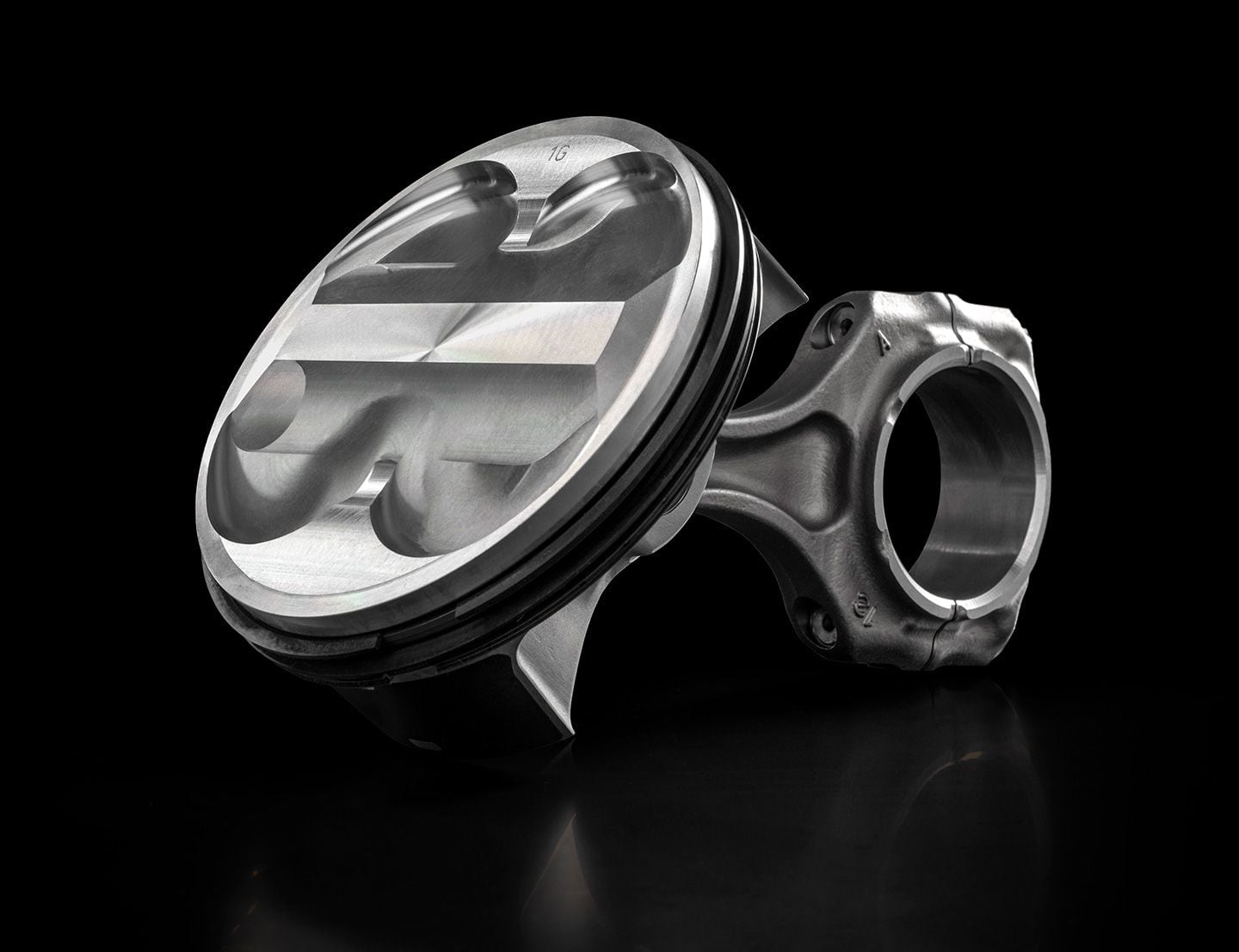
Nearly eclipsed by the 116mm piston, the fracture-split connecting rod is ultrashort. (Ducati/)The fracture-split steel connecting rod will look out of proportion to you because it’s so short, yet its big-end is nearly an inch wide. This is because con-rod length is proportioned to the stroke (which is short) while bearing area must be proportioned to the applied load. Rods in the 1299 are 110mm long for a shortish rod ratio of 1.81 (110/60.8). Ducati usually chooses rod ratios in the range of 2.0 to 2.2, but it needed to reduce the external dimensions of the 1299 engine.
Applied load? If a peak combustion pressure of 1,200 psi is achieved, peak compressive force on the con-rod peaks at 20,000 pounds, or 10 tons. And that, dearly beloved, is why the con-rod’s big-end is so wide—to provide the necessary area of plain bearing to carry that load. The crankshaft also spins on plain main bearings—introduced on Supermono by Bordi who originally intended to apply to future twins. They finally arrived in the Panigale.
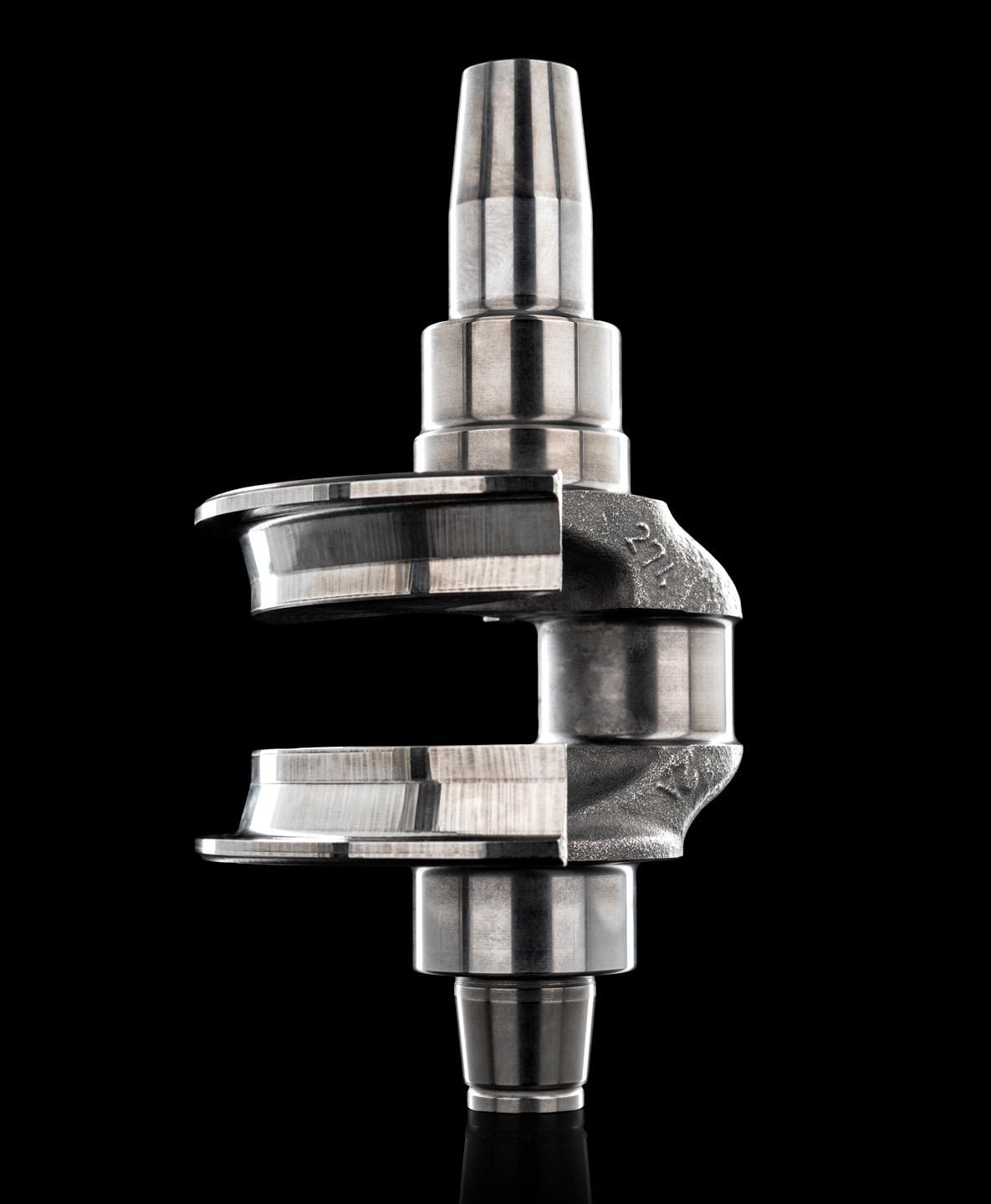
The crankshaft runs on plain bearings, just like the 1299 Panigale. (Ducati/)How well does this engine breathe and burn? The arithmetic tells us it represents a pullback of about 17 percent from 1299-level performance, probably resulting from some reduction of compression ratio (it was 12.6:1 in the 1299) and maybe from valve timing changes. Although, in the latter case, the presence of deep valve clearance cuts in the piston crown suggest there is still significant valve lift at TDC, end of exhaust stroke. Compare with the relatively smooth piston crowns of the previous-generation Diavel, which has very little valve overlap. For that reason Diavel engineers have referred to it as “the 11-degree.”
This power and torque pullback is necessary: A large-displacement engine has oomph a single lacks, making some torque-broadening compromise useful. This is confirmed by the press release, which says first gear (of six) is “strategically long” to maximize acceleration from slow corners. Optional Ducati Quick-Shift up-and-down is available.
Superquadro’s DOHC are driven by chain from crank to a central combined sprocket and gear at the top, from which a gear on each cam takes the drive. The multiplate clutch is of slipper/assist type to both lighten lever pull and prevent dragging/hopping of the back tire by the compression braking of that giant piston (could also be a cogent reason to reduce compression ratio somewhat!).
A traditional concern of Ducati owners has been short valve-clearance adjustment intervals. In Superquadro valve-clearance check is set at 18,000 miles, like so many of Ducati’s other models now.
The single oval-section throttle body has the area of a 62mm (2.44 inches) round hole, with a single under-the-butterfly injector. Operation is throttle-by-wire.
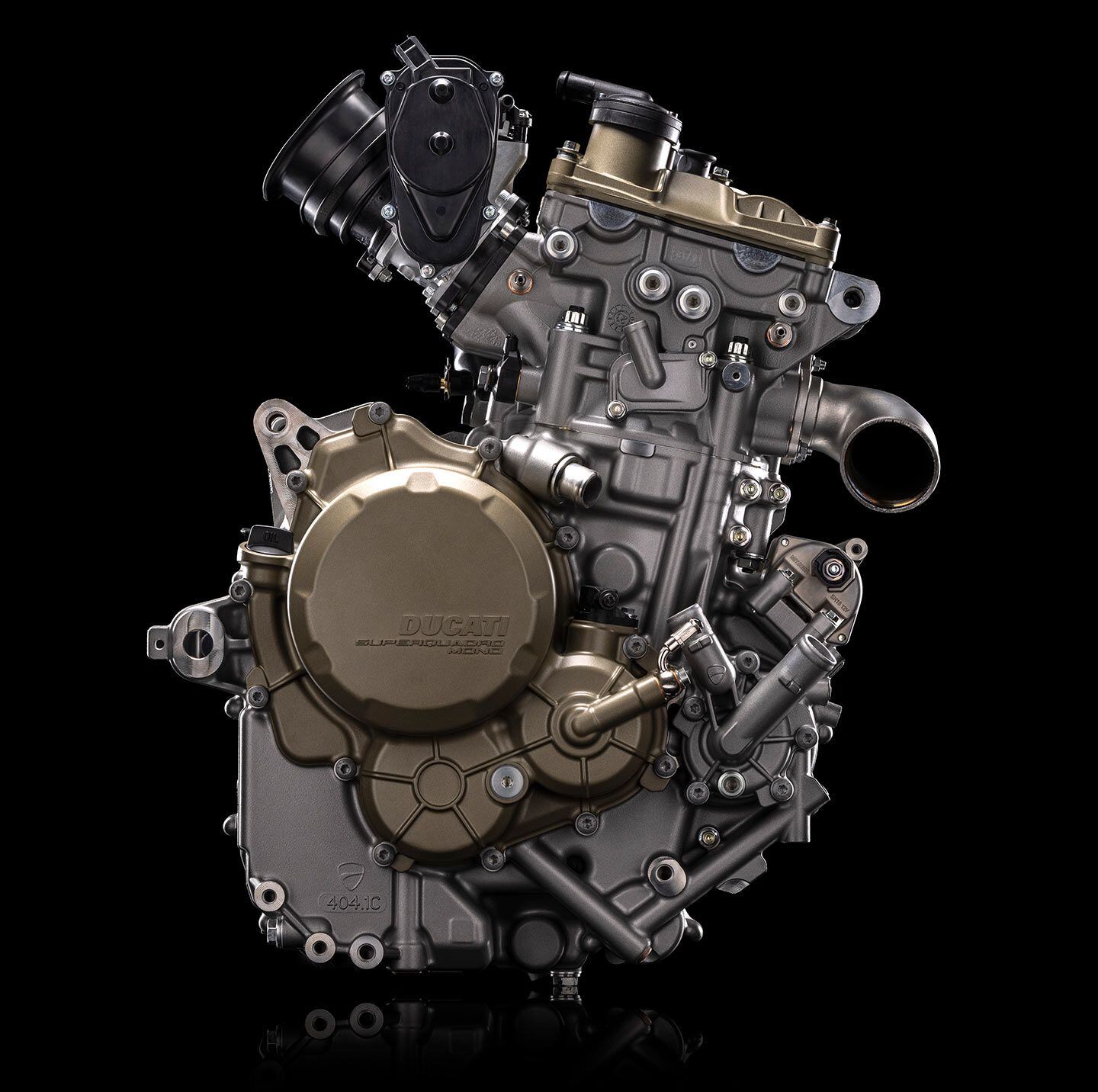
An oval-section throttle body of 62mm equivalent round diameter feeds the Superquadro Mono. (Ducati/)Ducati has also said it will build motocross bikes, but whether 250 or 450 is not revealed. Might Superquadro be a challenger in Dakar-style events? Singles have always offered advantages in off-road operation. Who can say? On the street, Superquadro’s acceleration will compare favorably with that of recent light/middleweight twins, and its simplicity can offer reduced weight. The compactness of its design, combined with the ability to change engine character either through electronics or via valve timing and intake/exhaust changes, will allow it to serve in multiple applications.
Singles lovers, arise!
-
 1
1
-
-
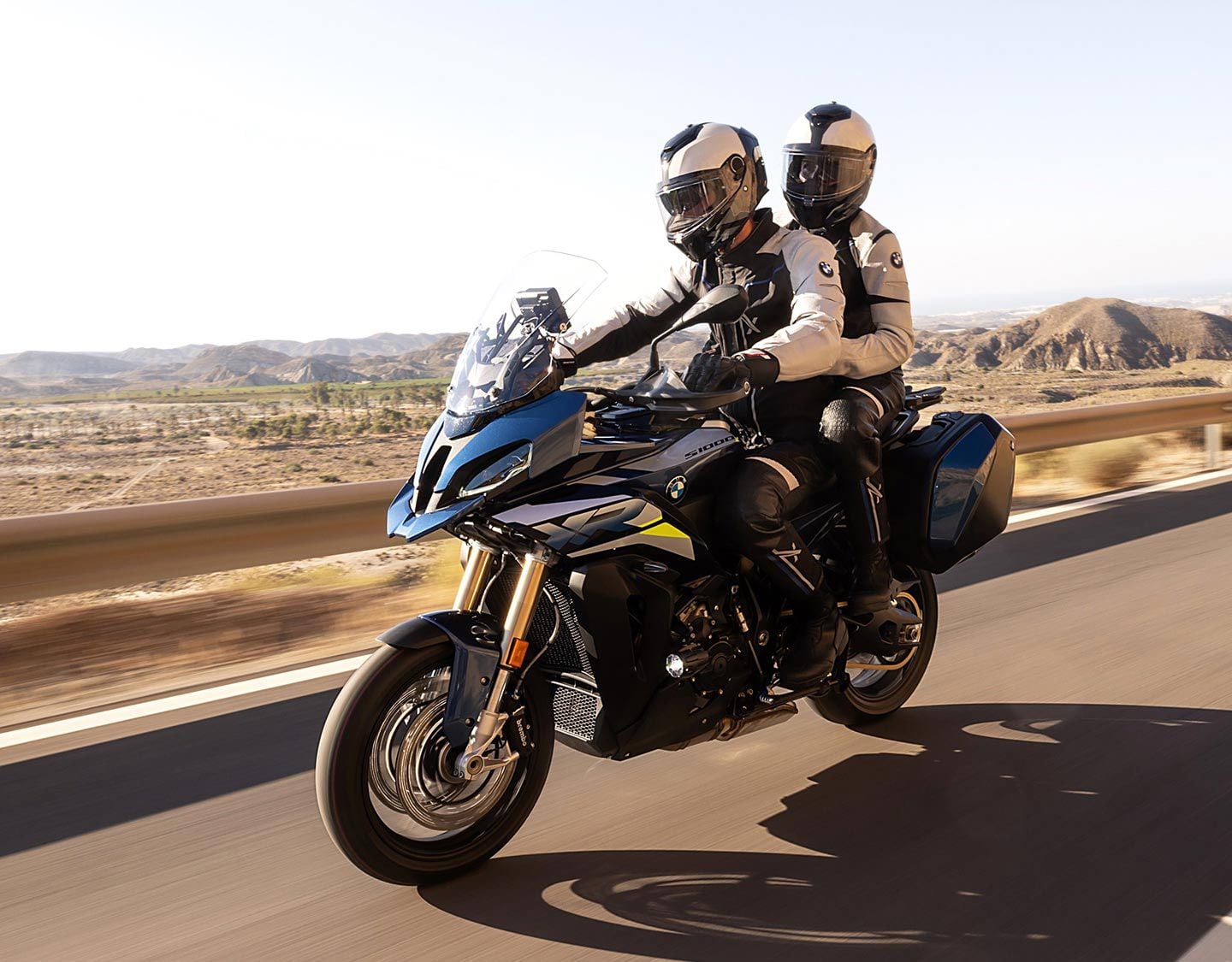
BMW gives the S 1000 XR more horsepower and revised ergonomics for 2024. (BMW/)BMW Motorrad has pulled the wraps off two new XR sporting models for 2024, in the form of the S 1000 XR and the new M 1000 XR. The S 1000 XR gets a raft of updates, including more power, while the M 1000 XR debuts as the third member of BMW’s high-performance M family, joining the M 1000 R and M 1000 RR.
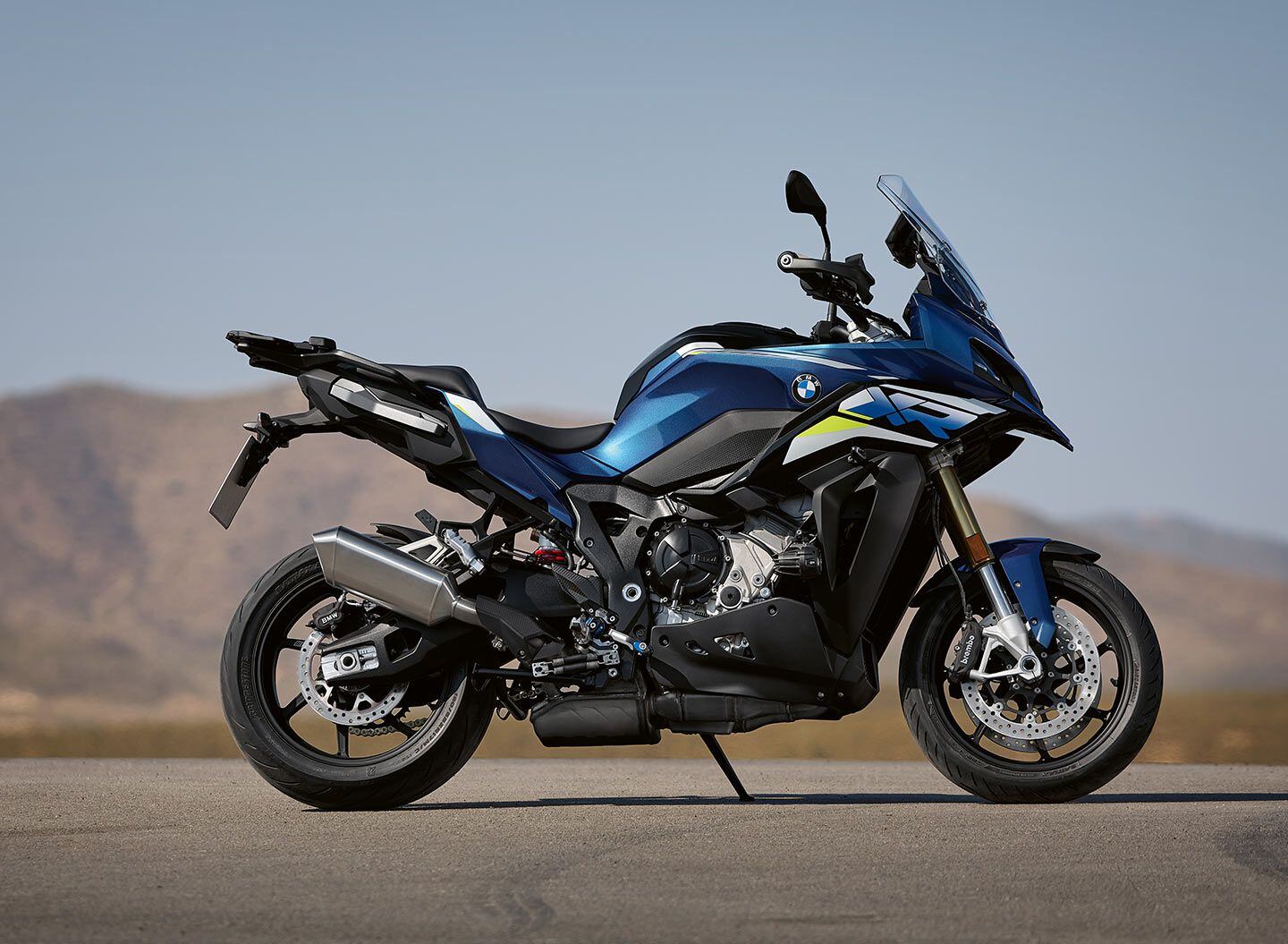
The BMW S 1000 XR in Gravity Blue Metallic; MSRP is $17,495. (BMW/)2024 BMW S 1000 XR
The key change for the S 1000 XR—which shares its inline four-cylinder engine with the S 1000 RR—is a substantial increase in horsepower compared to the 2023 model. For 2024, BMW claims 170 hp, which was achieved by optimizing intake channel airflow and revising the engine maps. That’s 5 hp more than last year and it comes at the same 11,000 rpm to boot. Torque is unchanged with 84 lb.-ft. arriving at 9,250 rpm.
Ergos on the 2024 S 1000 XR were subjected to a good deal of refinement as well with the seat of the long-distance sportbike completely redesigned to serve up an extra 0.4 inch of seat height, which now measures 33.5 inches. The seat’s usable length and width were boosted, making it easier to shift butt cheeks during changing riding conditions for better control, and three different seat heights are available. The suspension has also been tweaked to offer more spring preload.
Related: 2024 BMW M 1000 XR Prototype Teased
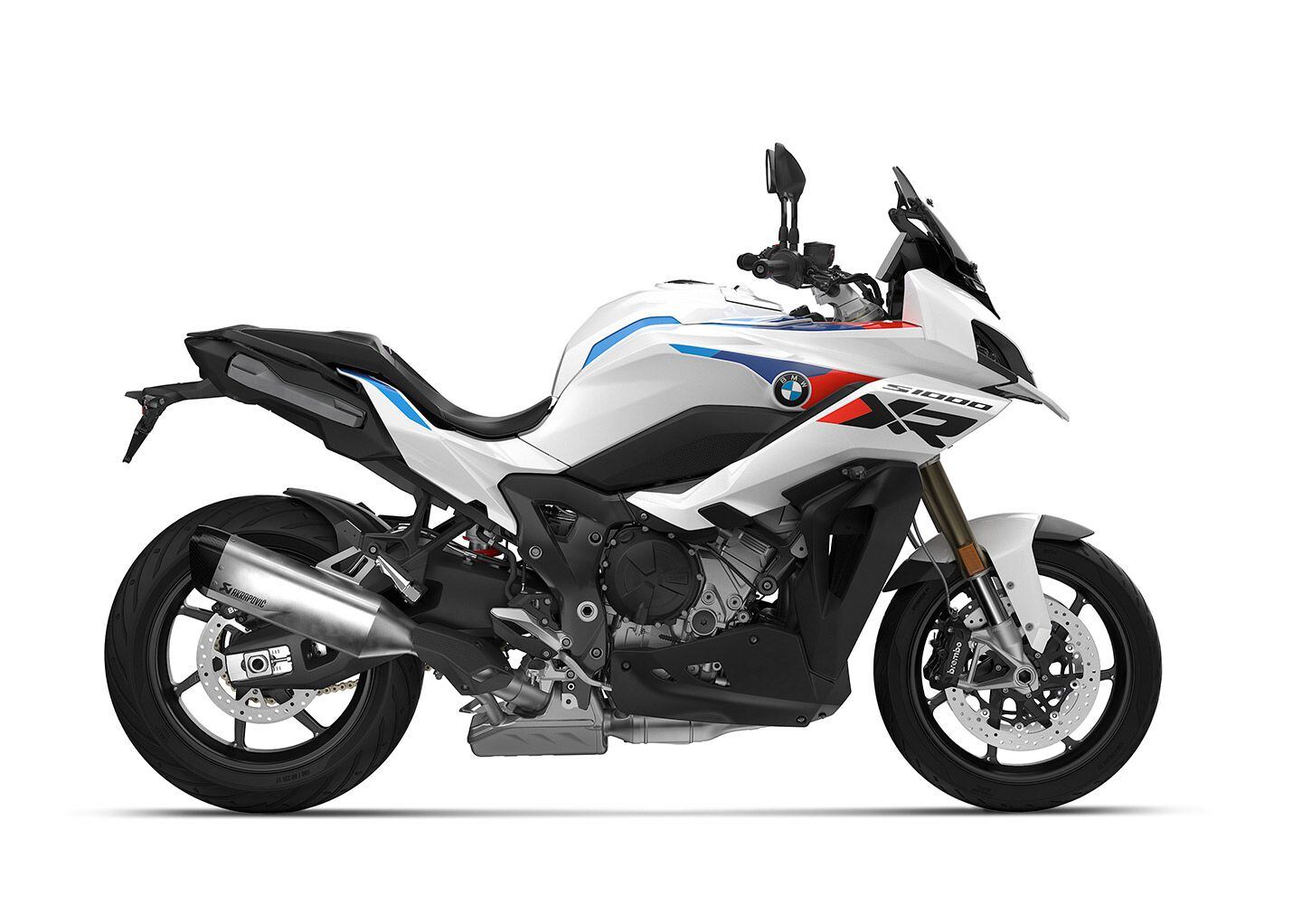
Visual refinements include new rear side panels and new colors. Here’s the Light White option. (BMW/)The Shift Assist Pro feature has been refined for more precise shifting, and the adaptive Headlight Pro has been added as standard equipment. The new model also offers Keyless Ride and upgrades the 9Ah battery to a 12Ah capacity unit, and a USB charging socket is now standard.
BMW addressed cosmetics for 2024, giving the rear section new side panels and air intakes for a sharper look. Additionally, the radiator trim gets a textured surface, and the previously black-colored front fender is now painted in the body color.
With those refinements come new colors for 2024, with Blackstorm Metallic 2 as the standard choice, and Gravity Blue Metallic (Style Sport) or Light White/M Motorsport (M Package) as options. BMW quotes MSRP at $17,495, and the bike will be available sometime in the second quarter of 2024.
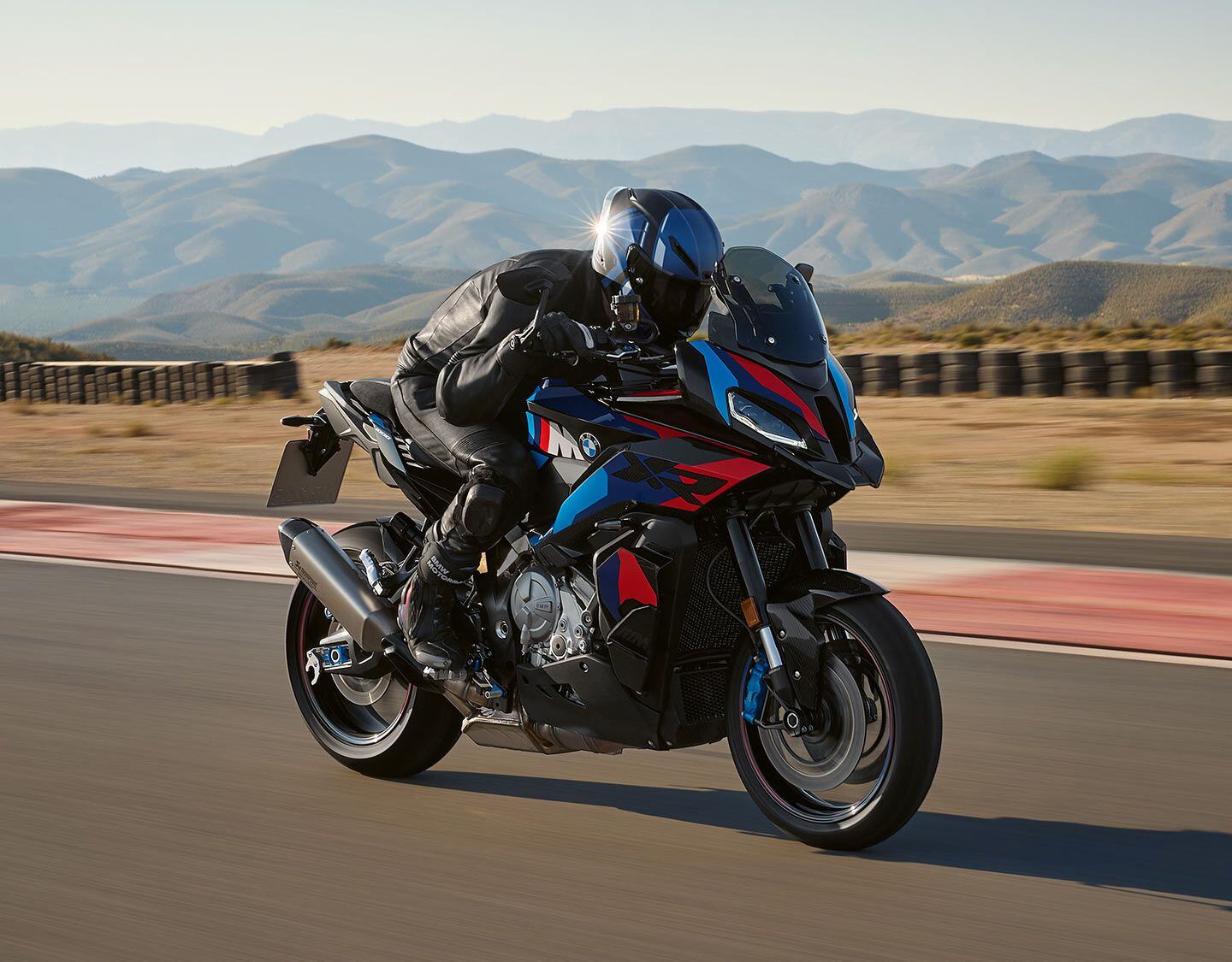
Meet the newest member of BMW’s M series, the 2024 M 1000 XR. (BMW/)2024 BMW M 1000 XR
The third and newest member of BMW Motorrad’s M series rolls in with the same high-performance aims as its M 1000 R and M 1000 RR brethren, with BMW describing the 2024 M 1000 XR as “the lightest and most powerful cross-over motorcycle in the world.” Take from that what you will, but it’s still based on the current S 1000 XR and S 1000 RR, and tuned to a level of performance and exclusivity the M series is meant to convey. That means the M 1000 XR uses the same rip-snorting inline four-cylinder ShiftCam mill as the M 1000 RR, with a peak of 201 hp at 12,750 rpm—or 31 hp more than in the new S 1000 XR. Max torque is still 83 lb.-ft. at 11,000 rpm, but maximum engine speed on the M XR has been increased to 14,600 rpm.
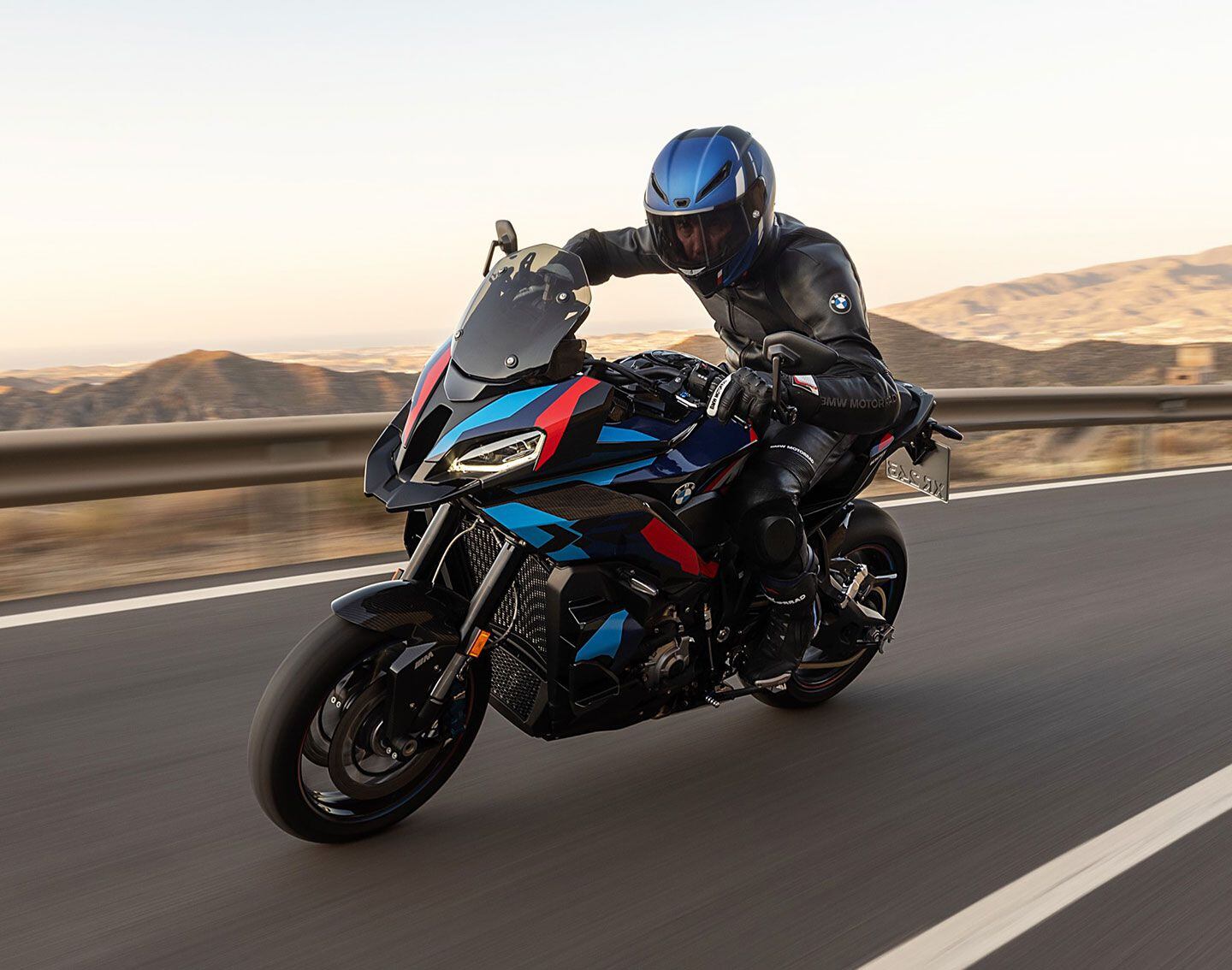
BMW says the new M-XR is more powerful and accelerates quicker than the S 1000 XR. (BMW/)BMW claims the new M-XR engine is significantly more powerful than the four-cylinder of the S 1000 XR across the entire rev range; in particular, acceleration and pulling power in conjunction with the shorter final gear ratio have been noticeably increased. Much of that has to do with lighter engine internals and optimized intake flow, but the M-XR also gets a shorter secondary gear ratio via use of a 47-tooth sprocket as opposed to the S 1000 XR’s 45 teeth, and the new M’s fourth, fifth, and sixth gear ratios are shorter as well. Out back, a new, lighter exhaust system with short, compact rear titanium muffler features two catalytic converters and a more steeply angled titanium rear muffler.
As expected, four adjustable throttle maps are available for optimum response, with Rain, Road, Dynamic, and Race, and Race Pro1–3 as well as the latest generation of Dynamic Traction Control (DTC) and DTC wheelie function with a six-axis sensor. This being an M bike, there are other rider aids galore, like Shift Assist Pro, Launch Control, Pit Lane Limiter, and Hill Start Control Pro. There’s even a Brake Slide Assist feature for those looking to really get their drift on.
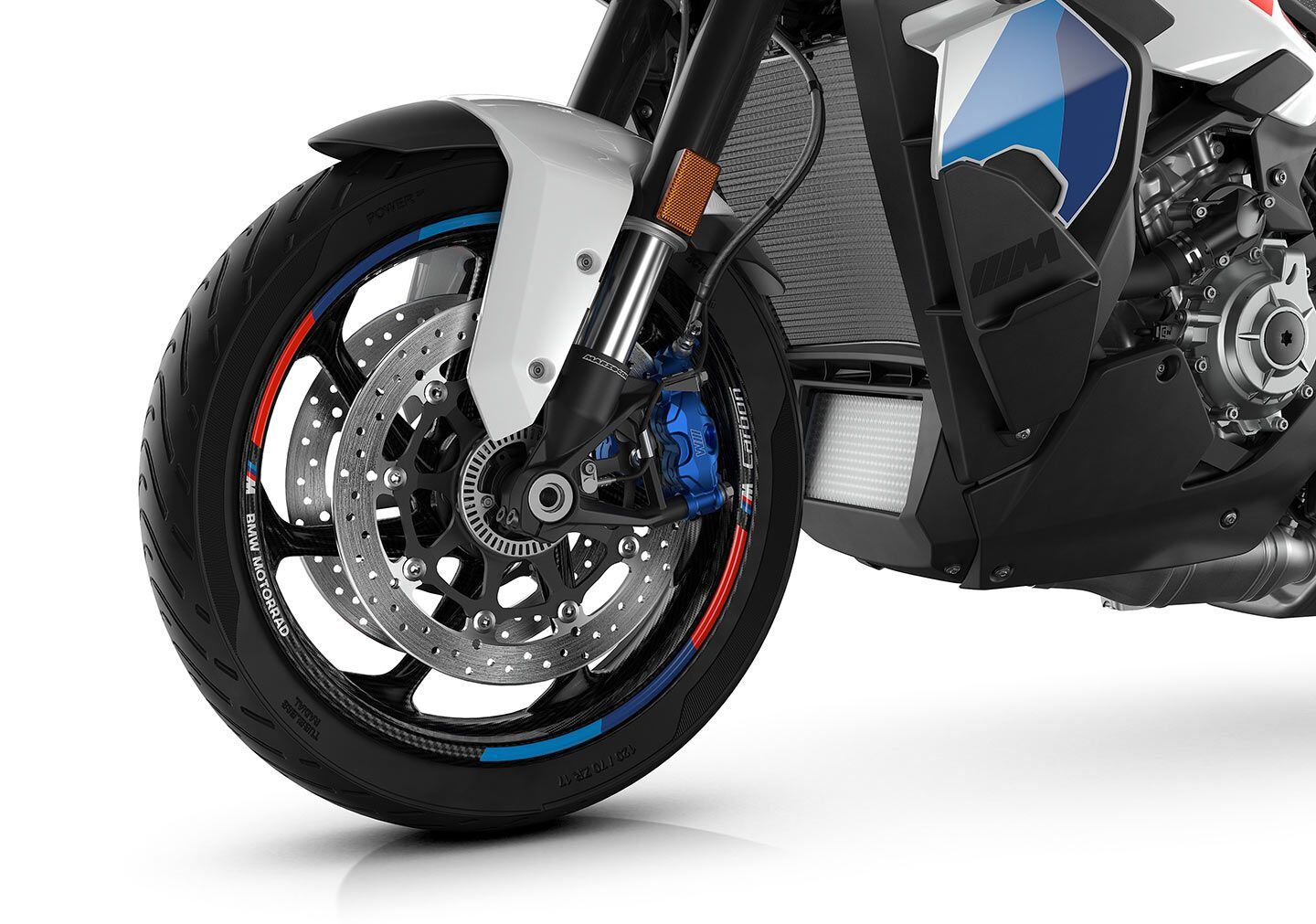
The newest M bike shares the distinctive blue calipers seen on the other two M models. The 45mm fork tubes offer separate compression and rebound functionality. (BMW/)Suspension, too, is upmarket, with the M 1000 XR getting 45mm fork tubes with separate compression and rebound functions for the two legs along with Dynamic Damping Control (DDC), BMW’s new generation of electronic damping adjustment, as standard features. Just below the fork legs you won’t miss the blue anodized calipers shared with the M 1000 RR and the M 1000 R, which work on twin 320mm discs.
The new M 1000 XR’s large, 6.5-inch TFT display should be familiar to those with M series machines, offering a similar feel and layout, but with datalogging options for track junkies. An optional M Competition Package might appeal to those who are serious about lap times, with a host of carbon bits that amount to a more than 6 pound weight loss.
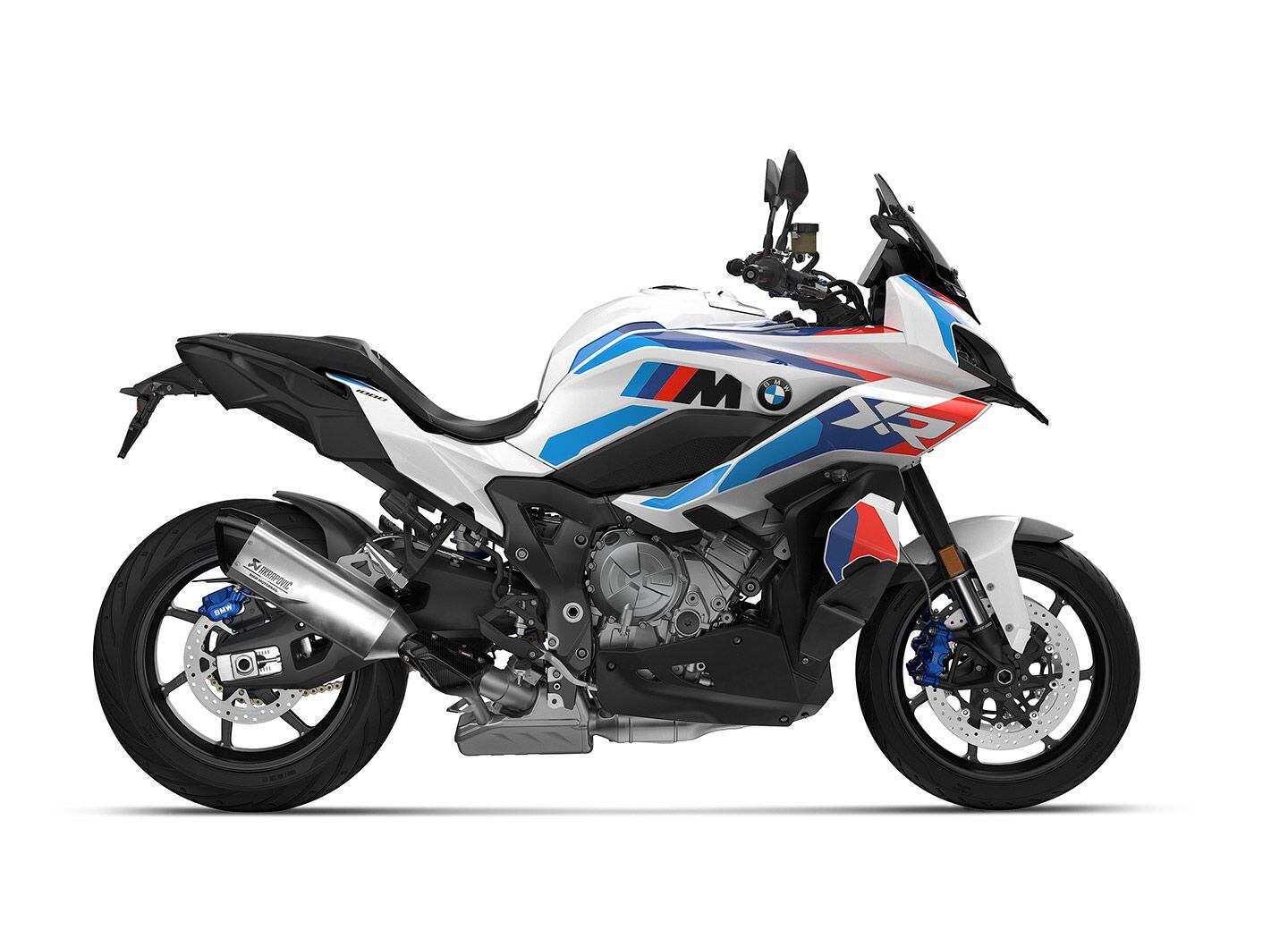
The 2024 BMW M 1000 XR in the basic Light White color scheme. MSRP is $24,295. (BMW/)M-specific colors and M branding are sprinkled throughout, with a granite gray engine cover, black fuel filler cap, and blue spring on the rear shock further distinguishing the M bikes. An embroidered M logo decorates the seat, which is available in three heights (32.3 inches, 33.5 inches, or 34.3 inches). Colors include high-contrast basic Light White version or the M Competition Package with high-gloss Blackstorm Metallic paintwork and high-gloss carbon fiber side panels. Both variants include the M graphic language of light blue/dark blue/red.
MSRP for the 2024 M 1000 XR is $24,295, with the estimated launch coming in Q2 of 2024.
-
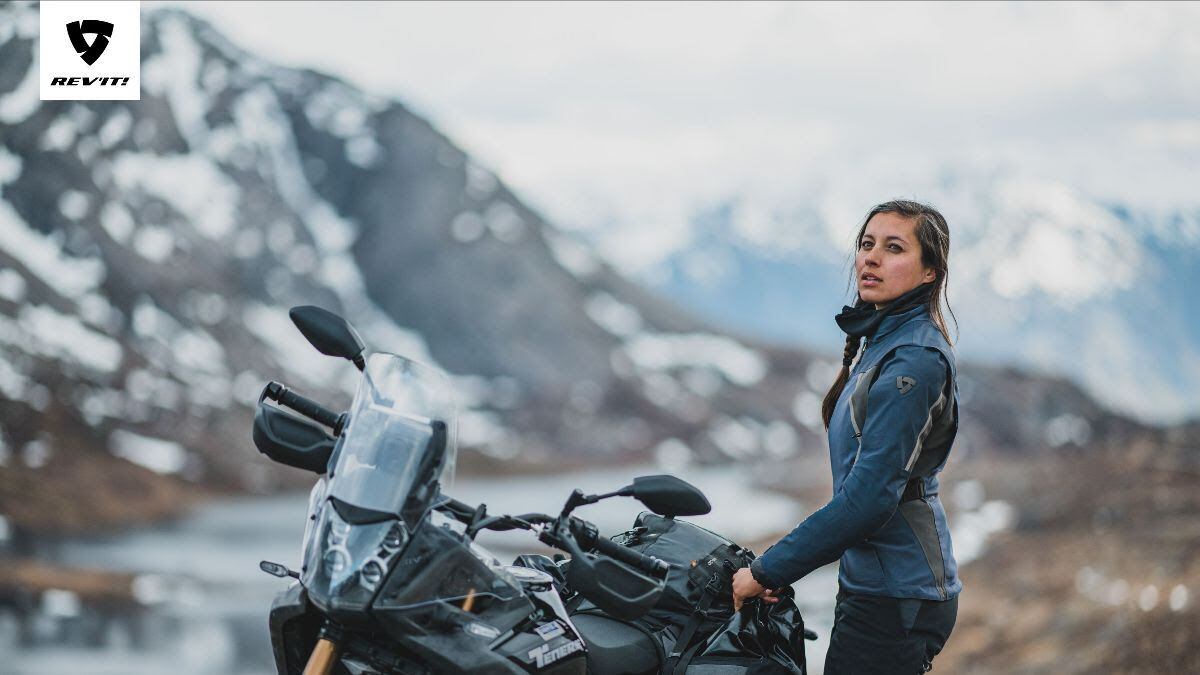
REV'IT! Lamina GTX Ladies (REV'IT!/)REV’IT! Press Release:
REV’IT! has launched its all-new essential women’s GORE-TEX outfit – the Lamina GTX Ladies. Paving the way for all-season Adventure Travel excursions whether on and off the beaten path. Both the Lamina GTX Ladies jacket and Lamina GTX Ladies pants are yours to explore at your official REV’IT! dealer and right now. Pricing and sizing details below.
Design by dialogue
Made with a completely new approach to REV’IT!’s design and development process, the Lamina GTX Ladies jacket and pants provide an unrivaled female-specific cut and fit. By uniquely designing both the jacket and pants in 3D – directly on a bust – instead of the conventional two dimensions, REV’IT! has been able to achieve fit-focused riding comfort that raises the bar on women’s adventure travel outfits. Design by dialogue, REV’IT! calls this approach.
Breeze through long days
On top of the kind of comfort that will see riders breeze through long days on the bike, Lamina GTX Ladies outfit is above all engineered to take on multiple seasons in one day. All thanks to its 100% waterproof construction of lightweight and laminated GORE-TEX fabrics, and premium waterproof zipper technology from industry leaders TIZIP®. This is offset by clever and effective ventilation integrated into the progressive, outdoor scene-inspired outer shell design to offer a fine balance in terms of functional tech and high-end aesthetic appeal.
With safety and in style
Assuring Design, Performance, and Innovation are all accounted for, the Lamina GTX Ladies outfit – both jacket and pants – offers top-tier protection with a CE Class AA safety rating. REV’IT!’s proprietary CE-level 2 SEESOFT AIR back protector, CE-level 2 SEEFLEX armor at shoulders, elbows, and knees, and CE-Level 1 SEESMART at the hips are included as standard to ensure wearers ride with safety and confidence, and in style. Wherever adventure may take riders.
-
I had an adventurous couple of weeks with the new Honda XL750 Transalp – check out my review of the bike and see how I got on

https://www.webbikeworld.com/2023-honda-xl750-transalp-review/
You can also check out my ride and review video here:
The post Honda XL750 Transalp review appeared first on BikerKaz.
-
The new Stelvio is the culmination of Moto Guzzi’s rich heritage and cutting-edge technology.
-
SW-Motech’s new Drybag collection boasts enhanced versatility and comes in an assortment of sizes.
-
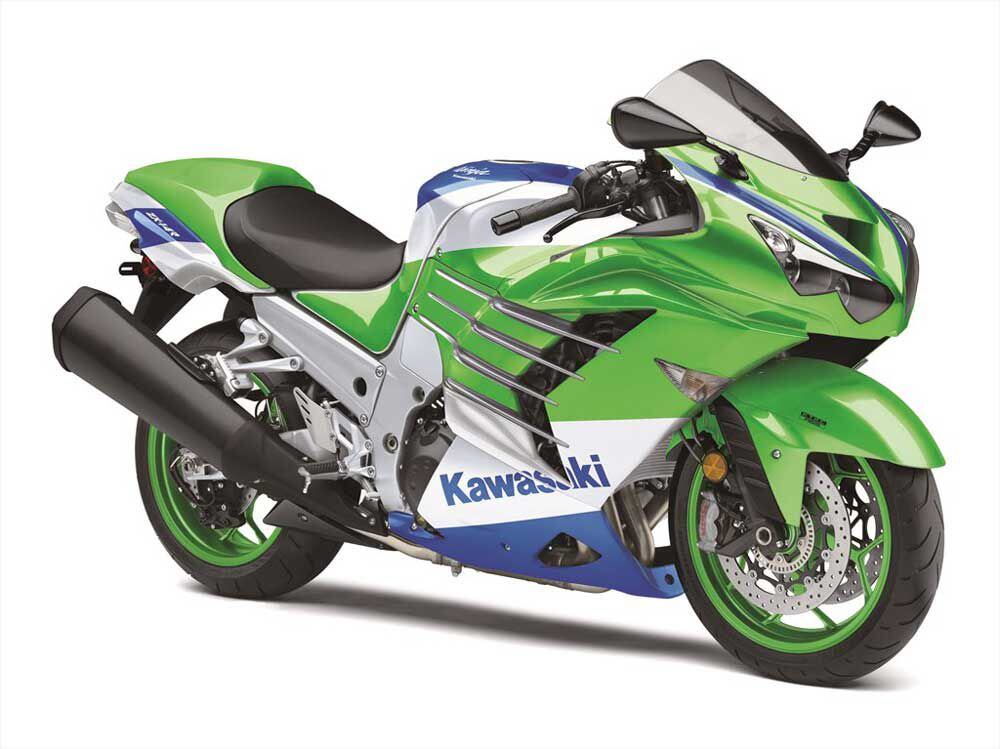
Kawasaki marks a milestone with this special Lime Green/Pearl Crystal White/Blue livery on the 2024 Ninja ZX-14R 40th Anniversary Edition ABS. The supersport will return to dealership floors just for this special 40th anniversary celebration; MSRP is $17,249. (Kawasaki/)Last summer, Kawasaki was quick to point out it had been making motorcycles since 1962 with a series of events around the world. Now, it’s time for Team Green to party like it’s 1984, with a new celebration that fetes the brand’s American-born Ninja model on its 40th anniversary. In marking the milestone of what’s clearly been a highly successful run in the powersports industry, Kawasaki has announced the 2024 Ninja 40th Anniversary Edition motorcycles.
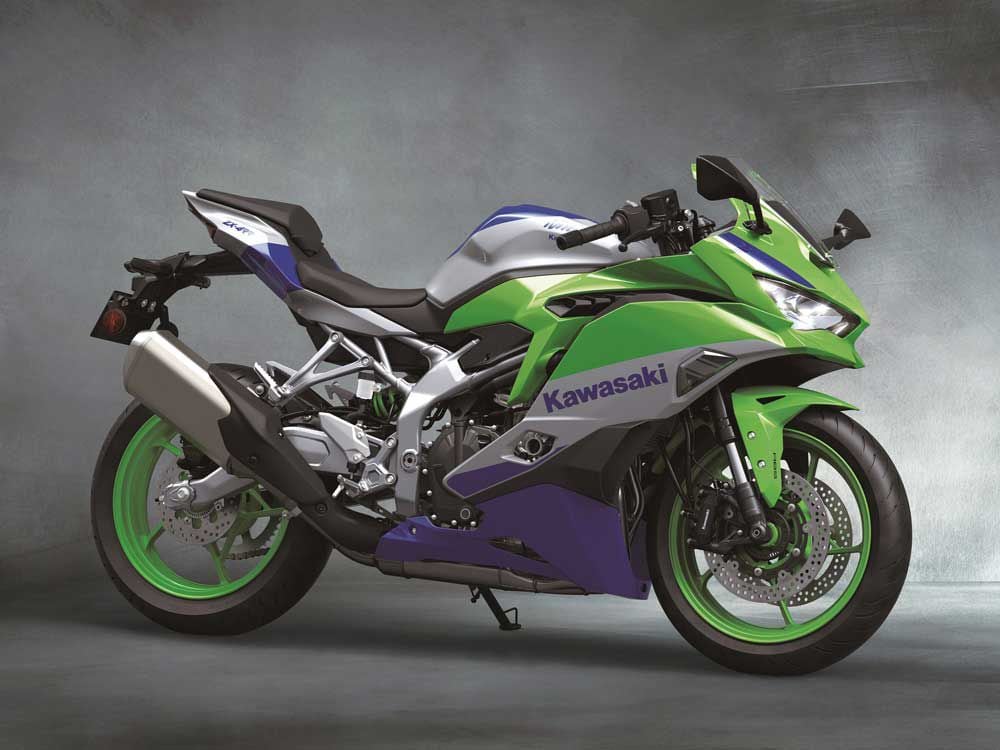
The lightweight, track-ready 399cc ZX-4RR ABS will also be available in the anniversary color, with an MSRP of $10,299. (Kawasaki/)In the 40 years since its inception—when Kawasaki officially rebranded the famous GPz900R in 1984—Ninja has become one of the most recognizable nameplates in the biz. In the late 1980s, you couldn’t crack open a race report without seeing Kawasaki’s Ninja ZX-7 somewhere on the pages, and the slippery racer became the brand’s most reliable track weapon in the FIM Endurance World Championship, finding its way to the top of the podium in 1991, 1992, and 1993. It was much the same story in the US, with Kawasaki ripping through the competition in AMA Superbike on its way to four additional titles in 1990, 1992, 1996, and 1997, for a total of nine overall championships in the series. With a record like that, it’s understandable that Kawasaki is releasing special Ninja ZX-7-inspired colors for the Ninja ZX-4RR ABS, Ninja ZX-6R ABS, Ninja ZX-10R ABS, and Ninja ZX-14R ABS in addition to the standard colors, for a small premium over the base model MSRP.
Sure, Kawasaki is kinda jumping the gun a bit here, but the brand is quick to clarify that it’s rolling out the bubbly for model year 2024—-which is the actual 40th anniversary of Ninja.
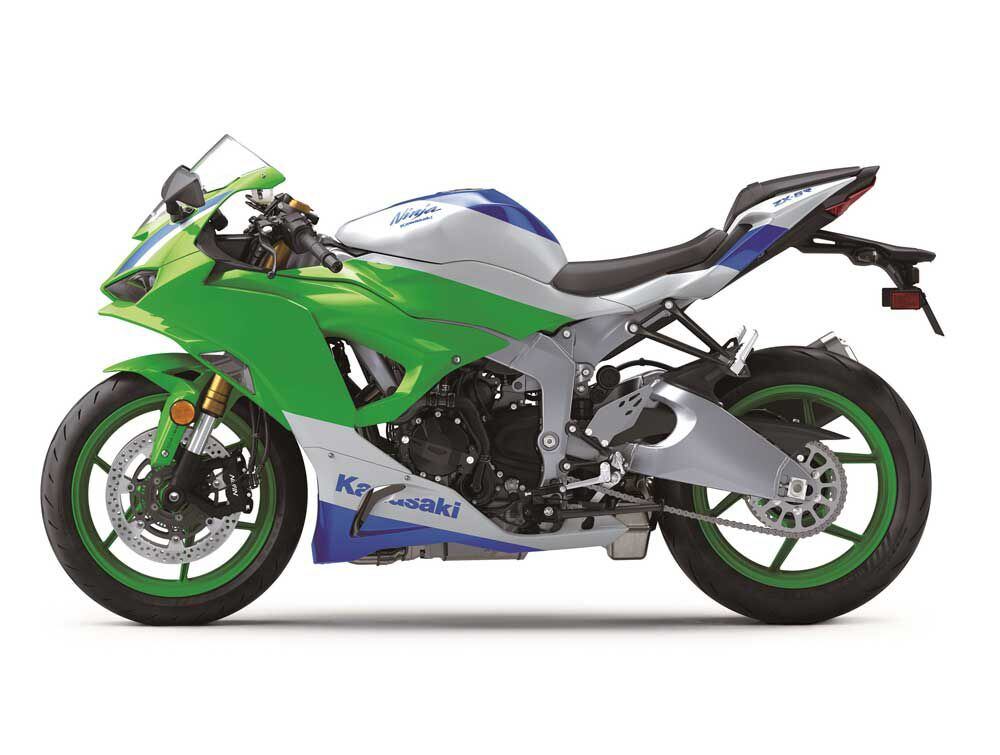
The 2024 Kawasaki Ninja ZX-6R 40th Anniversary Edition ABS with the special three-color livery and gold fork tubes; MSRP is $12,649. All the anniversary bikes also receive a unique Kawasaki logo on the fairing. (Kawasaki/)With so-called “anniversary bikes,” you don’t expect to see much divergence, mechanical or otherwise, from the standard models, and so it is with these Kawasakis. Each of the anniversary bikes does, however, get a special three-color livery, with a large “Kawasaki” logo on the fairings and specially painted lime green wheels. Kawasaki says the logos are faithfully reproduced from original drawings, with various other elements specially designed to evoke “memories of the Ninja ZX-7″ series’ historic wins. That includes things like a special 40th Anniversary emblem designed to resemble a championship sticker atop the fuel tank, and displacement numbers on the tail cowl based on fonts used in the ‘80s and ‘90s. The Ninja ZX-10R, Ninja ZX-6R, and Ninja ZX-4RR get silver-painted frames and swingarms, while the gold fork outer tubes on the Ninja ZX-10R and Ninja ZX-6R are meant to give off a throwback vibe.
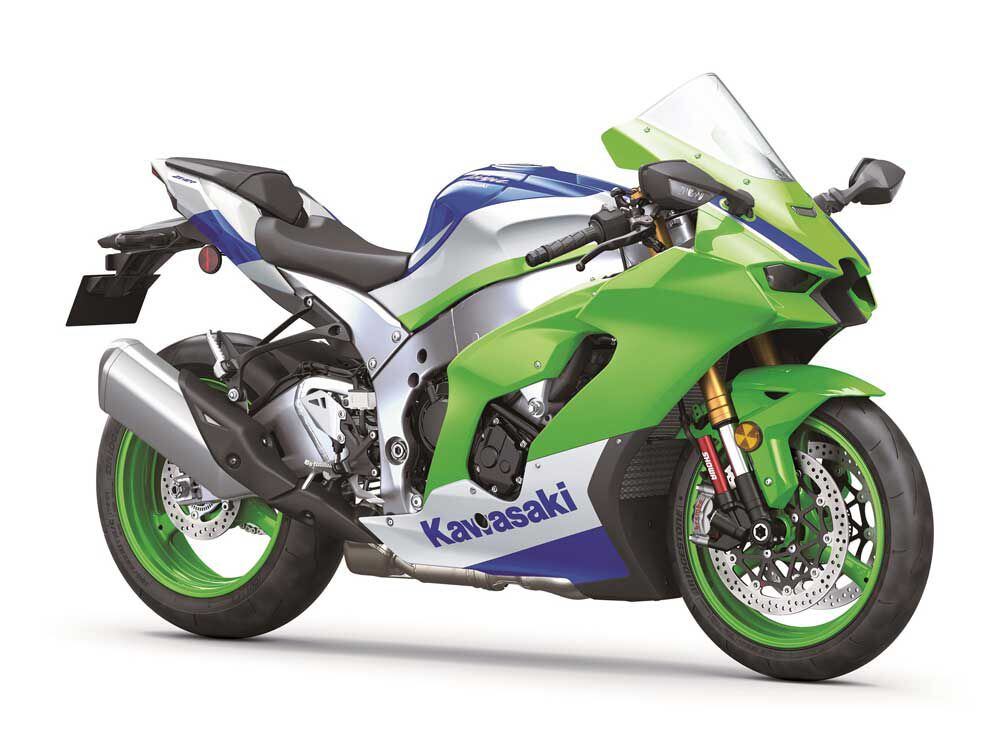
The Ninja ZX-10R 40th Anniversary Edition in Lime Green/Pearl Crystal White/Blue with silver-painted frame. MSRP is $19,149. (Kawasaki/)The Ninja definitely deserves a celebration after a historic four decades; we called it “a hard-core performance motorcycle aimed directly at the hard-core performance rider” for our 1984 Ten Best list.
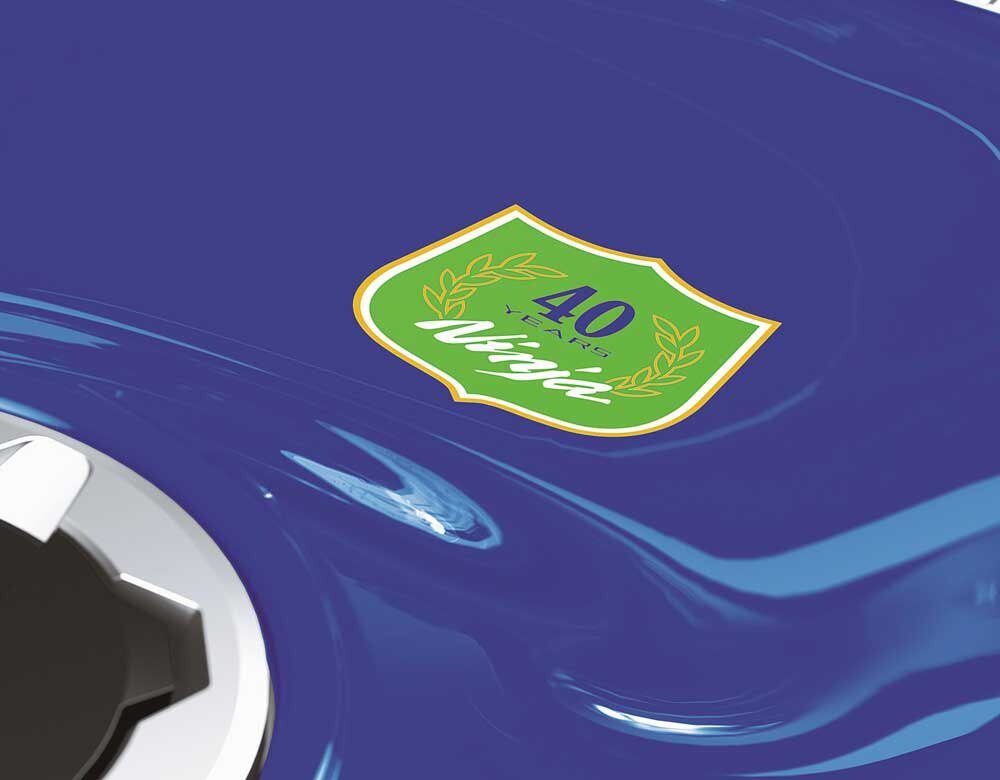
Each anniversary model gets a special 40th Anniversary emblem designed to look like a championship sticker on the fuel tank. (Kawasaki/)-
 1
1
-
-
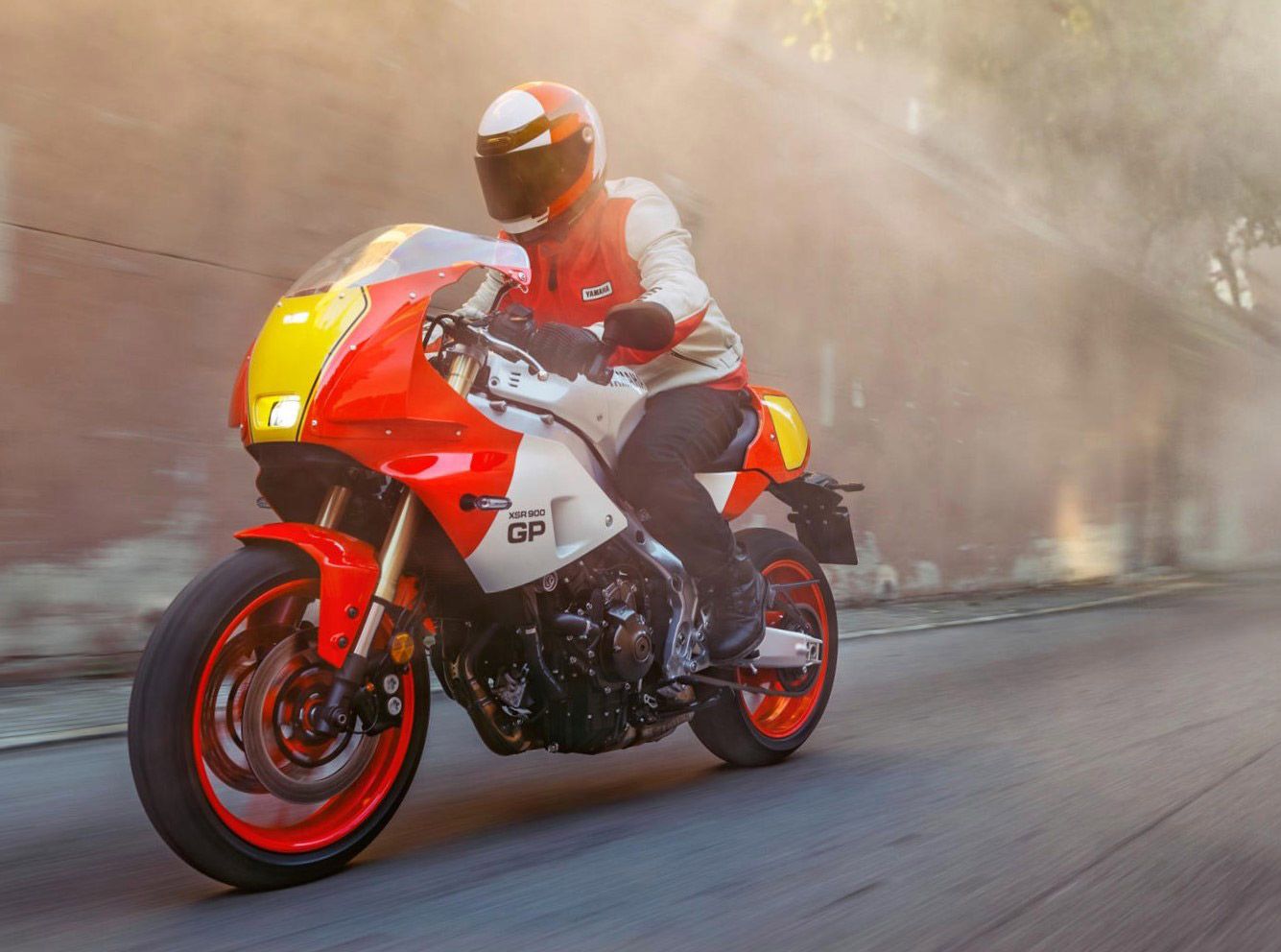
Europe sees all the good stuff first, including the new 2024 Yamaha XSR900 GP. (Yamaha Motor Europe/)It’s a long-standing truism that nostalgia sells, and nowhere is that more apparent than in the motorcycling world, where special editions are rolled out seemingly monthly in homages to a manufacturer’s past golden eras. The latest in that string of celebratory models is Yamaha’s new XSR900 GP, which trades on Team Blue’s racing successes of the 1980s and ‘90s with a stunning retro-flavored livery that’s underpinned by some of the brand’s most modern technology.
Based on the standard XSR900 from Yamaha’s Sport Heritage line, the new GP variant also carries over the welcome updates the 2022 base model received, including refreshed styling, more responsive chassis, and new IMU-enable rider aids.
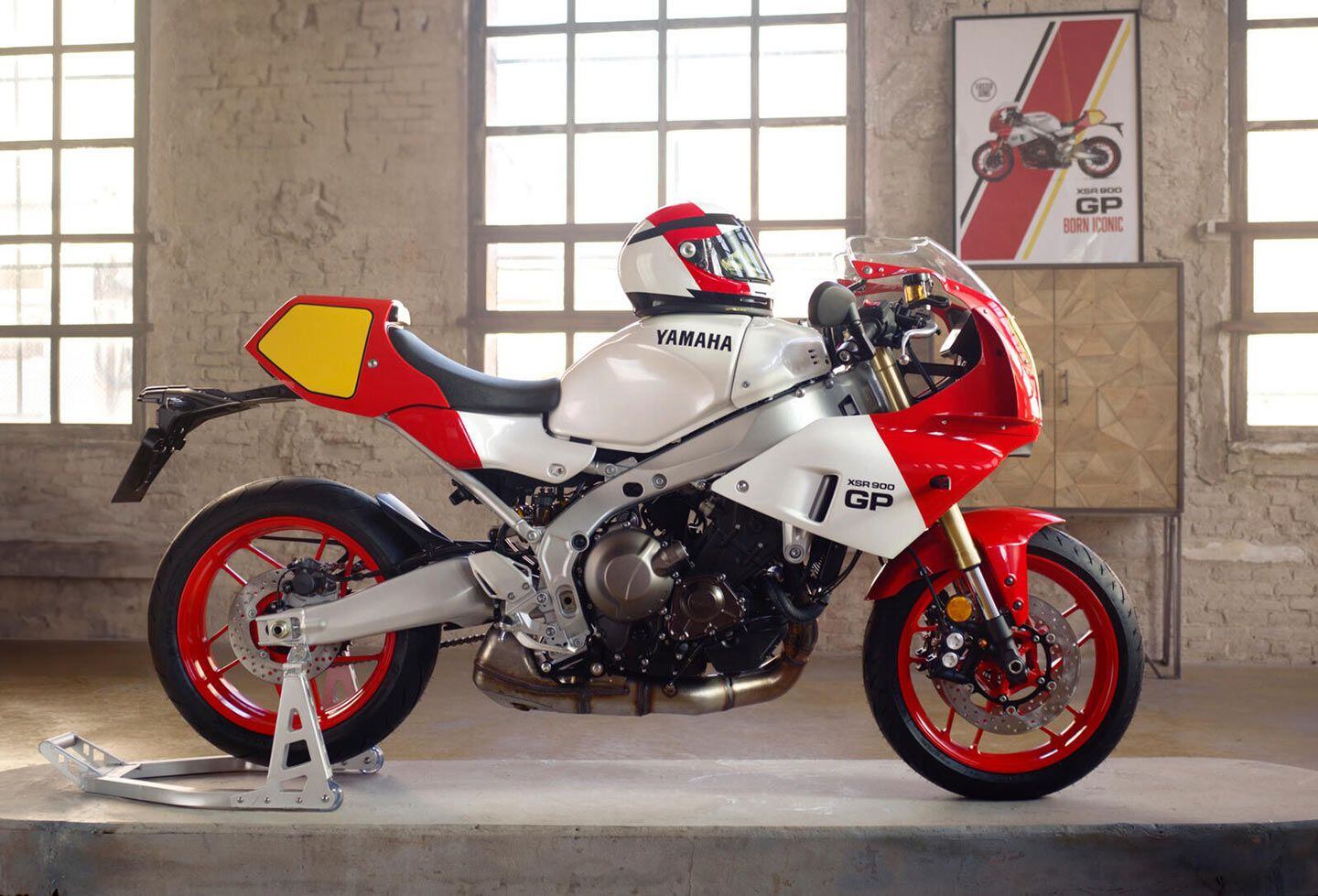
The standard XSR900’s 890cc CP3 engine carries over to the 2024 GP variant unchanged, though Yamaha says the GP’s front cowling increases top speed. (Yamaha Motor Europe/)According to Yamaha, “the aim was not to create a replica, but instead release a model that pays the utmost respect to the past, while holding its own with the latest in performance and technology.”
On the new GP, respect to the past means inspiration from 1980s GP racers in the form of a new squared-off cowl that now fits a square LED unit (instead of the round one on standard XSRs), but with a firm emphasis on also improving aerodynamics. The YZR-inspired fairing and seat hump might evoke warm memories of the Golden Era of Grand Prix racing but Yamaha doubles down on the XSR900 GP with a wholly recognizable color scheme made famous by the likes of Wayne Rainey (who’s featured on the promo video) and Eddie Lawson, the former of whom bagged the 1990, 1991, and 1992 500cc World Championships on a red-and-white YZR500. Authentic number boards on both front and rear cowlings further tie in the racing connection.
Related: 2022 Yamaha XSR900 First Ride
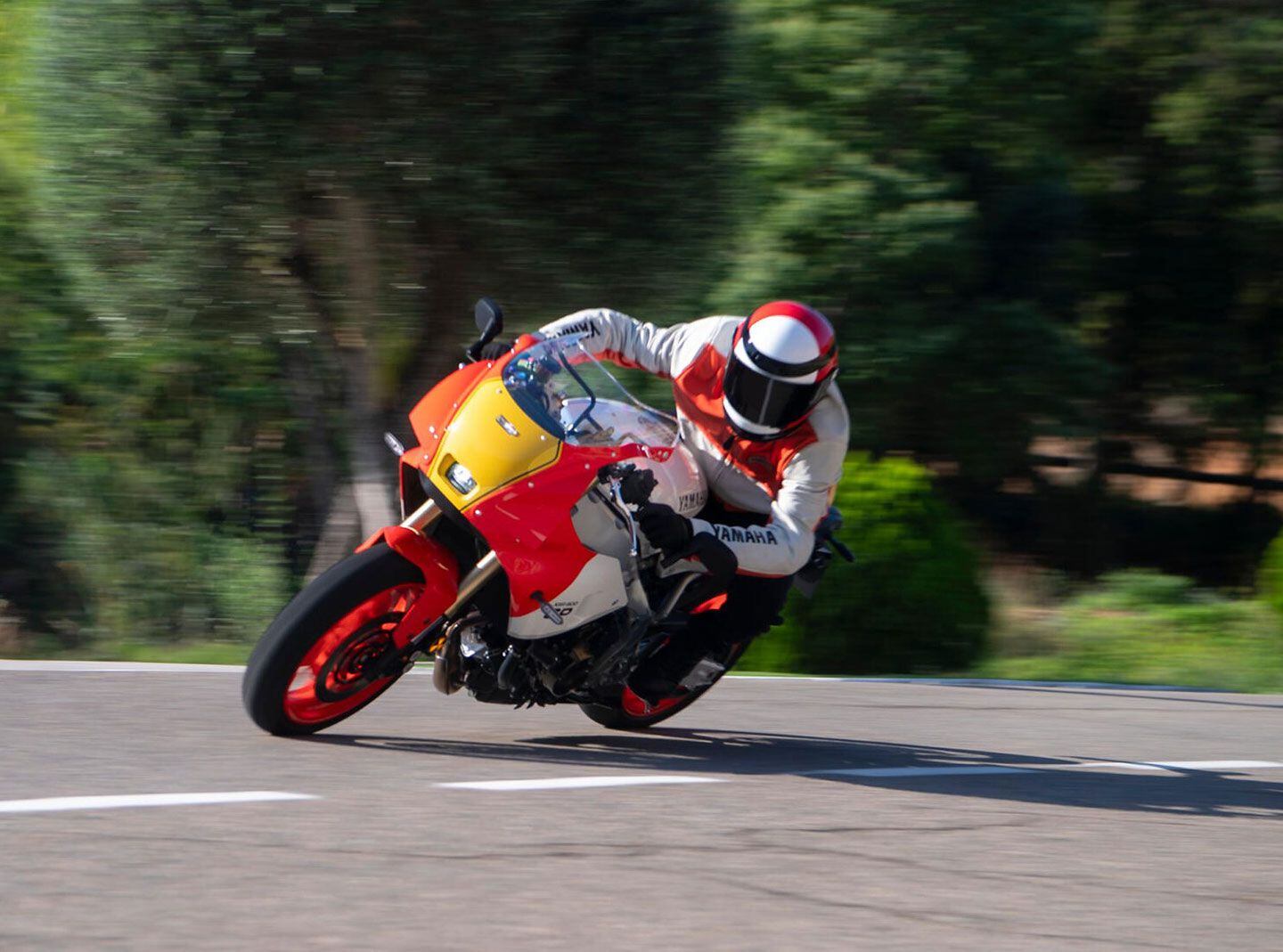
The Deltabox-style frame on the GP is tuned to improve stability in turning and front end feedback, says Yamaha. (Yamaha Motor Europe/)In keeping with the modern performance aspect, you’ll see virtually no changes to the powertrain, with output and gear ratio from the 890cc CP3 triple in the standard XSR900 carrying unchanged. That means the same 78.0 x 61.1mm bore and stroke, 11.5:1 compression ratio, and a claimed 117 hp at 10,000 rpm, but Yamaha says the front cowling structure of the XSR900 GP increases both acceleration and top speed while the ducts on the side panels work to discharge heart from the radiator to maximize cooling.
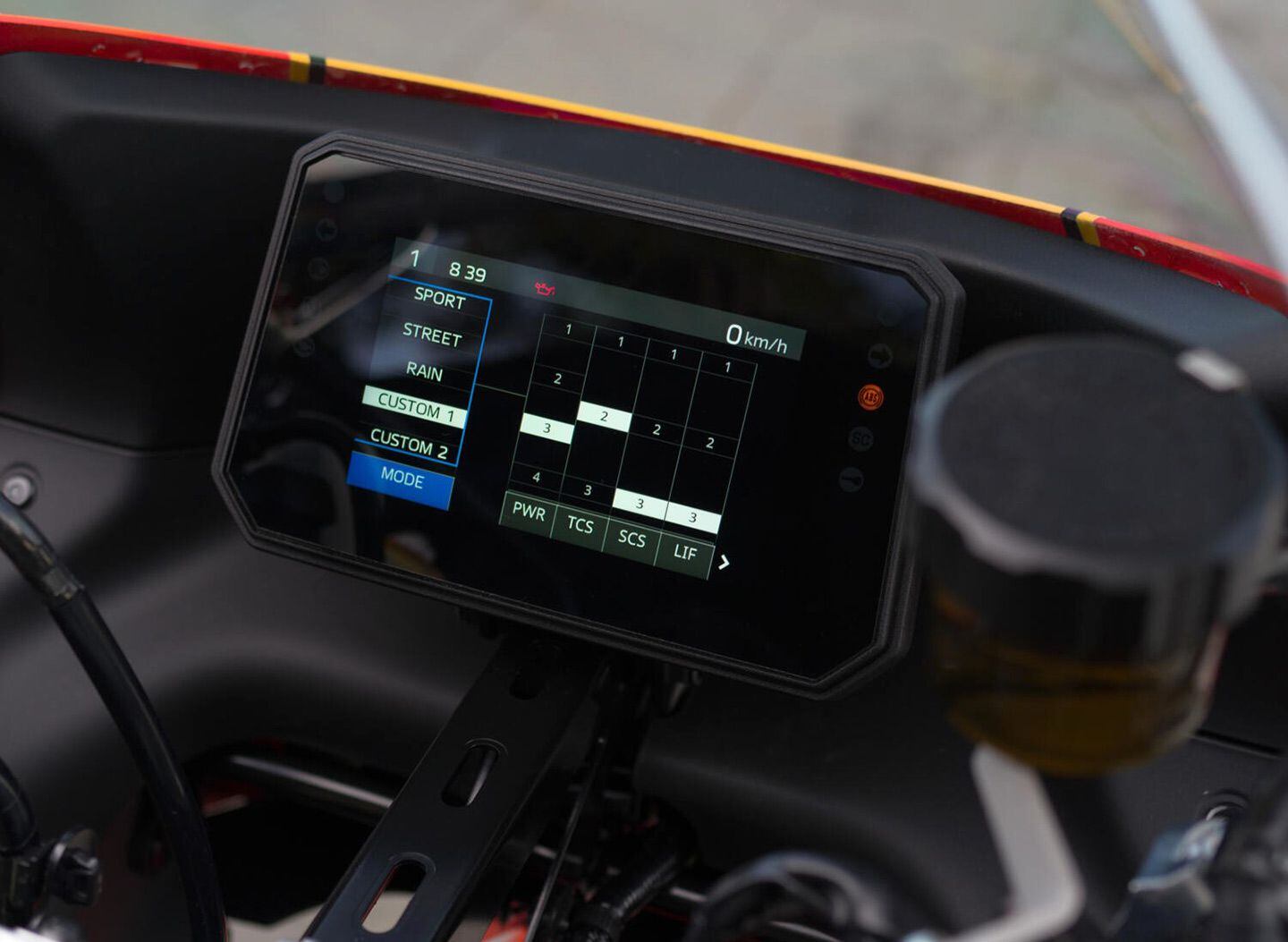
R1-derived six-axis IMU enables a full suite of electronic rider aids; settings can be accessed from the 5-inch TFT display. (Yamaha Motor Europe/)Carrying the load, of course, is a stiffer Deltabox chassis (which coincidentally debuted on the 1982 Yamaha YZR500) finished in silver and tuned to improve stability, with the retro bodywork also covering a slew of up-to-date technology like integrated riding modes and an extensive electronics package. A six-axis IMU enables various rider aids like lean-sensitive traction control, ABS, wheelie control, and morel. A new 5-inch TFT screen allows access to the three preset riding modes including Sport, Street, and Rain, along with two custom modes as well as letting you pair your smartphone. Cruise control, an assist and slipper clutch, and Yamaha’s third-generation two-way quickshifter come standard. In short, you’ll see nearly all the updates we welcomed on the standard 2022 XSR900 during our First Ride last year, but dressed up to the nines.
Related: Yamaha XSR900 DB40 Prototype
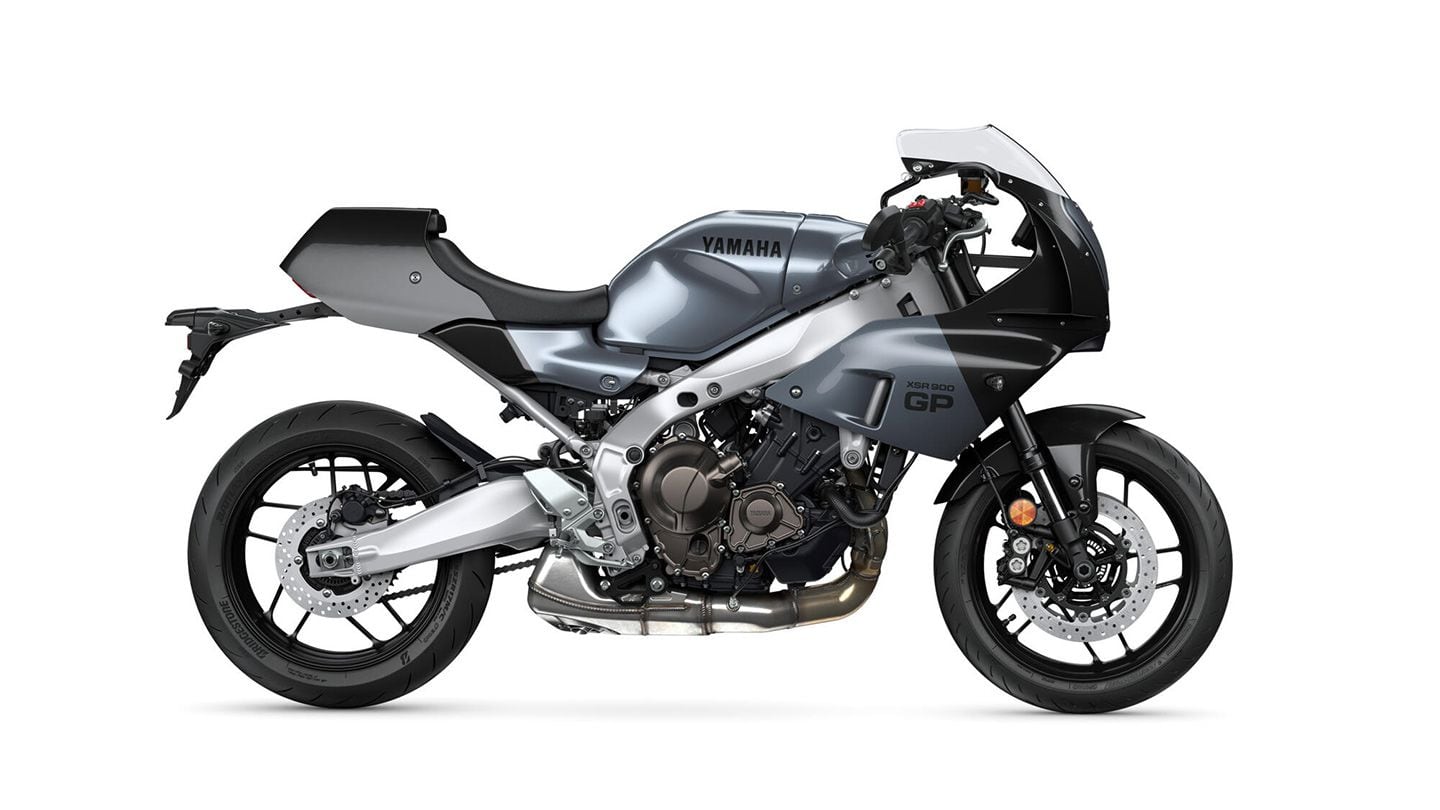
The 2024 XSR900 GP will also be available in this Power Grey color; no pricing has been announced as yet. (Yamaha Motor Europe/)Further distinguishing the GP from the standard XSR900 are revised ergos, with clip-on bars set above the top yoke for a more pronounced rider crouch and relocated (and adjustable) footpegs to accommodate the new position. You also get the same spin-forged 17-inch wheels, inverted, fully adjustable KYB fork, and remote tuned, adjustable KYB rear shock as well as dual-caliper Brembo braking components found on the base model.
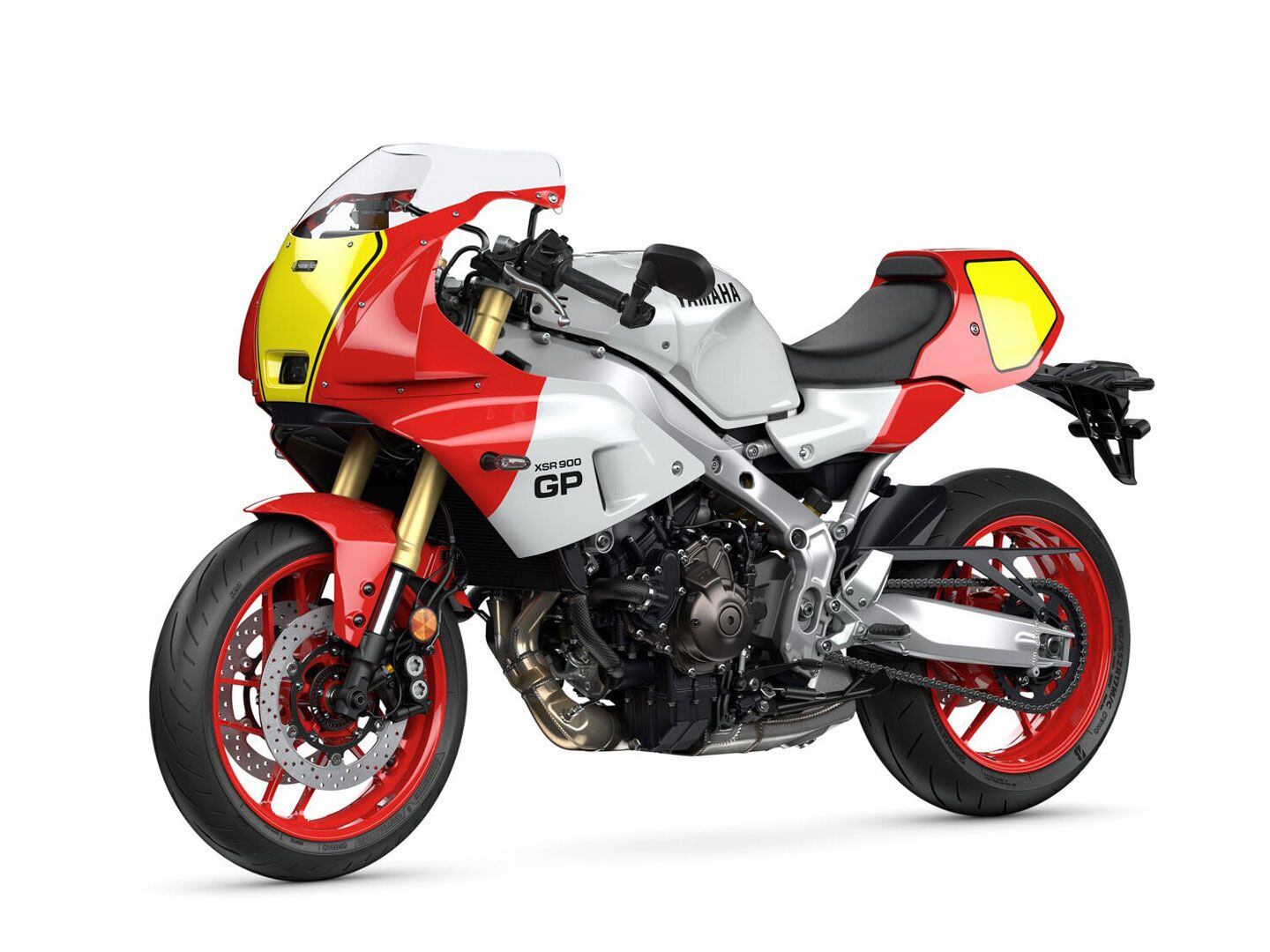
The “ultimate Sport Heritage model.” If you’re a die-hard 1980s GP fan, it comes close. (Yamaha Motor Europe/)Although the 2024 XSR900 GP is currently only available in Europe, no pricing has been announced as yet. We do know Yamaha will offer the GP in two color options: the Legend Red as well as the more subdued Power Grey.
There is hope, too, that the XSR900 GP may yet come to our shores; Yamaha US hasn’t released the entirety of its 2024 line.
2024 Yamaha XSR900 GP Specs (Europe)
MSRP: N/A Engine: DOHC, liquid-cooled, inline three-cylinder; 12 valves Displacement: 890cc Bore x Stroke: 78.0 x 62.1mm Compression Ratio: 11.5:1 Transmission/Final Drive: 6-speed/chain Claimed Horsepower: 117 hp @ 10,000 rpm Claimed Torque: 68.6 lb.-ft. @ 7,000 rpm Fuel System: Fuel injection w/ YCC-T Clutch: Wet, multiplate, slip and assist Engine Management/Ignition: Transistor-controlled ignition Transmission/Final drive: 6-speed/chain Frame: Control-filled die-cast aluminum Front Suspension: KYB 41mm USD fork; fully adjustable, 5.1 in. travel Rear Suspension: KYB monoshock, preload and rebound adjustable; 5.2 in. travel Front Brake: 4-piston calipers, dual 298mm discs w/ ABS Rear Brake: 1-piston caliper, 245mm disc w/ ABS Wheels, Front/Rear: Spin-forged aluminum Tires, Front/Rear: 120/70ZR-17 / 180/55ZR-17 (Tubeless) Rake/Trail: 25.3°/4.3 in. Wheelbase: 59.1 in. Ground Clearance: 5.7 in. Seat Height: 32.9 in. Fuel Capacity: 3.7 gal. Claimed Wet Weight: 441 lb. Contact: yamaha-motor.eu -
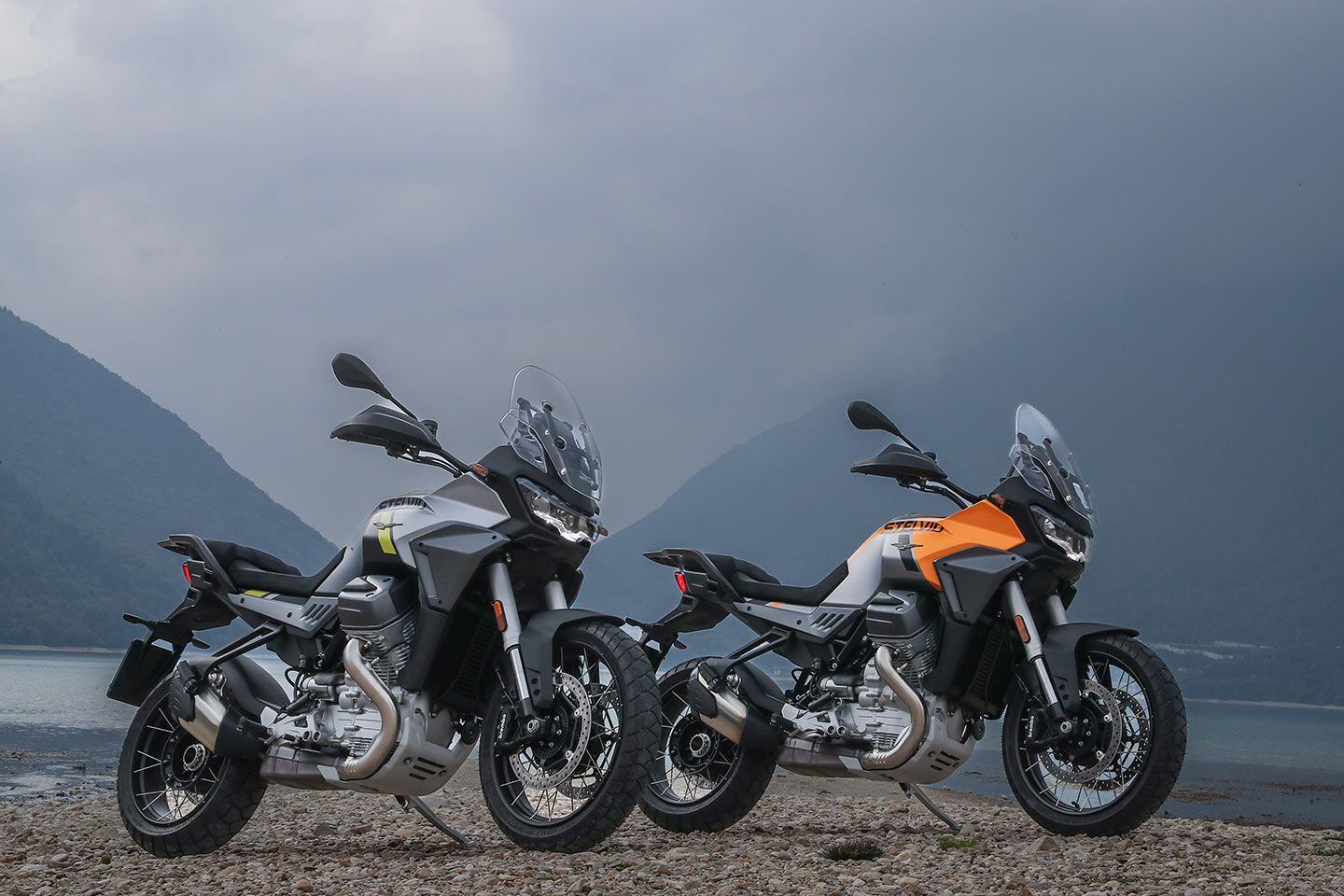
Moto Guzzi has revived the Stelvio name for 2024 with a new adventure bike powered by its new 1,042cc compact-block engine. (Moto Guzzi/)Moto Guzzi is two years into its second century, and with that comes changes while it remains faithful to the longitudinal V-twin and shaft drive that has served Mandello de Lario faithfully. While Guzzi’s small block mill has been a long-standing staple, outlasting more recent designs that have come and gone, a new more compact and modern engine has been designed for the next 100 years: the compact block. In 2021, the V100 Mandello was the first model to utilize this powerplant, immediately garnering praise and interest—even from non-Guzzisti. Now a second and possibly more important machine revives a moniker that recalls the spirit of adventure: the Stelvio.
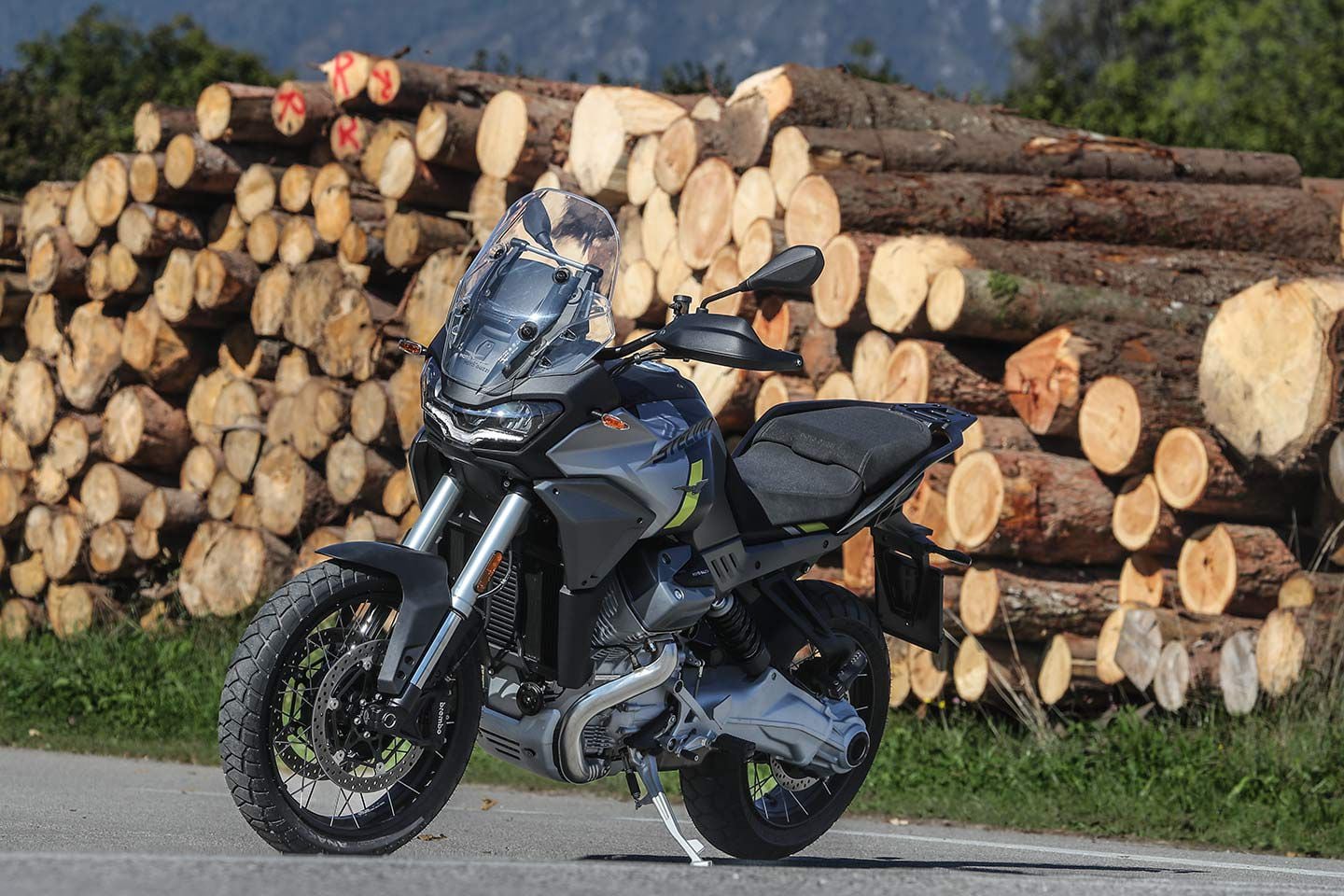
Moto Guzzi’s Stelvio will be available in the first part of 2024. (Moto Guzzi/)Moto Guzzi already has the V85 TT ADV model, powered by a 853cc version of that trusty small block, but it would be a waste not to put that modern 1,042cc compact-block engine to work in one of the most popular segments in motorcycling. Based on the same engine-as-a-stressed-member architecture as the V100 Mandello, but modified for adventure motorcycle touring through gravel and light trails, the 2024 Stelvio is meant to vie for sales success in the 900–1,100cc adventure segment. Conceived at the same time as the V100, the Stelvio may be more important to Moto Guzzi’s future success than the model that bears the name of the home of the brand.
Cycle World got the chance to ride a preproduction version of the Stelvio before the release of the new model to the public. But before the ride we sat down with Piero Soatti, head of Moto Guzzi Engineering, along with a panel of those responsible for bringing the Stelvio to market.
2024 MotoGuzzi Stelvio Technical Details
We are familiar with the 90-degree longitudinal V-twin that powers the V100 Mandello and now the Stevlio. DOHC four-valve heads are turned 90 degrees to the traditional air-and-oil-cooled small block for tighter packaging despite sitting atop 521cc cylinders measuring with a bore and stroke of 96.0 x 72.0mm. Liquid-cooling and closed-loop EFI allowed the compact block to be Euro 5 compliant while producing a claimed 115 hp at 8,700 rpm and 77.4 lb.-ft. of torque at 6,750 rpm—just right for an all-rounder ADV that looks to go up against the likes of Suzuki’s V-Strom 1050, Honda’s Africa Twin, and Ducati’s Multistrada V2.
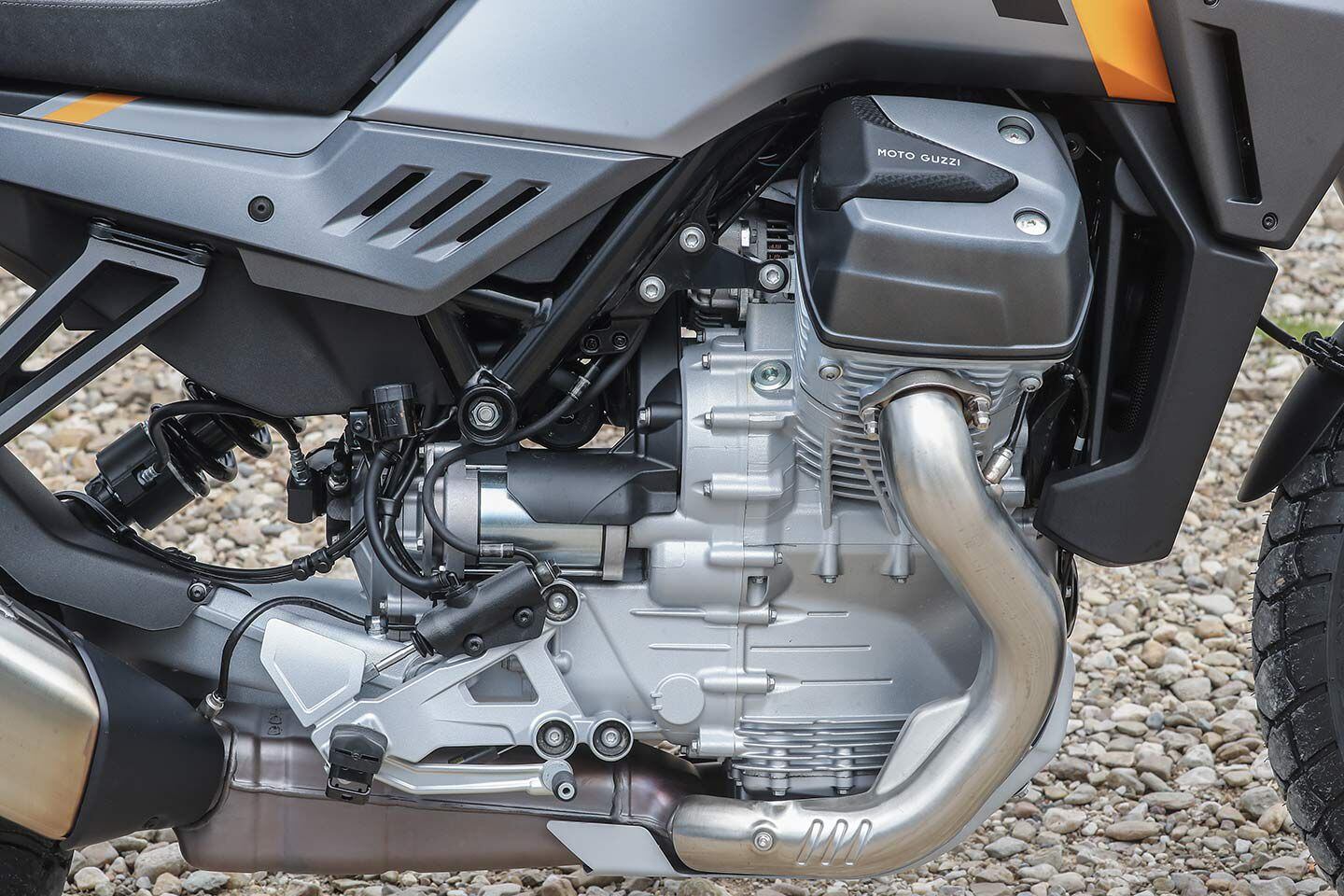
Only a few changes have been made to the compact block for duty in the 2024 Stelvio. (Moto Guzzi/)There are changes to the engine for use in the Stelvio, but far fewer than you might expect. First the EFI system gets a downstream O2 sensor to give the Stelvio a Euro 5+ rating—the V100 will also get this as a running change. Guzzi augmented the thickness of the rear of the engine cases where the swingarm attaches for increased strength to handle the additional stresses from the Stelvio’s ADV mission. That’s it, a real demonstration of the flexibility of Moto Guzzi’s new engine. It’s not hard to imagine there will be more new models with the compact block beyond the V100 Mandello and Stelvio.
Related: Moto Guzzi’s V2 Small Block
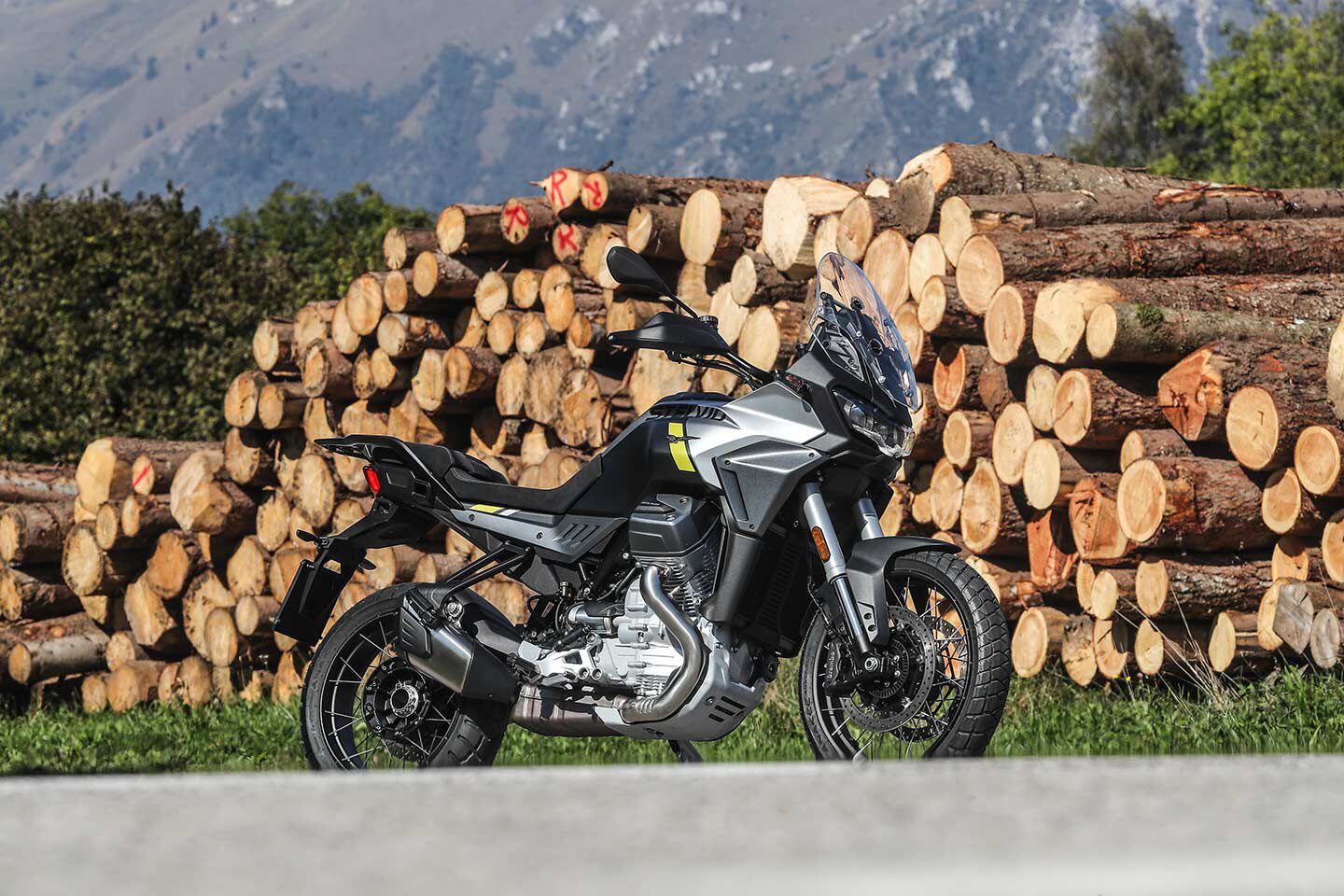
Moto Guzzi’s Stelvio began development at the same time as the V100 Mandello. You can see some design elements are similar, but the Stelvio is more aggressive and sharper than the classy Mandello. (Moto Guzzi/)The Stelvio is equipped with five ride modes: Sport, Strada, Turismo, Pioggia, and Off-road. Each gets its own throttle response, traction control, engine-braking, and ABS setting. Additionally the rider can tweak those parameters except for engine-braking through the Stelvio’s 5-inch TFT dash seen on the V100 Mandello. Navigating the menu system is simple and intuitive. Piaggio Group’s MIA smartphone connectivity is an option that allows for control of music, phone calls, and navigation.
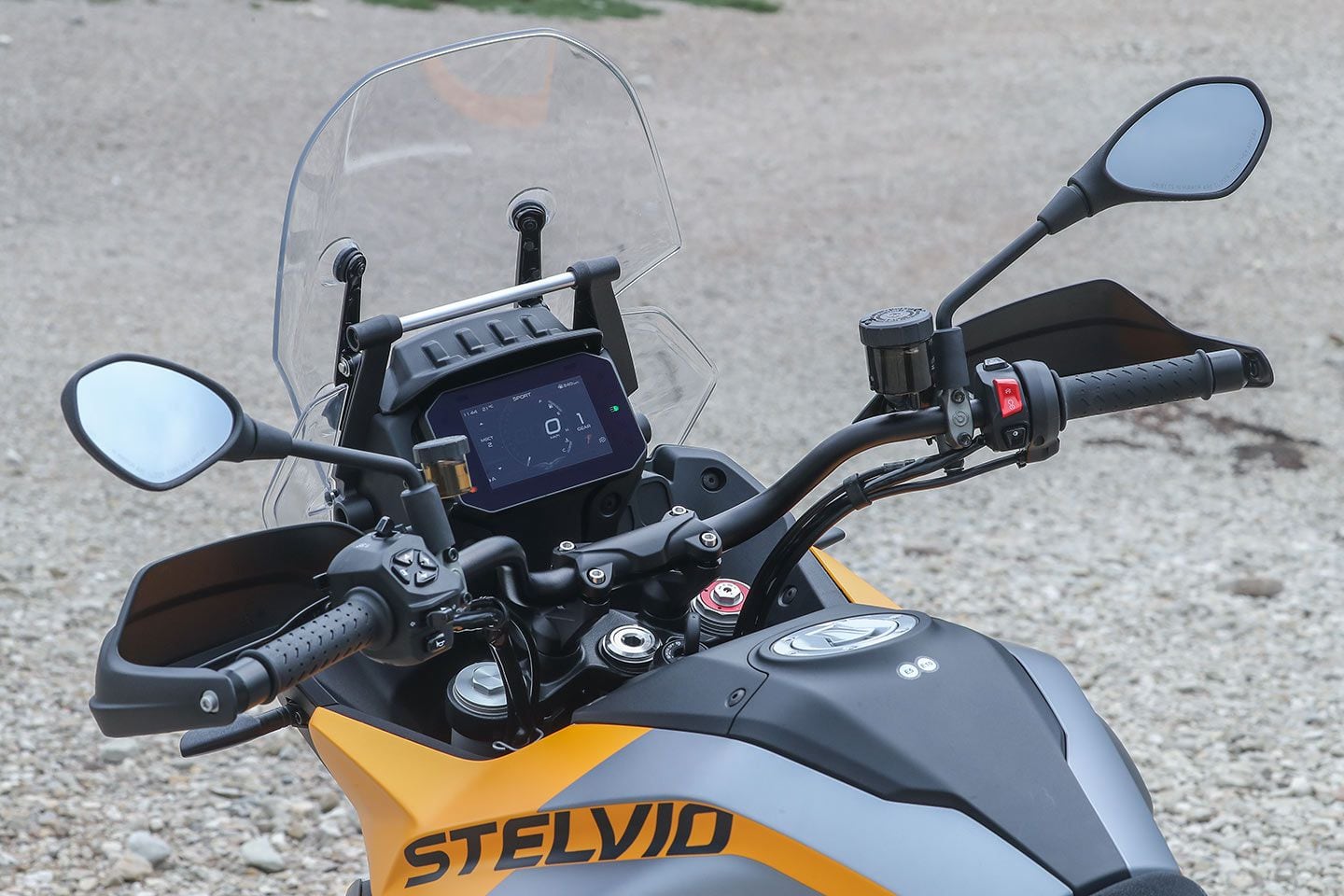
A 5-inch TFT screen is bright and easy to read. (Moto Guzzi/)Cruise control is standard, and a second S model will be available with forward- and rear-facing radar for adaptive cruise and other safety measures. Moto Guzzi is holding full details on that system until November at EICMA.
There are refinements to the gearbox too. Every gear has been reworked to improve shifting, and the clutch is a new self-assist anti-hopping (slipper) unit that is also meant to improve shift actuation and feel. A quickshifter is an option, but it was not installed for this test.
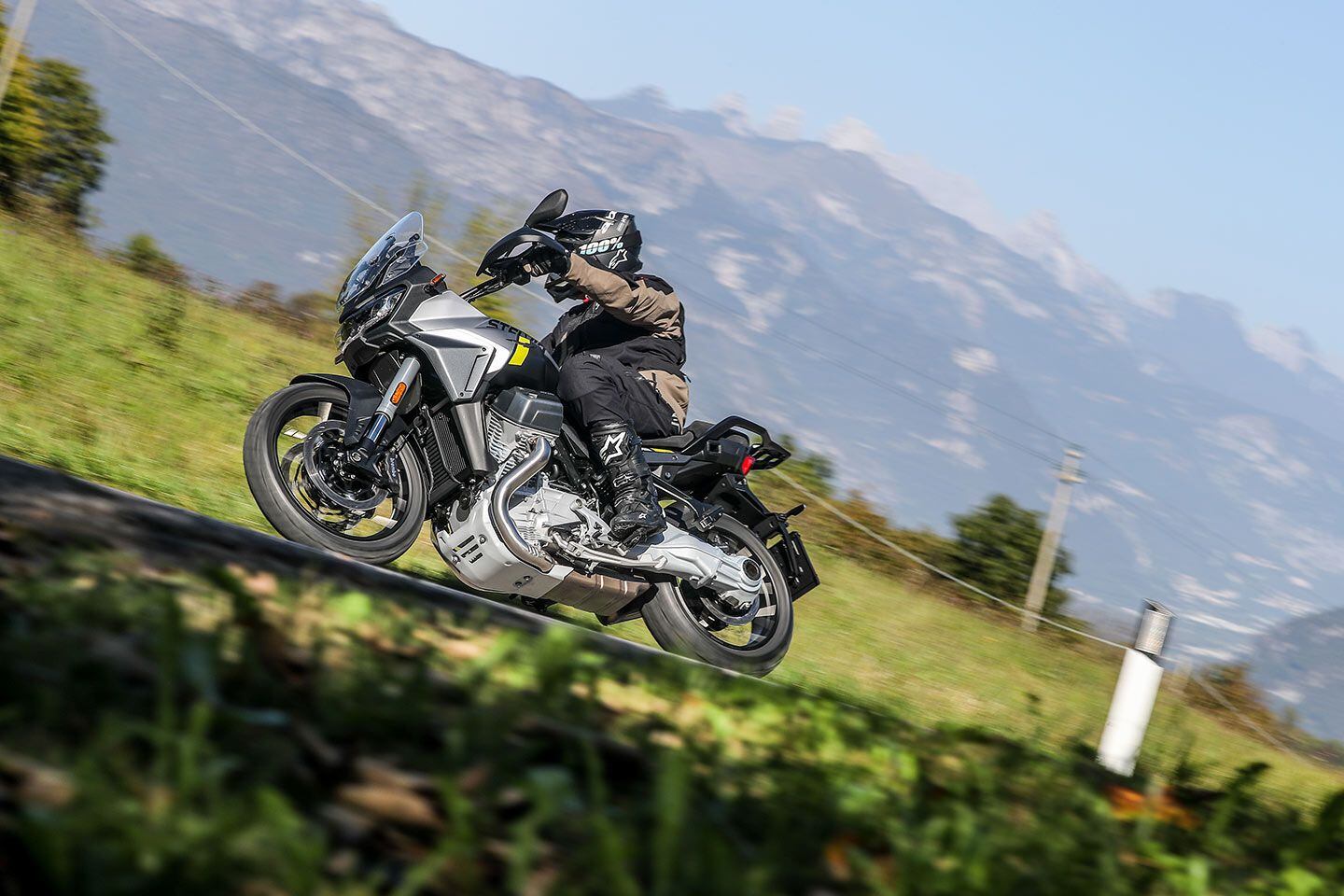
Moto Guzzi’s Stevlio is billed as a n “all-rounder” adventure bike. (Moto Guzzi/)Attached to the compact-block engine is a trellis frame in similar construction to the Mandello but with revised geometry, increased length, and additional engine mounting points for the Stelvio. The head-tube area has been stretched and has more rake to make room for the 19-inch front wheel. Exact chassis measurements have not been shared yet. Attachment points to the engine have increased from four on the Mandello to six on the Stelvio for more rigidity. Rider footpegs are in a different position as well but are still mounted directly to the engine with rubber-damped mounts.
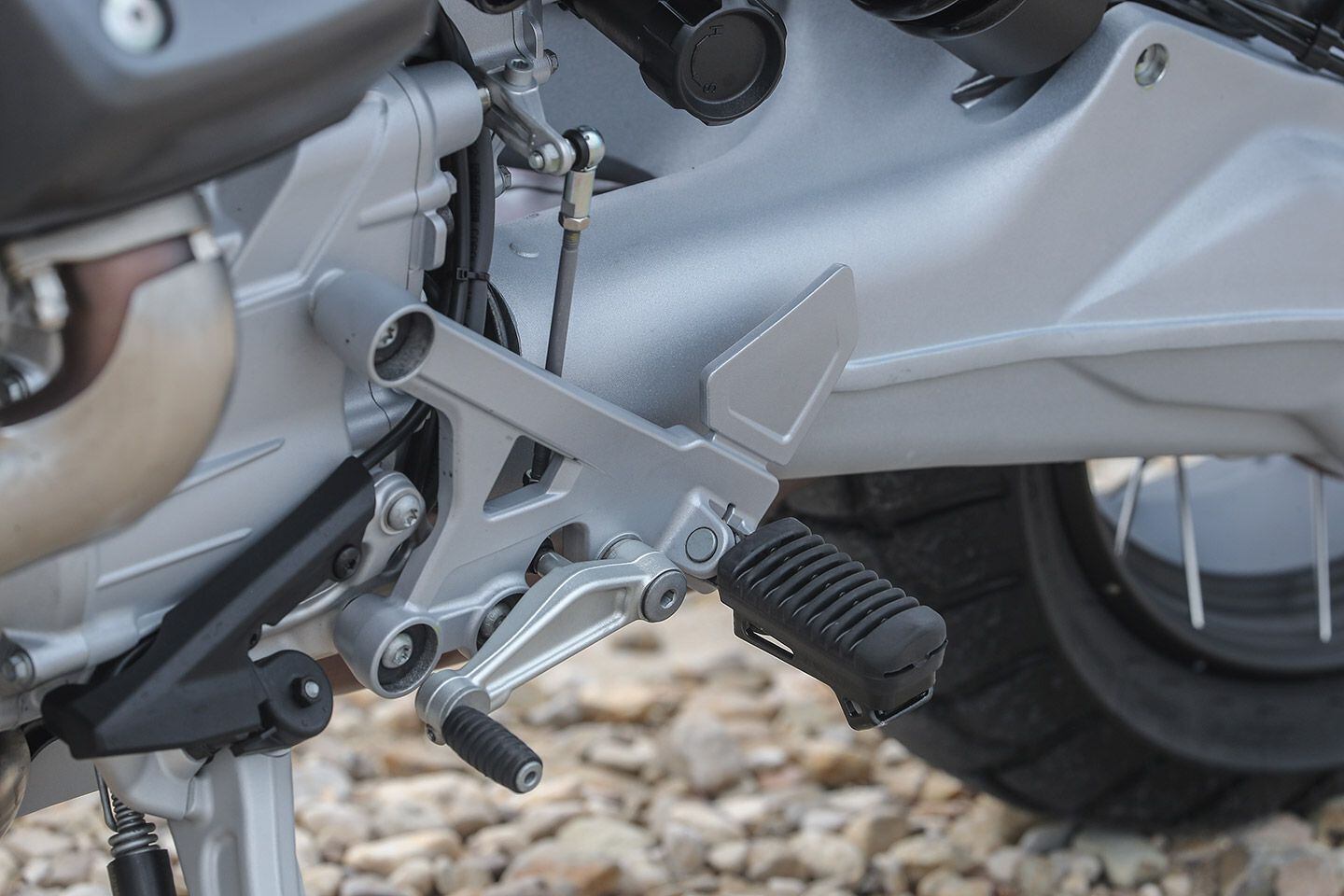
The footpegs are mounted directly to the Stelvio’s engine cases. (Moto Guzzi/)No semi-active suspension for the Stelvio, an interesting choice for an ADV that will see the majority of its duty on the road. A Sachs 46mm inverted fork strokes through 6.7 inches of travel and is adjustable for rebound damping and spring preload. At the rear a KYB shock is adjustable for rebound damping and features an external spring preload adjustment knob. It’s attached to a single-sided swingarm and offers 6.7 inches of wheel travel. Moto Guzzi beefed up the bearings and casting where it attaches to the engine. Swingarm length is the same as that of the Mandello.
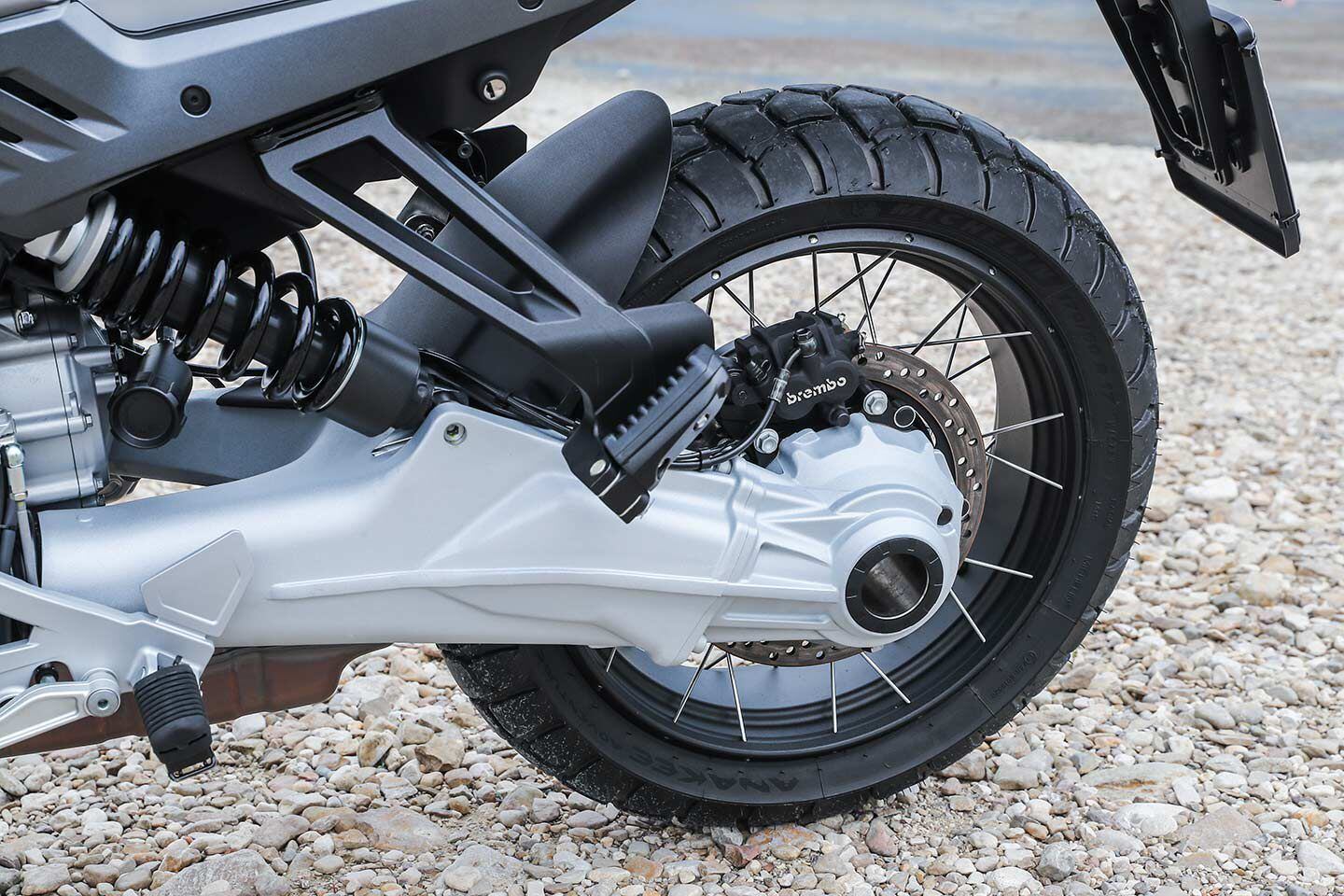
The Stelvio’s swingarm is the same length as the Mandello but has more travel. (Moto Guzzi/)Tubeless cross-spoke wheels are sized 19 x 3.0 inches front and 17 x 4.5 inches rear. Wheels are wrapped with Michelin Anakee Adventure tires. Brakes are the same units used on the Mandello: Brembo four-piston radial-mount calipers with 320mm discs up front and a two-piston unit at the rear clamping a 298mm disc. ABS is lean sensitive and has three levels: on, Off-road, and off.
2024 Moto Guzzi Stelvio Riding Impression
Time with the Stelvio was limited to just a quick afternoon ride following the technical presentation. Not enough time for a full evaluation (expect a full test when we get a bike Stateside), but enough to know that this is the best Moto Guzzi ever to come off a production line. As it goes with preproduction test units, specs and some electronic features are subject to change, but at 95 percent finalized, this cake is just about ready to be pulled from the oven.
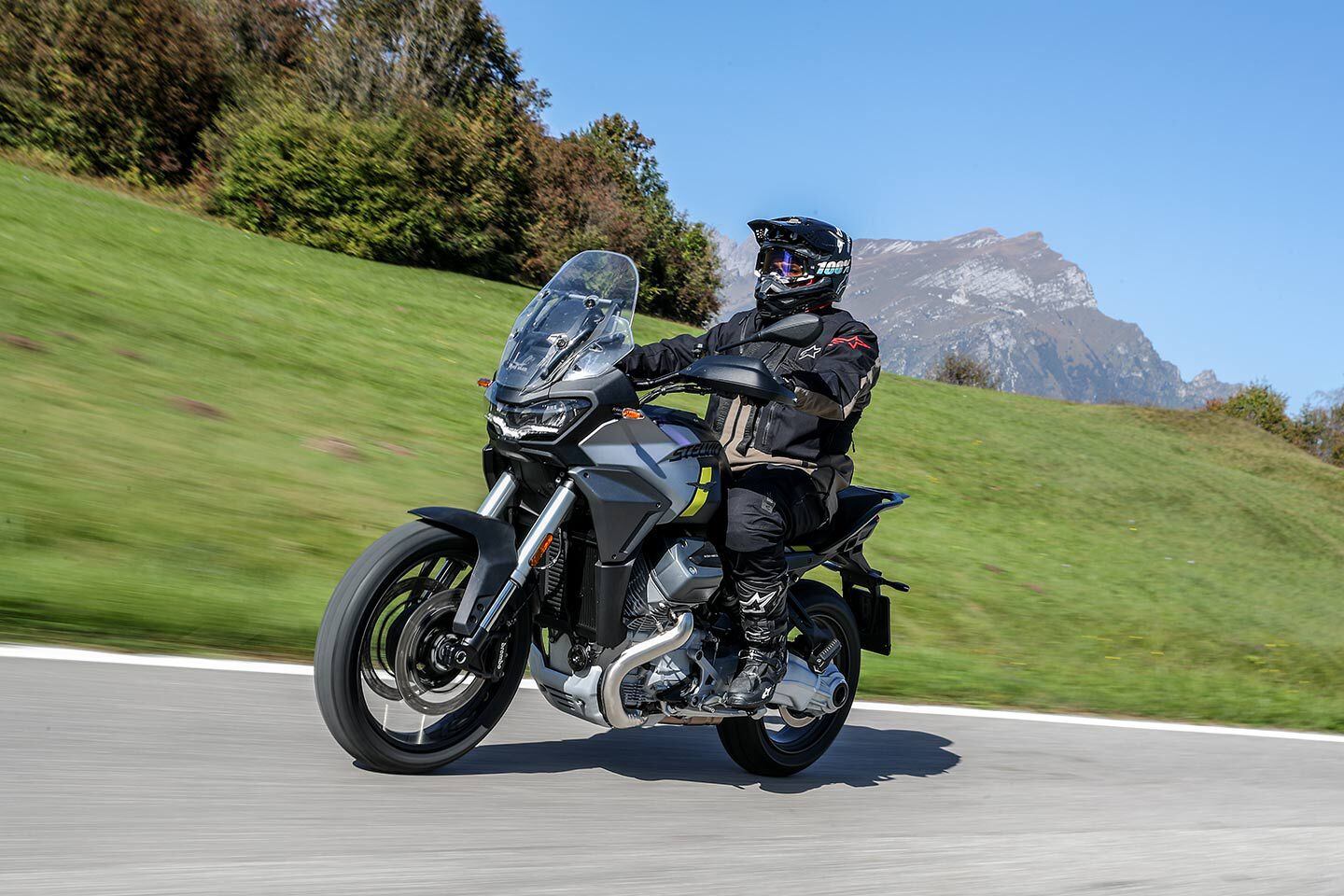
On the Italian autostrada the Stelvio is comfortable at speed with excellent wind protection. (Moto Guzzi/)Right away, we hit the autostrada and headed for the mountain roads about 45 minutes northeast of Noale. This gave plenty of time to become acquainted with the masterful aerodynamics of the Stelvio.
“Best in class” was the order for Moto Guzzi’s design, and it’s abundantly clear the 1,500 hours of CFD modeling and wind tunnel testing has paid dividends. I often wear a helmet with a visor on adventure motorcycles, not only for the functionality of a mixed mission, but also because it will amplify any issues with buffeting or wind management. In the lowest position, airflow over the screen hits you just about chin level at 60 mph. But it is a consistent, buffet-free flow. As the speeds increase, the calm bubble of air behind the screen’s 2.8-inch-taller fully raised position is impressive. Even hitting 150 kph (93.2 mph)—above that speed, you cannot adjust the screen—my 5-foot-10 frame is free from any bothersome wind blast. Being able to travel at 225 kph (139.8 mph) with a visor without issue is possible—allegedly, Signore Carabinieri.
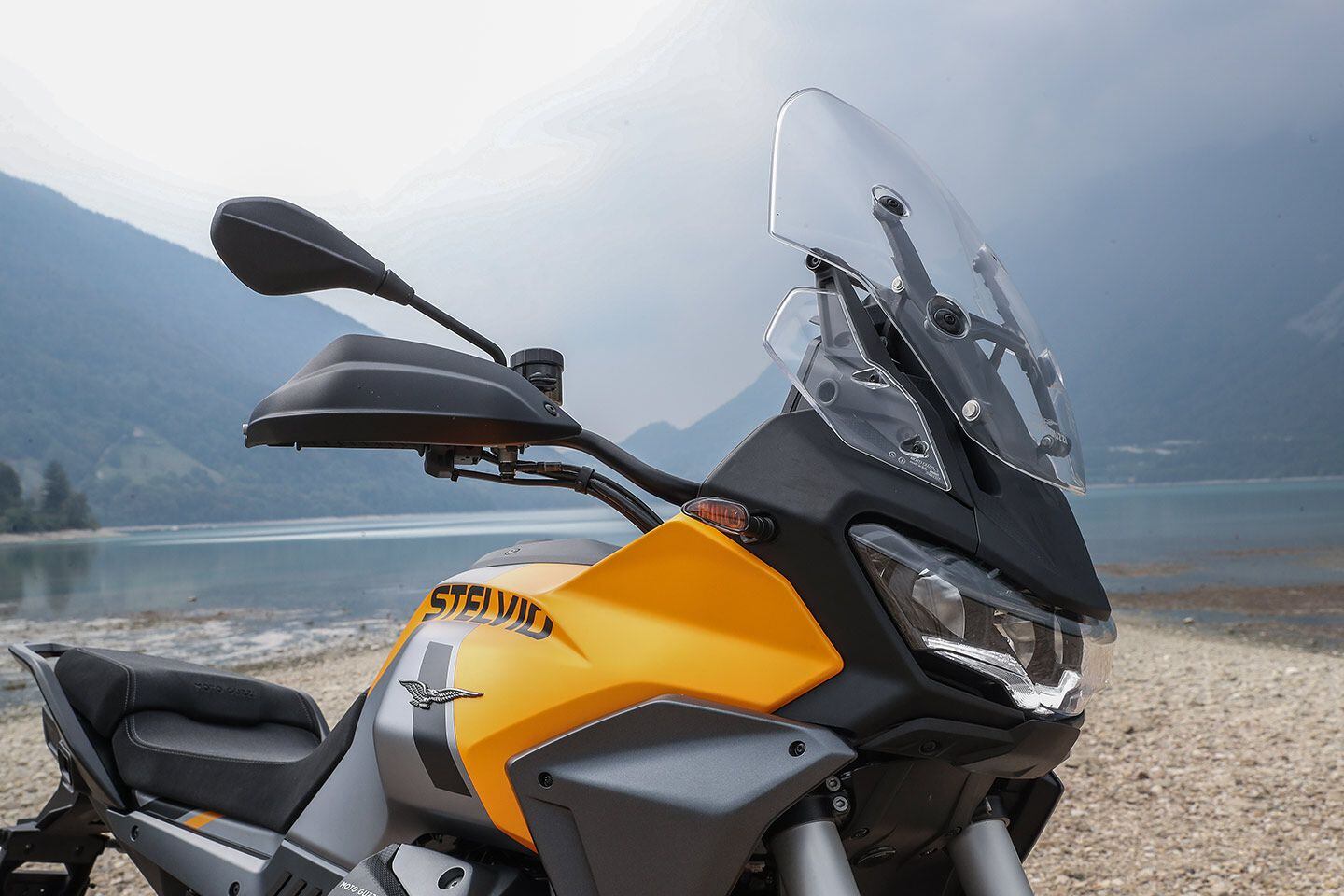
The Stevlios electronic windscreen has 2.8 inches (70mm) of adjustment. (Moto Guzzi/)It doesn’t take the Stelvio long to achieve that “theoretical” 225 kph. Acceleration is strong even with just 115 hp and 77.4 lb.-ft. Throttle response in Sport is crisp, but not jerky even in on/off situations while on the side of the tire. You can be aggressive out of corners and the traction control keeps everything moving forward without any real indication it is working to keep you upright.
Strada (Street) is the go-to for everyday work in and out of town with a slightly less aggressive response when twisting the ride-by-wire throttle. Turismo (Touring) softens things up a step further while Pioggia (Wet) cuts back the power and traction control intervenes early and often. Off-road returns the snappiness in the throttle response and traction control is minimized as it is in Sport mode. Unfortunately, there was no gravel or dirt on the menu during this truncated test, so judgment on that front will be saved for when we get our hands on a production unit.
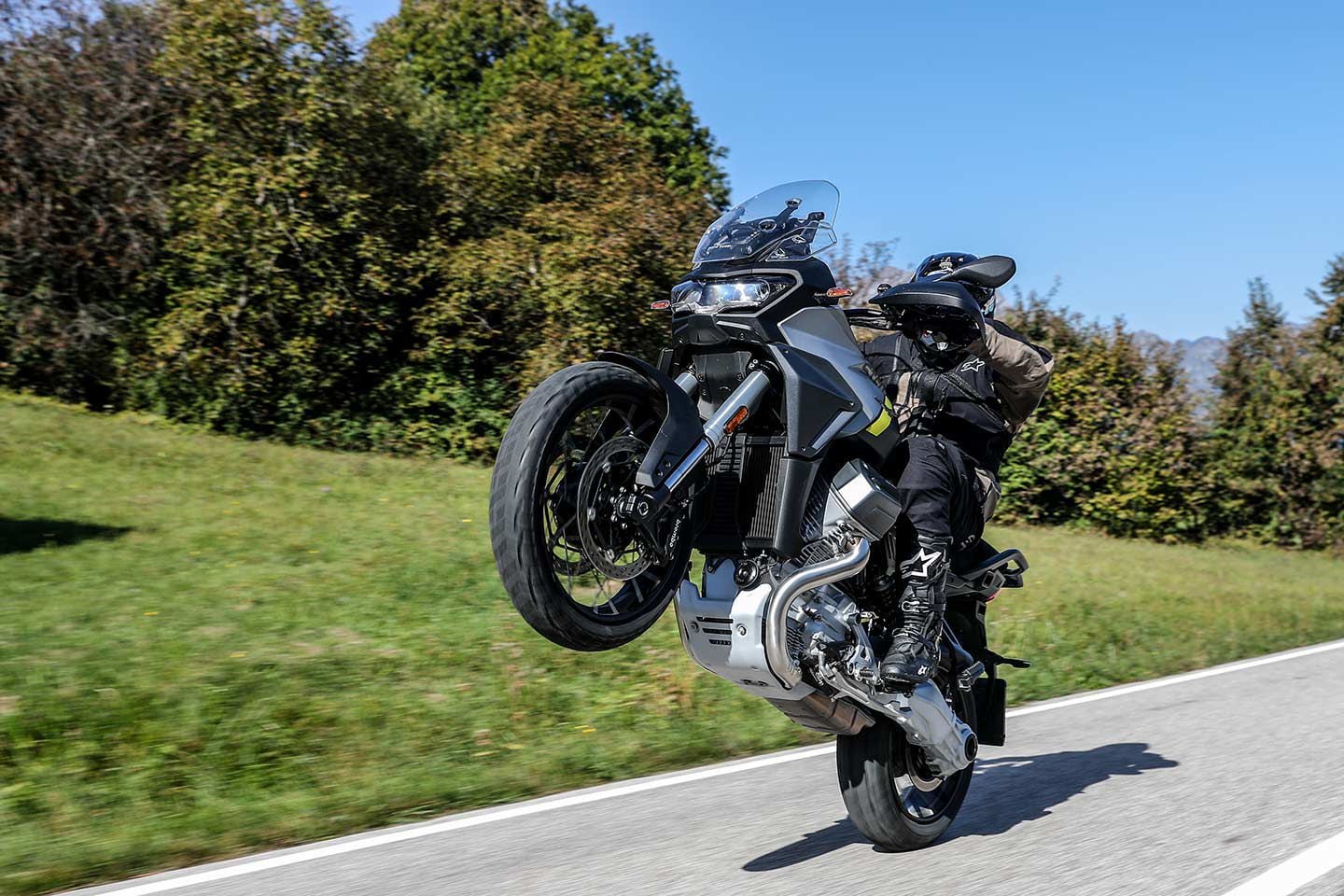
Throttle response and power output is crisp in Sport Mode. (Moto Guzzi/)Off the autostrada and into the hills, the Stelvio continues to impress. Handling is snappy, quick even, while remaining rock-solid stable. The front end is light, nimble, and ready to go anywhere you ask. Even with ADV suspension travel, the Stelvio is balanced front to back and doesn’t pitch excessively during hard braking and acceleration. Back the pace down in Strada and Tursimo, and the ride is sublimely smooth and flowing.
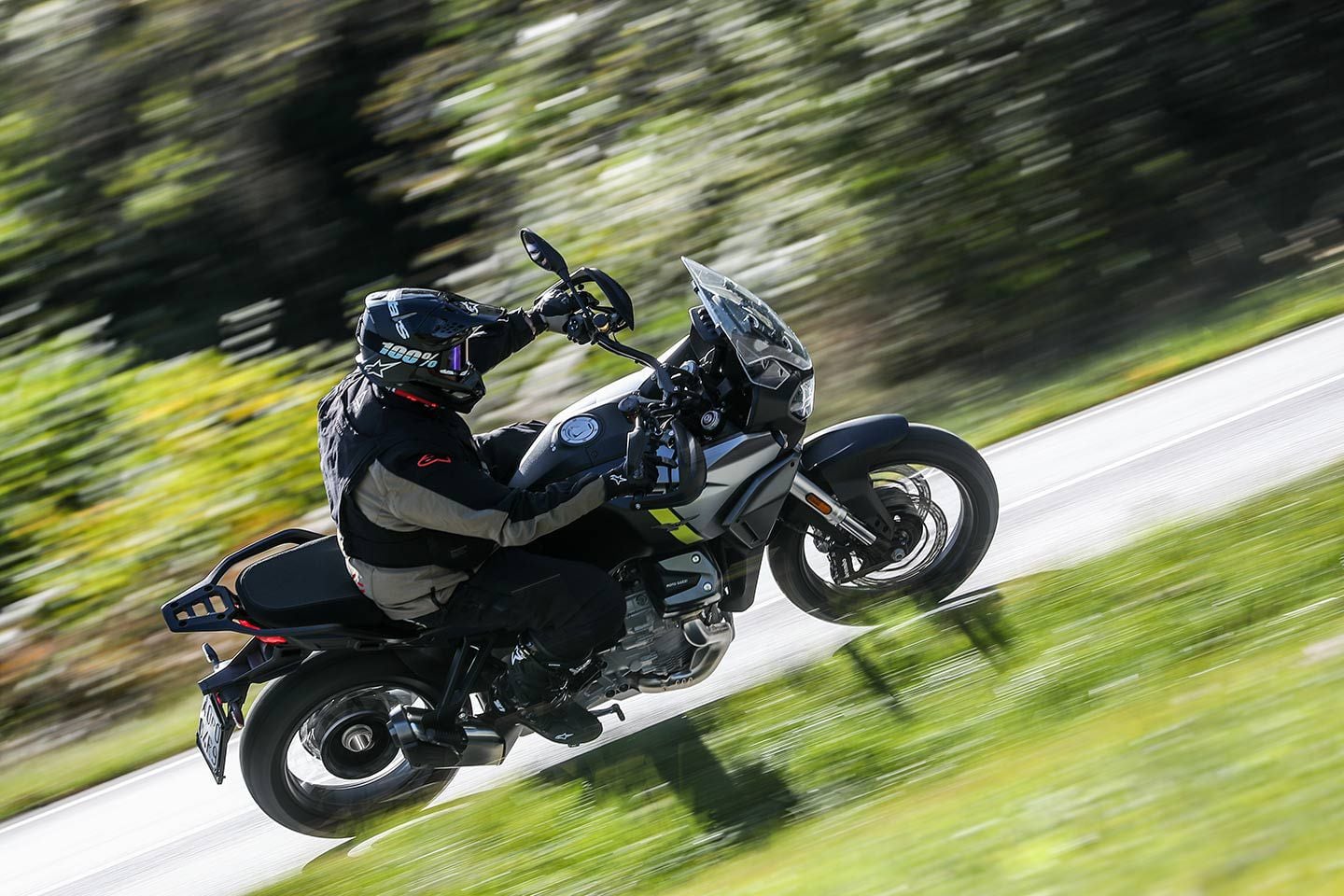
Fast and flowing Italian roads are a dream on the Stelvio. (Moto Guzzi/)Suspension action is firm yet well damped in compression and rebound for street work. Large undulations and bumps are soaked up without complaint. Freeways seams are felt with a thump-thump, but are not harsh or annoying. You just feel the road surface and what it is doing beneath you at all times. There’s no hint of shaft jack or squat from the Cardan shaft swingarm, even under the hardest acceleration. Once again, no dirt, so we will have to wait to see what happens there. On the road, however, it’s marvelous.
Dual 320mm front discs squeezed by Brembo four-piston calipers are strong, communicative, and have a progressive action at the lever. At the back the two-piston unit matched to a 298mm disc works well without too long of a pedal throw. In Off-road mode, the rear brake locks up when needed but has excellent modulation. Some hooligan antics with big rear brake movements and fast downshifts will get the rear tire hopping a bit, despite the anti-hopping feature of the clutch.
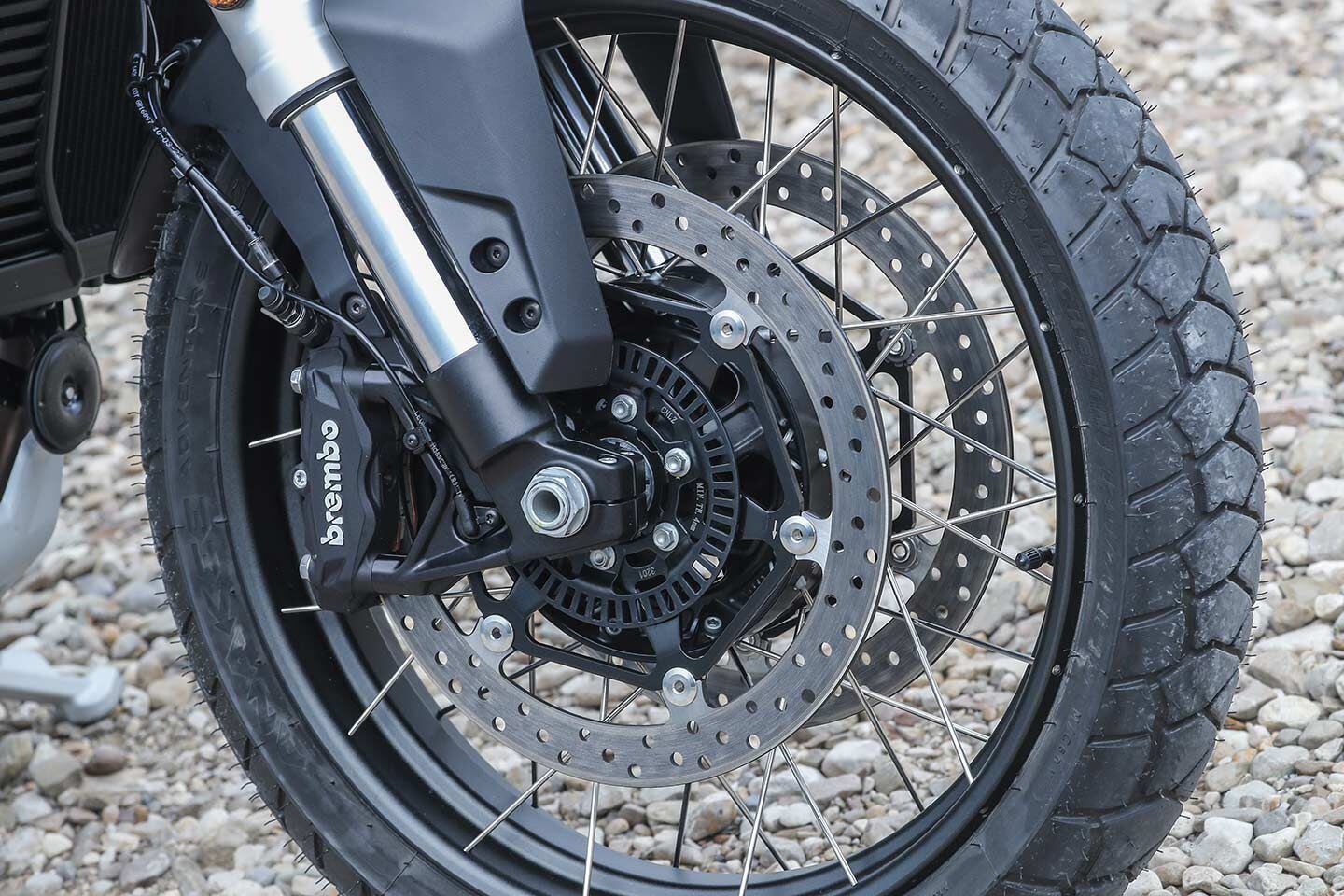
Braking duties are handled by Brembo. (Moto Guzzi/)In all we spent just about 150 miles and several hours on the Stelvio. No ironbutt testing on this trip, but overall it is comfortable and the cockpit is a very nice space to pass the time and miles. Of course there is the aforementioned wind protection, but the rider triangle is just as good.
The ends of the handlebar are high and wide, giving you plenty of leverage, but also helping keep the arms stretched just enough to fight off fatigue. And when standing, the bar is straight enough for you to get over the front of the bike. The seat is narrow at the front with a wider section at the back allowing you to move around depending on your sporty or touring requirements. Reach to the ground feels much lower than the 830mm (32.7-inch) seat height would suggest and the distance to the footpegs is not cramped. With the rubber mounting of the footpegs to the engine to quell vibes, there is some flex when putting pressure through the pegs, and when standing, that mounting in conjunction with the rubber peg inserts give a sloppy and slippery feel.
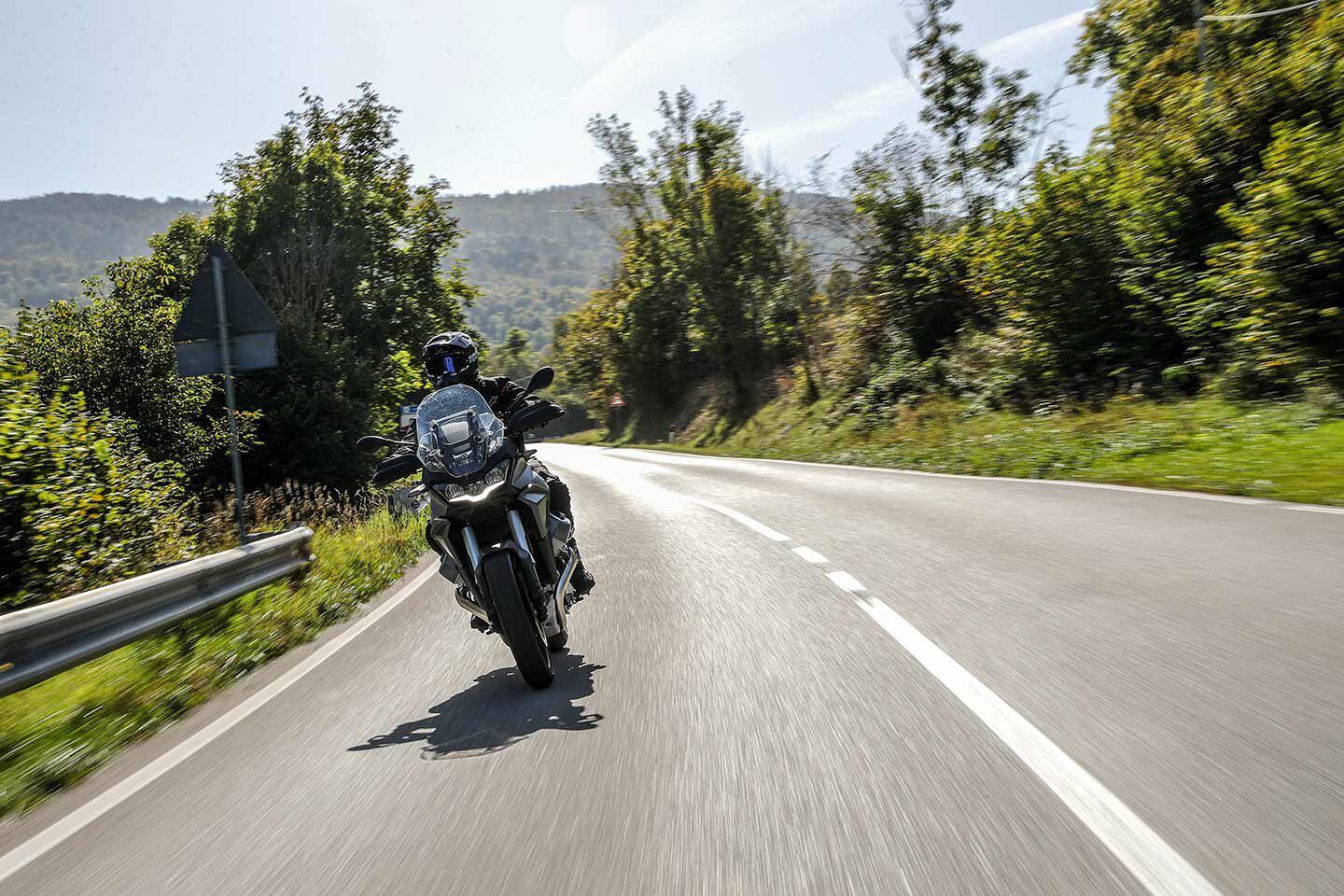
Pricing has not been announced yet (as well as radar system details) but should be at EICMA in November. (Moto Guzzi/)2024 Moto Guzzi Stelvio Conclusion
While our time with the preproduction Stelvio was short, the outlook for the future and the production model is positive. Granted, off-road performance is yet to be evaluated, but if its street chops are any indication of what to expect in the dirt, then Moto Guzzi has a winner on its hands. Units will arrive just after the first of the year at dealers, and although no price has been set, a figure between 16,500 and 17,500 euros (approximately $17,500 to $18,500) has been batted about. We can’t wait to ride the final product around the new year. Moto Guzzi is off to a cracking second century.
2024 Moto Guzzi Stelvio Specs
MSRP: TBA Engine: DOHC, liquid-cooled, 90-degree transverse V-twin; 4 valves/cyl. Displacement: 1,042cc Bore x Stroke: 69.0 x 72.0mm Compression Ratio: 12.6:1 Transmission/Final Drive: 6-speed/shaft Claimed Horsepower: 115 hp @ 8,700 rpm Claimed Torque: 77.4 lb.-ft. @ 6,750 rpm Fuel System: Electronic fuel injection w/ ride-by-wire Clutch: Wet; hydraulically actuated Frame: Tubular steel trellis Front Suspension: Sachs 46mm USD fork, rebound and preload adjustable; 6.7 in. travel Rear Suspension: Kayaba monoshock, rebound and preload adjustable; 6.7 in. travel Front Brake: Dual Brembo 4-piston calipers, 320mm floating discs w/ ABS Rear Brake: Brembo 2-piston caliper, 280mm disc w/ ABS Wheels, Front/Rear: Spoked tubeless; 19 x 3.00 in./17 x 4.50 in. Tires, Front/Rear: Michelin Anakee Adventure; 120/70R-19 / 170/60R-17 Rake/Trail: TBA Wheelbase: TBA Ground Clearance: TBA Seat Height: 32.7 in. Fuel Capacity: 5.1 gal Claimed Wet Weight: 542 lb. Contact: motoguzzi.com Gear Box:
Helmet: Alpinestars Supertech M10 Flood
Jacket: Alpinestars Techdura
Pant: Alpinestars Techdura
Gloves: Alpinestars Megawatt V2
Boots: Alpinestars Tech 10
-
Ducati has announced it’s been working on a prototype motocross bike for two years, which will make its debut in the 2024 Italian Motocross Championship to further develop the bike in competition. The Italian manufacturer states this falls in line with its approach to create sporty and high-performance motorcycles—beginning with racing and then developing production machines for consumers. According to Ducati, this multiyear project will see the creation of a complete range of off-road engines and motorcycles, beginning with motocross.
“I am proud to announce Ducati’s entry into motocross,” Ducati Motor Holding CEO Claudio Domenicali said. “[This is] a totally new world for Ducati in which we want to bring our talent in designing lightweight motorcycles with excellent components and high performance that, above all, can excite more and more motorcyclists. The project is possible thanks to the company’s excellent results in recent years and confirms our desire to extend our presence into new worlds, speak to new motorcyclists, and therefore grow the Ducati community.”
Related: Triumph 250cc Four-Stroke Motocross Bike in Action Second Look
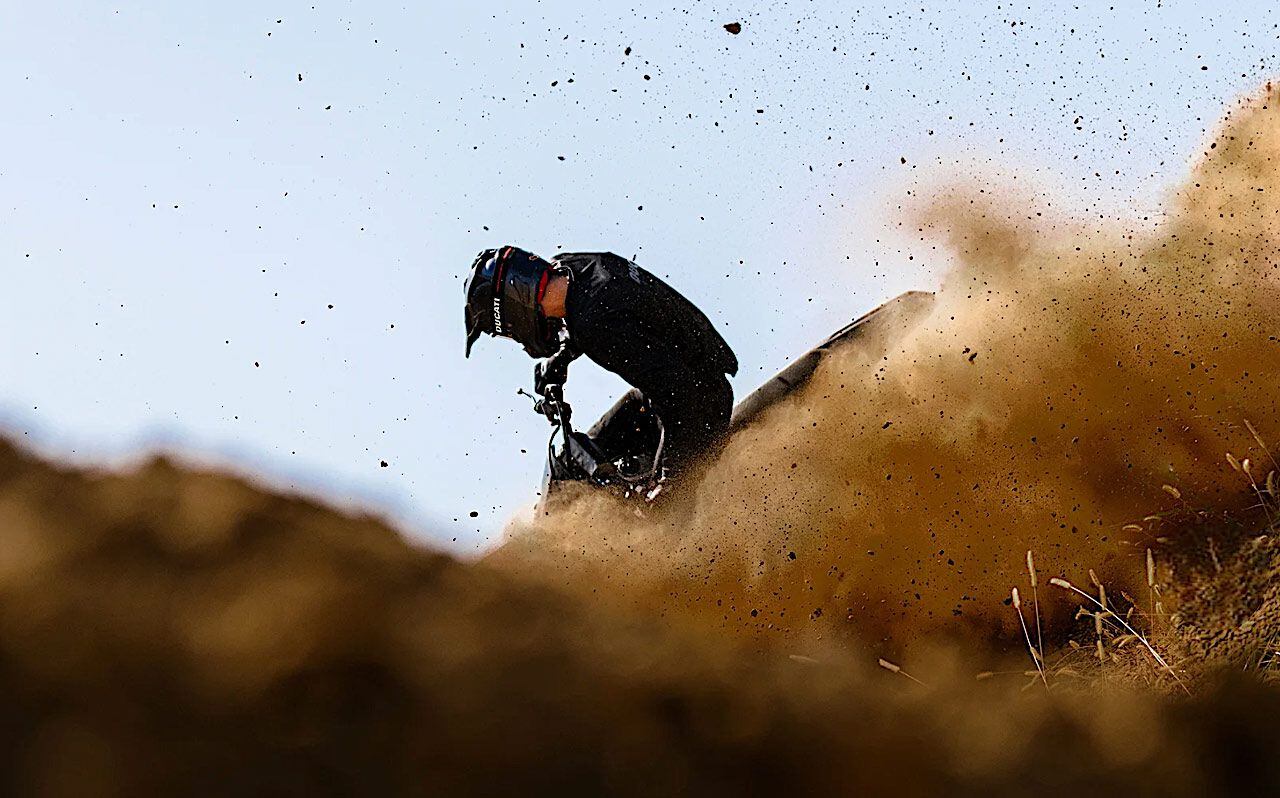
European motorcycle manufacturers traditionally known for streetbikes entering the off-road motorcycle market has been a hot topic of conversation lately, the latest being Ducati. The Italian manufacturer plans to have a complete range of dirt bikes in the coming years. (Ducati/)Related: 2024 Monster Energy Triumph Racing MX2 Team TF250X First Look
Ducati’s off-road motorcycle project is a combination of searching to make the bikes as light as possible coupled with top-of-the-line components. In an effort to give the engines a broad power delivery, the Bologna-based company will employ desmodromic valve control—a system that has become synonymous with its sportbikes.
Entering the dirt bike market is a new venture for Ducati, one that it says represents a very important and challenging strategic choice as well as the desire to expand its presence into unexplored terrain. Performance, style, and sophistication are the brand’s three core values. Engineers and designers will aim to implement those aspects into the Italian dirt bikes—first with prototype motocrossers and later production models across the off-road space.
-
The tried and tested Versys and KLR series are back for 2024.
-
The official image gives a few insights into what we can expect to see.
-
As polarizing as it is hotly anticipated, watching the new R 1300 GS get unboxed is still a treat.
-
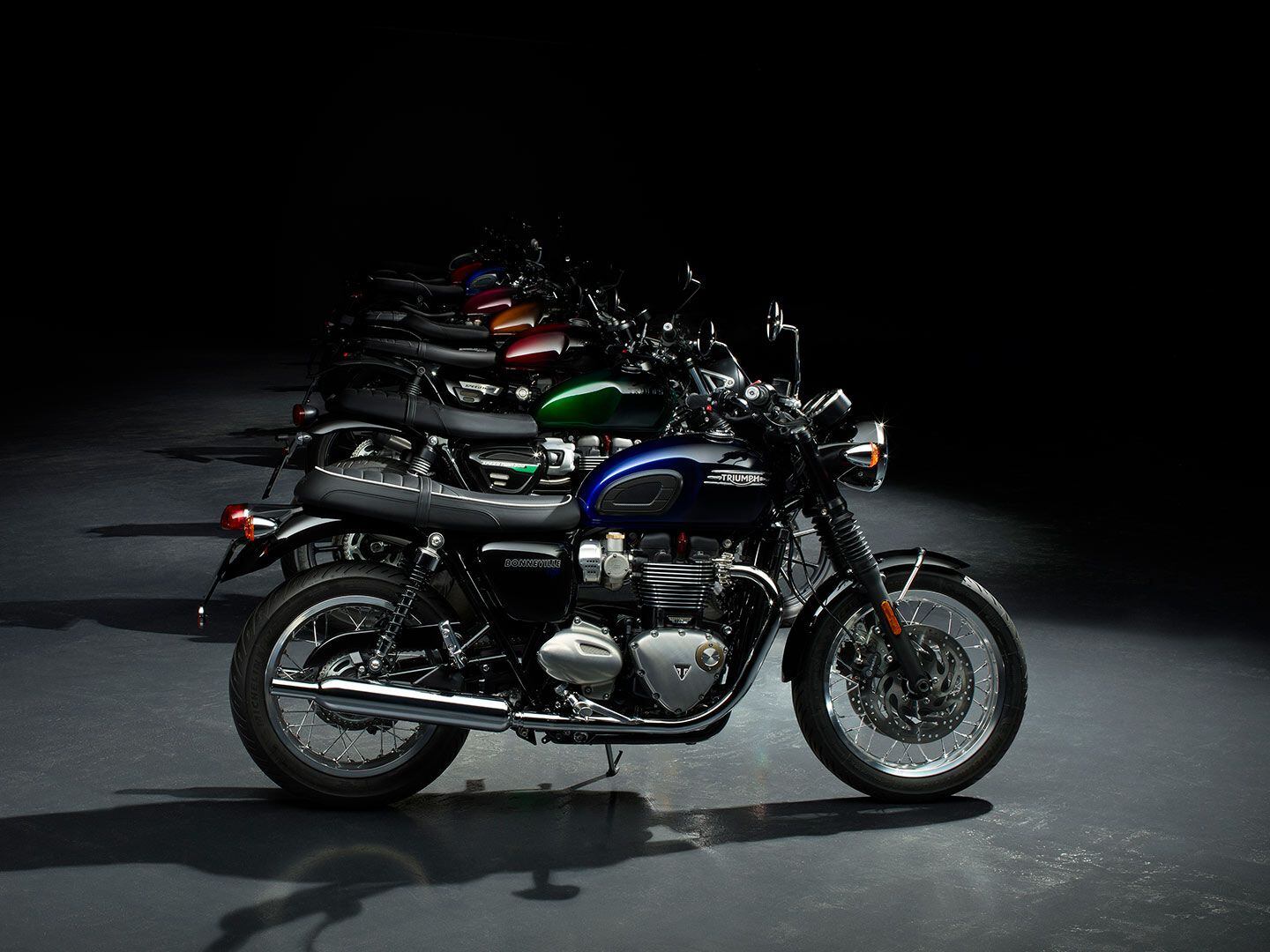
Triumph’s Stealth Edition models include a variety of Modern Classic bikes and will be made for a single year. (Triumph/)Triumph has hit upon a recipe for success with its recent “one-year-only” special-edition motorcycles. For 2024 the theme is a combination of black and candy metallics for the new Stealth Edition range.
Continuing in a similar manner to the Gold Line Editions of 2022 and the Chrome Collection that took over in 2023, the Stealth Edition bikes encompass Triumph’s Modern Classics range, offering exclusive paintwork for a small premium over the standard colors.
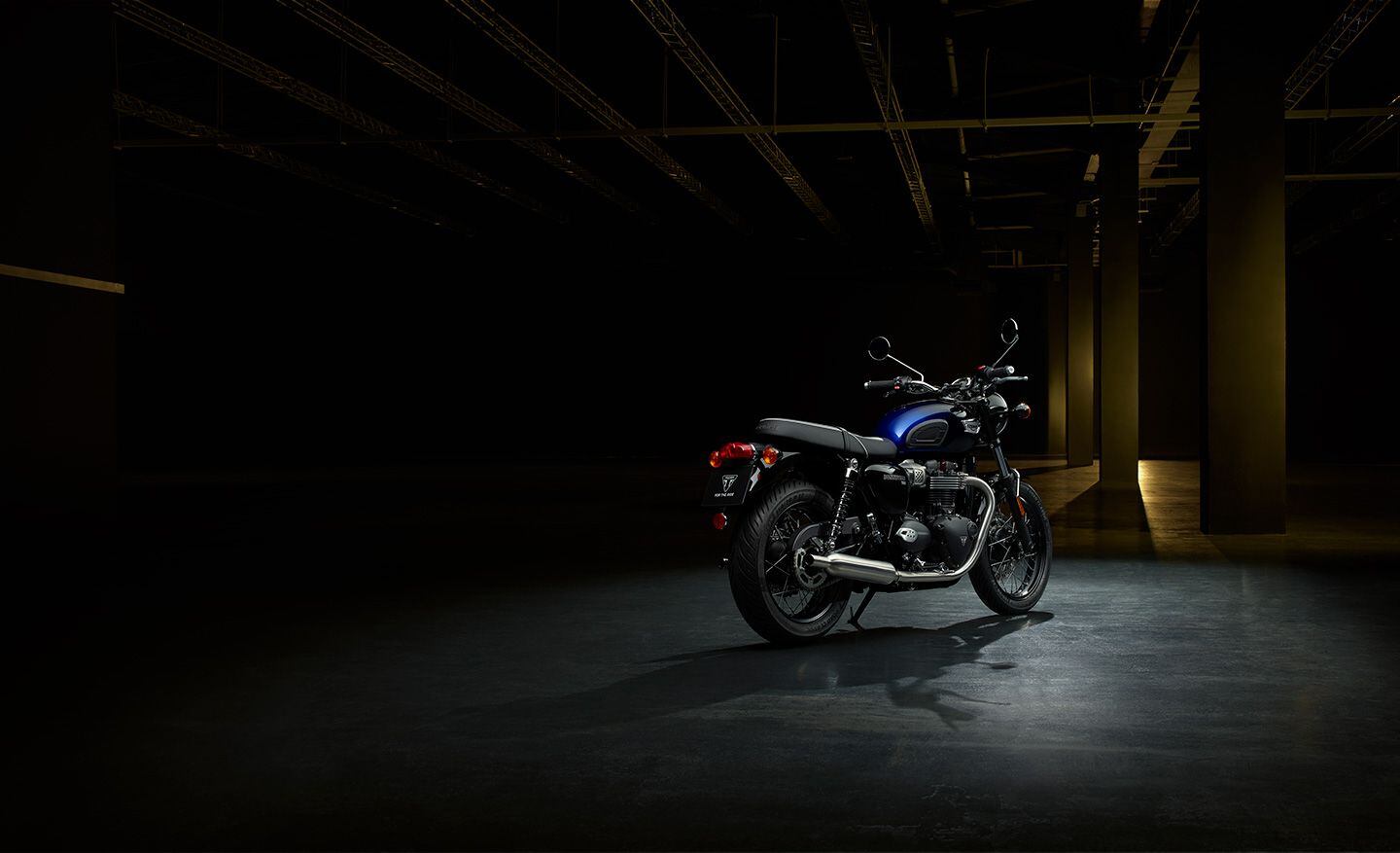
2024 Triumph Bonneville T100 in Blue Stealth. (Triumph/)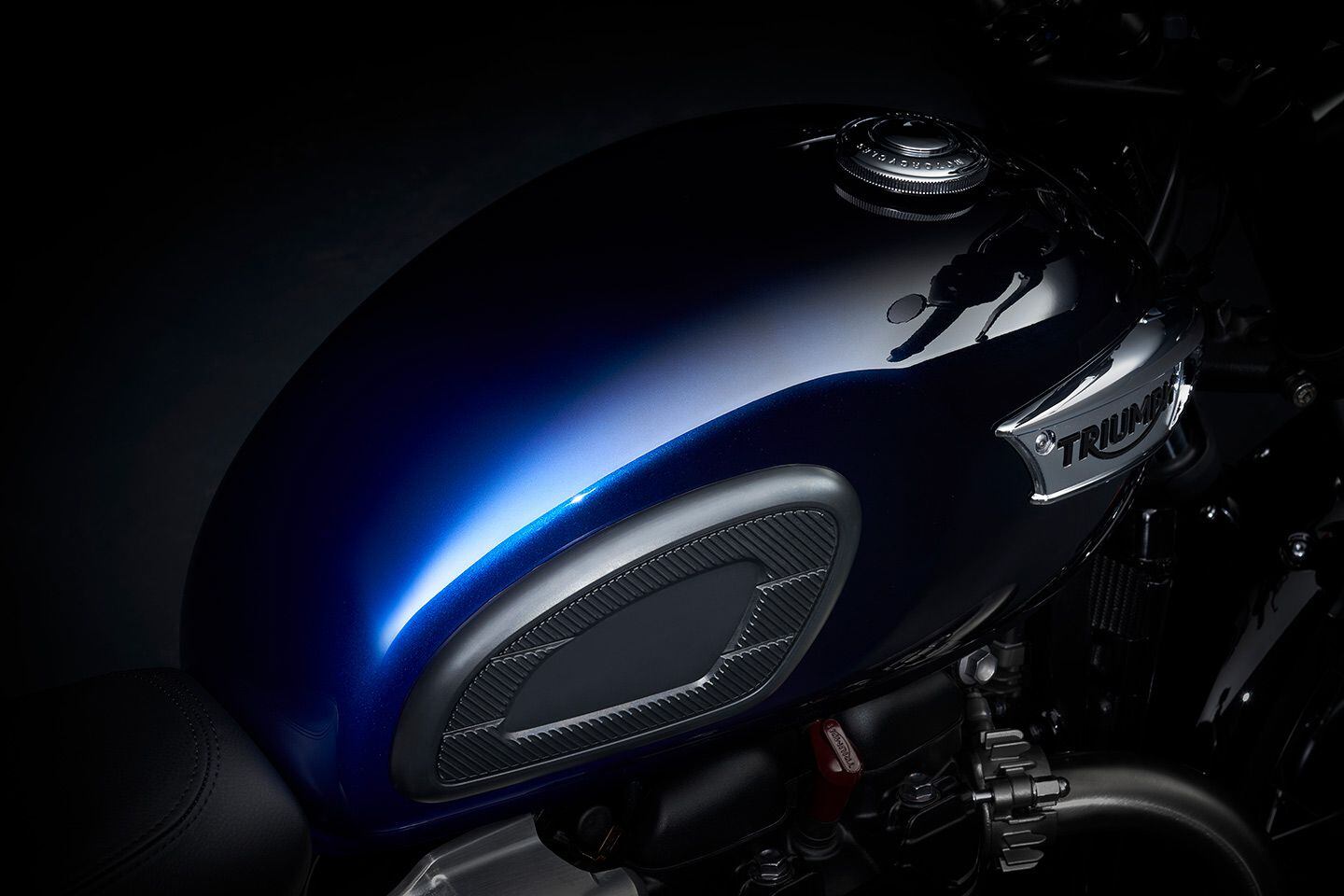
2024 Triumph Bonneville T100 in Blue Stealth. (Triumph/)The bikes feature hand-painted tanks that blend from black at the front to a range of candy metallic finishes at the back. Tied in with black forks, fenders, and headlight bowls, the look manages to be subtle but with a dash of eye-catching color. The tank paintwork is achieved from a silver metallic base coat, with the black fade applied on top before multiple layers of tinted lacquer add the final color, creating an effect that changes depending on the light.
Eight bikes get the treatment for 2024, each model with its own unique color. The Bonneville Speedmaster, for instance, comes in Red Stealth Edition while its related Bonneville Bobber sibling comes as a Purple Stealth Edition variant. Shifting across to the more standard Bonnevilles, the 900cc T100 Blue Stealth Edition and 1,200cc T120 Blue Stealth Edition—both with blue tanks—are the main options, while the T120 Black Stealth Edition gets a tank that fades to silver at the back, with blacked-out engine, rims, matt black mudguards and engine covers, and a black exhaust.
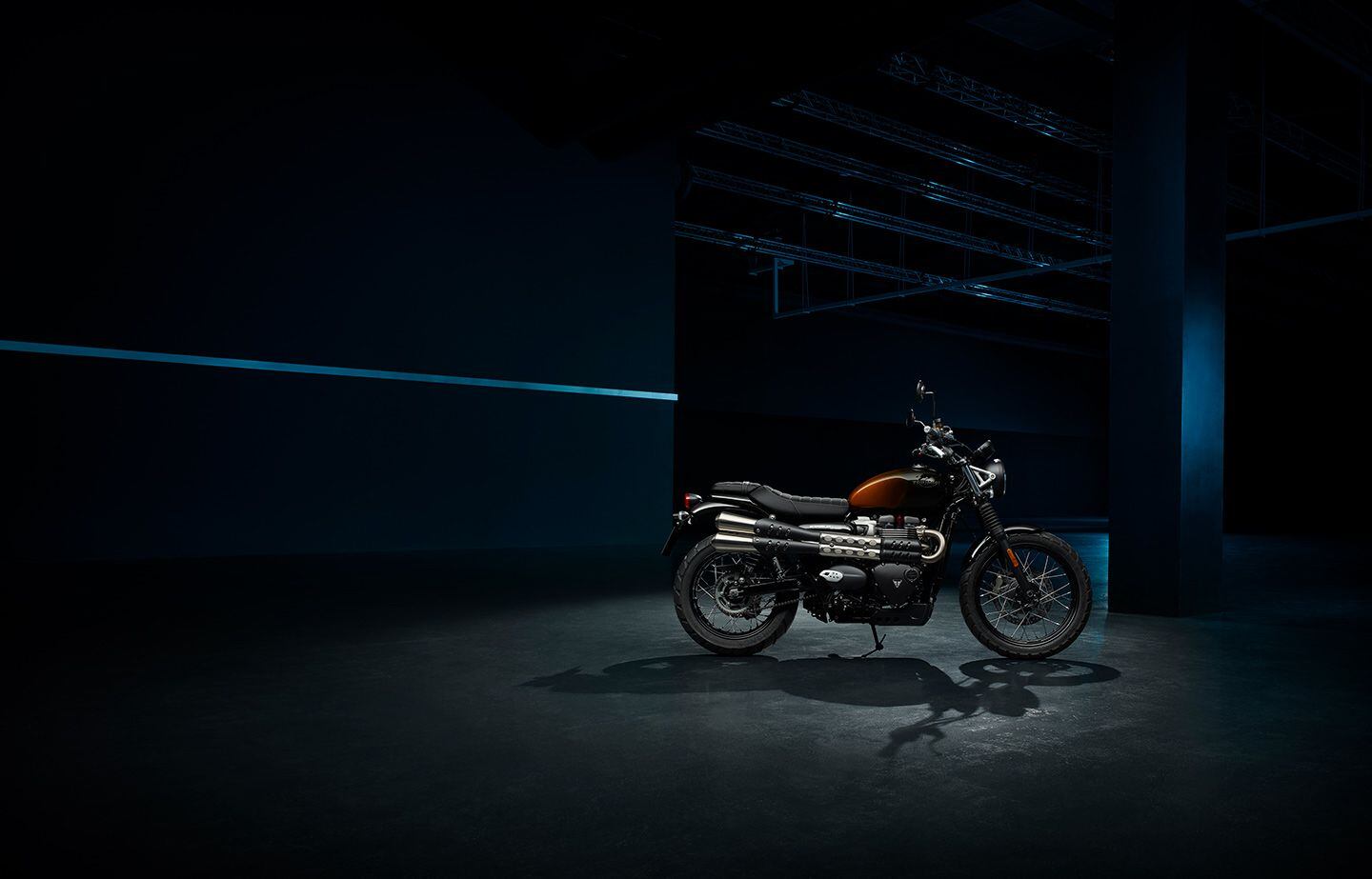
2024 Triumph Scrambler 900 in Orange Stealth. (Triumph/)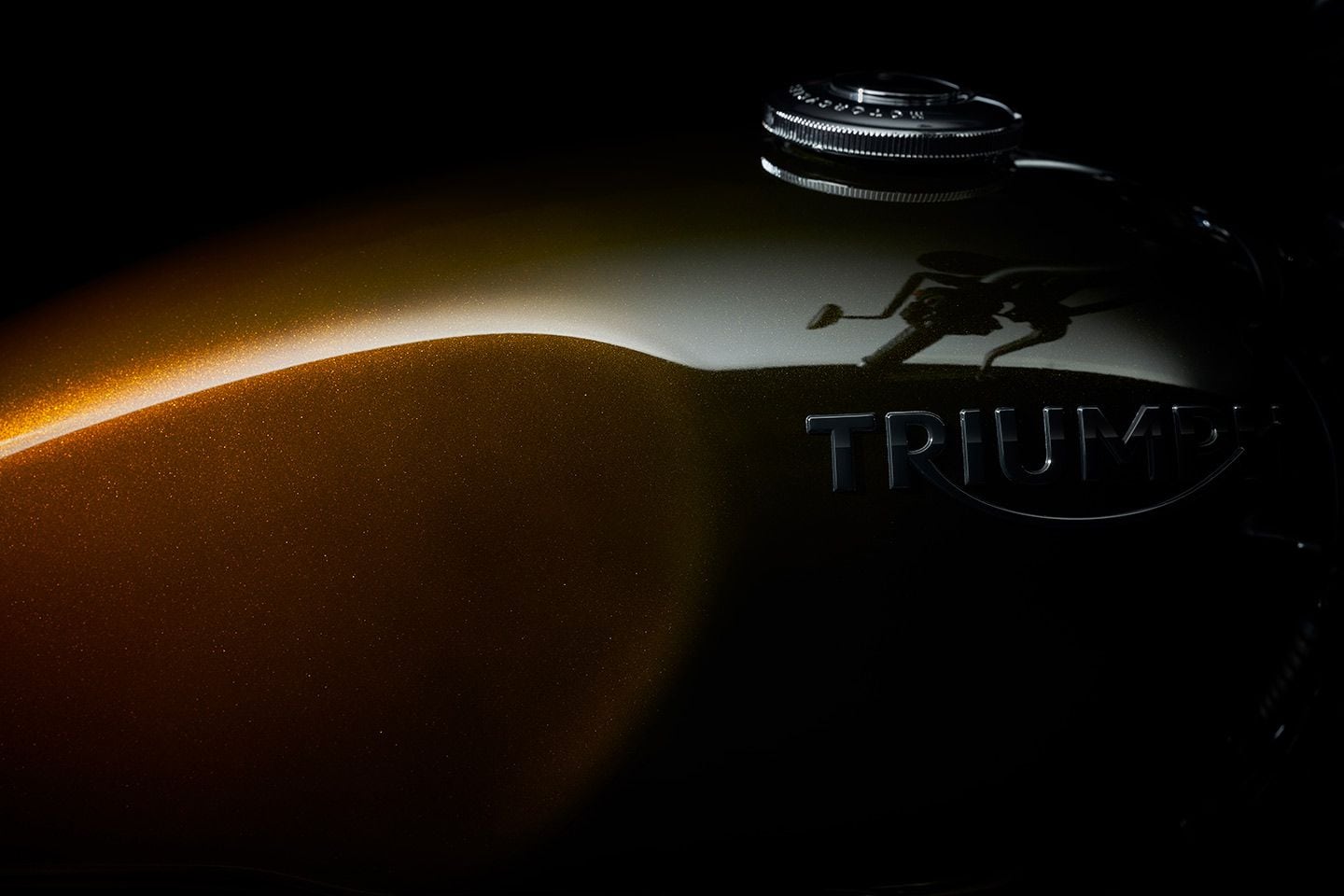
2024 Triumph Scrambler 900 in Orange Stealth. (Triumph/)The Speed Twin 1200 comes as a Red Stealth Edition, while the smaller Speed Twin 900 is available as the Green Stealth Edition for 2024. The Scrambler 900 comes in Orange Stealth Edition form. There’s no “Stealth” version of the Scrambler 1200 range, which has recently been updated for 2024, and similarly the Thruxton doesn’t get a “Stealth” variant, instead going into its last year in 2024 as the Thruxton Final Edition.
When it comes to pricing, Triumph follows the same pattern it adopted for the Gold Line and Chrome Collection models over the last couple of years. That means the 1,200cc Stealth Edition bikes all get an $800 premium over the MSRP of their equivalent base model, while the smaller 900cc Stealth Edition models are $750 more expensive than the base versions.
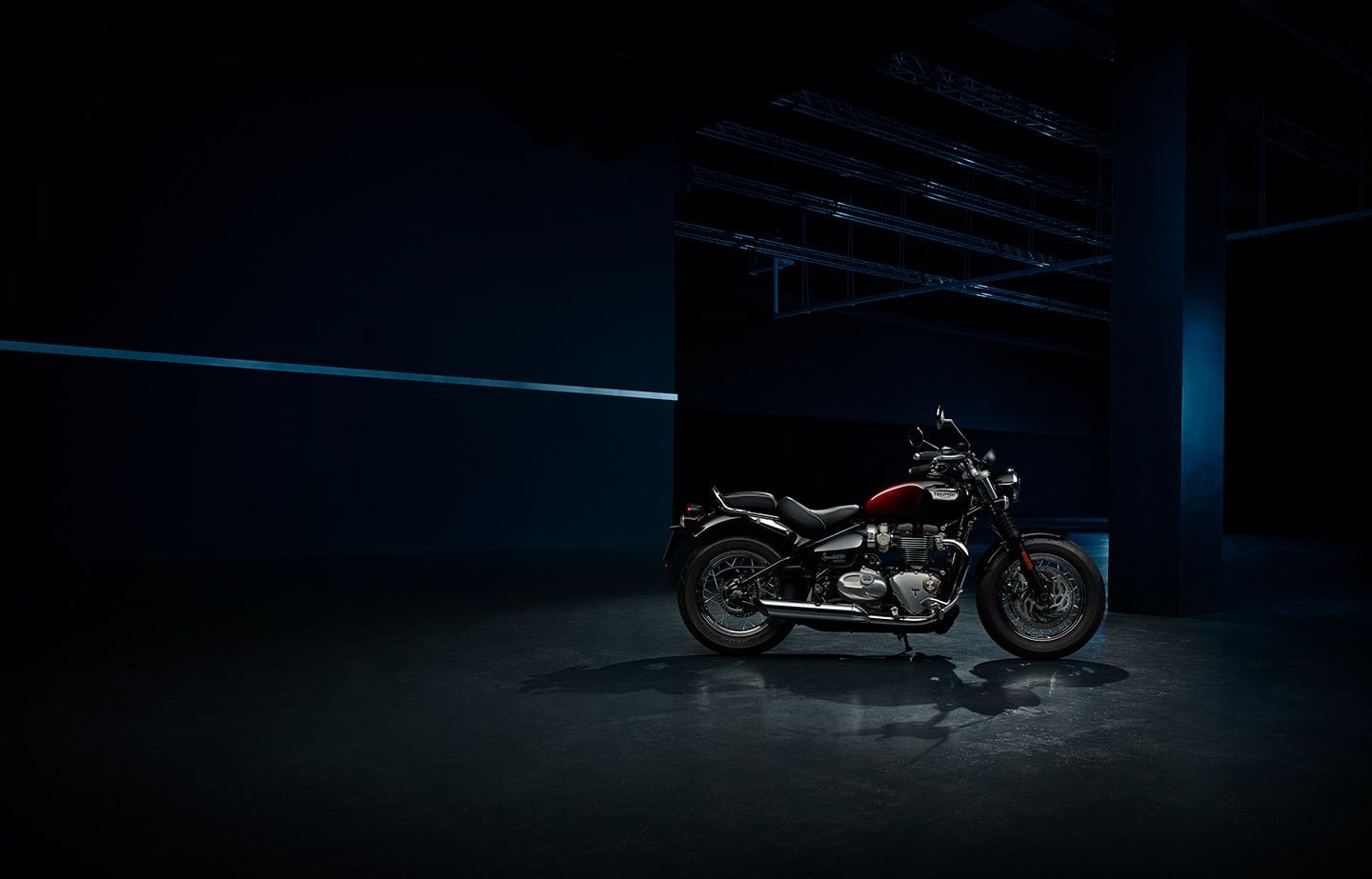
2024 Triumph Speedmaster in Red Stealth. (Triumph/)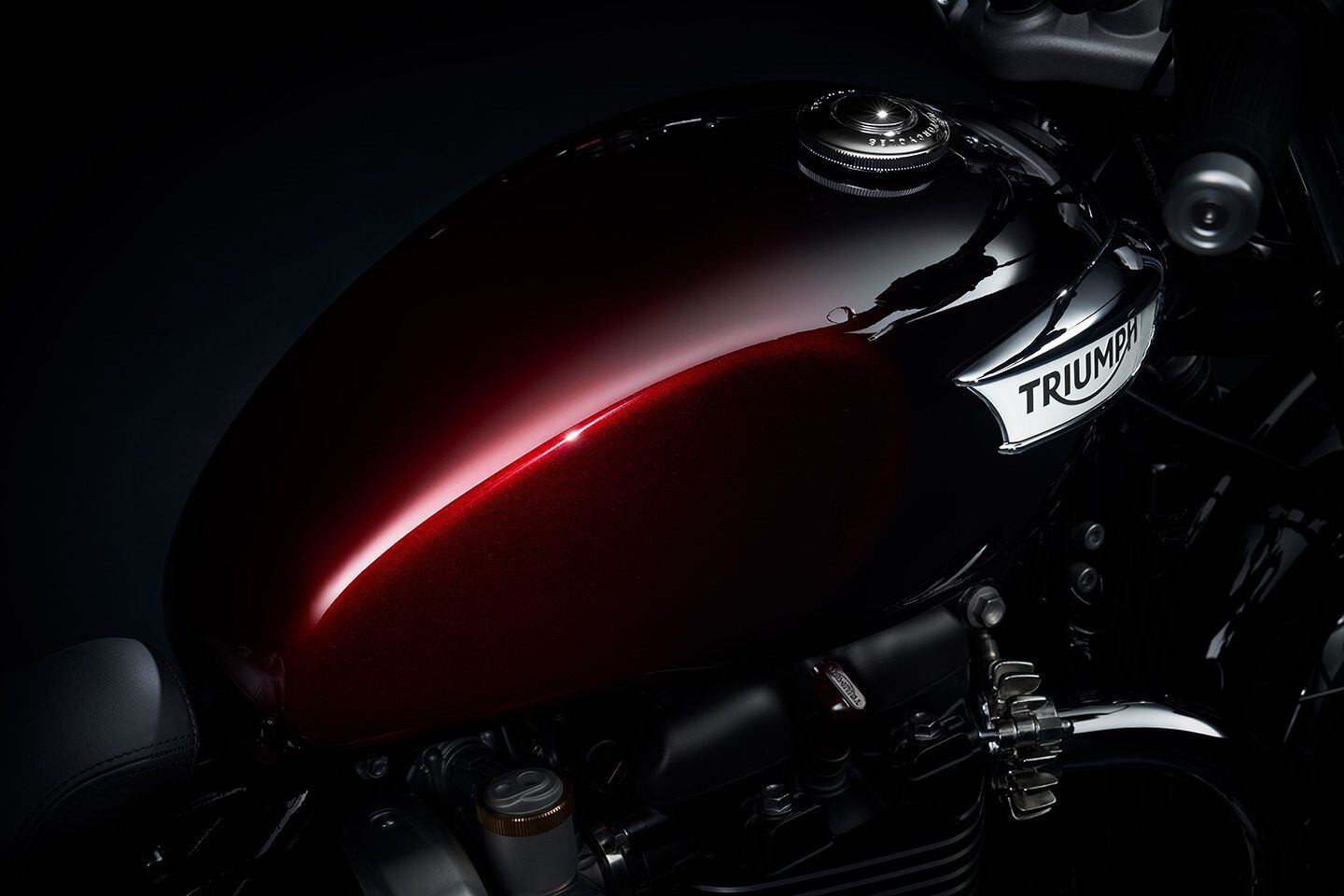
2024 Triumph Speedmaster in Red Stealth. (Triumph/)The Stealth Edition models are due in production in February 2024, and will only be made for one year, just like their Gold Line and Chrome Collection predecessors. No doubt there will be another new limited-production range for 2025, but in the three years that Triumph has used the one-year-only model pattern the company has found very different directions for each collection, so if you like the look of the Stealth Edition bikes, you’ll need to get your hands on a 2024 model.
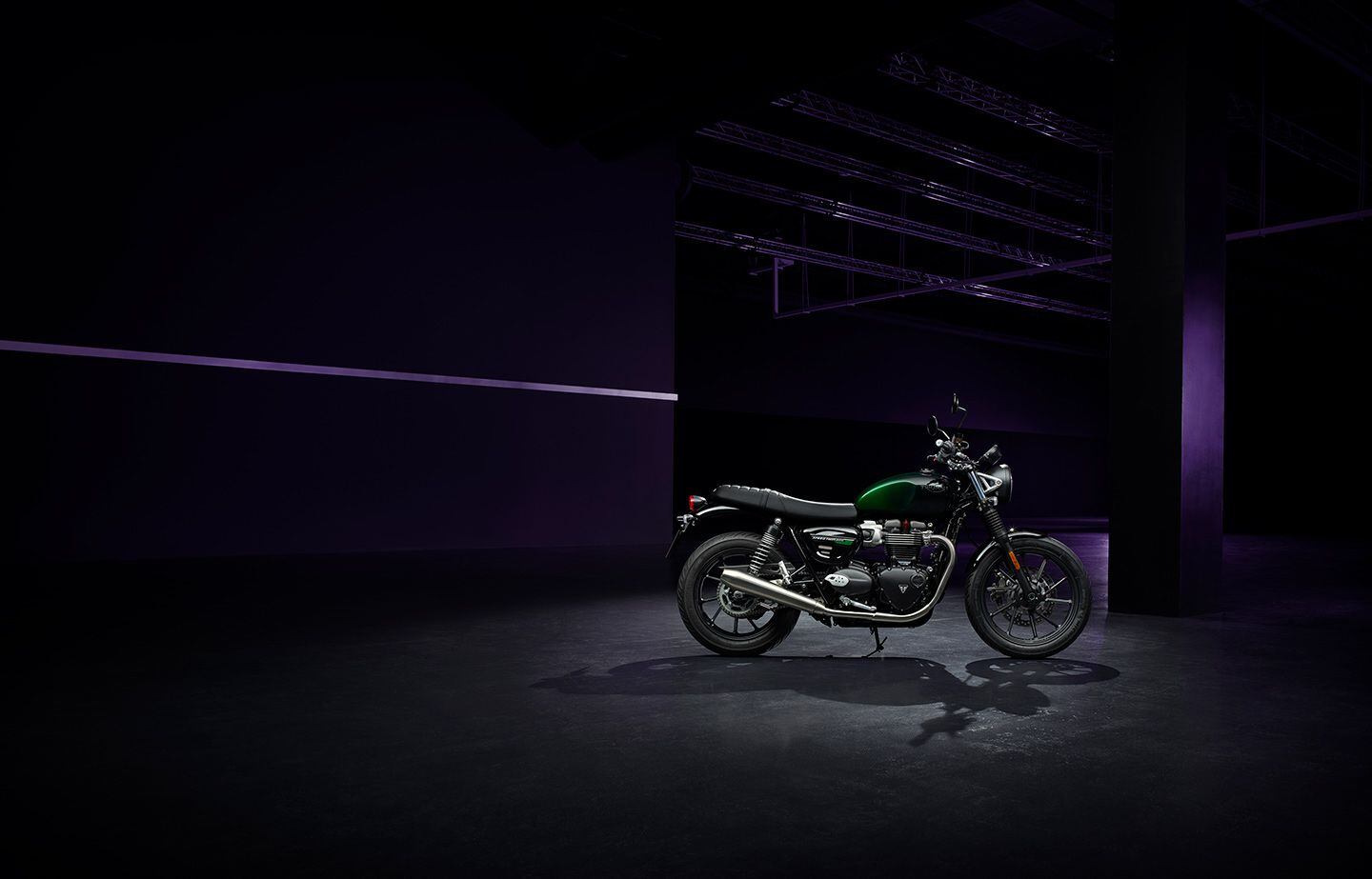
2024 Triumph Speed Twin 900 in Green Stealth. (Triumph/)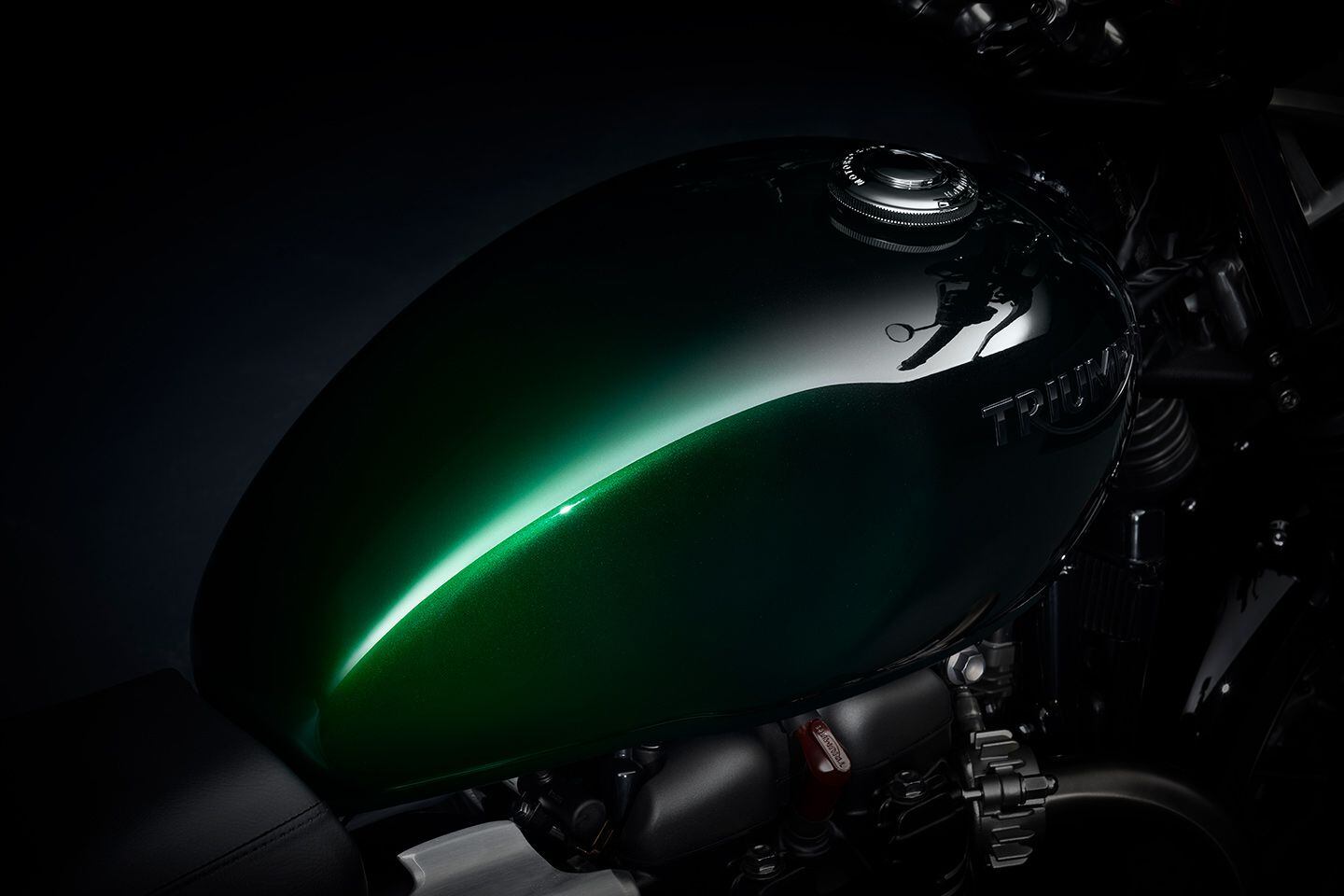
2024 Triumph Speed Twin 900 in Green Stealth. (Triumph/)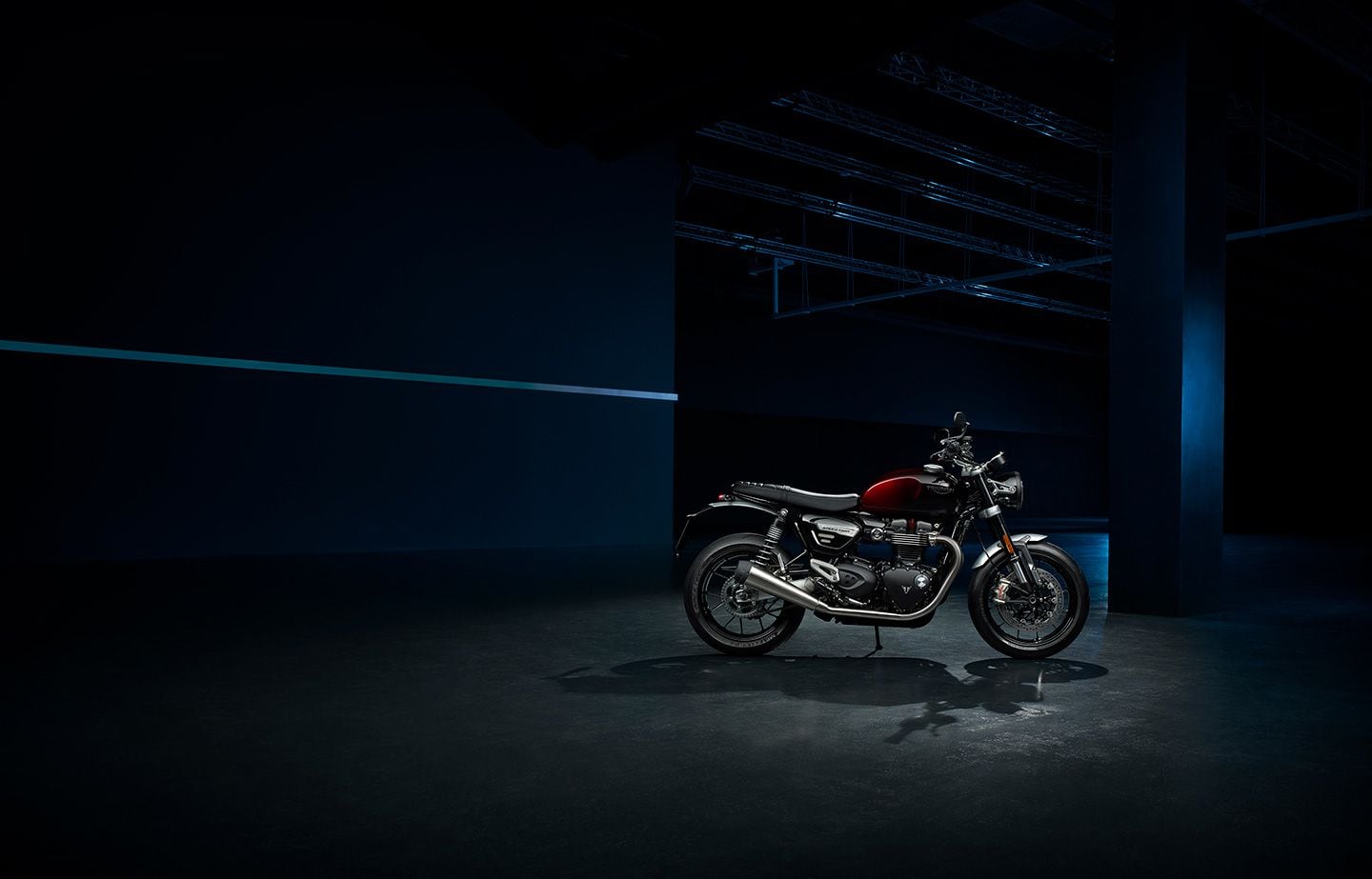
2024 Triumph Speed Twin 1200 in Red Stealth. (Triumph/)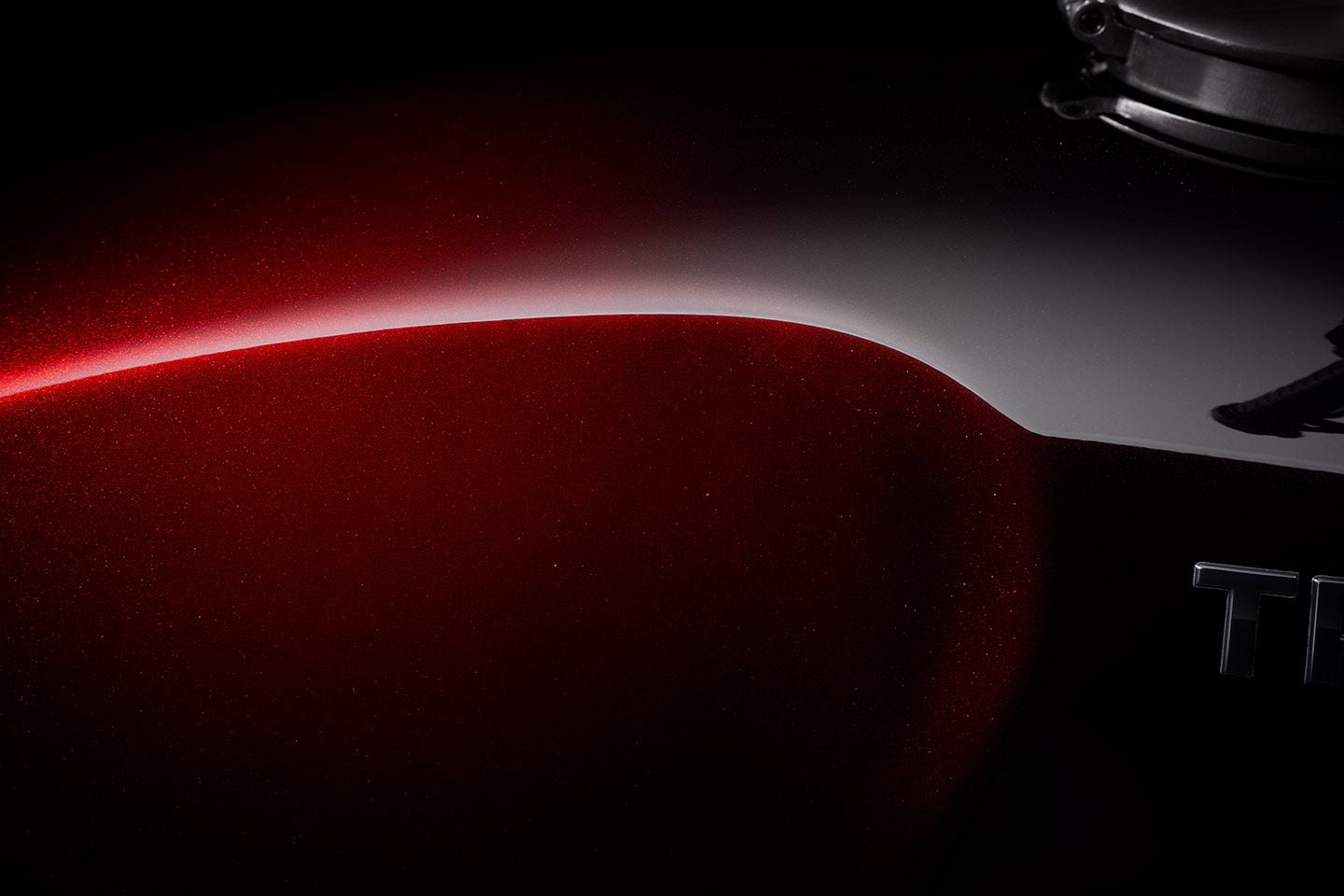
2024 Triumph Speed Twin 1200 in Red Stealth. (Triumph/)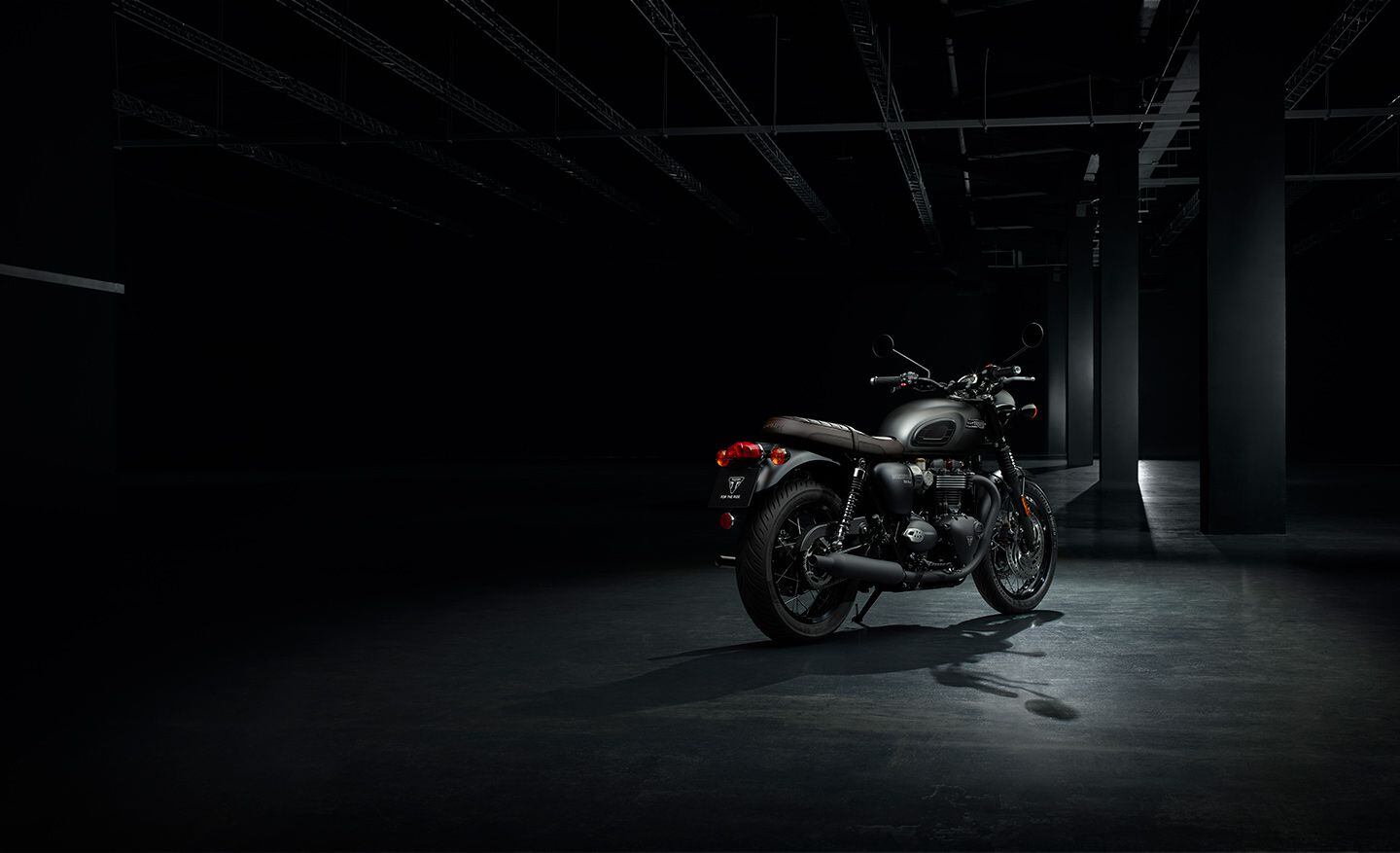
2024 Triumph Boneeville T120 in Black & Silver Stealth. (Triumph/)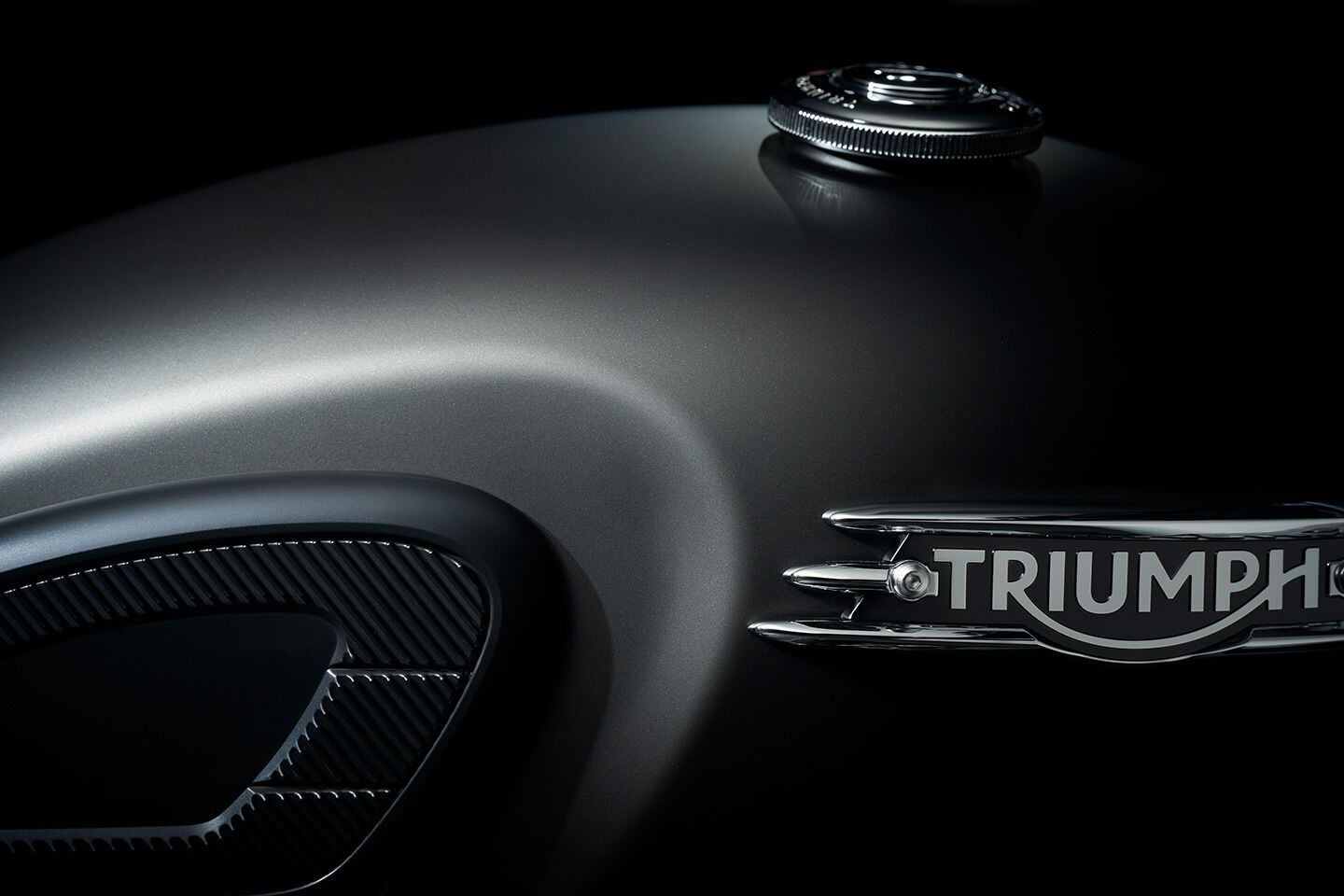
2024 Triumph Boneeville T120 in Black & Silver Stealth. (Triumph/)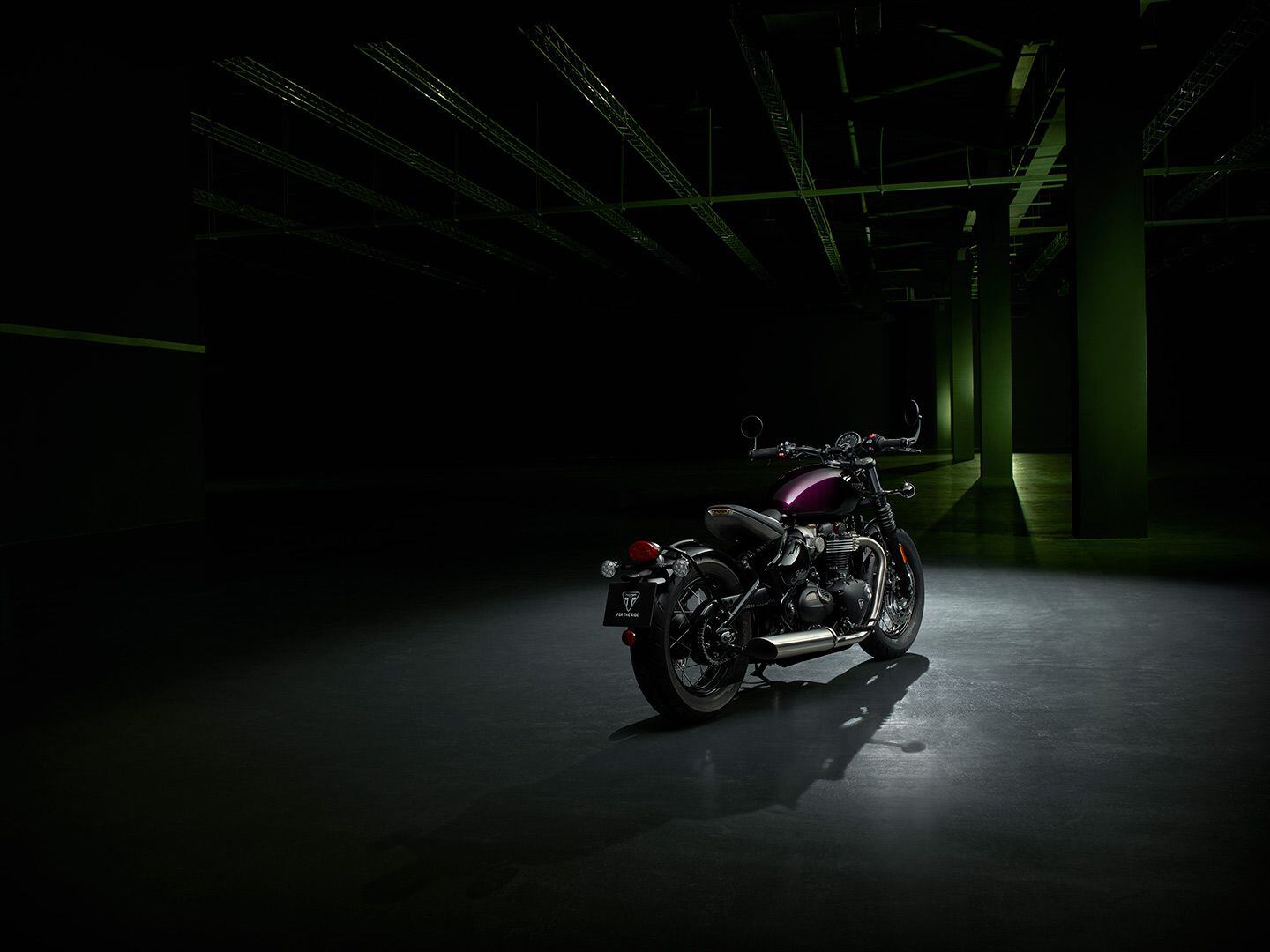
2024 Triumph Bobber in Purple Stealth. (Triumph/)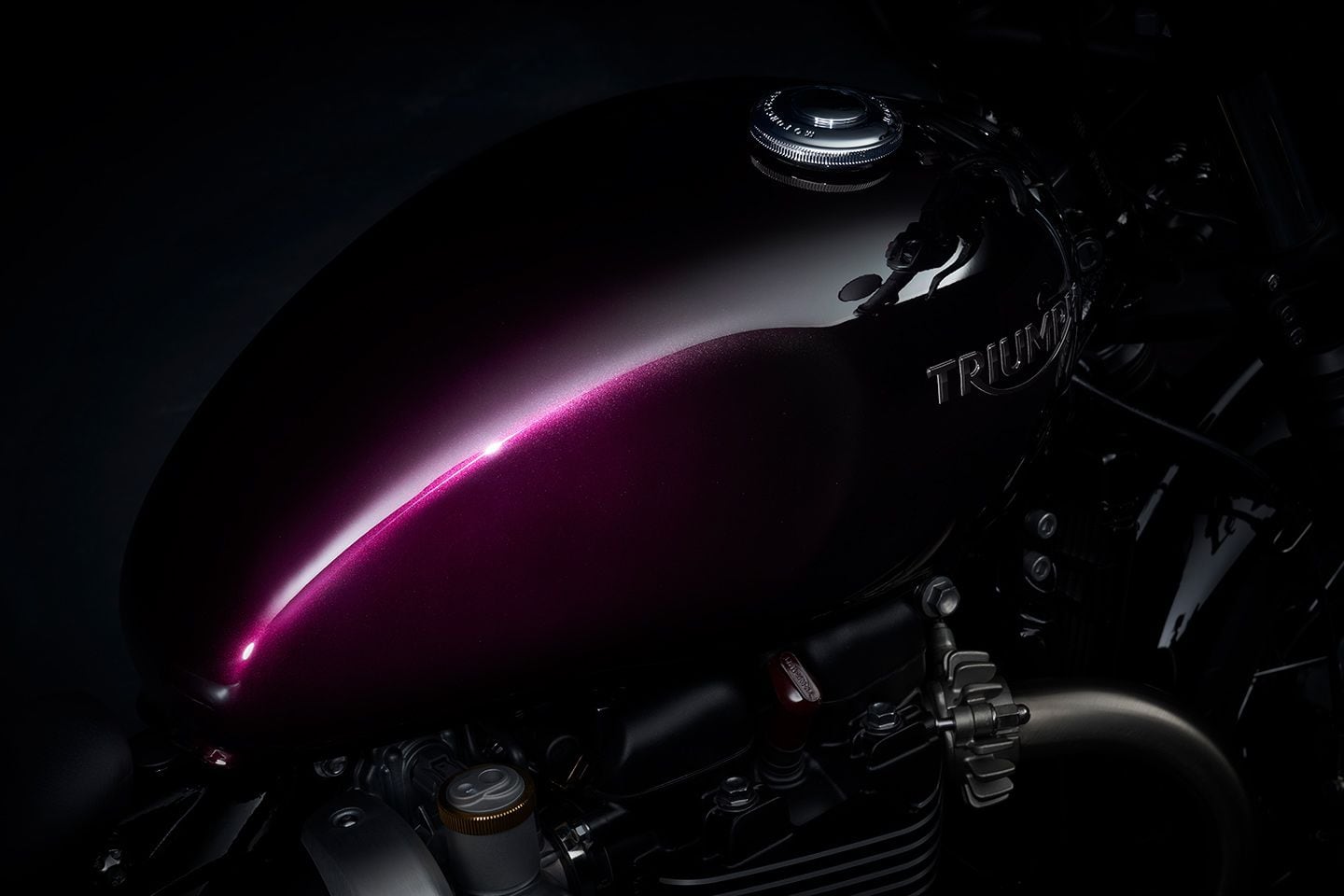
2024 Triumph Bobber in Purple Stealth. (Triumph/)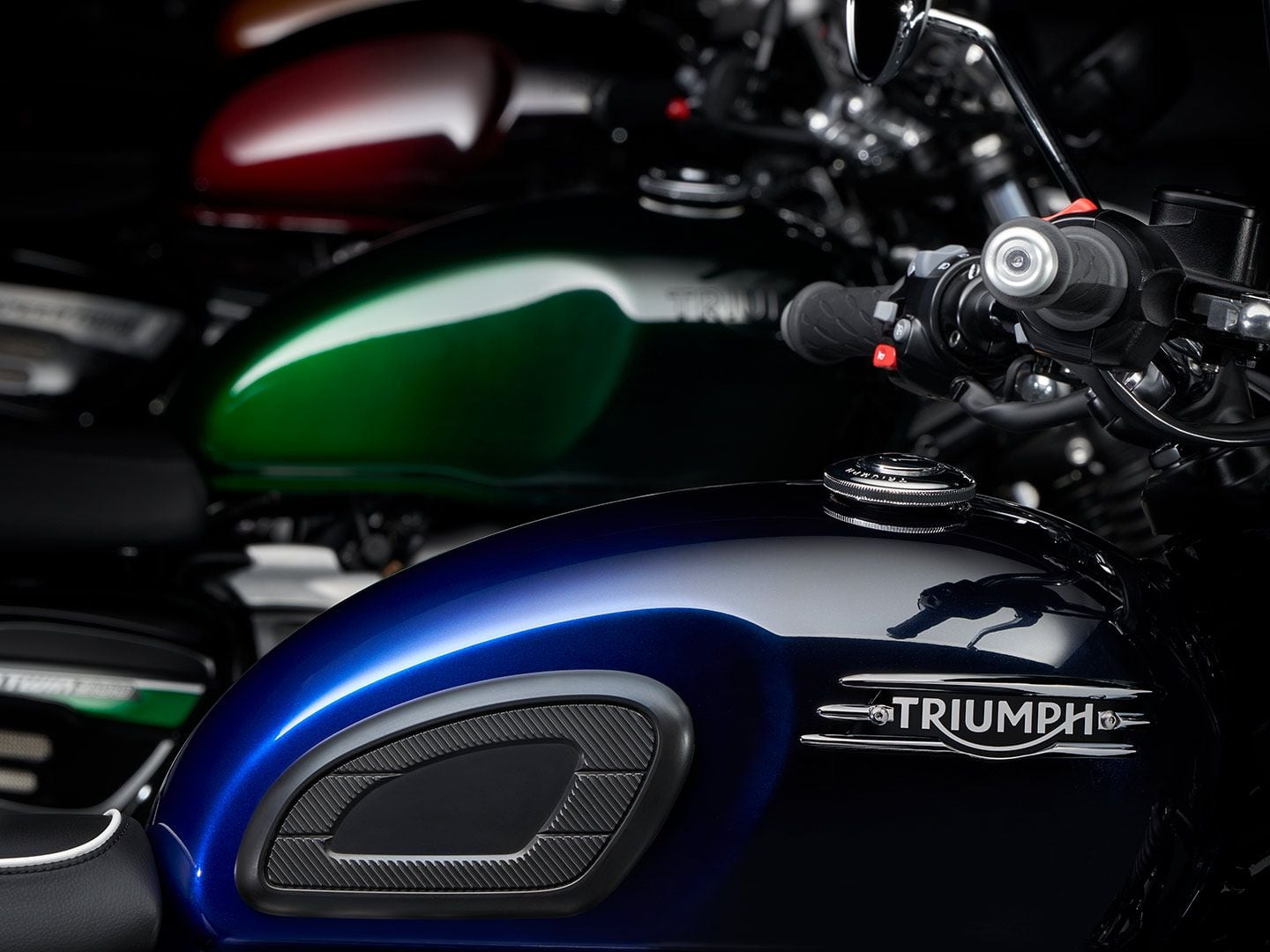
Triumph’s 2024 Stealth Editions. (Triumph/)-
 1
1
-
-
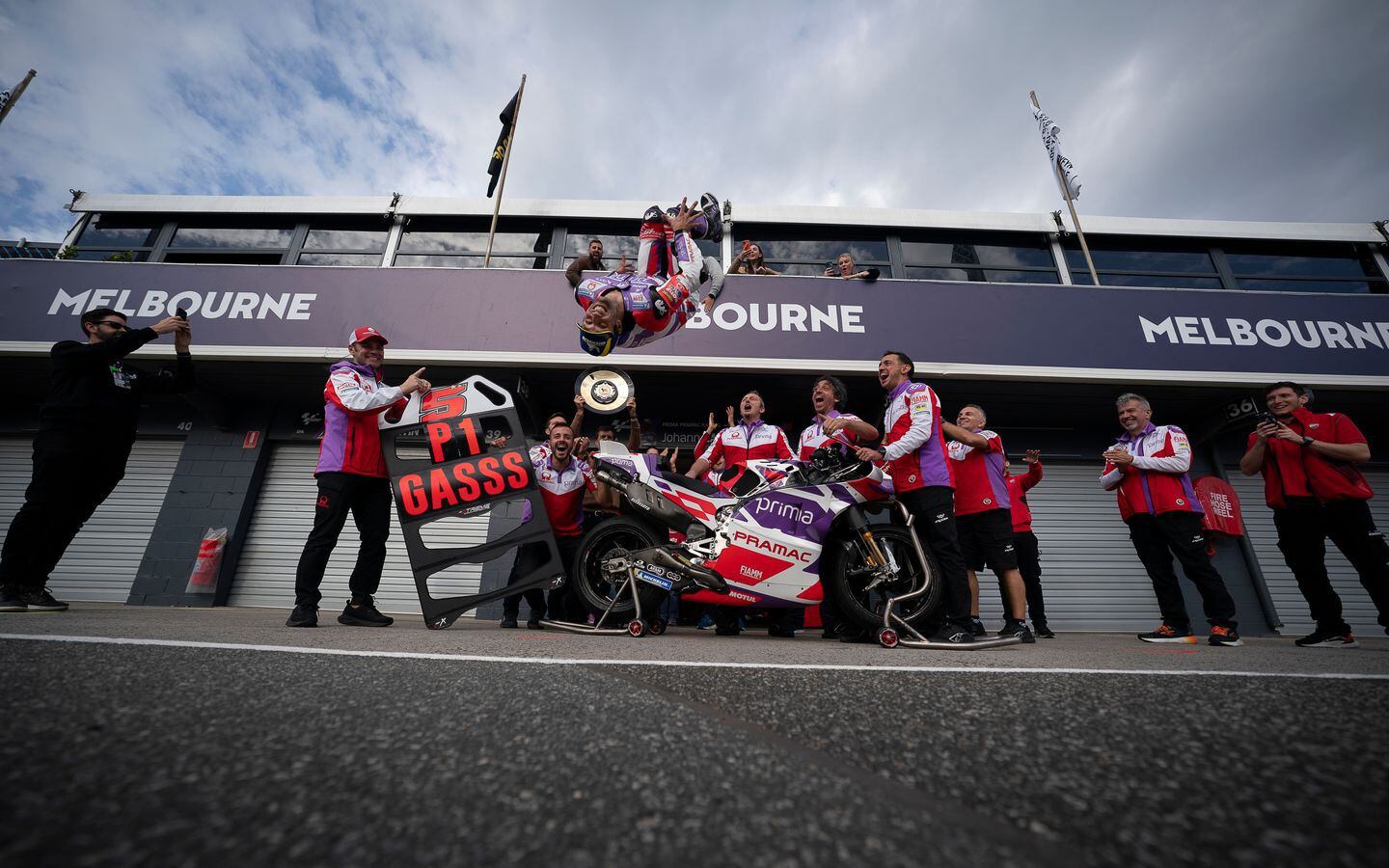
Johan Zarco caught Jorge Martín on the last lap to take his maiden MotoGP win at Phillip Island. (MotoGP/)When high winds and rain were predicted for Phillip Island on Sunday, it was decided to move the 27-lap MotoGP event to Saturday afternoon, then run the 13-lap sprint Sunday. Unfortunately, conditions forbade racing on Sunday so the sprint was canceled.
Continuing his outstanding recent performance, Jorge Martín (Prima Pramac Duc) set a new lap record in qualifying, causing all observers to expect a grand struggle between him and current MotoGP champion and series leader Francesco Bagnaia (Ducati Lenovo Team). In Indonesia a week ago, Martín had taken the title lead by winning the Saturday sprint, but then fell while leading Sunday’s race.
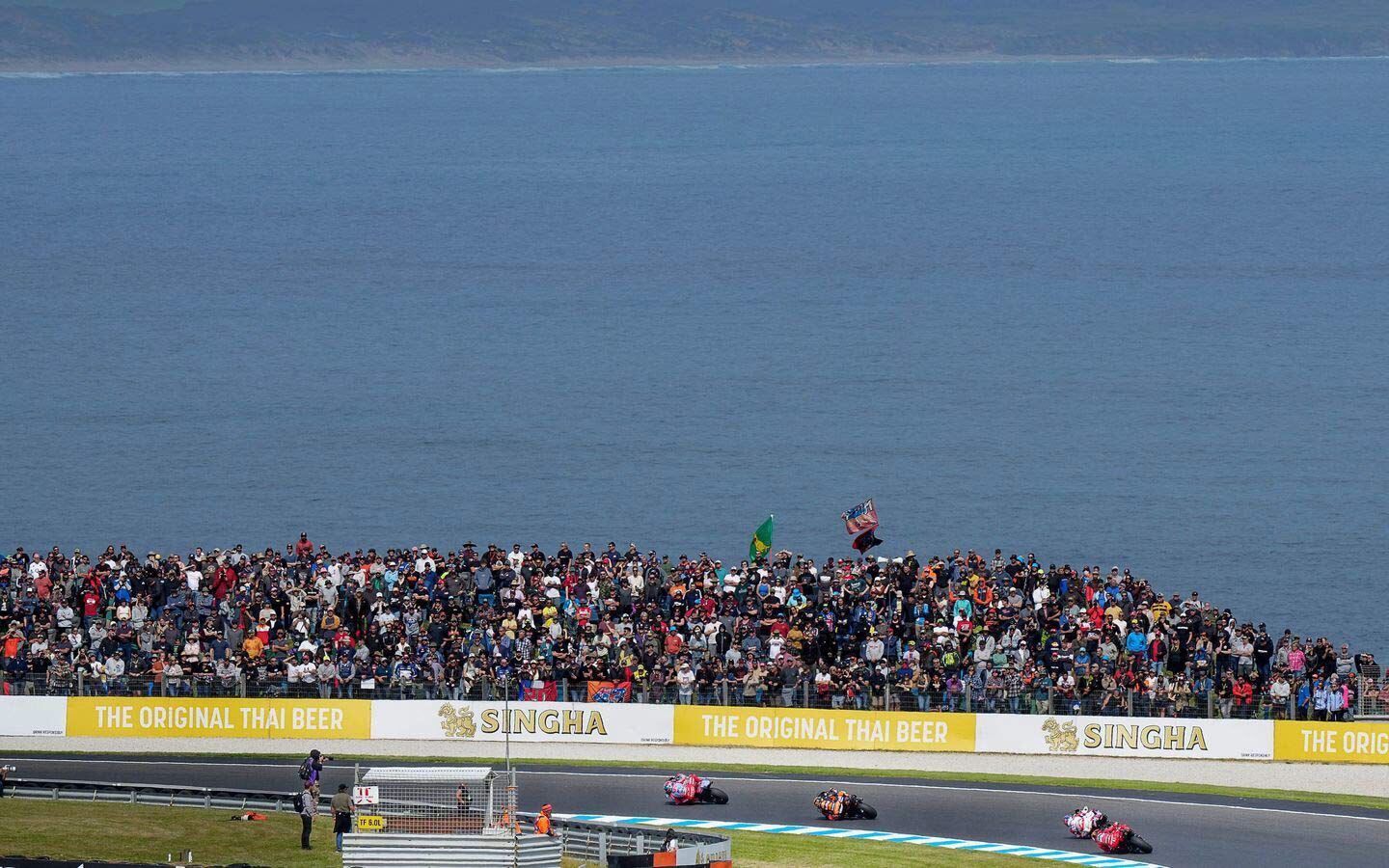
The bulk of Saturday’s race was a show between Fabio Di Giannantonio, Brad Binder, Zarco, and Pecco Bagnaia, with Martín off to an early lead. That would all change with a few laps to go. (MotoGP/)When the flag dropped at Phillip Island, Martín on a soft rear tire (18 rivals chose the medium) went straight into the lead, which he then held for 26 of the 27 laps. The Spaniard was 2.5 seconds ahead on lap 9, his lead peaking at 4.5 seconds on lap 15. But as his soft rear tire gradually dropped, he yielded about a third of a second of his lead each lap to reduce the tire’s rate of decline.
It wasn’t to be. At the beginning of the last lap, Johann Zarco (Martín’s Ducati teammate) passed Martín for the lead, which opened the door for Bagnaia, with Fabio Di Giannantonio (Gresini Duc) and Brad Binder (factory KTM) slipping by moments later. The finish order was Zarco, Bagnaia, Di Giannantonio, Binder, and Martín.
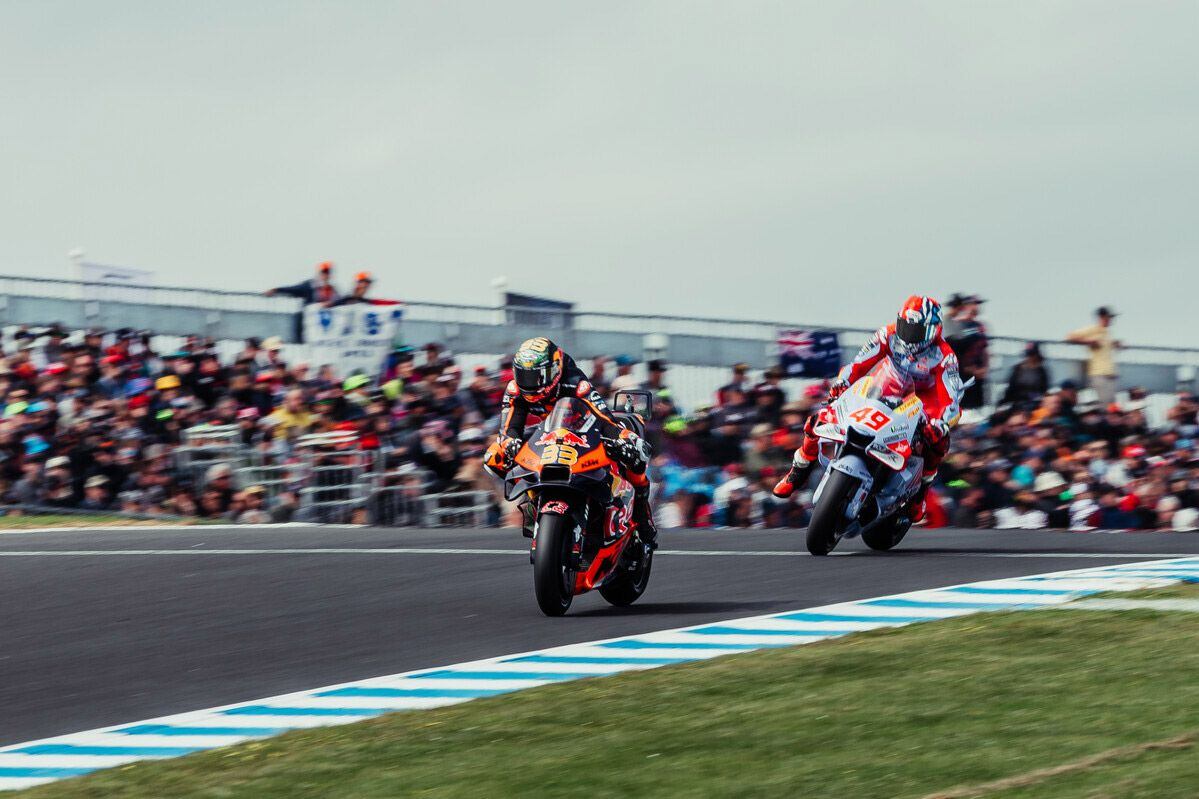
Binder once again demonstrated the strength of KTM’s new carbon fiber chassis by running with the leading Ducatis. (KTM/)After the race Marc Márquez (who finished 15th on factory Repsol Honda) summed up the nearly all-Ducati charge by saying, “Jorge, Bagnaia, and sometimes Bezzecchi, are the ones who make the difference. When you see a group of riders with the same bike and the same pace, it means that they’re making the most of it.
“When instead you see one or two who manage to lower their times by three- or four-tenths compared to the others, it means they’re making a difference. Di Giannantonio is a rider who has had some good races and did well today, even if he doesn’t have the consistency of others.”
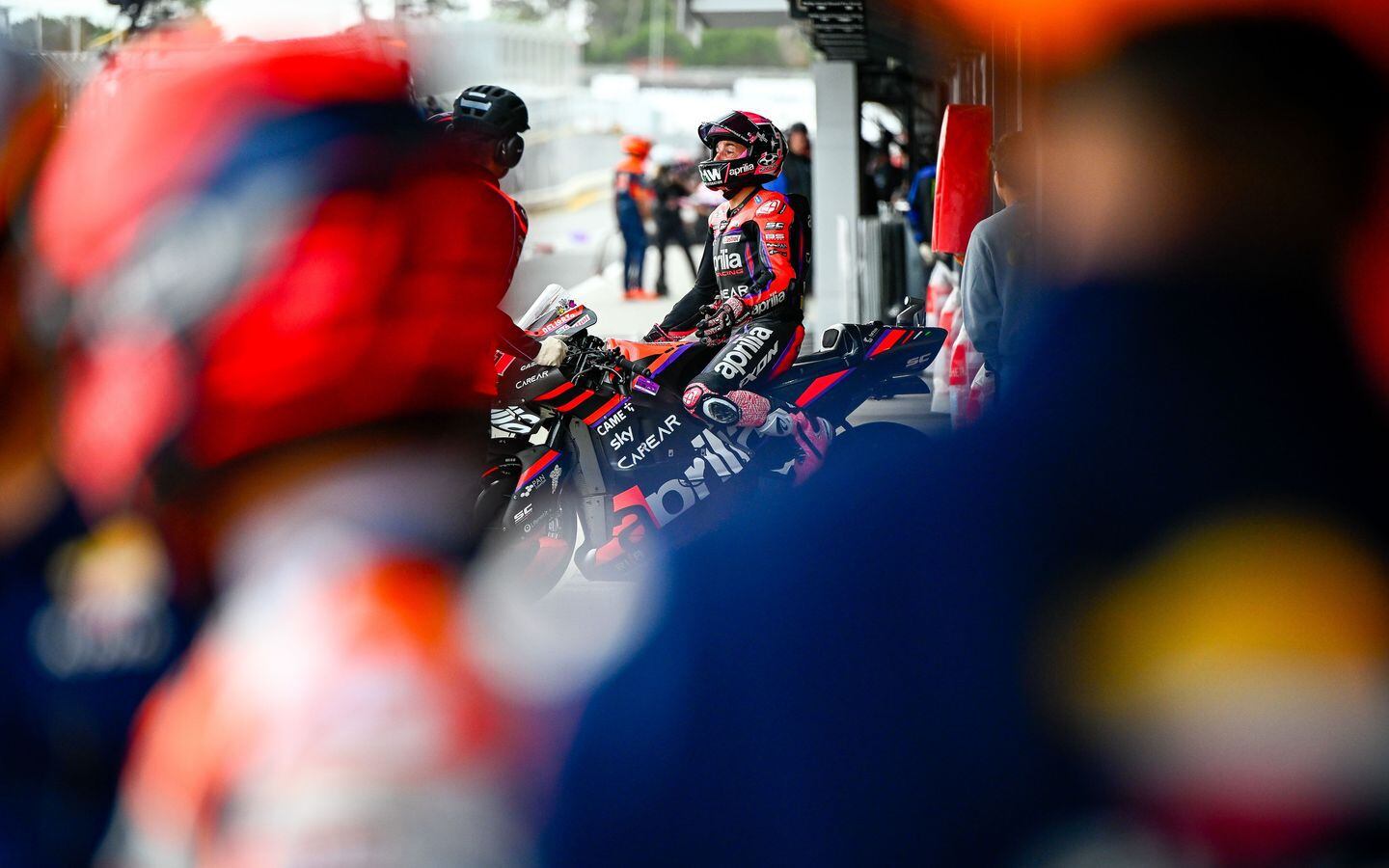
Aprilia riders showed signs of speed all weekend, but weren’t able to put a result together. (MotoGP/)Speaking of Martín’s choice of the soft rear, Márquez added, “Last year [here], I got on the podium with that tire. This year, the gamble didn’t pay off.”
What changed?
Fabio Quartararo, the 2021 champion who now struggles to make the top 10 on his factory Yamaha, said, “I’m half a second faster [here] than last year, but I’m 17th! Our bike gets more difficult to turn every year.”
Several riders noted that the track is bumpier than before, with less grip. Bagnaia commented, “This year the grip level was less than last year but the performance was faster.”
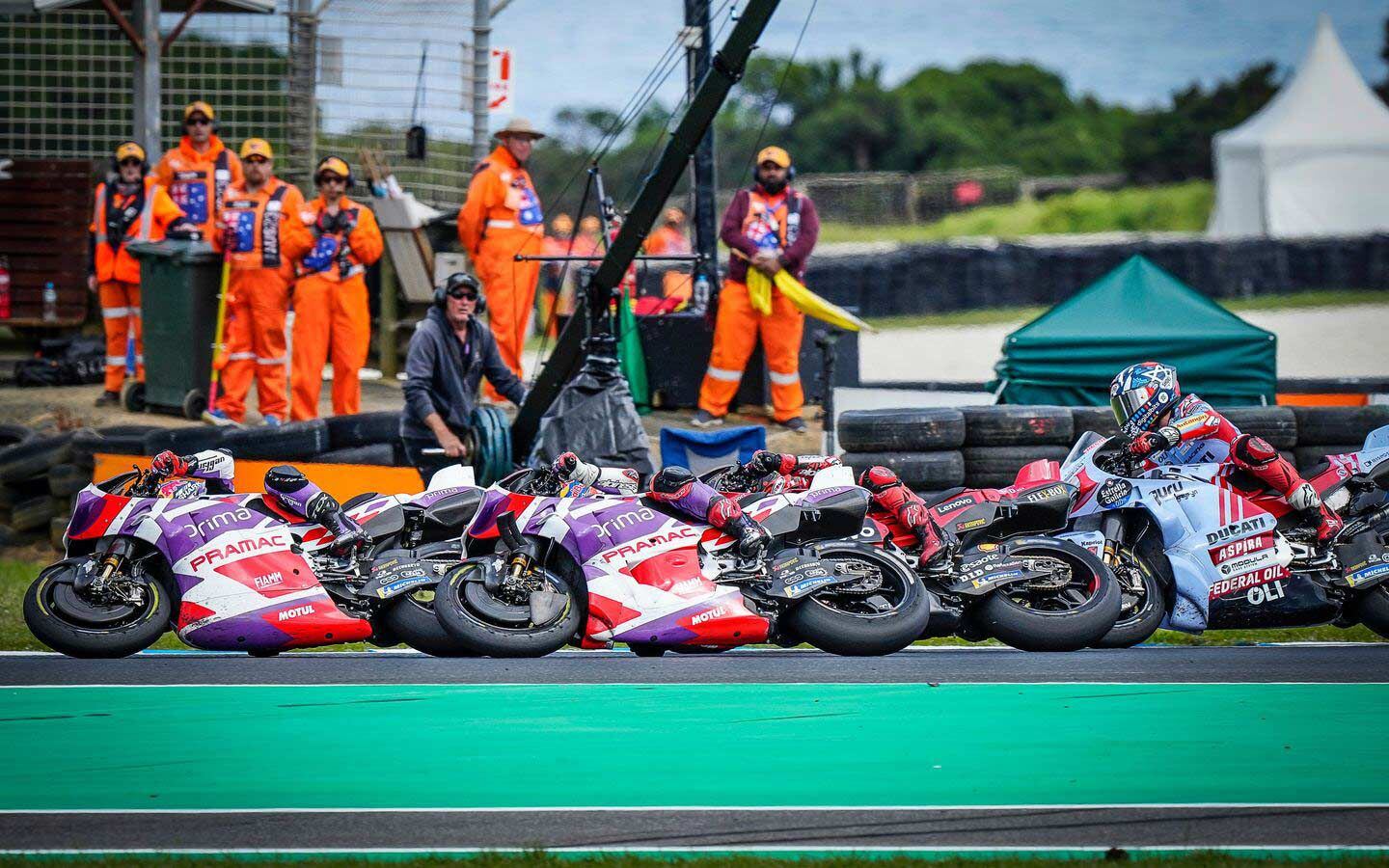
That was close. Zarco passed for the lead, which then opened the door for Bagnaia. (MotoGP/)Why does a tire that made the podium last year give up before the end this year? How did Martín set a new lap record, and why is the field faster when the track is bumpier and offers less grip? One possible answer is the new technique of using excess engine power to drive a larger aero downforce array. With high-power bikes such as Ducati and KTM able to generate more downforce off medium-speed corners, there is less need for intervention by electronic anti-wheelie systems. They work by cutting throttle just enough to keep the front wheel on the job. But increased downforce becomes increased acceleration.
Not for the frustrated Quartararo, whose Yamaha cannot presently afford the power to push a competitive downforce array.
Top riders are always thinking. Bagnaia added, “When I realized that Martín wasn’t increasing his lead, I realized that we would catch him again.
“I thought about not risking crashing and trying to catch Brad and Fabio (Di Giannantonio). In fact they started fighting each other and it was easy to get back.”
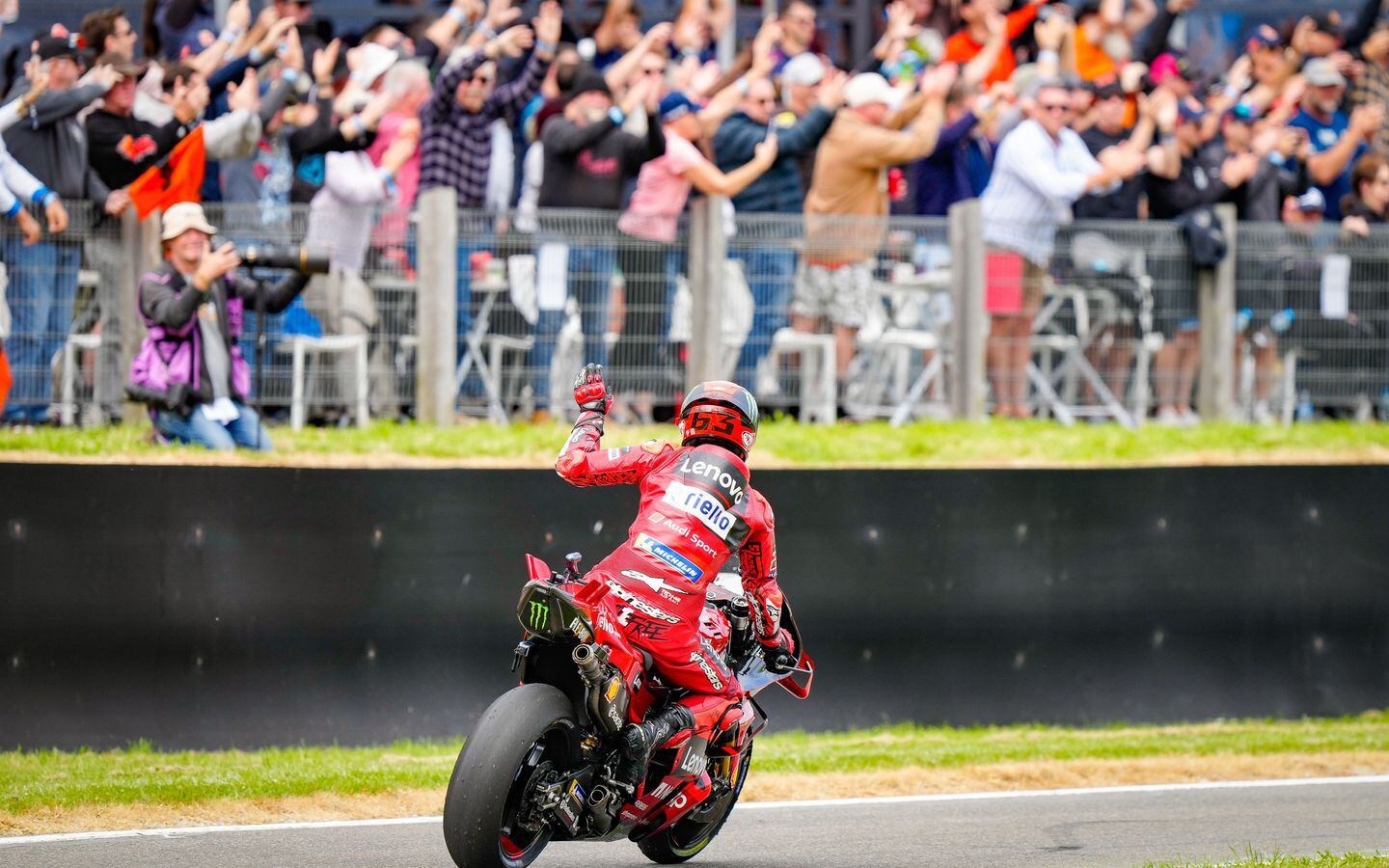
Tire selection was the deciding factor in Phillip Island. Bagnaia made the right decision, and in coming home in second, extended his championship lead to 27 points. (MotoGP/)This is a point race watchers must remember—that when two riders focus on beating each other, they sacrifice lap time by dividing their attention between going fast and dueling.
Martín described the first half of his race by saying, “I felt good. I was managing my lead in the middle of the race. But then [with] six laps to go was the moment when I started to struggle a lot. I saw that I had no rear tire.”
Although Martín’s team said the tire choice was their mistake, he himself said, “The important thing is not to make any more mistakes on the tire choice. Just try to go with the same as my opponents.”
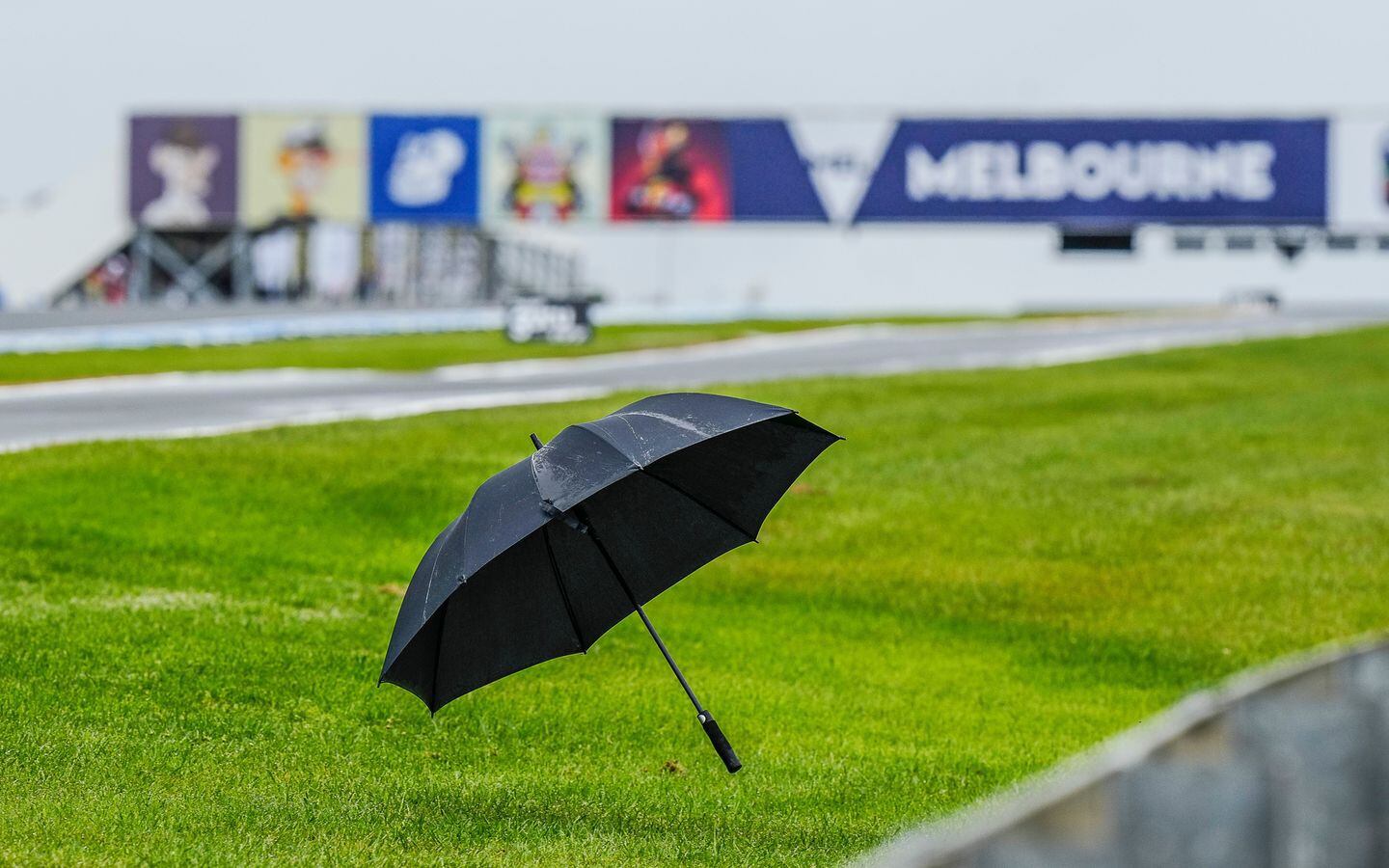
Rain and, more importantly, high winds forced an early end to the weekend, with the rescheduled sprint race being canceled. (MotoGP/)As various riders consider the vacancy at Honda for next year (Márquez having decided to switch to a satellite Ducati) and as the drama at Yamaha continues, this author two weeks ago had the opportunity to quiz two very experienced racing people during festivities at the Barber Museum near Birmingham, Alabama. They gave very similar answers to my question: What is holding back Yamaha and Honda from quickly becoming competitive again?
Their opinion was that big-company management structure can be too slow-moving to solve racing problems.
My informants gave specific examples. Japanese companies move engineers around during their careers. What an engineer learns in racing is wasted when in six months comes reassignment to Inventory Systems. Also, I was told, it is common for racing to hit the “scheduling barrier.” Access to specialized machine tools or processes is by priority level—how high is yours?
Something similar occurred in US aircraft engine manufacturing during World War II. Large and successful manufacturing companies prototyped advanced engine projects that they were unable to make reliable before the war ended.
Pratt & Whitney had in the 1920s and ‘30s developed its method of “trampling problems to death.” Instead of building and testing the several possible solutions to a problem one after the other, they tested all solutions simultaneously. Expensive, yes, admitted a retired P&W VP, but a crisis makes time more valuable than money. If your crankcase design is cracking at 10 to 50 test hours despite all your hard work, your contract will be terminated or your tooling diverted to faster-developing projects.
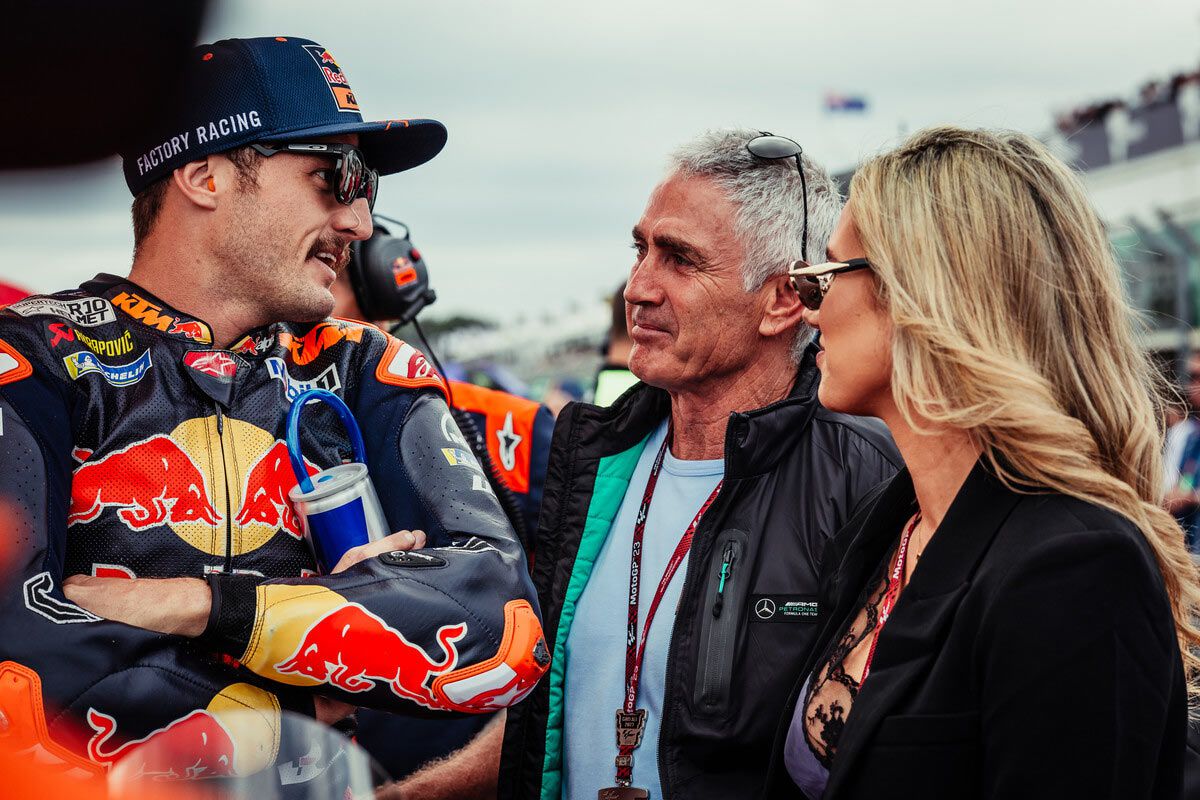
There were some familiar faces in Phillip Island. (KTM/)Companies like Lockheed in the US and Dassault in France discovered that technical projects accelerated when staff size was cut, eliminating much organizational friction.
Yamaha dominated late-1970s 500 GP racing by quick action. Instead of “working through channels” to alter the steering head angle of Kenny Roberts’ 0W-48, Kel Carruthers sawed off the steering head and rewelded it at a reduced rake angle. Small, action-oriented development groups (e.g., “Skunk Works”) get things done. Big organizations have tons of paper to push.
Next weekend is Thailand, at Chang International Circuit. Predictions?
-
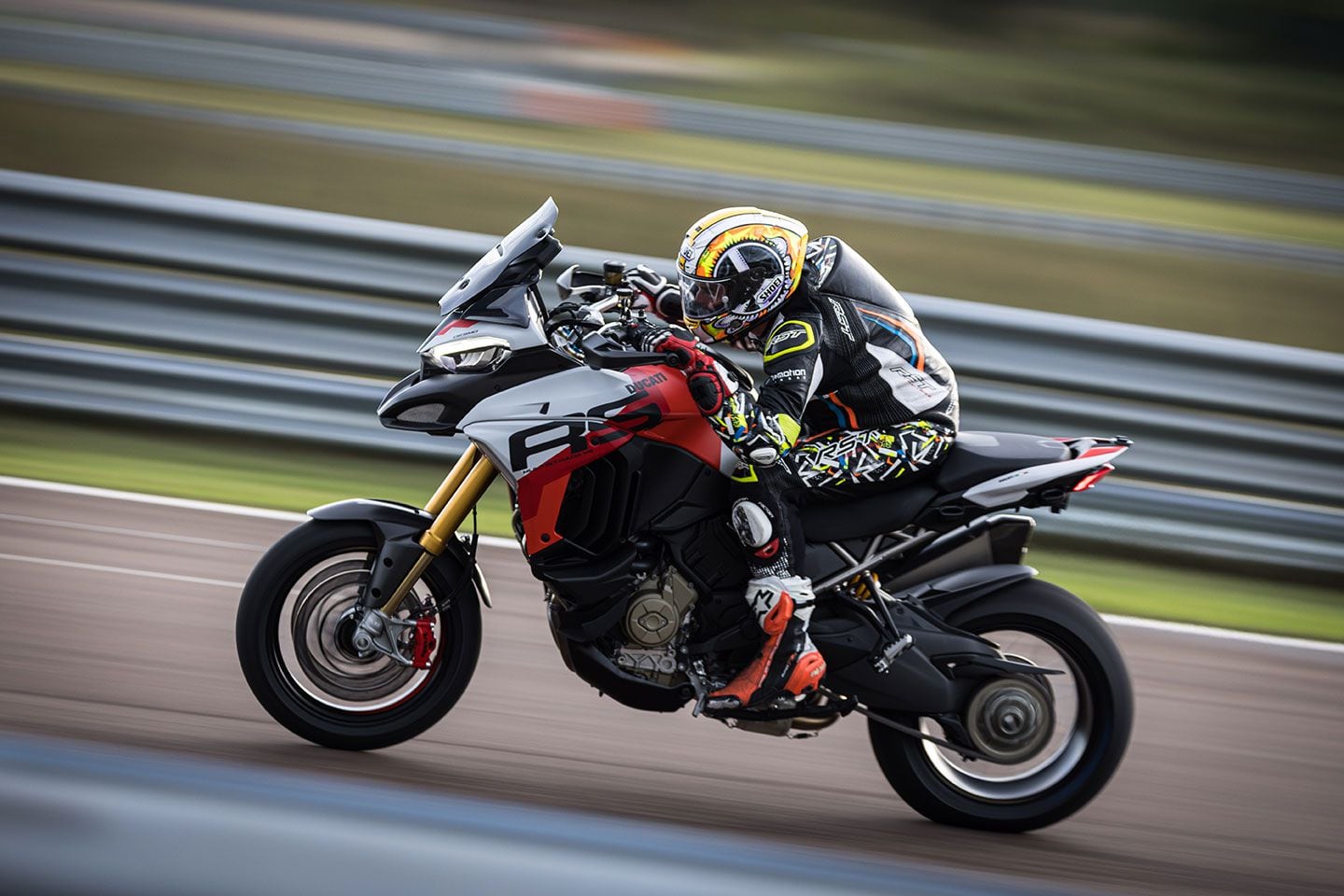
Ducati’s Multistrada V4 RS blurs the line between sportbike and sport-touring. (Ducati/)Since adopting the Granturismo V-4 platform in 2021, the Multistrada has come to represent the more sober side of Ducati’s two-wheel output. A Multistrada Rally, for example, may have a 19-inch front wheel and genuine off-road ability and a Multistrada V4 S Grand Tour a world-class package of state-of-the-art rider aids, but both are Multistradas at heart: engaging, versatile, and efficient all-rounders—a relatively sensible choice.
So here’s a surprise, and a most welcome one at that, because the new Ducati Multistrada V4 RS, the sixth variant in the current range of V-4 Multi crossovers, is the most unexpected, the most powerful, and at $37,995, the highest priced Multistrada yet. And it will be, by some margin, one of the most outrageous Ducati seen for some time.
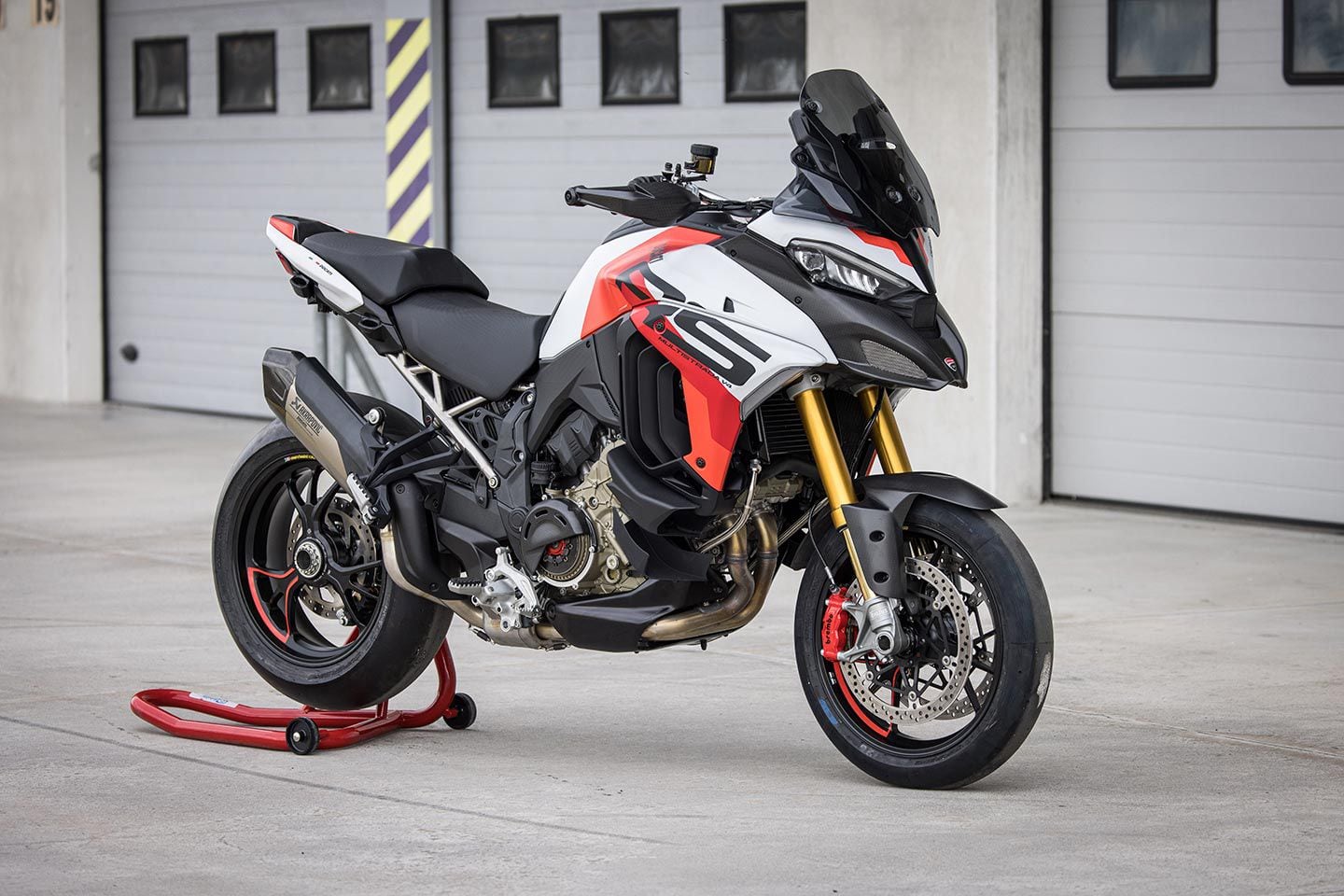
Our Multistrada V4 RS test unit was equipped with Pirelli slicks for a day at the track. (Ducati/)Right now, forget the Multistrada as a machine to waft you and your partner across swaths of the country without fuss or drama, because this Multistrada is essentially a Panigale V4 S superbike on stilts. A long-range troublemaker looking to rip it up on track and road alike. Fuss and drama are what it’s all about.
2024 Ducati Multistrada V4 RS Differences
It’s supposed to blow your mind, this one. That means ditching the low-maintenance, spring-valve Granturismo V-4 that has propelled the Multis so dutifully since 2021 in favor of the mighty, all-conquering animal that is 1,103cc Desmosedici Stradale. Lifted from the Streetfighter V4, it makes 180 hp—or 192 hp with an optional, full-noise Akrapovič race system installed. It booms and clatters and its dry clutch rattles. Everyone knows the RS is coming.
Like the V4 Pikes Peak, hitherto the sportiest of the current Multistradas, the RS runs superlight forged 17-inch Marchesini wheels instead of conventional 19-inch rims, along with new chassis geometry that sits the bike on its nose and sets it to turn like a pure sportbike. There’s Öhlins Smart EC semi-active suspension and, from mudguard to beak, a notable acreage of featherlight carbon bodywork. A new aluminum monocoque frame is attached to a single-side swingarm and light-as-a-timepiece titanium subframe. A unique Centro Stile–designed livery echoes the MotoGP factory Ducatis and each bike’s production number is carried on plate mounted on the triple clamp. Oh, and integrated panniers are also available.
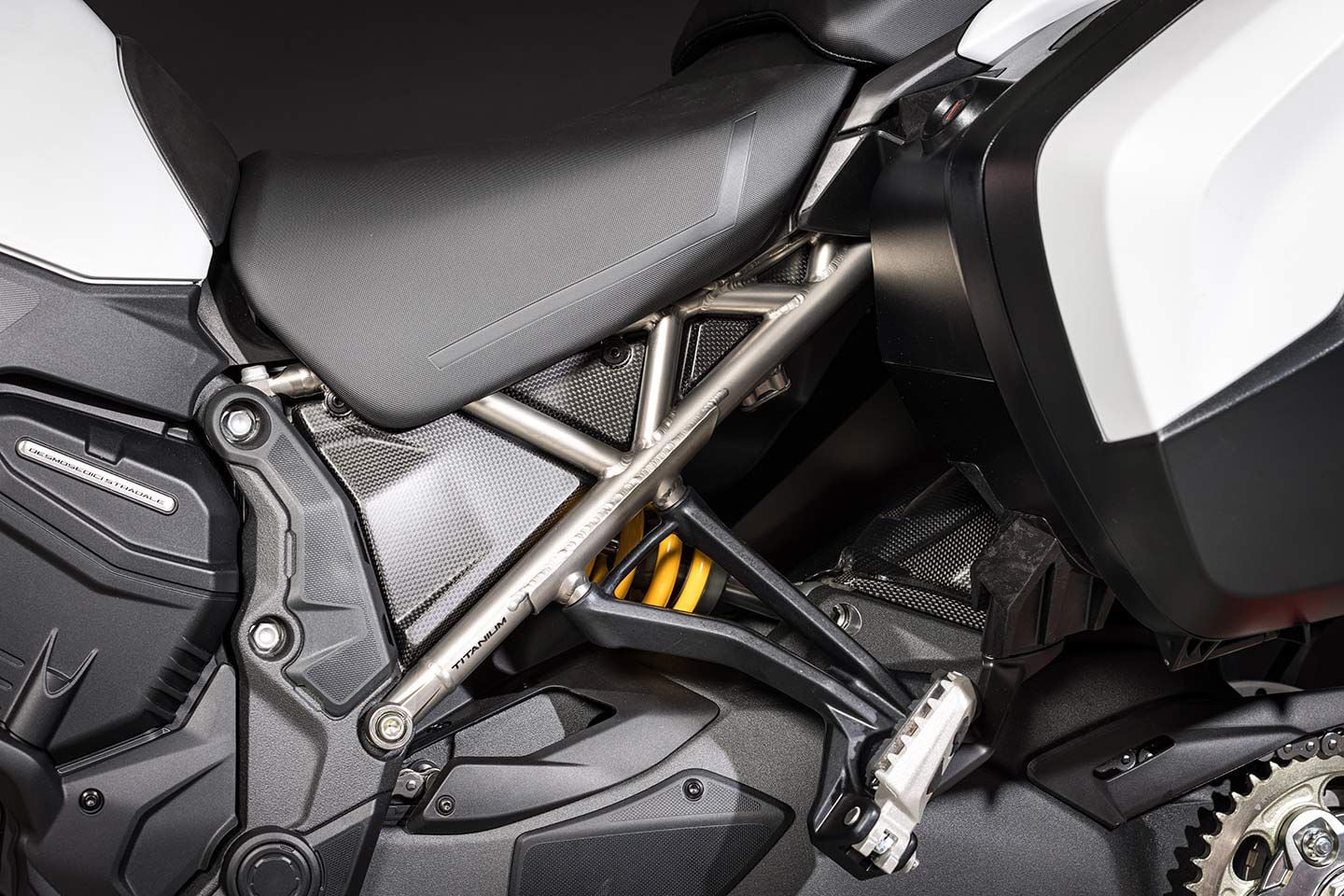
Bags can be attached to the Multi V4 RS’ titanium subframe. (Ducati/)The contradictions and oxymorons are compelling. “Trackday tourers” that do it all have been tried before. Priced close to $38K, which is $6,000 above the Pikes Peak ($31,595), and billed by Ducati as uncompromising and the most exciting Multistrada yet seen, the pressure is certainly on the RS to deliver in an array of riding environments.
On the Track With the Multistrada V4 RS
Cycle World was invited to test the RS at the Autodromo di Modena racetrack in northern Italy, which, sadly, meant no road riding and that the touring side of the equation was left unaddressed for now. However, we know the track well and have ridden multiple bikes here before—even a Pikes Peak Multi in recent times; comparisons are possible to an extent. Accelerating up the pit lane onto the start-finish straight for the first time, the RS’ immense drive felt dramatic, possibly because of its shorter final gearing but probably because our subconscious was expecting the sharp but far less brutal acceleration of a normal Multistrada.
In a bike full of surprises, the move to a Panigale-derived Desmosedici Stradale V-4 is perhaps the biggest of them all. The non-desmo 1,158cc Granturismo engine it replaces makes 170 hp at 10,500 rpm and 92 lb.-ft. of torque at 8,750 rpm and is hardly a shrinking violet. It’s smooth at low rpm too, and features extra wide service intervals, including a 36,000-mile valve check, ideally suiting the Multistrada’s high-mileage adventure motorcycle profile.
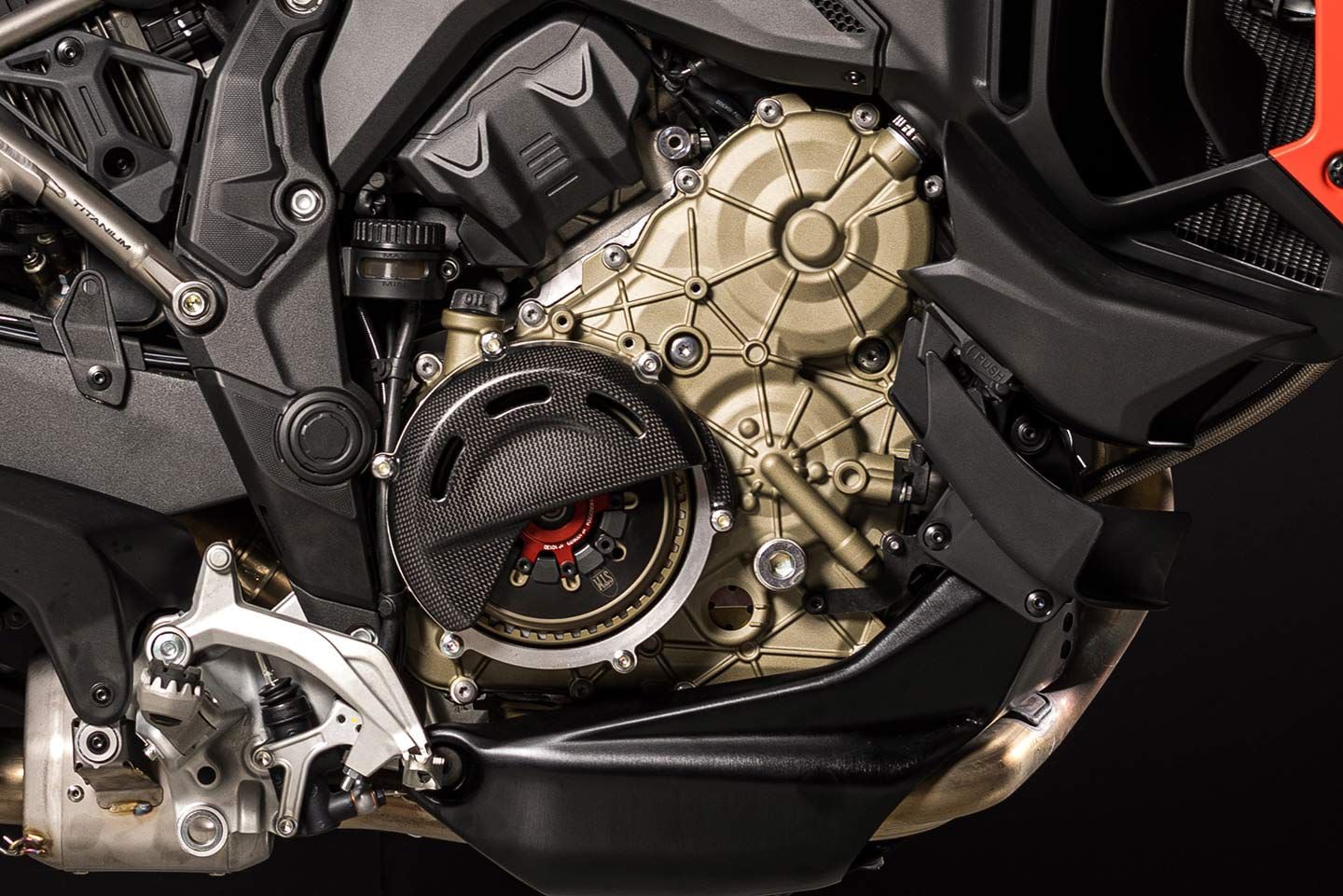
A Desmosedici Stradale V-4 powers the Multistrada V4 RS, replacing the standard Granturismo. (Ducati/)The angrier, heat-churning Stradale, meanwhile, retains Ducati’s signature desmo valve system and conventional service intervals. It revs higher to peak at 180 hp at 12,250 rpm (don’t forget that 192 hp with the full Akrapovič system) while peak torque is a claimed 87 lb.-ft. at 9,500 rpm, a chunk less than the Granturismo’s 92. On this tight and twisty racetrack, you instinctively rev it hard—the frictionless Stradale V-4 demands it—shifting from second gear to third and fourth, then fifth gear on the straight when the shift lights illuminate.
This is true racebike territory. The digital rev counter builds as the V-4 revs with liquid fury. There’s really no such thing as a slow Multistrada but when the V4 S is peaking at 10,00 rpm, the new RS is still revving toward maximum power at 12,250 rpm and will happily continue into 13,000 rpm.
On paper, torque is down compared to the “normal” Multi, but on track, and using just the upper 25 percent of the rev range, you don’t miss the comparative lack of grunt. Out of Modena’s final turn, with the anti-wheelie on a low setting, the front wheel hovers above the surface as the power kicks and shovels down the main straight.
The quickshifter is perfectly slick and, this being a premium Ducati, there’s a sizable raft of other sophisticated rider aids to help you extract the most out of the bike’s performance. There are four riding modes: Sport, Touring, Urban, and a Race mode to replace the Multi’s usual Enduro setting. Each riding mode also controls the level of intervention of the lean-sensitive rider aids. Like the Panigale and Streetfighter, there are also four power modes: low, medium, high, and full. Even in the high-power mode, there is a reduced torque in first, second, and third gear.
Another significant change from Multistrada convention is the introduction of a 17-inch front wheel to replace the 19-inch front on the standard Multi, the Pikes Peak being the other exception. These Marchesini rims are a sizable 6 pounds lighter, which quickens the steering and saves on unsprung weight and opens up the options for track-focused rubber. Pirelli Diablo Rosso IV Corsa are the OE fitment but our testbike wore Pirelli slicks.
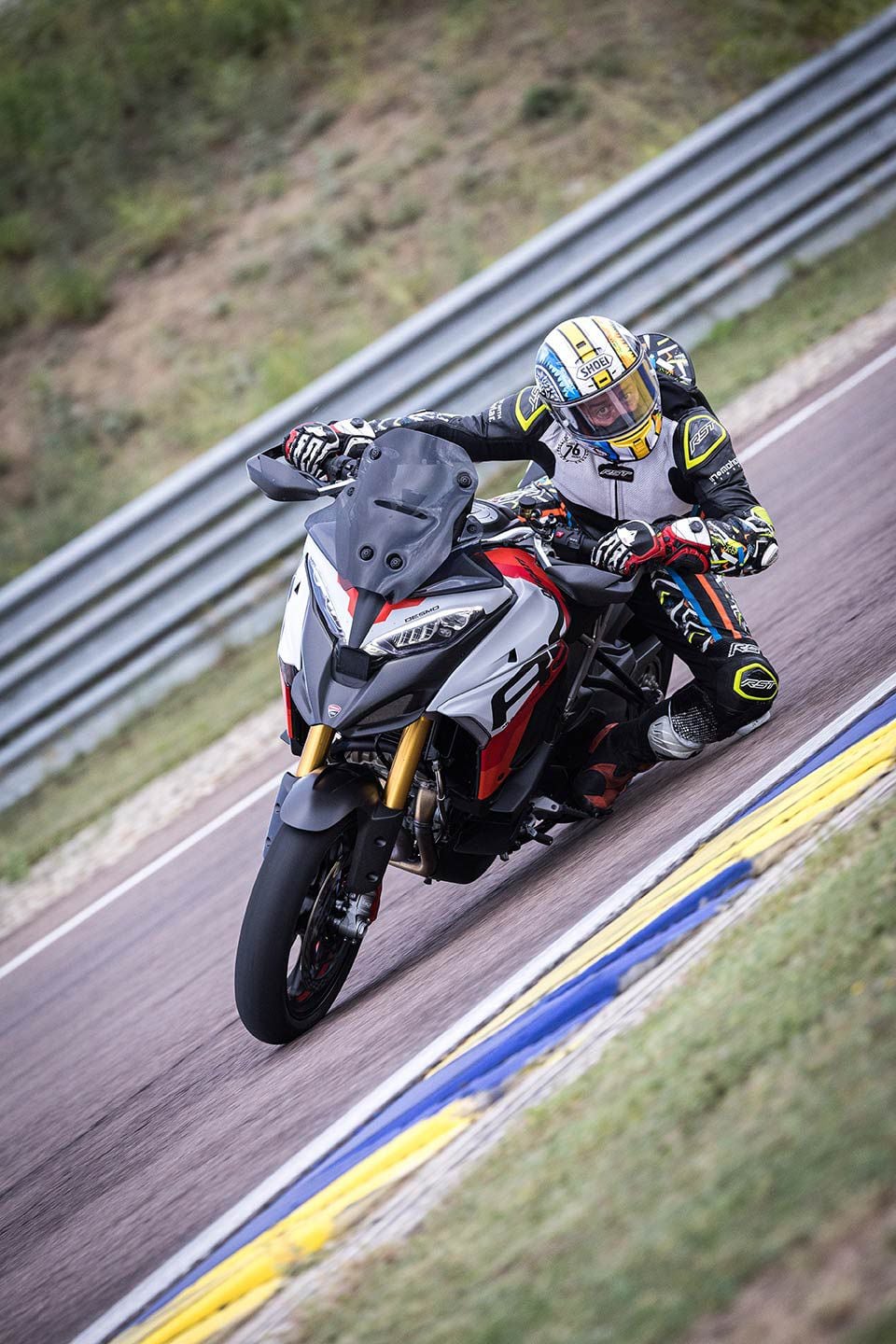
Steering is quick and feedback is excellent with 17-inch wheels and revised chassis geometry on the Multistrada V4 RS. (Ducati/)Ducati isn’t yet revealing the RS’ overall weight, but the introduction of that titanium subframe saves another 5.5 pounds. A lighter battery shaves off another 3.1 pounds, and with the optional race exhaust installed the estimated final figure could be close to 452 pounds, which would make the RS just 55 pounds heavier than the Streetfighter V4 S.
The premium Multistrada V4 S and new Grand Tour both use the familiar Skyhook Marzocchi semi-active suspension, whereas the new RS uses Öhlins Smart EC 2.0 units similar to the Panigale V4 S, Streetfighter V4 S, and Pikes Peak. Long-travel, semi-active suspension is ideal for long-distance performance, but less so for the racetrack and could be seen as a red flag to sporty riders but the feel and feedback from the Öhlins units are exquisite. The RS instilled so much confidence that soon the traction control was turned down to the minimum and the anti-wheelie was turned off altogether. You can feel the limit approaching as if riding a crisply set-up sportbike.
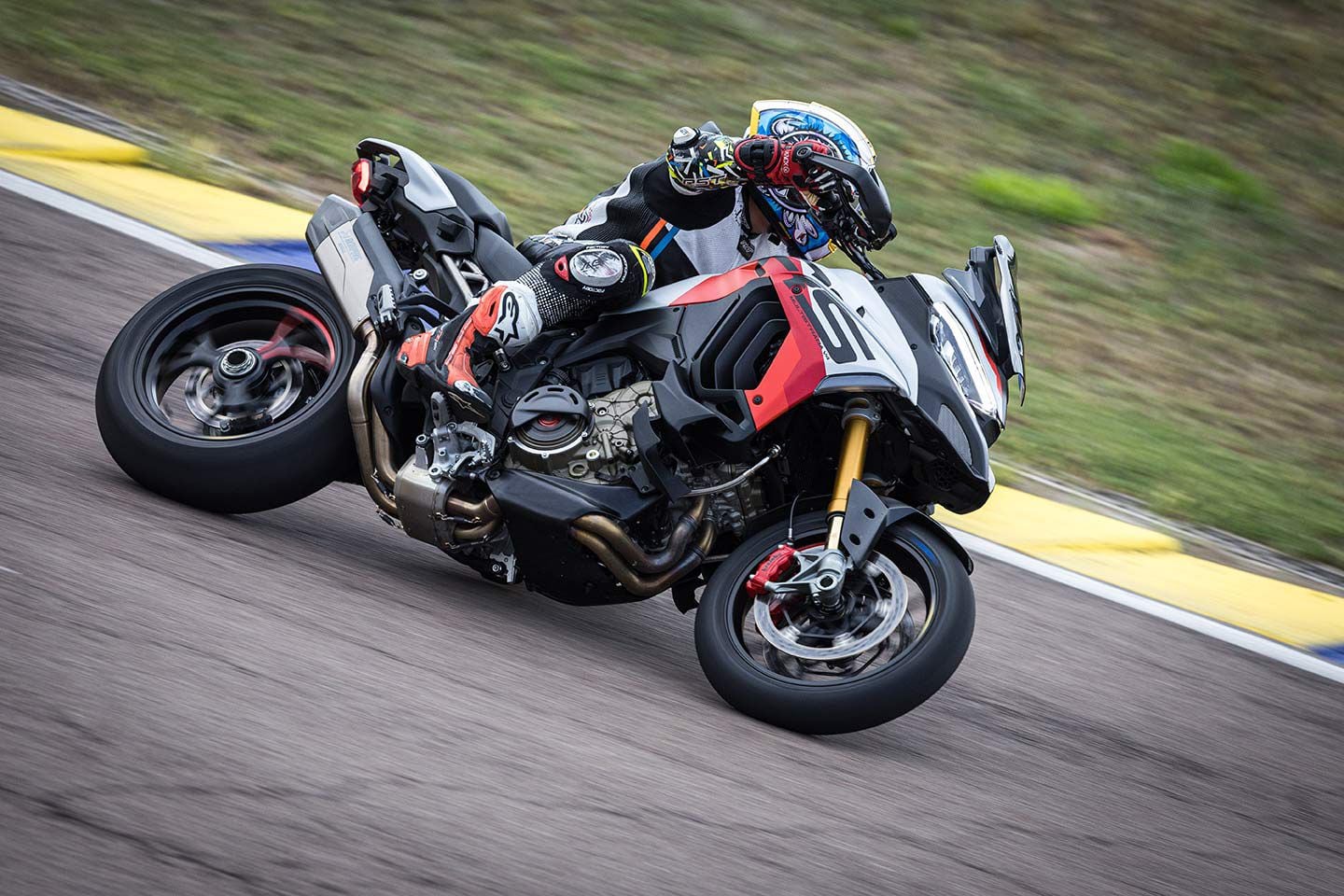
Superbike performance and handling with comfortable touring ergos, it nearly seems too good to be true… (Ducati/)Each riding mode changes the damping characteristics of the suspension. Sport mode will probably be the go-to option for the road, but in Race mode the suspension works immaculately on track, with far less dive on the fork and overall control midcorner. The steering is direct and accurate—you simply forget you’re riding a high-rise motorcycle. Feel from the front end is so much more confidence-inspiring than what is generated by the standard 17-inch front wheel. It wants to carry corner speed and, given its ample ground clearance, there’s no reason to disappoint.
Braking is by Brembo: Stylema monoblock calipers and 330mm discs up front with a radial master cylinder and corning ABS. These race-spec stoppers are the same as you’d find on the Multistrada V4 S and Pikes Peak, but now they are stopping less weight. On the track, they are fade-free and faultless, and the high riding position and upright stance results in excellent stability. The cornering ABS is superb; even at a solid trackday pace, it’s not intrusive and can be relied upon.
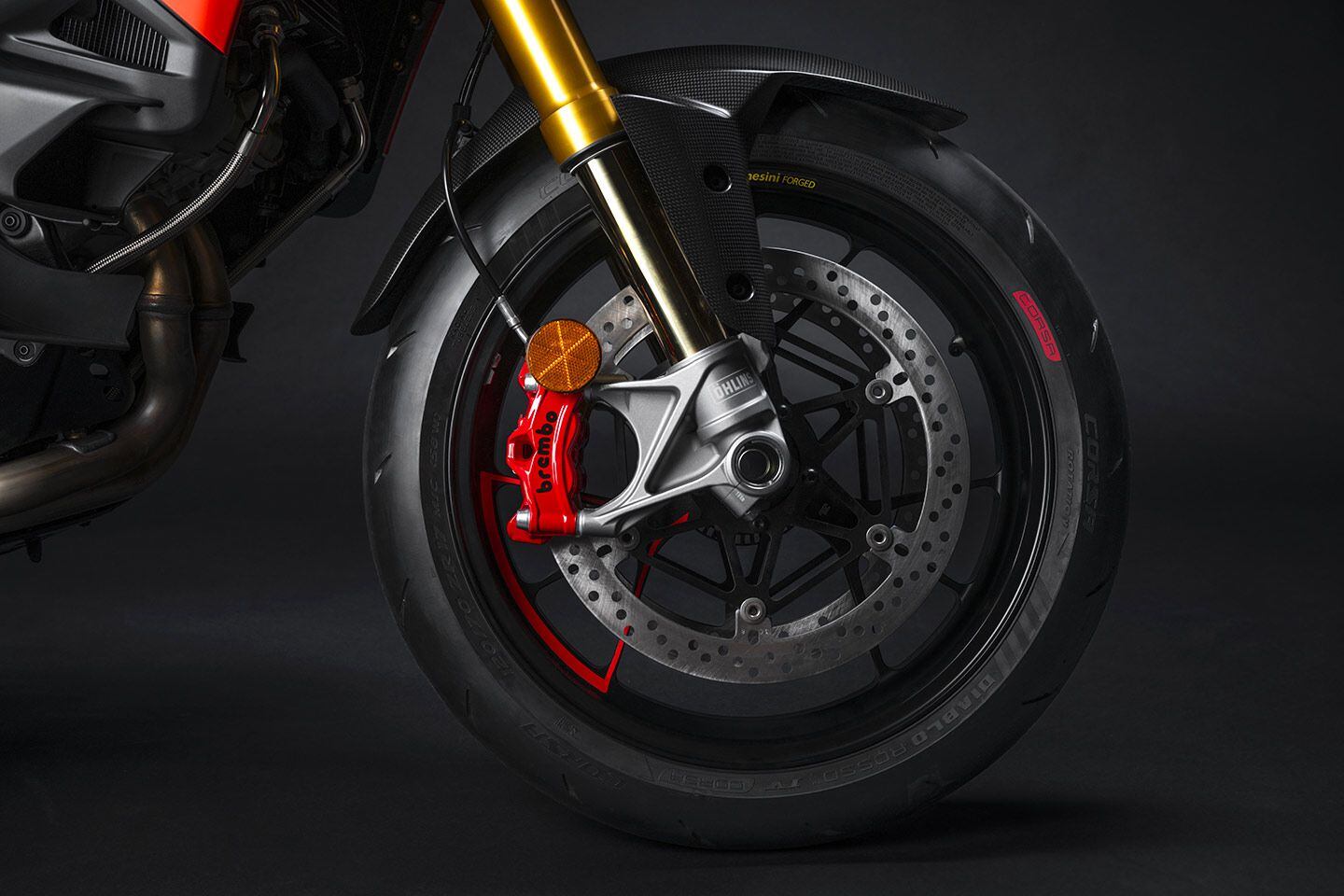
Brembo Stylema calipers and 330mm discs are shared with the S and Pikes Peak Multis, and are more than capable for fade-free trackday shredding. (Ducati/)Ducati has added a more progressive rear brake lever—something it did on the Multistrada Rally—and changed the rear master cylinder to make it brake sharper and more usable. Because the RS runs a similar engine to the Panigale and Streetfighter, this allows the introduction of a three-stage Engine Brake Control, which allows you to control the amount of engine-braking from the V-4 and is a first for the Multistrada range.
What About the Touring Bit?
A relatively upright and tall riding position gives a slightly unwieldy position on track at first, but you instinctively adapt. Its stance is closest to that of the Pikes Peak, which means it should be fully comfortable for at least a couple of 5.8-gallon tanks of gas. There is an Urban riding mode that drops maximum power to 113 hp and reduces the power in all gears if you choose to venture out on those damp and cold days.
An extensive list of touring-oriented electronic rider aids and high-tech features, including radar detection, makes the RS the most advanced Multistrada ever. In fact, it’s one of the most advanced bikes on the market as it combines the racy tech of the Streetfighter and Panigale with the proven touring and distance-focused electronic wizardry of the Multistrada range. For example, you have track-focused rider aids including changeable engine-brake control, and also Vehicle Hold Control, backlit switch gear, ACC, blind spot detection from that radar. Don’t forget the Öhlins Smart EC 2.0 suspension. All this is managed via a familiar 6.5-inch TFT dash with Ducati Connect.
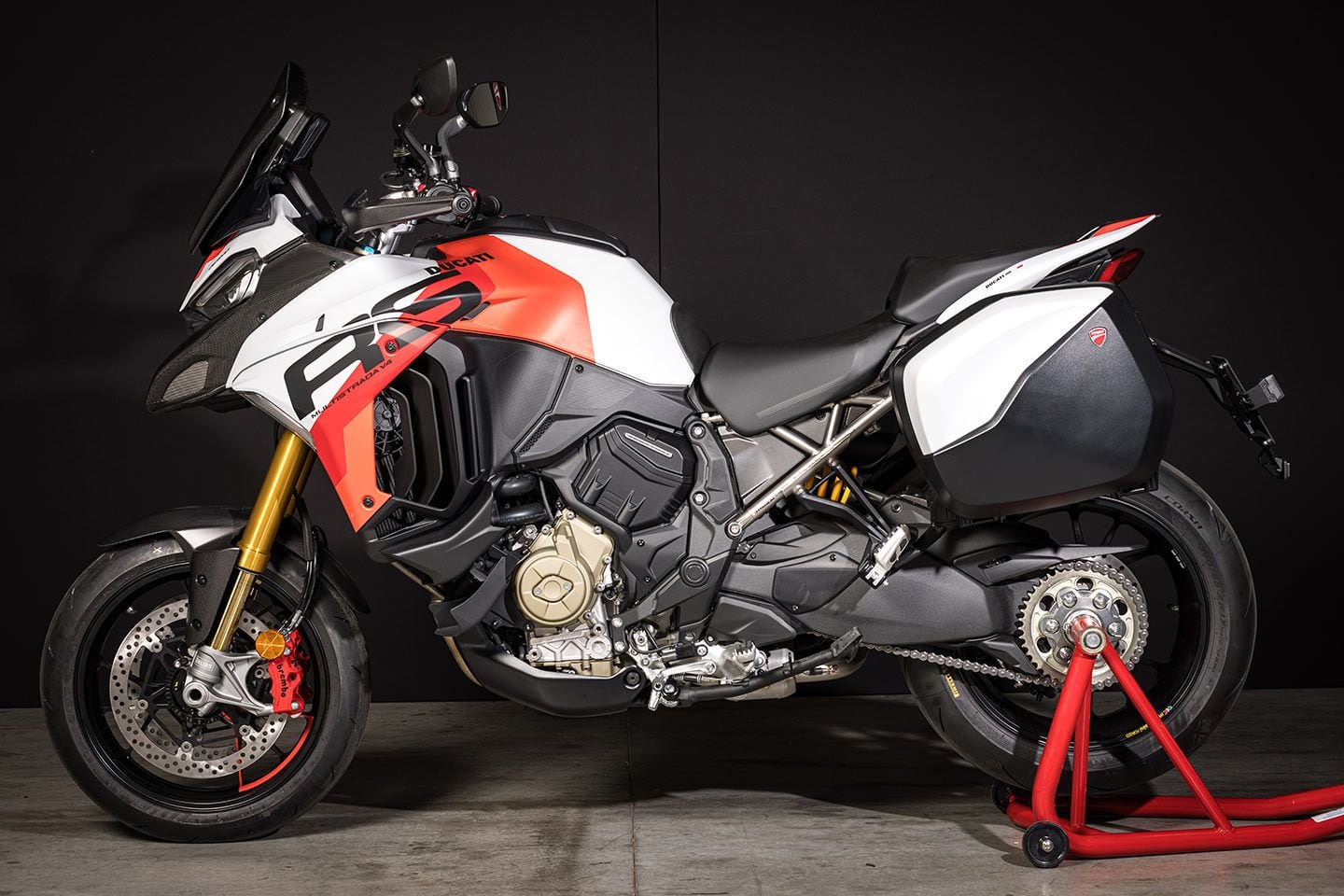
Slap some bags on the Multistrada V4 RS and hit the road for your favorite track. (Ducati/)Other touches worth noting are a new heat shield, closable air deflectors, and an air-cooled phone compartment, all of which were first seen on the Multi Rally.
Having sampled the RS on a race circuit we are eager to try it on the road to see if its distance work can match its mind-bending speed and incredible feel on track. A 180 hp, free-revving beast of a V-4 in a chassis that possesses many of the qualities of the excellent Streetfighter and Panigale, mixed with the all-round versatility of the Multistrada, makes for an intoxicating blend that ticks all boxes.
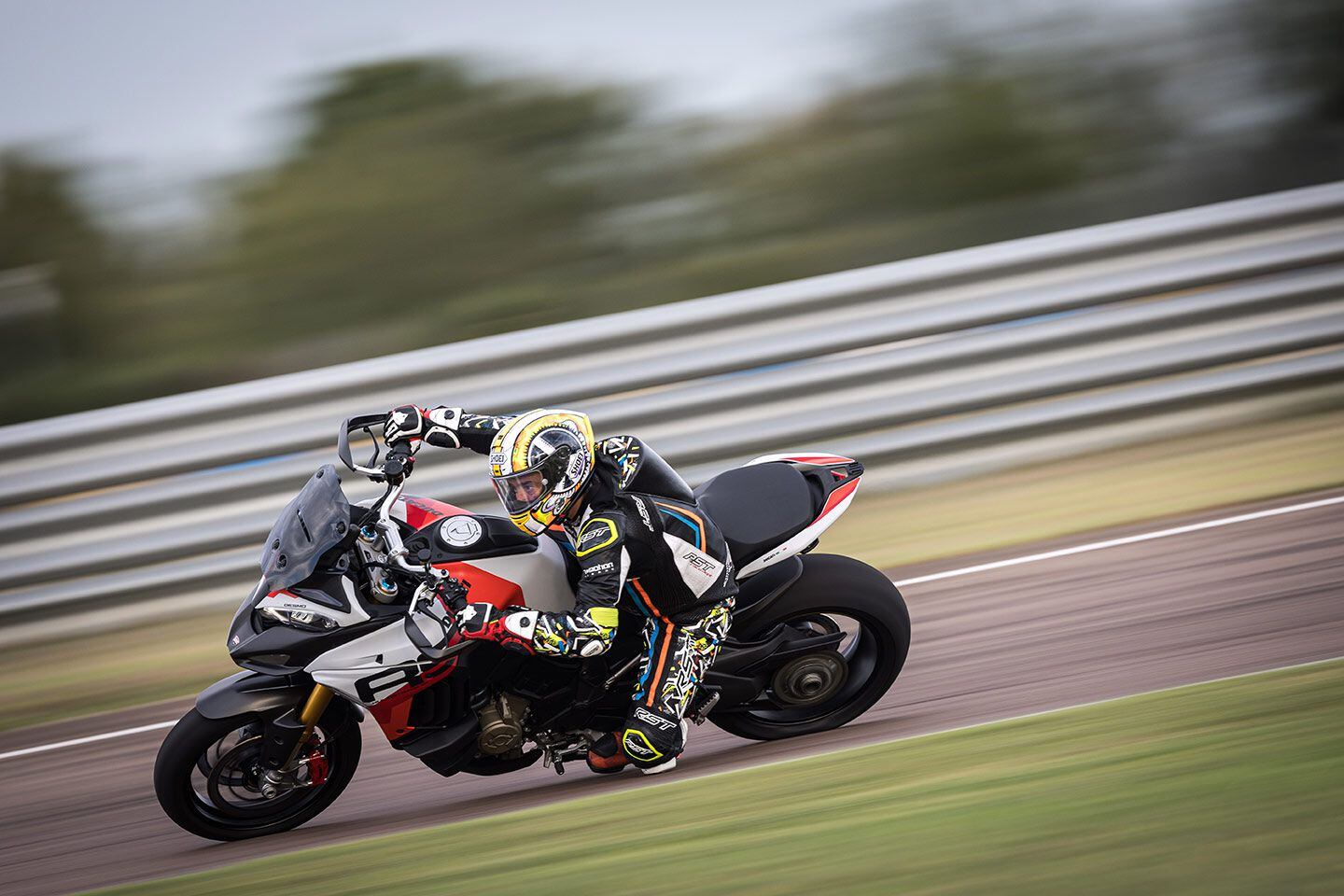
A Panigale on stilts might be the best description of the 2024 Multistrada V4 RS. (Ducati/)For now, we can say that the RS delivers superbly on track and that the prospect of riding it fully loaded, cruise control on, down the unrestricted German autobahn, on route, perhaps, to some tire-frazzling laps of the Nürburgring Nordschleife circuit is about as exciting as sport-touring can get. We can’t wait.
2024 Ducati Multistrada V4 RS Specs
MSRP $37,995 ENGINE DOHC, liquid-cooled, 90-degree V-4; 4 valves/cyl. DISPLACEMENT 1,103cc BORE X STROKE 81.0 x 53.5mm COMPRESSION RATIO 14.0:1 TRANSMISSION/FINAL DRIVE 6-speed/chain CLAIMED HORSEPOWER 180 hp @ 12,250 rpm CLAIMED TORQUE 87 lb.-ft. @ 9,500 rpm FUEL SYSTEM EFI w/ 50mm elliptical throttle bodies; ride-by-wire CLUTCH Dry, multiplate slipper; hydraulic operation FRAME Aluminum monocoque FRONT SUSPENSION Öhlins 48mm inverted w/ Ducati Skyhook, electronically compression and rebound damping adjustable; 6.7 in. travel REAR SUSPENSION Öhlins TTX 36 monoshock w/ Ducati Skyhook, electronically spring preload, compression, and rebound damping adjustable; 6.7 in. travel FRONT BRAKE Radially mounted Brembo Stylema Monoblock 4-piston calipers, semi-floating 330mm discs w/ Cornering ABS REAR BRAKE Brembo 2-piston floating caliper, 265mm disc w/ Cornering ABS WHEELS, FRONT/REAR Marchesini alloy spoked; 17 x 3.5 in. / 17 x 6 in. TIRES, FRONT/REAR Pirelli Diablo Rosso IV Corsa; 120/70ZR-17 / 190/55ZR-17 RAKE/TRAIL 25.75°/4.7 in. WHEELBASE 62.7 in. SEAT HEIGHT 33.1–33.9 in. FUEL CAPACITY 5.8 gal. CLAIMED CURB WEIGHT N/A AVAILABILITY Now CONTACT ducati.com -
It's a different world from street riding, but these tips can help you find confidence and fun.
-
Touratech’s got you covered with its new selection of protective and luggage accessories.
-
It took two years and a lot of dirt and water to bring these riding pants to market.
-
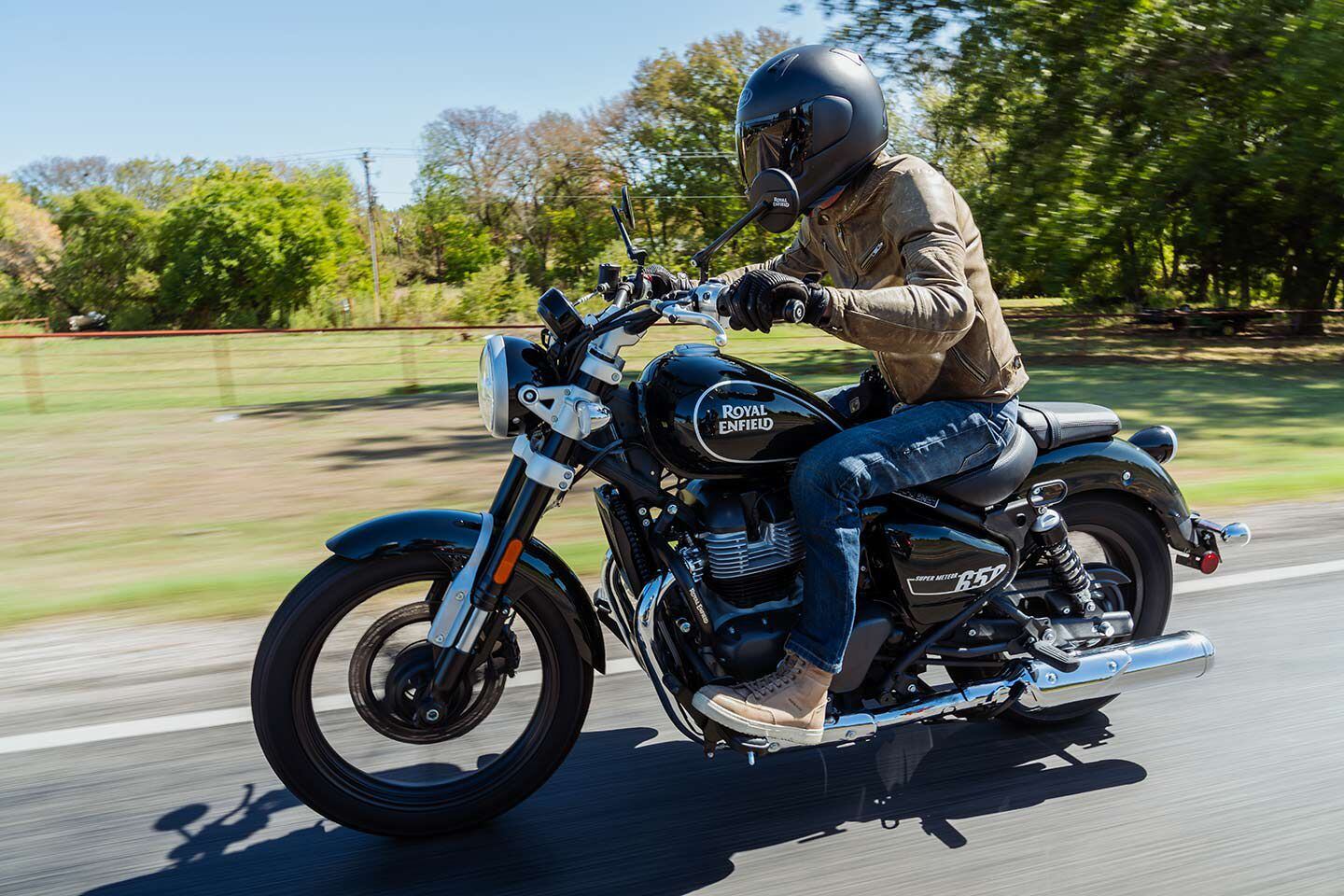
The Super Meteor 650 is Royal Enfield's flagship model. (Josh Shipps/Klings/Royal Enfield/)Royal Enfield’s Super Meteor 650 may be the most significant motorcycle to ever come out of India. Its classic styling, impressive performance, and excellent build quality exhibit where Royal Enfield has been, where it is, and where it’s going. The Super Meteor’s classic styling pays homage to the brand’s original cruisers such as the 1952 Meteor and 1956 Super Meteor. Its 648cc parallel twin maintains the thumpy character that we have come to love in the INT650 and Continental GT 650. And the impressive fit and finish of the Super Meteor 650 represents a new standard for Royal Enfield.
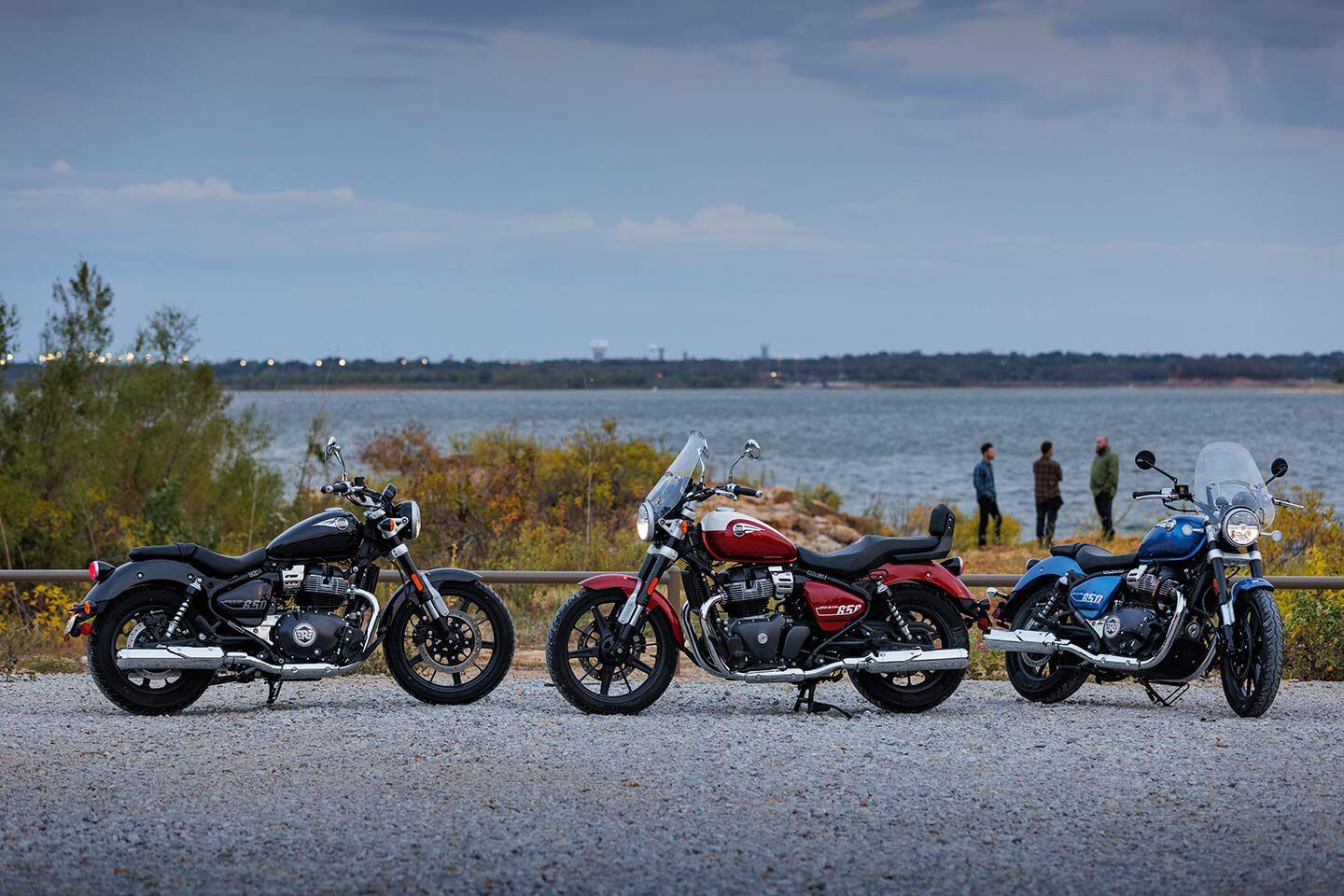
The Royal Enfield Super Meteor 650 model lineup. (Josh Shipps/Klings/Royal Enfield/)2023 Royal Enfield Super Meteor 650 Overview
The Super Meteor 650 is a retro-styled middleweight cruiser designed to be as accessible as it is functional, while delivering a relaxed stance. Starting MSRP is a class-best $6,999, but that’s the only thing “cheap” about this cruiser. Everything else is top-notch. Designed around Royal Enfield’s sweet parallel twin, the Super Meteor 650 slots nicely into the middleweight cruiser class, competing against models such as the Kawasaki Vulcan S and the Honda Shadow line. And even if it’s smaller in displacement and stature than the discontinued Harley-Davidson 883 Sportster, it is definitely a candidate for filling the void left by that American V-twin.
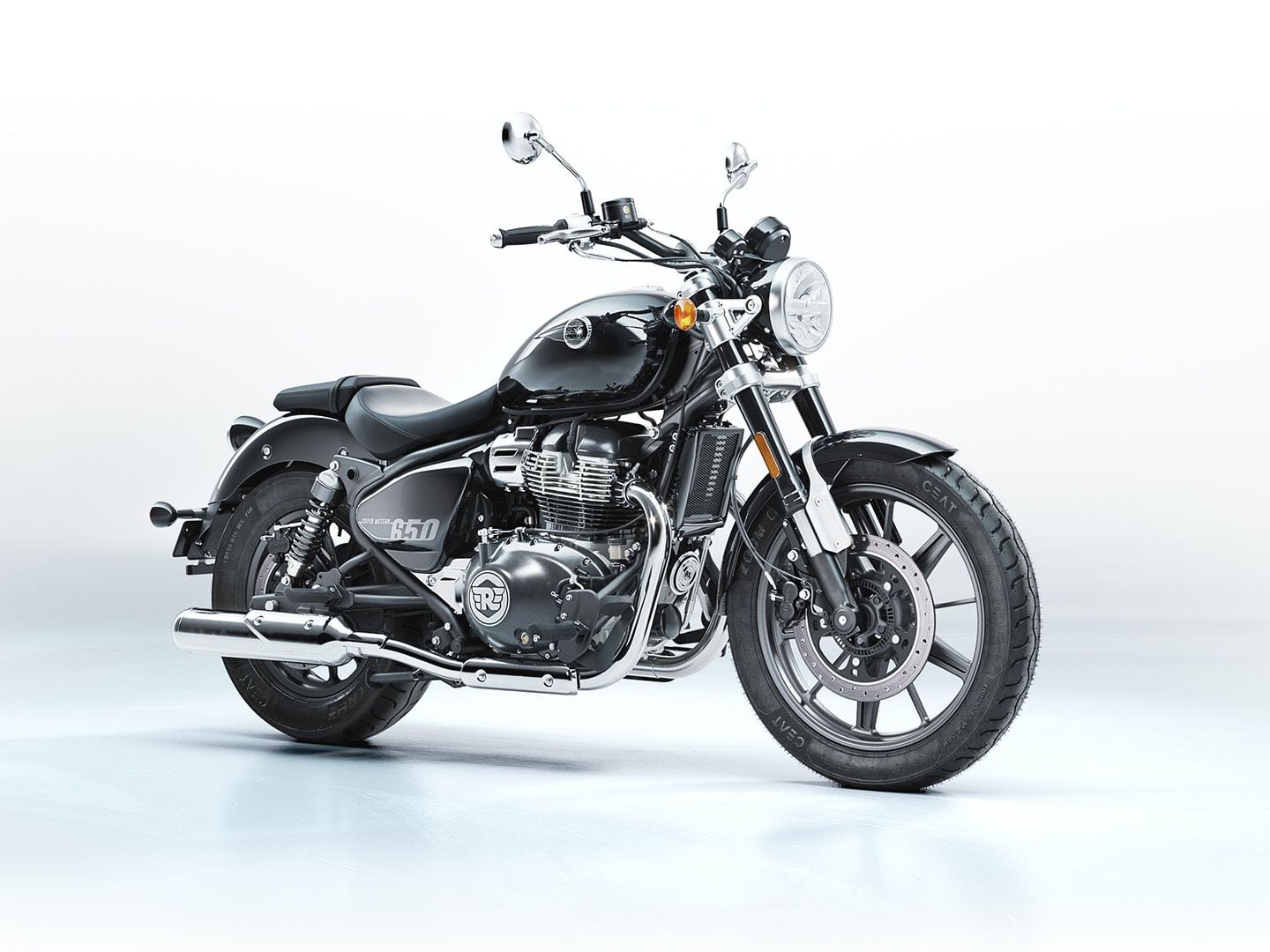
The Royal Enfield Super Meteor in Astral Black ($6,999). (Josh Shipps/Klings/Royal Enfield/)The SOHC fuel-injected engine has a 78.0 x 67.8mm bore and stroke and four valves per cylinder working with a 9.5:1 compression ratio. The engine produces a claimed 46.4 hp and 38.6 lb.-ft. of torque. For reference, we had the 2022 Royal Enfield INT650 on the Cycle World in-house Dynojet 250I dyno last year and recorded 40.9 hp at 6,800 rpm and 37.4 lb.-ft. of torque at 5,100 rpm at the wheel. The Super Meteor 650 has a different intake and exhaust system that results in slightly different power delivery, says R-E, but we expect similar results on our dyno.
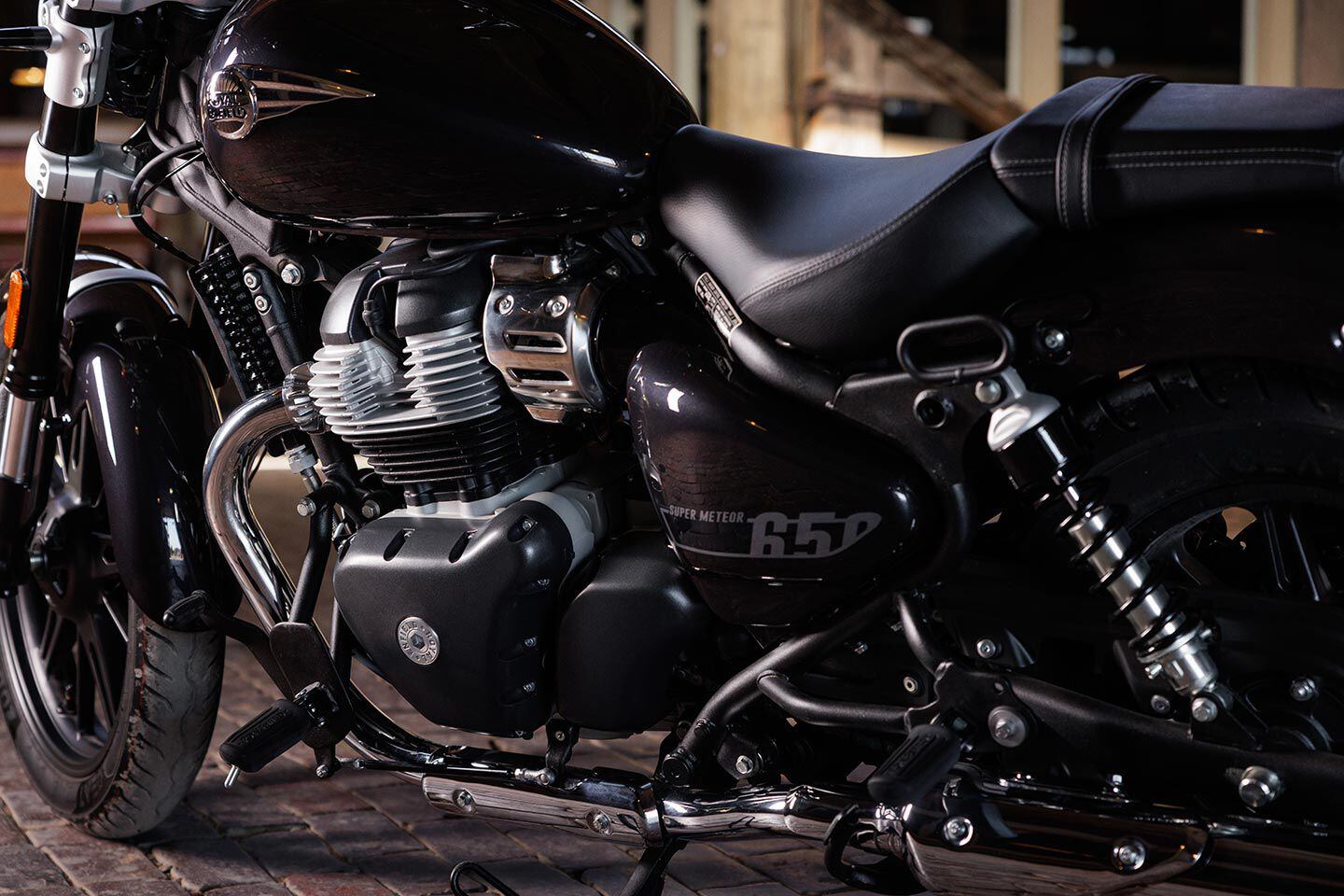
Royal Enfield's 648cc parallel twin is full of character, thanks in part to its 270-degree crankshaft that gives the engine a 90-degree V-twin sound. Impressive low-end grunt is followed by strong midrange pull and solid high-rpm performance. (Josh Shipps/Klings/Royal Enfield/)The Super Meteor has an all-new chassis designed by famed British chassis specialists Harris Performance, owned by Royal Enfield since 2015. The tubular-steel frame helps achieve both a low center of gravity and a low seat height of 29.1 inches. Rake is 27.6 degrees, trail 4.7 inches, definite steps to the relaxed side from the Continental GT and INT 650′s 24.0/4.1 figures. The Super Meteor’s wheelbase is 59.1 inches, 4 inches longer than that of the Conti/INT. This all helps set the tone for the stance of the bike, increases stability, while the wheelbase in particular makes more room for a passenger. (Read Technical Editor Kevin Cameron’s story about wheelbase and chassis geometry here if you’d like to learn more.) Tires are 100/70-19 front, 150/80-16 rear, mounted to tubeless alloy rims.
A nonadjustable 43mm Showa Big Piston inverted fork (the first used by R-E) provides 4.7 inches of travel and twin shocks with five-step adjustable preload offer 4.0 inches of travel.
A set of tubeless alloy rims in conjunction with a centerstand are a testament to the Super Meteor’s sincerity as a long-distance cruiser. And with the addition of a windscreen, deluxe touring seat, and pillion backrest for the Celestial variant ($7,499), the Super Meteor 650 is tailor-made for cruiser touring despite its middleweight displacement.
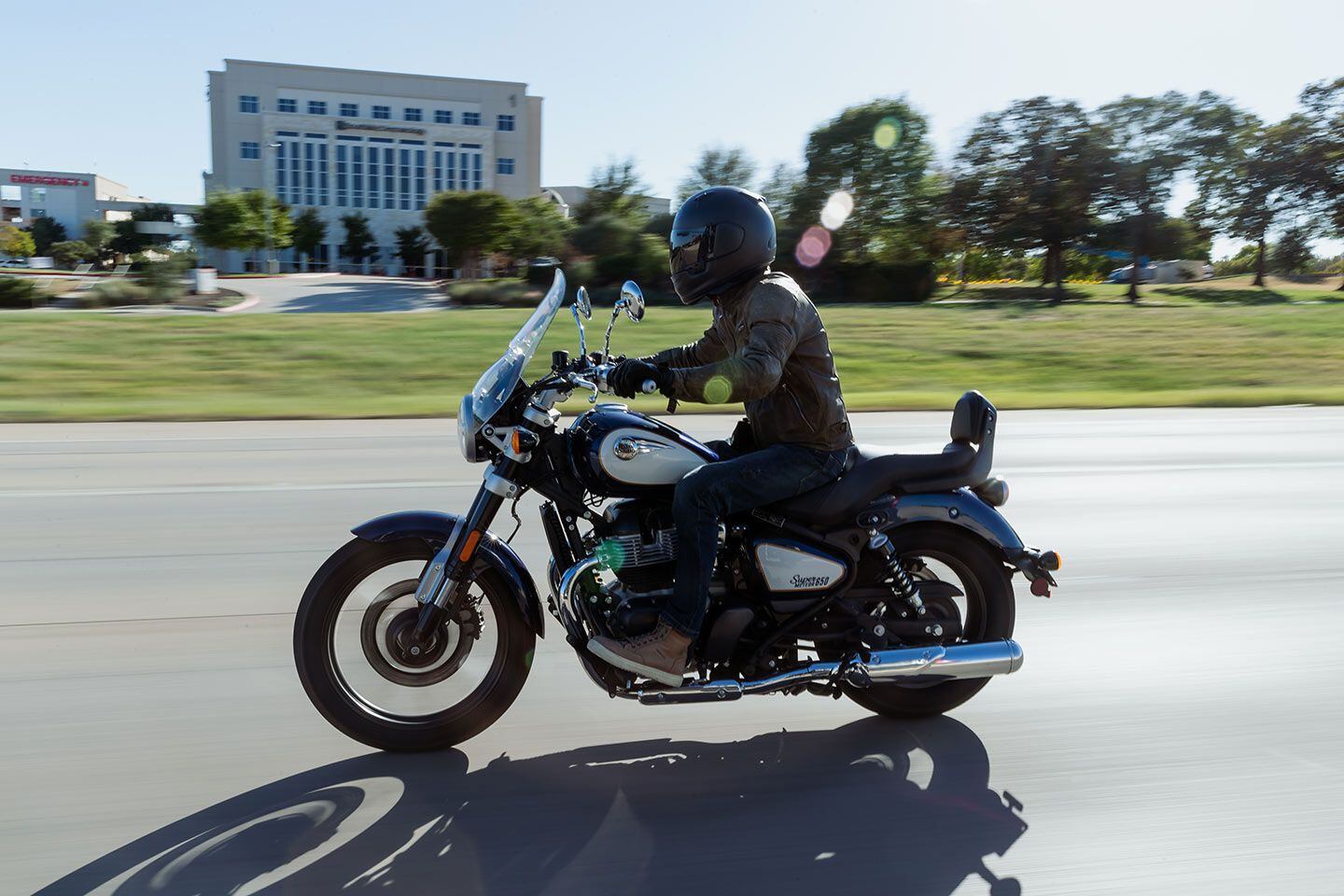
Whether your journey takes you across town or across the county, the Super Meteor 650 is comfortable for miles on end. (Josh Shipps/Klings/Royal Enfield/)Available safety equipment includes non-switchable ABS. No other electronic intervention or ride modes are present, maintaining a classic experience that is felt throughout the entire motorcycle. A retro-themed instrument panel utilizes an analog speedometer with a digital information screen displaying a fuel gauge, gear position indicator, tripmeters, and a clock. The Super Meteor 650 also features Royal Enfield’s Tripper turn-by-turn navigation pod. Riders can link to the navigation pod via Bluetooth through their smartphone. Further adding to the visceral feel of this Royal Enfield is a mechanical throttle cable that provides a solid, analog connection between rider and machine.
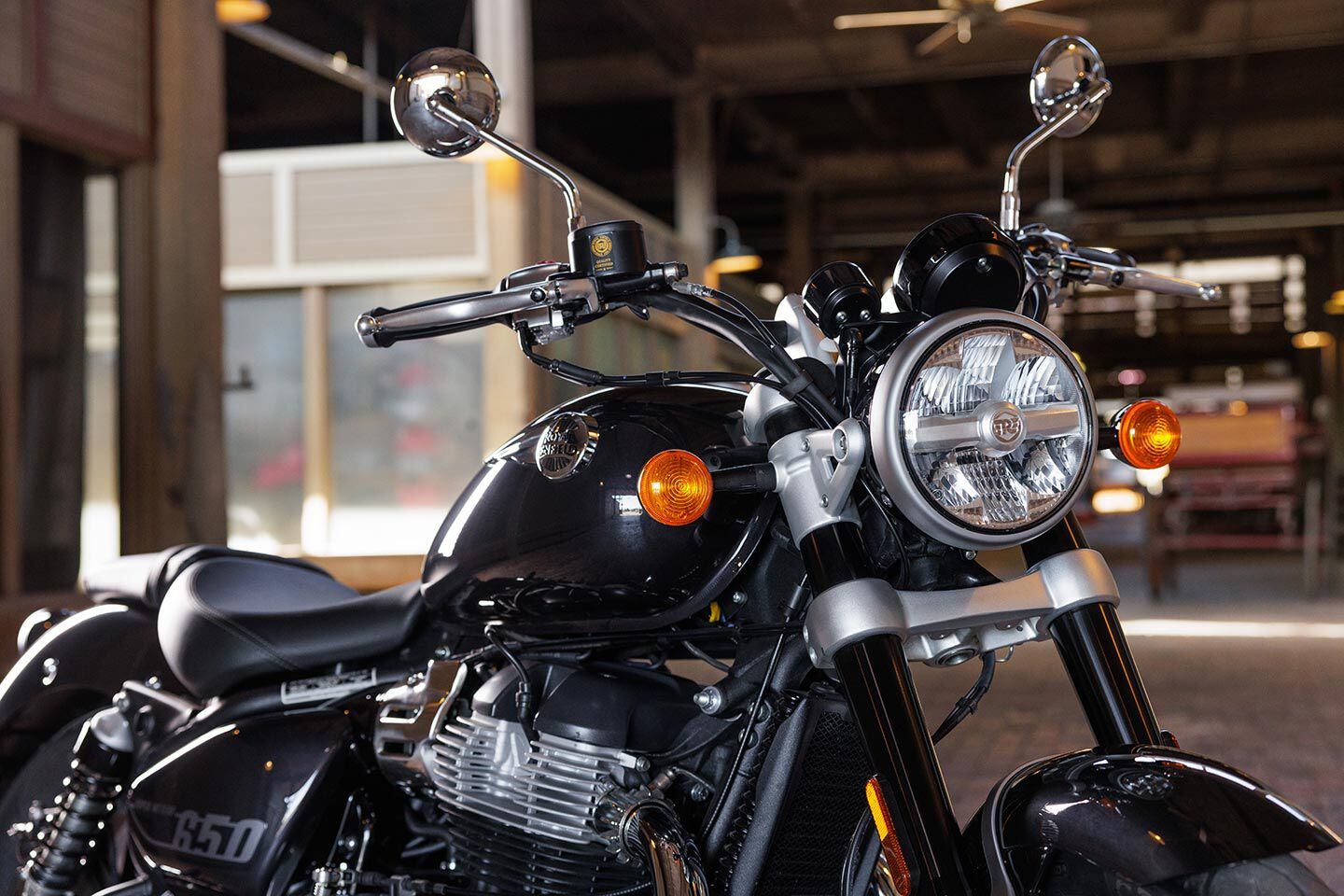
The Super Meteor 650 is the first Royal Enfield motorcycle to receive an LED headlight. (Josh Shipps/Klings/Royal Enfield/)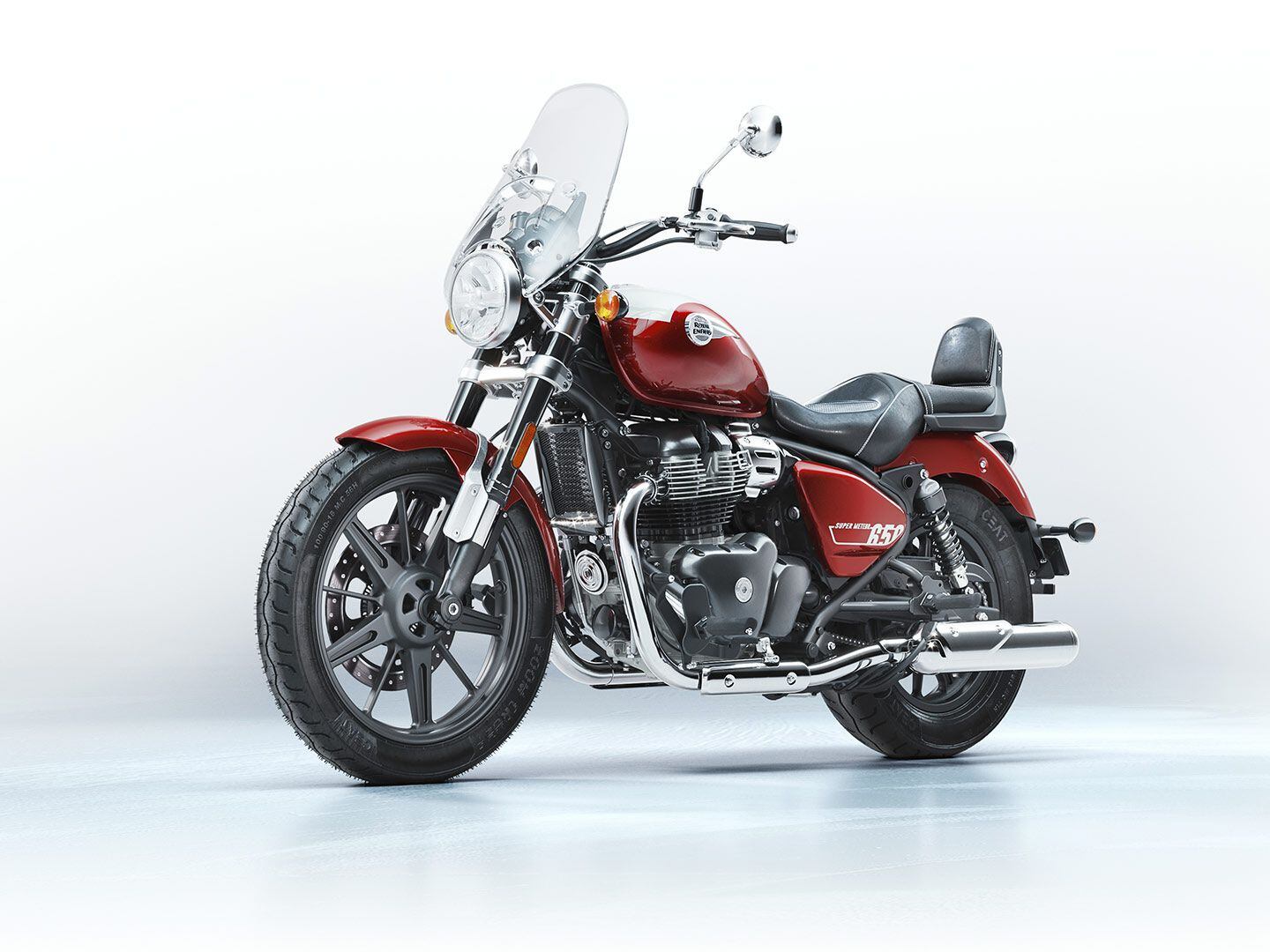
The Super Meteor 650 Tourer comes with a windscreen, deluxe touring seat, and a pillion backrest. (Josh Shipps/Klings/Royal Enfield/)The Royal Enfield Super Meteor 650 is available in three variants: Astral ($6,999), Interstellar ($7,299), and Celestial ($7,499). The Astral model comes in three color options (green, black, and blue). The Interstellar features a two-tone paint scheme in two colors (green or gray), and the Super Meteor 650 Tourer is available in Celestial Red or Celestial Blue and features a windscreen, deluxe touring seat, and pillion backrest. Adding to the bike’s iconic cruiser styling is the 4.2-gallon teardrop fuel tank with a metal gas cap. LED lighting, a first for Royal Enfield, is standard on all.
Royal Enfield has a gamut of Genuine Motorcycle Accessories for the Super Meteor 650 which include the windscreen, the deluxe touring seat, the pillion backrest, and a range of other accessories including engine guards, footpegs, mirrors, and LED turn indicators.
2023 Royal Enfield Super Meteor Riding Impression
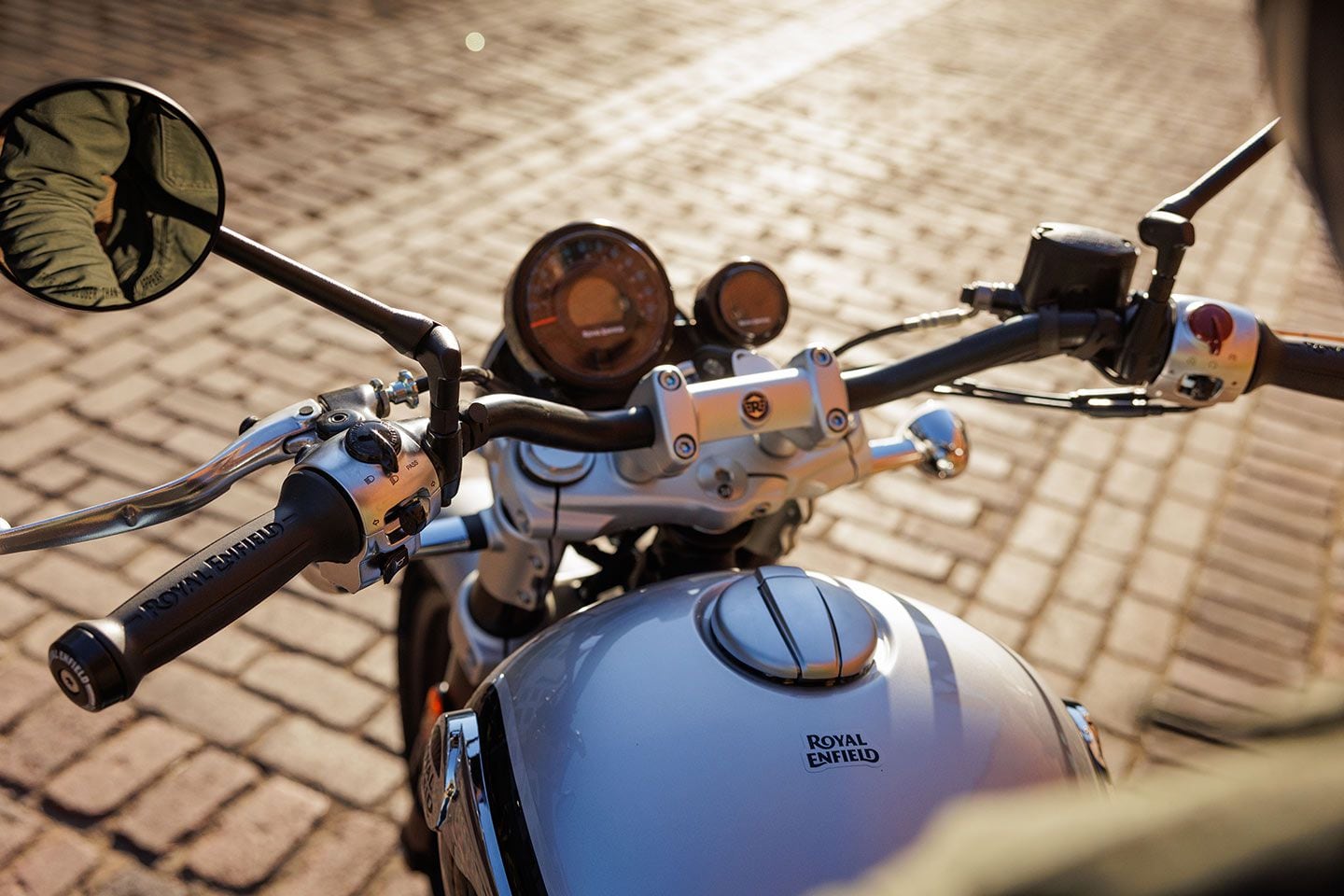
The fit and finish of the Super Meteor 650 is like nothing we've seen before on a Royal Enfield. The craftsmanship is comparable to a Triumph motorcycle. (Josh Shipps/Klings/Royal Enfield/)Swinging a leg over the middleweight cruiser for the first time, the quality of the Super Meteor 650 becomes abundantly clear. From the cockpit, the fit and finish of this Royal Enfield is reminiscent of Triumph’s lauded detailing. The sparkle paint is deep, rich, and without blemishes. At the controls, the switch cubes are surrounded by plated aluminum and the levers are adjustable. Fire up the 648cc parallel twin and the rider is greeted with a soft rumble. The cable-actuated clutch has a great feel and a broad, easy-to-manage engagement range. Its pull is not overly strenuous but strong enough to deliver positive feedback.
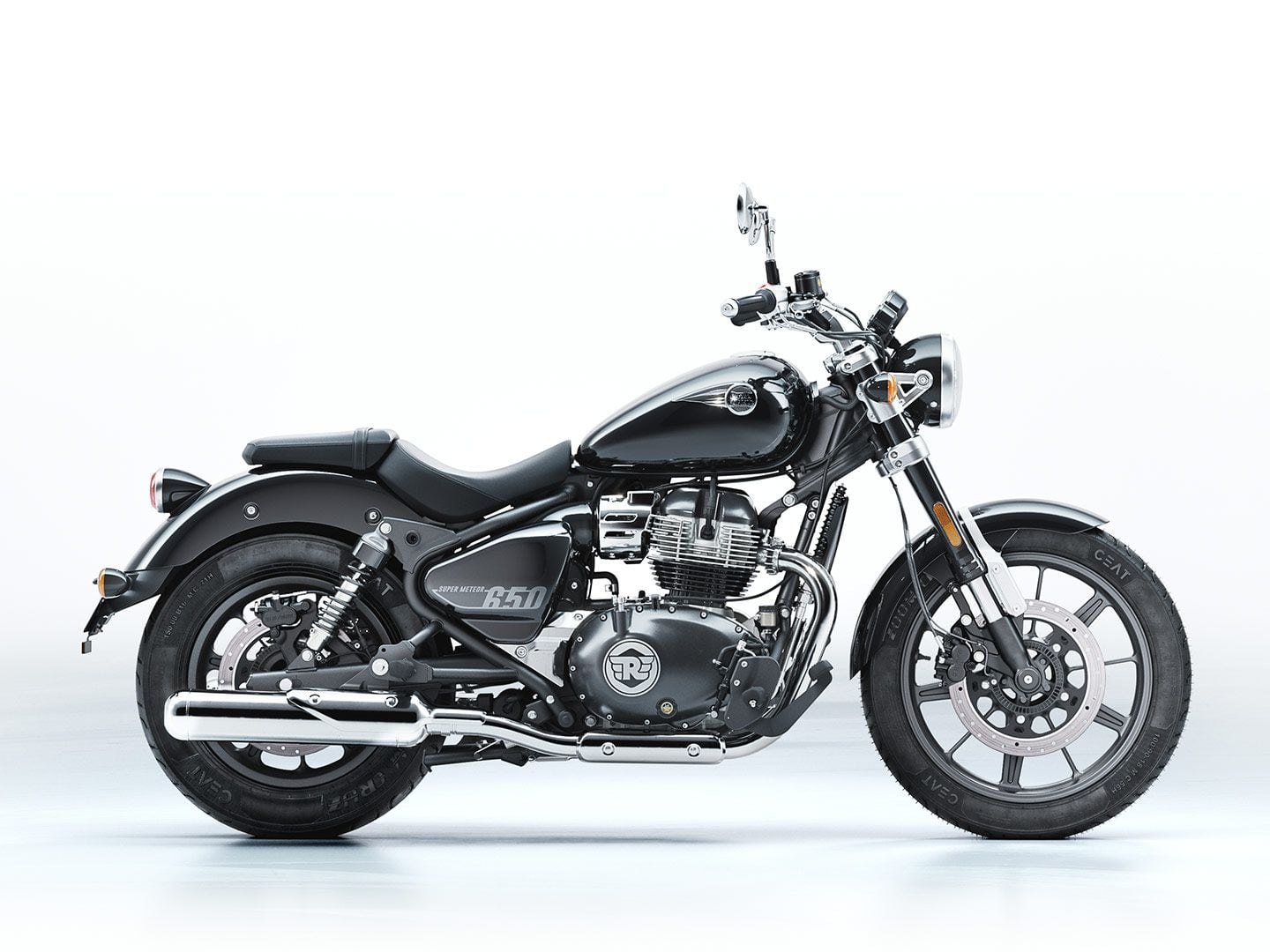
Royal Enfield’s Super Meteor 650 utilizes the same 648cc parallel twin as the INT650 and Continental GT 650. (Josh Shipps/Klings/Royal Enfield/)The 650 twin generates plenty of usable torque down low—essential for a cruiser. And, because it’s so readily available, riding a gear high is easy and you don’t sacrifice much get-up-and-go. Rev the engine out for passing, and the Super Meteor continues to perform. Running the engine high into the rpm range does not generate any uncomfortable buzzing and the power continues to pull. At one point on the ride, the Super Meteor 650 was traveling north of 90 mph and it easily could have gone more.
As we made our way out of Dallas before entering the highway, the Super Meteor’s ability to cruise through town in any gear is impressive. Pulling away from a stoplight, I could short-shift up to fourth gear and cruise effortlessly at speeds as low as 20 mph. Clicking through the gearbox, the shifts are quick and decisive whether the clutch is used or not.
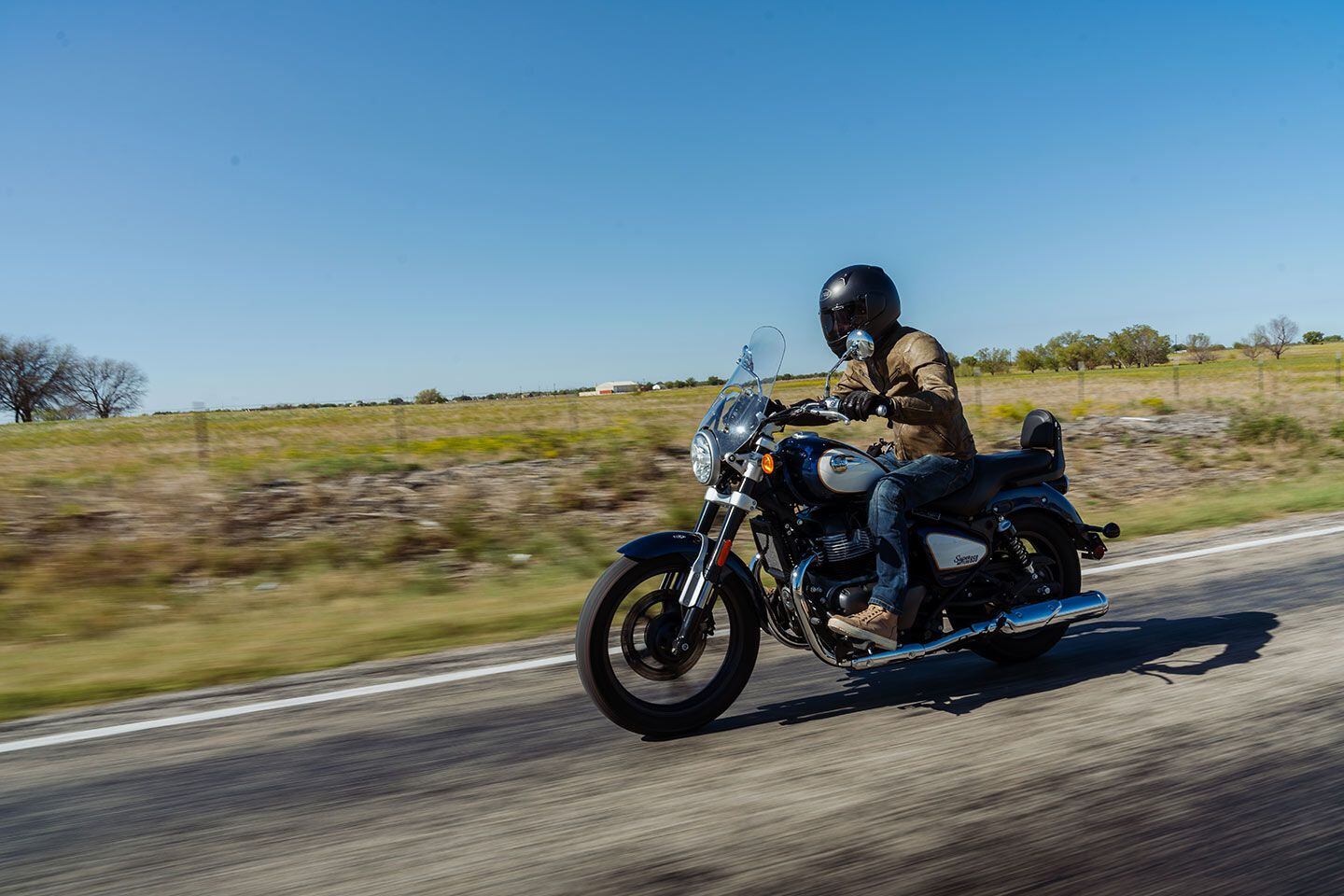
On the Super Meteor 650 Tourer, the windscreen (available on Astral and Interstellar models through Genuine Motorcycle Accessories) provided plenty of wind protection for my body, but generated a lot of buffeting around my helmet. (Josh Shipps/Klings/Royal Enfield/)Traversing through the urban sprawl of Dallas, the suspension provides a stable, precise ride. The nonadjustable suspension settings (preload adjustment on the twin shocks) are taut which allows the bike to maintain a neutral ride despite external forces being applied to the chassis. Grabbing a handful of gas or brake does not make the Super Meteor 650 wallow or seesaw. The 43mm Showa Big Piston Fork offers plenty of holdup when contacting uneven surfaces and provides ample bottoming resistance.
At the rear, the twin shocks are oversprung for a middleweight cruiser. Their stiff spring rate makes the shock ride up in the stroke despite being set on the lowest preload setting. Hitting unexpected bumps in the road can be jarring at the rear, popping my 125-pound frame out of the seat. Some may find this discomforting but I much prefer a bike to be too stiff than too soft.
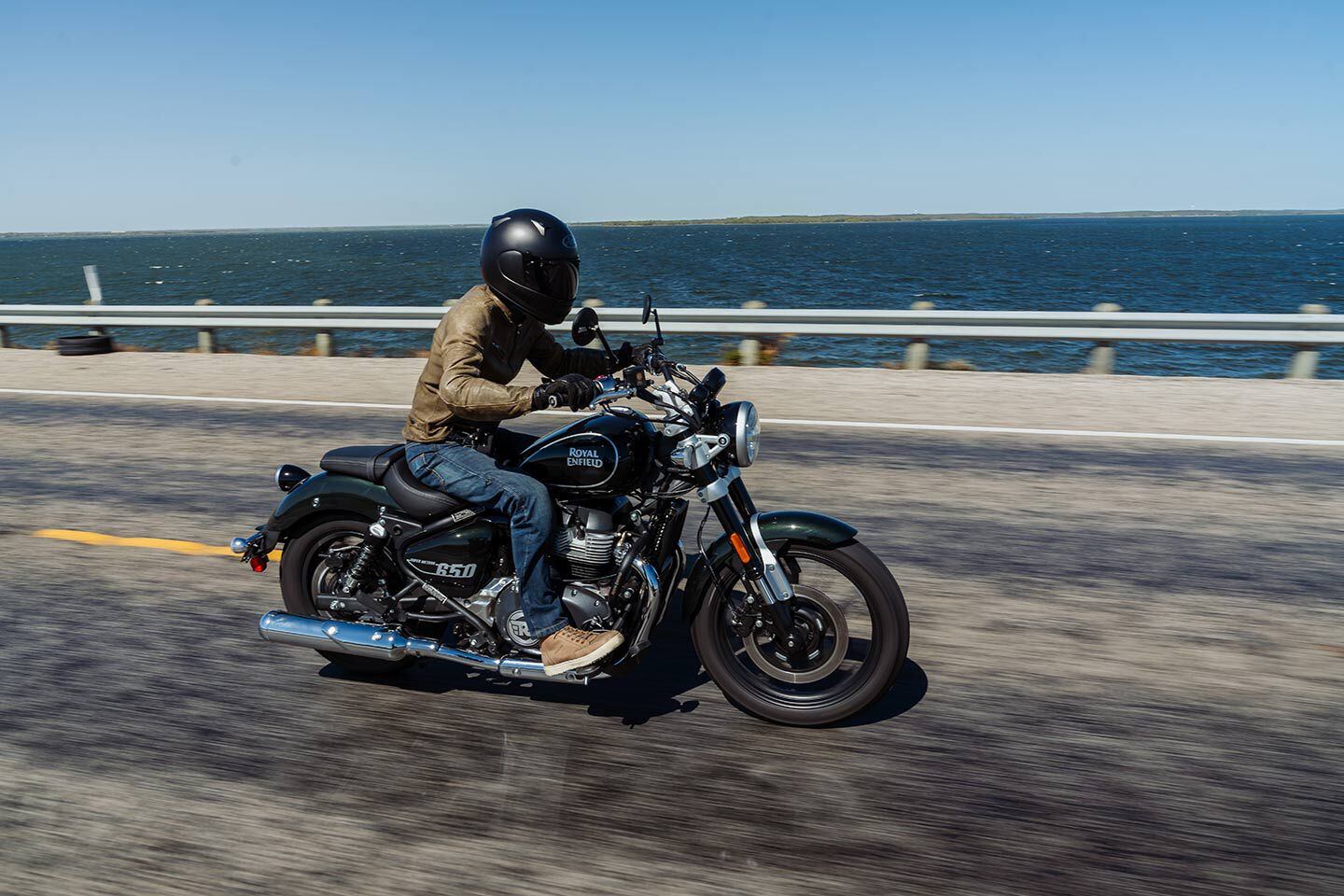
Cruising lakeside on the Super Meteor 650 in Astral Green. The British racing green paint color is fitting for a brand with so much lineage to the UK. (Josh Shipps/Klings/Royal Enfield/)Handling is relaxed and neutral, but if needing to make a quick maneuver, an aggressive input into the wide handlebar will quickly change the trajectory of the motorcycle. We did not find any twisty roads near Dallas, despite trying, but on freeway on-ramps, the Super Meteor 650 easily rolls onto the side of the tire and maintains its lean angle quite comfortably. Coming into corners, initiate the lean angle and maintain it with the throttle before mashing the gas and standing the bike up upon exit. If the roads stayed twisty, the Super Meteor would dance all day.
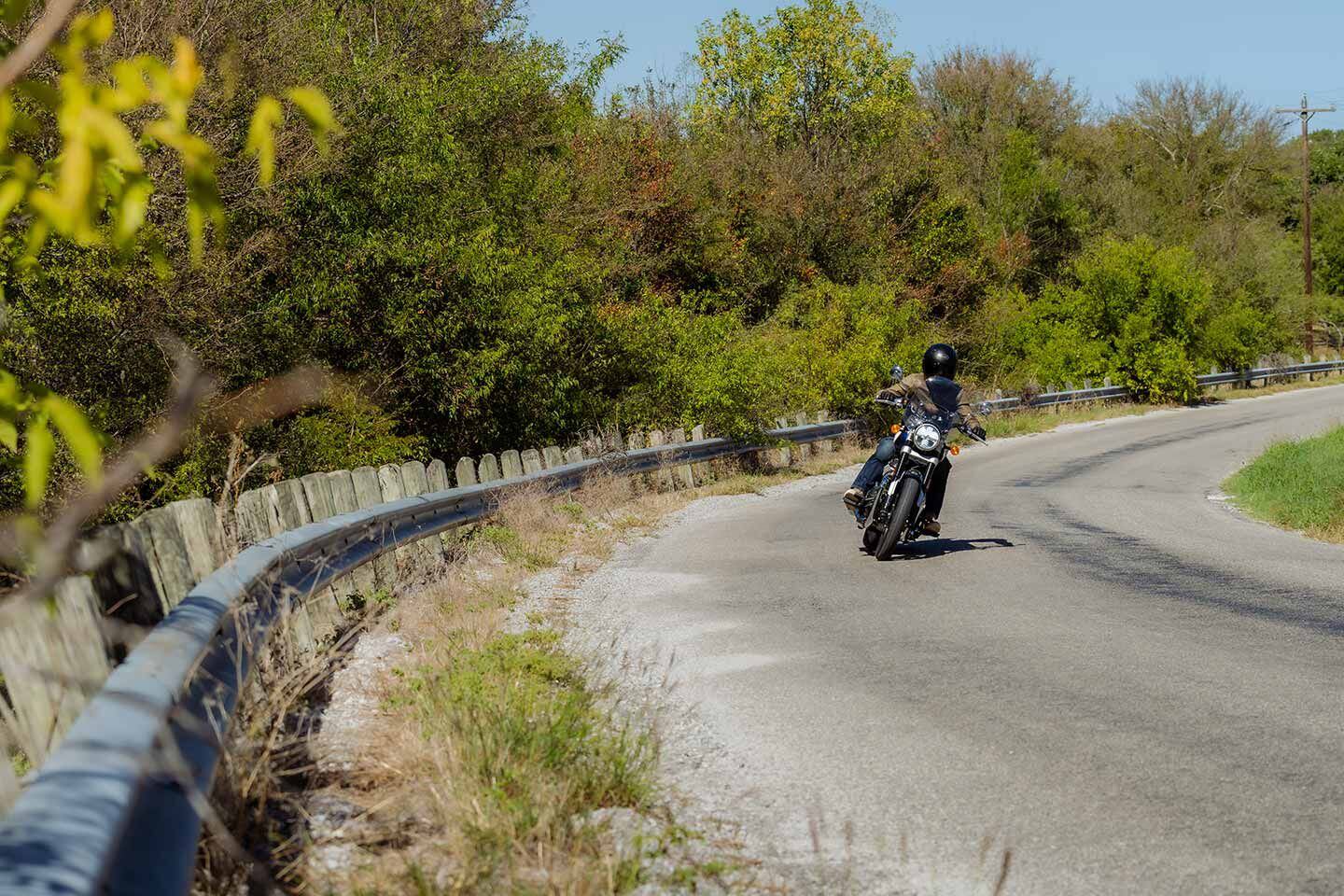
Leaning through one of the few curves available on a backroad near Dallas. (Josh Shipps/Klings/Royal Enfield/)Traveling on straight roads, the Super Meteor 650′s open rider triangle is comfortable cruising for miles on end. Forward controls, a low seat, and a wide handlebar put the rider in a classic cruiser stance. Sit back, put your feet up, and let the time tick by; the only thing this cruiser needs for easier cross-country travel is cruise control.
The ByBre brake system utilizes a single 320mm front disc with a twin-piston floating caliper. A 300mm disc with a twin-piston floating caliper slows the rear wheel. Both brakes feature a dual channel ABS system. Throughout our ride, we did not encounter any hard braking zones. But when testing stopping performance in a straight line, the brakes will quickly shed speed and with a hard enough pull the ABS system will activate.
2023 Royal Enfield Super Meteor 650 Conclusion
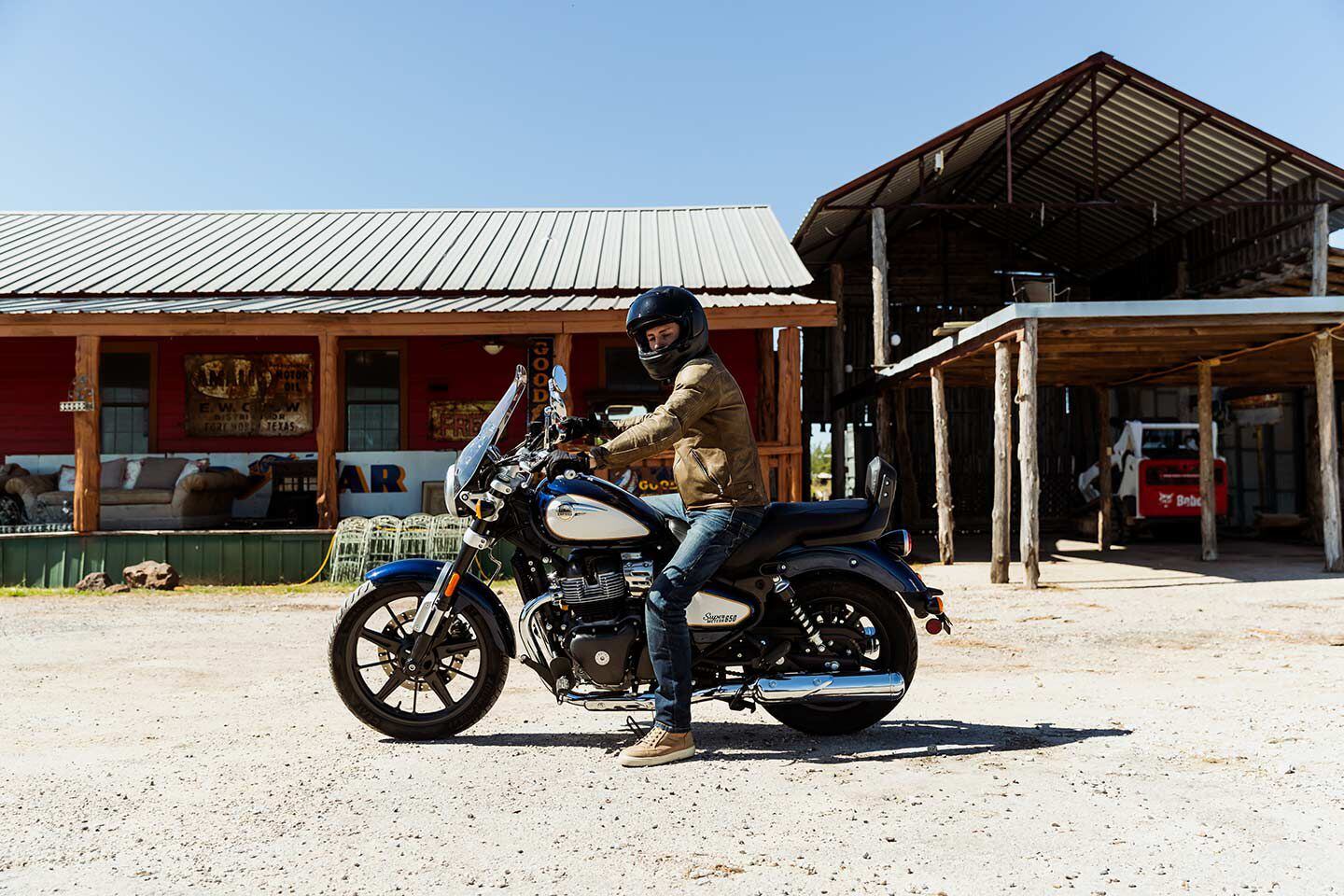
The classic styling of the Super Meteor 650 gives the motorcycle a timeless appearance. (Josh Shipps/Klings/Royal Enfield/)The Super Meteor 650 is a benchmark for Royal Enfield moving forward. In this new middleweight cruiser, Royal Enfield has delivered a level of quality we have not seen from it before. It’s not just “good for a Royal Enfield.” Starting at $6,999, this classic cruiser offers quality craftsmanship, a versatile engine, comfortable ergonomics, and a three-year unlimited-mile warranty with roadside assistance. Any rider entering the middleweight cruiser market must consider the Super Meteor 650.
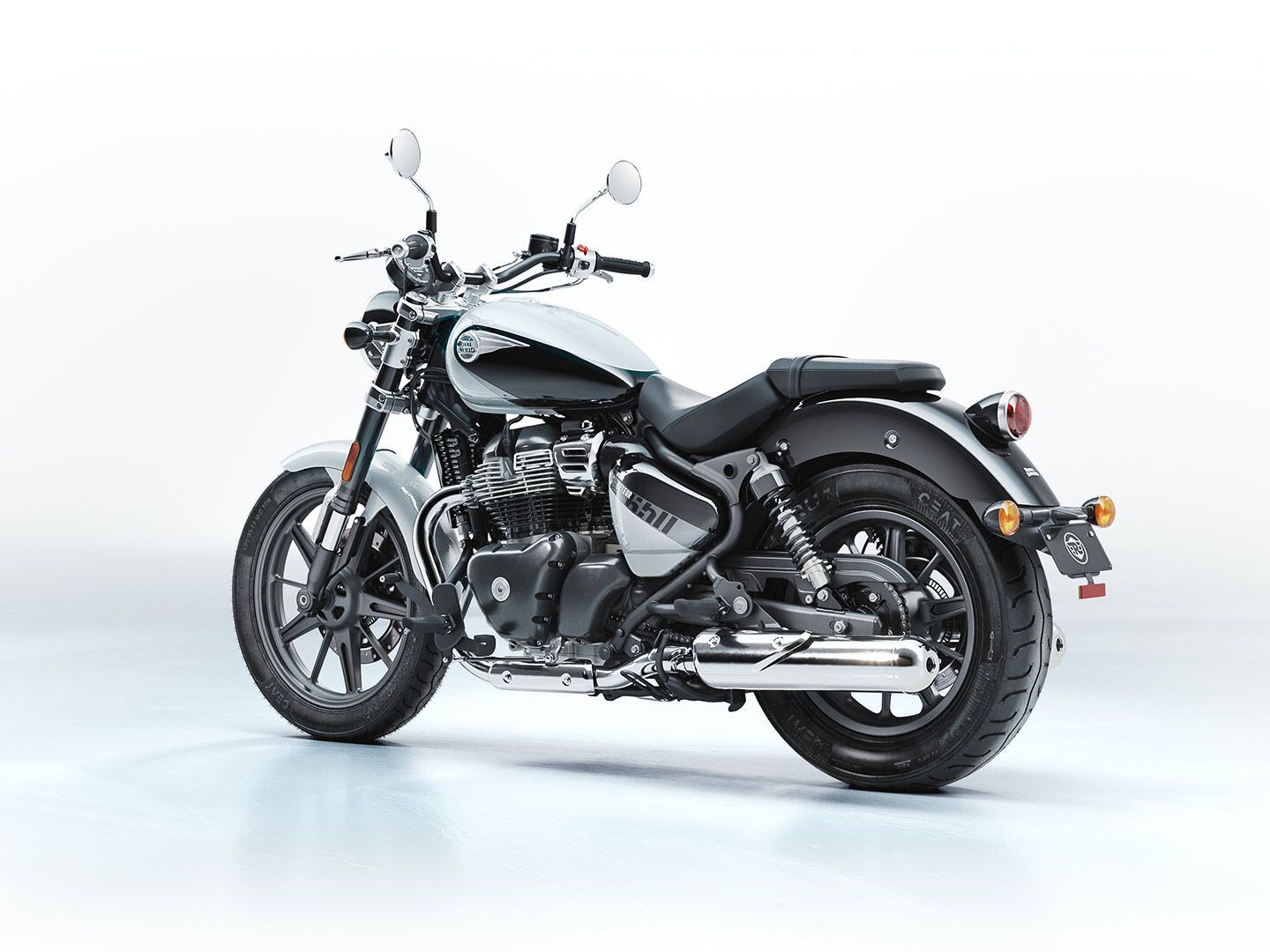
The Royal Enfield Super Meteor 650 in Interstellar Grey ($7,299) features a two-tone paint scheme whereas the Astral models are solid colors. (Josh Shipps/Klings/Royal Enfield/)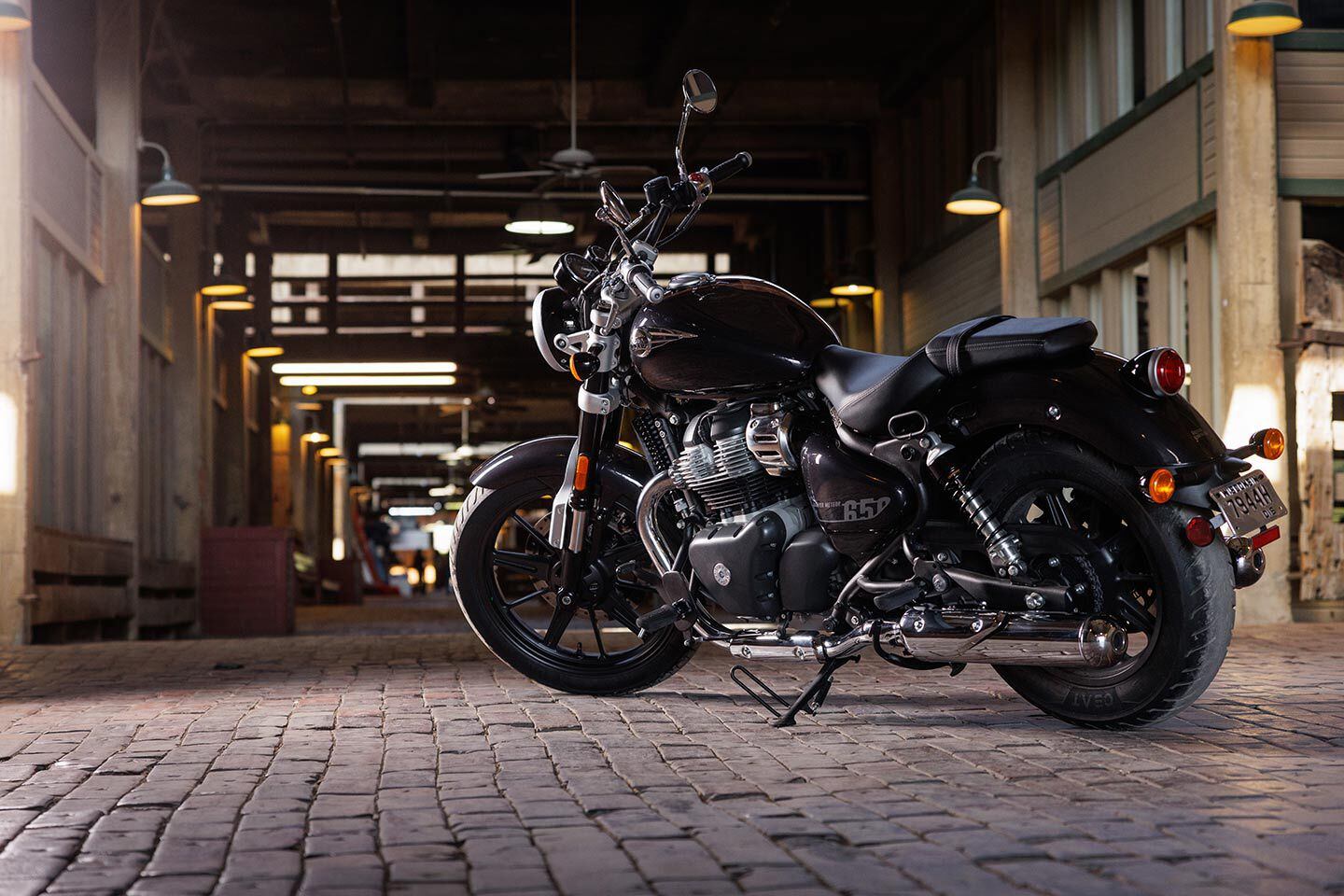
The Super Meteor 650 is by far the most stylish cruiser in its class. (Josh Shipps/Klings/Royal Enfield/)2023 Royal Enfield Super Meteor 650 Specs
MSRP: $6,999–$7,499 Engine: SOHC, air/oil-cooled, 4-stroke parallel twin Displacement: 648cc Bore x Stroke: 78.0 x 67.8mm Compression Ratio: 9.5:1 Transmission/Final Drive: 6-speed constant mesh/chain Claimed Horsepower: 46.39 hp @ 7,250 rpm Claimed Torque: 38.57 lb.-ft. @ 5,650 rpm Fuel System: Electronic fuel injection Clutch: Wet, multiplate Frame: Steel tubular spine Front Suspension: 43mm inverted Showa Big Piston; 4.7 in. travel Rear Suspension: Twin shocks, preload adjustable, 4.0 in. travel Front Brake: 2-piston floating caliper, 320mm disc w/ ABS Rear Brake: 2-piston floating caliper, 300mm disc w/ ABS Wheels, Front/Rear: 19 in./16 in. Tires, Front/Rear: 100/90-19 / 150/80-16 Wheelbase: 59.0 in. Ground Clearance: 5.3 in. Seat Height: 29.1 in. Fuel Capacity: 4.2 gal. Claimed Weight: 531 lb. w/ 90% fuel & oil Contact: royalenfield.com Gearbox
Helmet: Arai Regent-X
Jacket: Spidi Garage
Gloves: Spidi Garage
Pants: Spidi J-Tracker Denim Pants
Boots: Rev’It Grand Shoes
-
 1
1
-
-
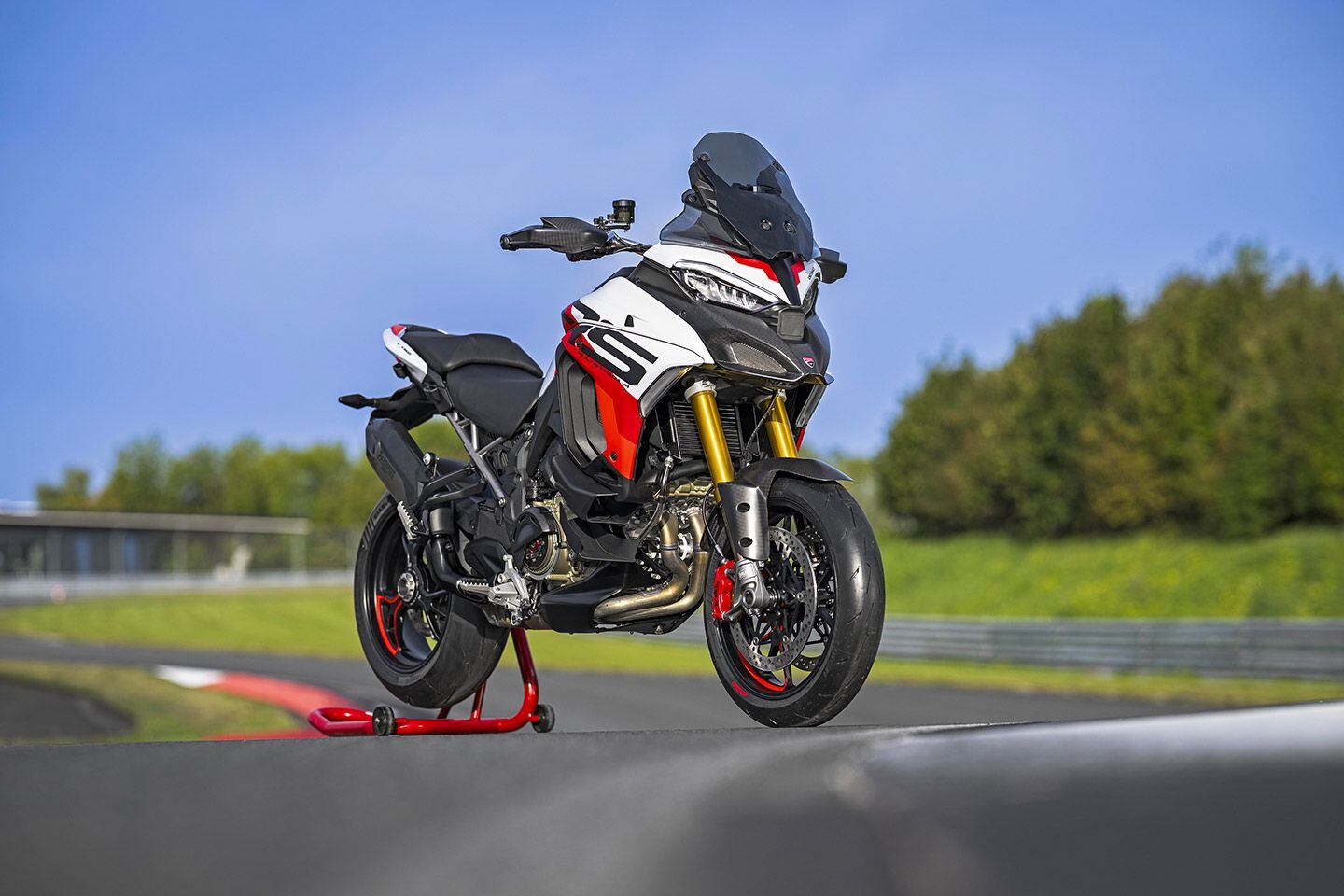
Ducati’s Multistrada V4 RS gets 17-inch wheels and a Desmosedici Stradale engine for serious sporting performance. (Ducati/)Ducati’s Multistrada 1000 debuted at 2001 EICMA and immediately stirred lots of comments, both pro and con. On the positive side was its basic concept of a touring bike that smartly mixed dynamic sportbike performance potential with a comfortable riding posture and aerodynamic protection for long-haul tours. The negative: the bumper car styling of the top fairing. It was designed by Pierre Terblanche, but it was embarrassing to the point that it never captured the hearts of the Ducati enthusiasts.
From that ugly duckling 1000, the Ducati Multistrada has become a successful adventure machine through several redesigns and powerplants. Then in 2021, the mighty Multistrada V4 replaced the previous V-twin versions, rewriting the mission of one of the most successful Ducati models ever. A 1,153cc non-desmo Granturismo V-4 capable of 170 hp and 36,000-mile major service intervals gave the new Multi V4 plenty of power with long-distance confidence.
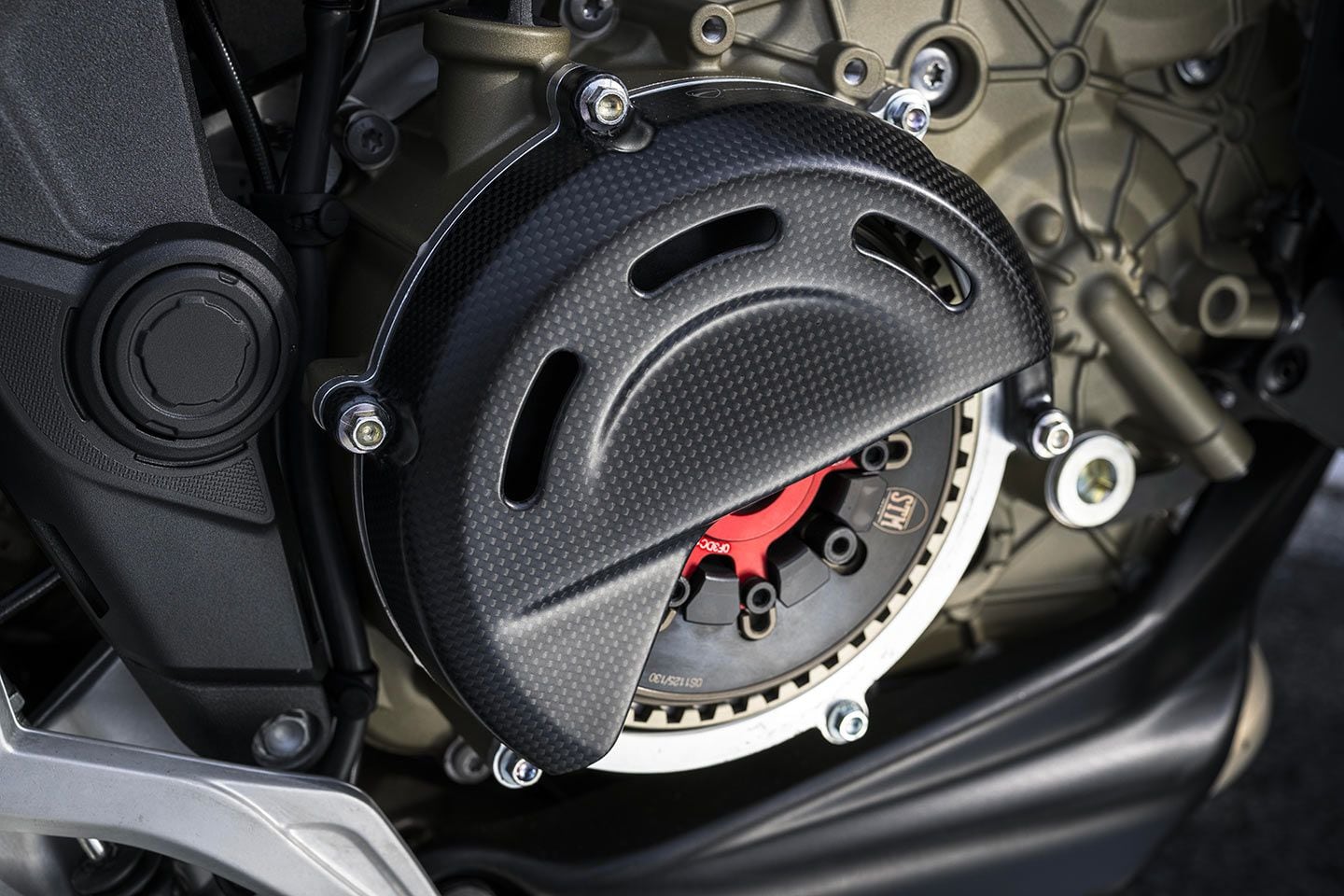
A dry clutch is featured on the Multistrada V4 RS’ Desmosedici Stradale engine. (Ducati/)Now time has come for the sportiest Multi ever. Enter the new Multistrada V4 RS—in many respects a new revolution. First, Multistrada V4 RS is powered by a 1,103cc Desmosedici Stradale capable of 180 hp at 12,250 rpm and 87 lb.-ft. peak torque at 9,500 rpm—basically a milder Panigale V4 Stradale mill that will combine exciting peak power and surprising torque delivery over a broad rpm range. This version of the Panigale V4 engine runs with a 14:1 compression ratio and is fed by four 50mm (round equivalent) elliptical throttle bodies. The unit also features a dry clutch that gives the ability to adopt the special Ducati Corse Shell Advance high-performance oil.
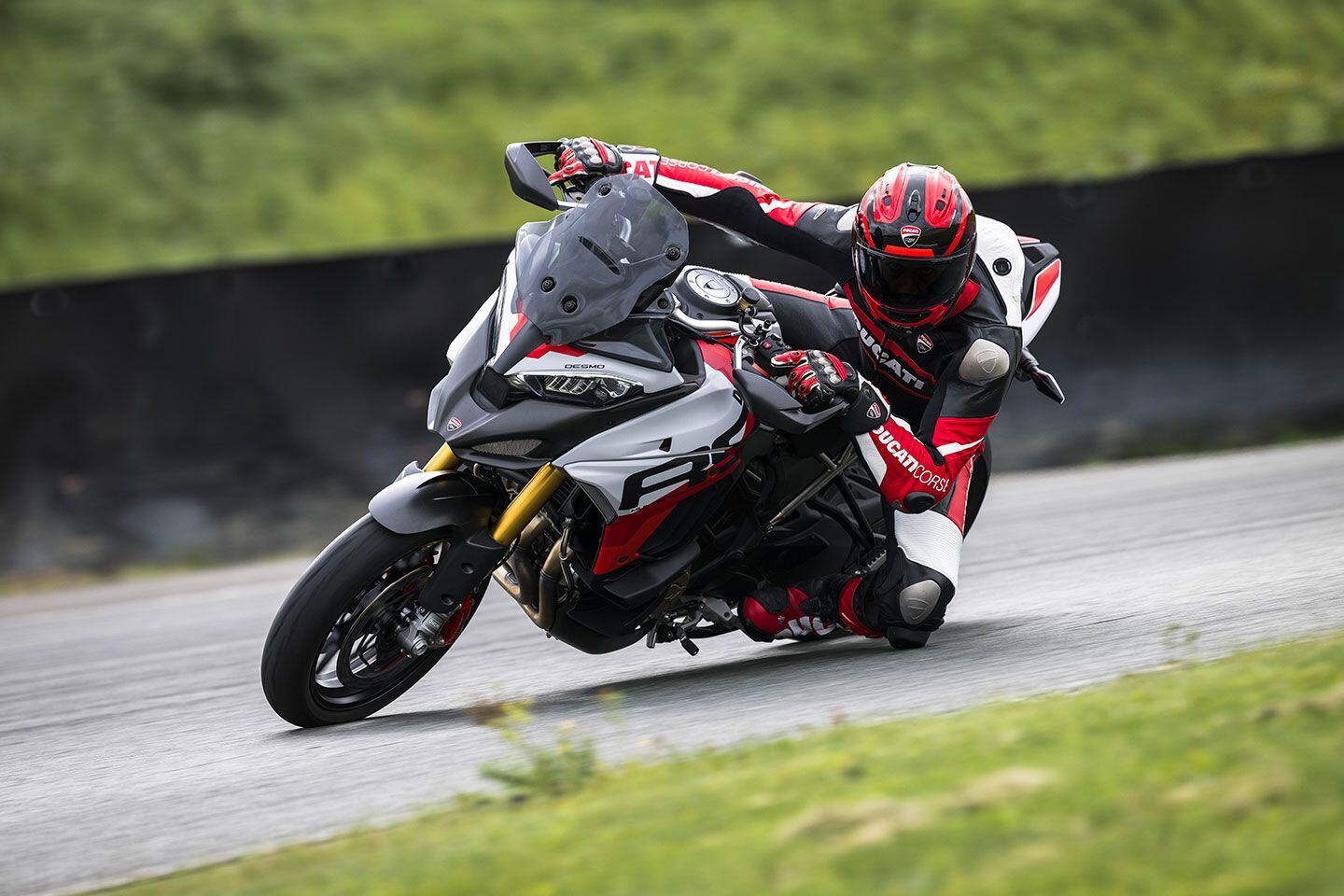
Superbike meets touring: the 2024 Multistrada V4 RS. (Ducati/)To combine top engine power with real racebike dynamics, the 19-inch front wheel has given way to a 17 x 3.50-inch forged wheel shod with a 120/70-17 radial that more effectively cooperates with the 17 x 6.00-inch forged wheel shod with a 190/55-17 radial—both Pirelli Diablo Rosso IV Corsas. The return to a 17-inch front wheel required that the whole front end geometry of the sheet aluminum monocoque frame be revised to compensate for the reduction of the wheel diameter. Consequently, the steering rake has been increased from 24.5 degrees to 25.8. This generates 4.7 inches (120mm) of trail, a net increase over the previous 4.2 inches (105.5mm).
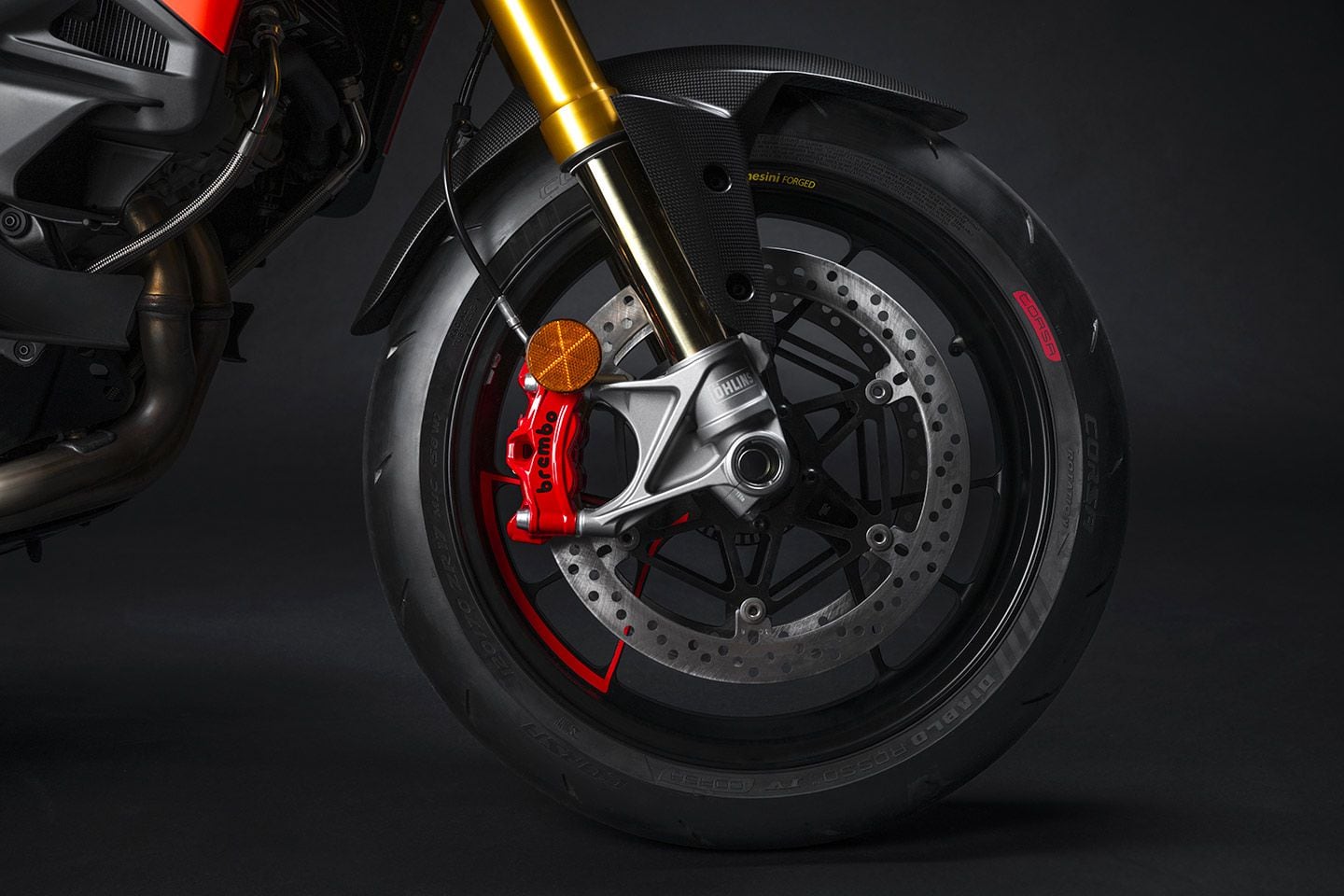
A 17-inch forged front wheel with Pirelli Diablo Rosso IV Corsa tires signal the true intentions of the Multi V4 RS. (Ducati/)Being intended as a real sporting tourer, the Multistrada RS chassis spans a wheelbase of 62.7 inches, which contributes to comfortable accommodations for two. The seat is set at 33.0 inches but a 32.0-inch setting is available as an option. To make the rider more in tune with this powerful bike, footpegs have been moved slightly upward and backward, while the handlebar is lower and narrower.
The suspension department sees Öhlins units employed at both ends: a 48mm fork and a TTX 36 rear shock. Both units are electronically managed to offer active modulation of damping according to Öhlins event-based Smart EC 2.0 control.
Ducati’s electronics suite is one of the most advanced in the business, and is based on the latest Bosch inertial platform that modulates the engine power delivery over four power modes: Full, High, Medium, Low. It also manages a number of safety functions: traction control, wheelie control, engine-brake control, and Ducati quick shift. There’s also four selectable riding modes, including Race Riding Mode, that informs the power, ABS, traction control, engine-braking, and wheelie control settings. Adaptive cruise control and blind spot detection uses forward and rearward radar control technology to ensure safety along with convenience. The TFT 6.5-inch instrumentation panel allows for smartphone control, navigation, and adjustment of all settings.
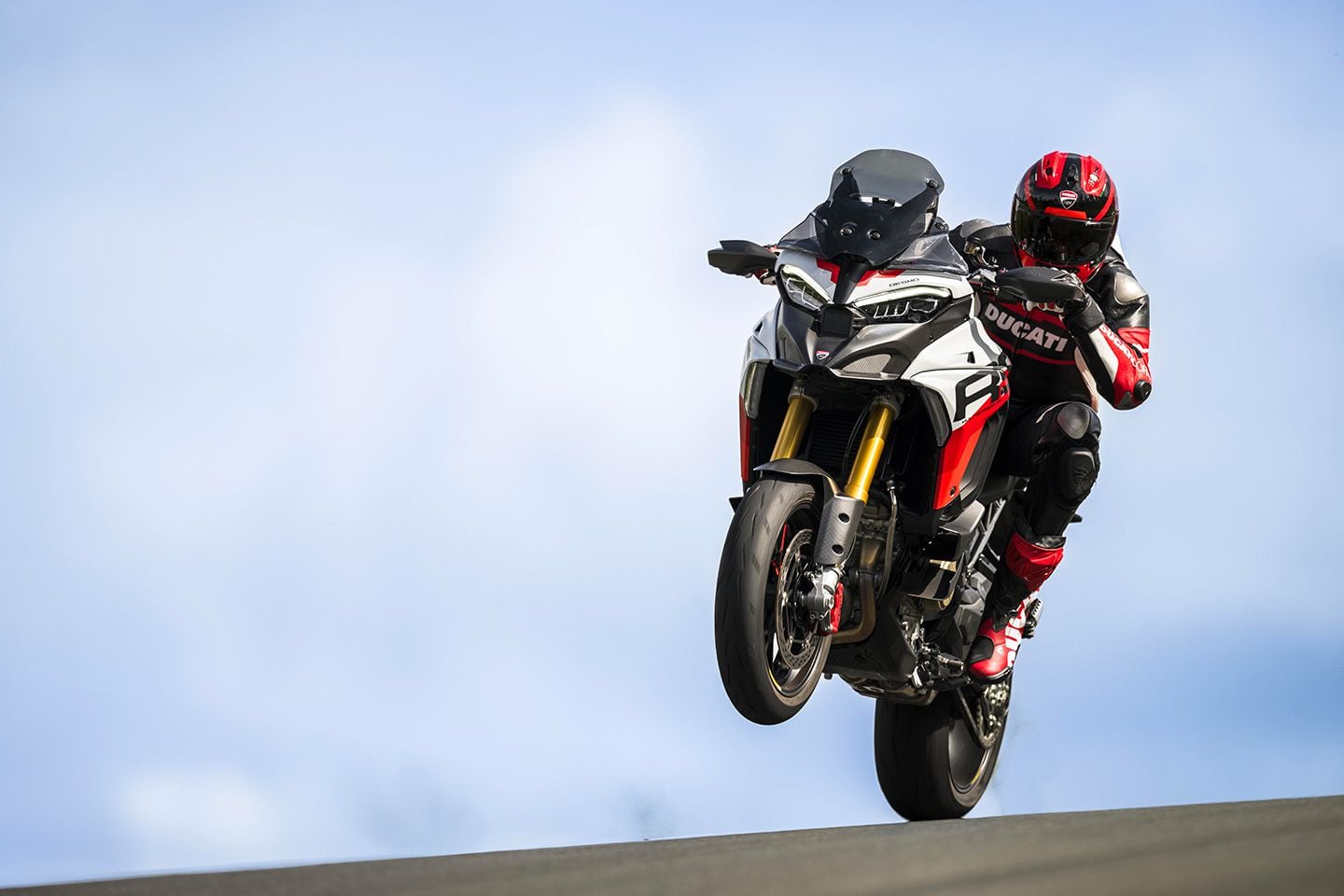
Ducati’s impressive suite of electronic rider aids should allow the rider to extract the most out of the Multistrada V4 RS on the street and track. (Ducati/)The braking system is full-on Brembo with 320mm twin front rotors clamped by four-piston Stylema radial calipers with a 265mm rear rotor with a floating caliper. The whole system is managed by the Brembo-Bosch cornering ABS 10.3ME.
Forged aluminum wheels, titanium rear subframe, various carbon fiber body panels, and a lithium-ion battery reduce the weight by more than 20 pounds in comparison to the Multistrada V4 S powered by the Granturismo engine.
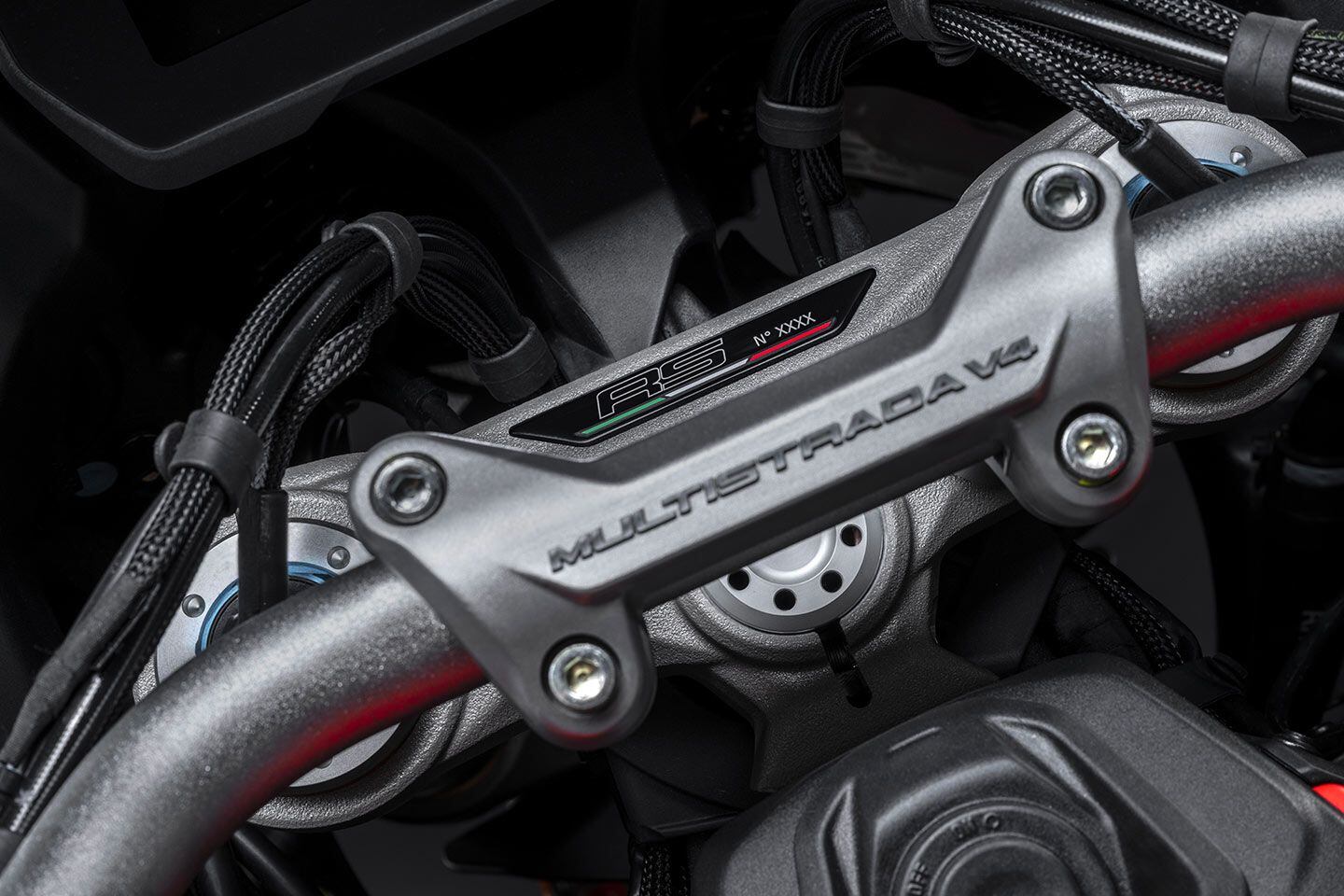
As a special edition, the Multistrada V4 RS will be numbered on the top triple clamp. (Ducati/)Ducati’s Multistrada V4 RS will come in a numbered, but not limited, edition to underline its exclusivity. Pricing is set at $37,995.
-
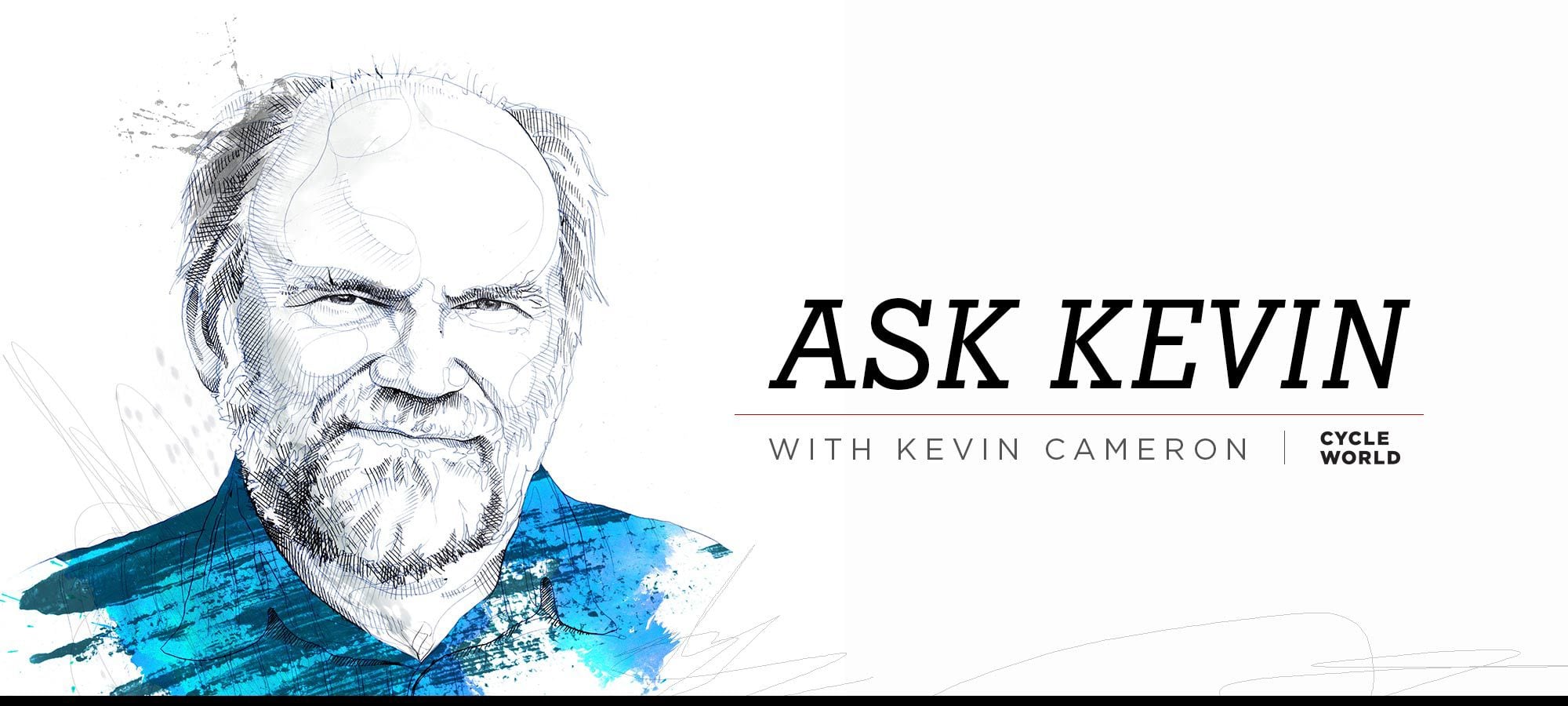
Kevin Cameron has been writing about motorcycles for nearly 50 years, first for <em>Cycle magazine</em> and, since 1992, for <em>Cycle World</em>. (Robert Martin/)Reader Joe Broussard often writes to CW with comments. Today his subject is motorcycle handling, going back to the time when European off-road bikes were said to “have it” and Japanese bikes, while fast in a straight line and mechanically reliable, did not.
In that era, Japanese engineers were not even clear on what Western critics were talking about with this word “handling.” The US mass market had shown that quarter-mile time and top speed were the only performance variables of any market value. That was fortunate, for they were easily measured with readily available equipment.
Cook Neilson was the man who raised Cycle magazine from a remnant of the Floyd Clymer era to being a widely read and respected actual information source. He made a point of trying to understand why Japanese motorcycles—on or off-road—so often handled strangely.
Let’s begin with a purely operational definition of motorcycle handling. Handling is the set of vehicular qualities that results from actively correcting the problems pointed out by riders.
In the time of which Mr. Broussard writes, European makers such as Bultaco, Maico, and Jawa had been involved for years in off-road sport, working hard to improve the performance of their bikes in competition. Japanese manufacturers became aware that this activity could be a profitable market, and began to build their own off-road bikes, such as Yamaha’s 250 DT-1. Because the Japanese industry had not yet recovered from the simple approach of quarter-mile-time-and-top-speed, they had come only a short way along the process that leads to “good handling.” The Japanese product looked OK but had not yet had the benefit of the R&D the Europeans had already done.
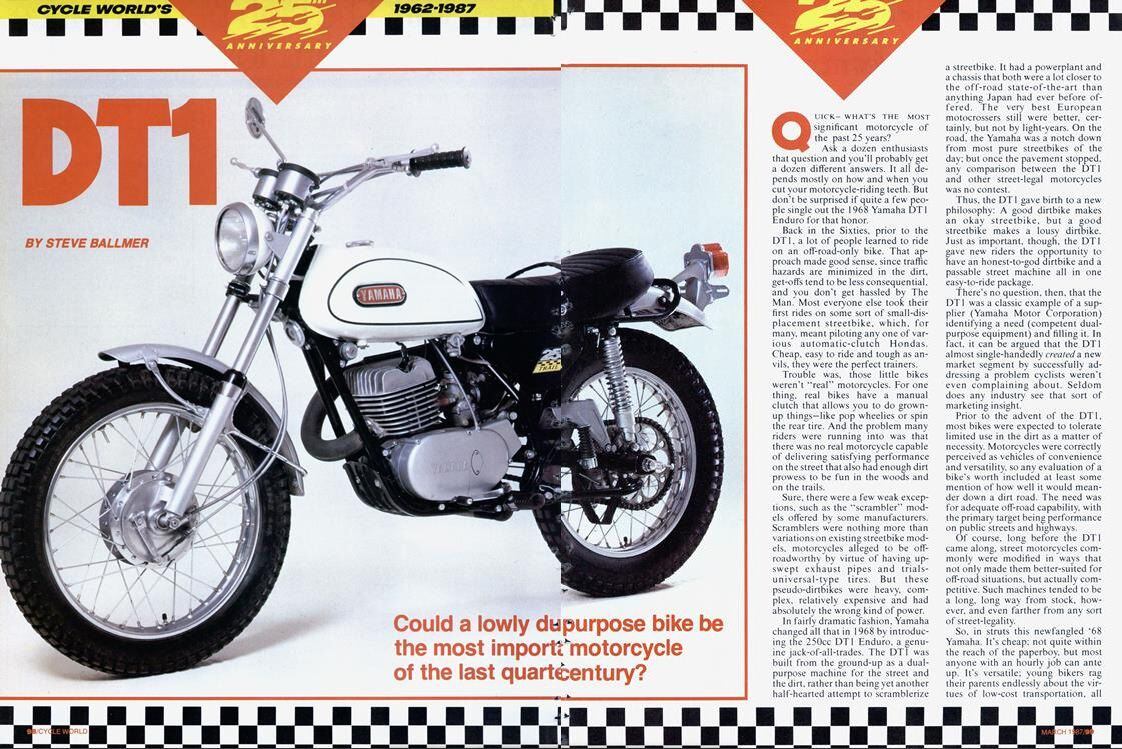
Yamaha’s DT-1 was a first step to good-handling Japanese motorcycles. <i>Cycle World</i>Remember also that the Japanese industry had from early days offered models with the word “scrambler” in their names, but in most cases these were just high-pipe versions of streetbikes having no off-road capability at all. Yamaha’s Ascot Scrambler was actually given a tuned-up YDS-2 250 twin engine but its only real utility off-road was as a flat-tracker.
Off-road handling had to wait until Edison Dye brought European MX riders to the US, allowing everyone to see that there was something about European bikes (and riders) that would have to be learned by any newly involved manufacturer before improved results would come.
The same was also happening with streetbikes. Honda designed and built the 750 Interceptor as a 1983 homologation special to make its second-generation sportbike legal for US Superbike. It was stunned when the new bike sold out, leaving a large number of riders waving cash and asking when they could expect their Interceptors. What was different? The extensive reengineering necessary to make 1970s first-gen Kawasaki Z1s and Suzuki GSs raceable had been designed into the Interceptor from the beginning.
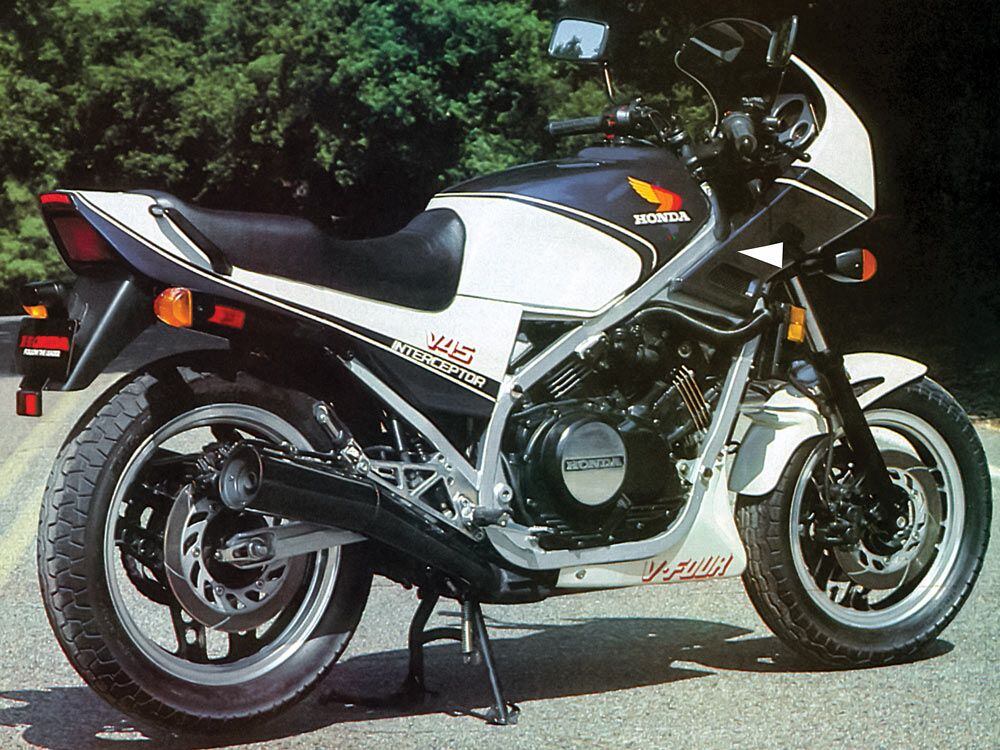
Honda’s 750 Interceptor was built as a homologation special and was snapped up in a flash. (Cycle World/)What drove this change? Japanese makers saw that competition success sold bikes, so they got busy trying to win races with existing designs. Those first-gen Superbikes were combinations of whippy 1960s chassis, short-travel suspension, and narrow, hard tires joined with engines making three times the power of a 1965 Triumph Bonneville. They handled badly! I watched those early Supers rounding the old Riverside, California, Carousel at the 1977 AMA national there and every single one was oscillating in weave.
The differences were magnified at Daytona’s elevated speeds. While the European bikes (Ducatis, Guzzis, and BMWs) were able to reach their top speeds without serious instability, riders on Japanese big-inchers were unable to use their much greater power because they became frighteningly unstable long before reaching top speed. For a time, and in the absence of a better theory, European Superbikes were vaguely believed to have some kind of “European flair”—an indefinable “essence” that made them superior.
Of course, the real reason for this difference was not berets or flowing silk scarves. The Europeans had done a fair amount of development work on their big bikes and the Japanese had not.
Meanwhile, Yamaha and Suzuki jumped into European 500cc GP roadracing and quickly discovered that handling was a real thing that could be achieved by a serious dialog between riders and engineers. Essential to this process were practical and experienced trackside people like Kel Carruthers. Kel, for one, showed Yamaha engineers that when a bike’s steering was heavy and slow, a person of experience could just saw the goddamned steering head off and weld it back on at a different angle. And the rider’s lap time would shorten. Handling was as real as quarter-mile time and top speed, but the only instrument capable of measuring it was the rider.
Herein lies a tale. Neilson and the late Phil Schilling had built their famous modified Ducati known as “The California Hot Rod,” and Neilson had ridden it to victory in the 1977 Daytona Supers race. It was of the era when Euro-bikes were admired for “cornering as if on rails” and experienced riders noted that you had to choose your trajectory with care because you wouldn’t be able to correct it once committed to a corner. Despite the fact that locomotives actually are on rails and cannot be steered at all, this was a much-admired quality.
Then Neilson was invited to Japan by Suzuki to ride its RG500 GP roadracer. When he returned from that trip he was a changed man. He blurted out, “When you’re in a corner and you’d like to be over there, the bike seems to just go there without any action on your part!” That RG had been the result of dialog between engineers and riders.
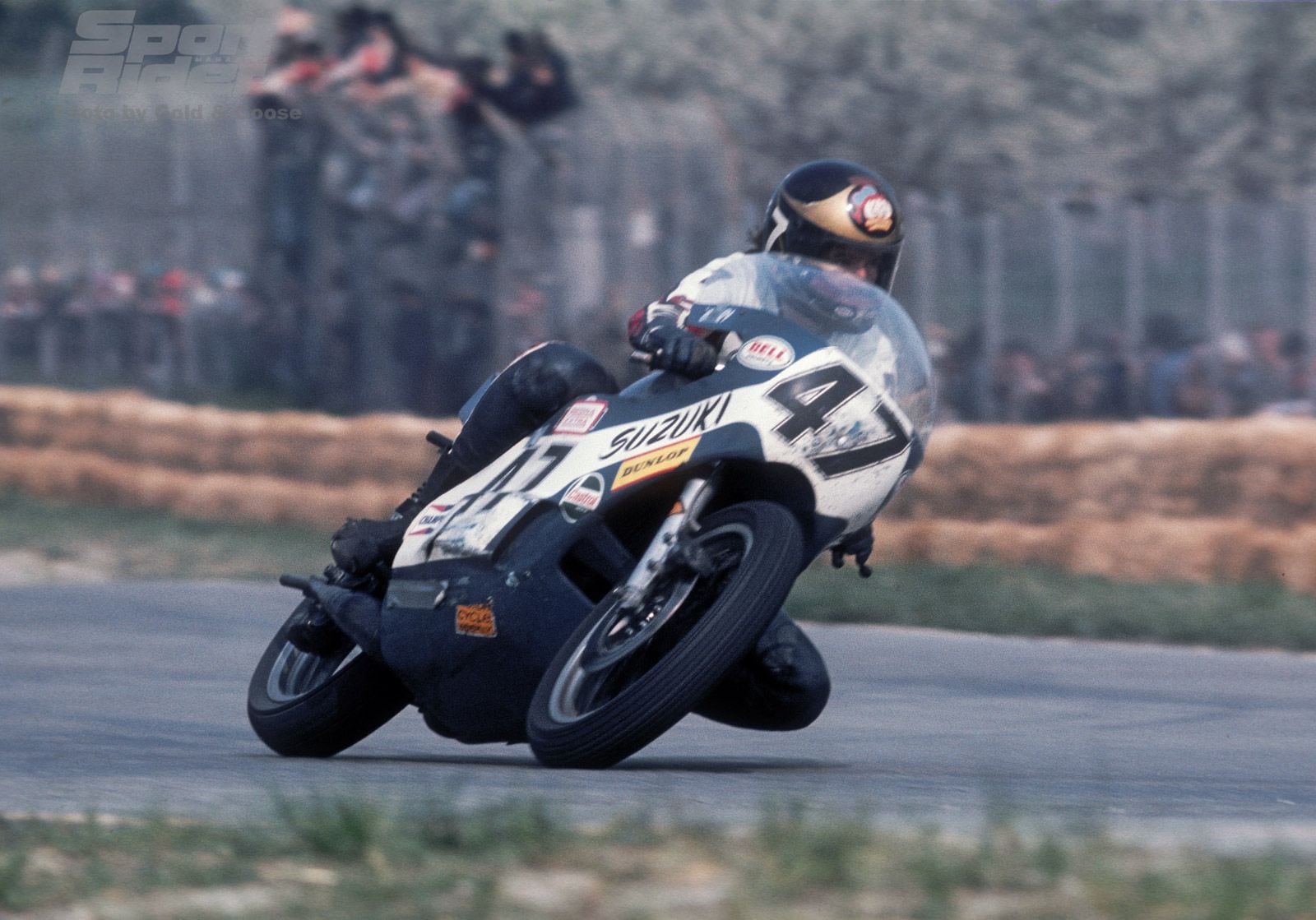
Barry Sheene on Suzuki’s XR14, which became the RG500. <i>Gold and Goose</i>Suddenly it was clear that handling was not some hoary magic, handed up out of a lake like the sword Excalibur. It was the result of a series of plain old physical experiments aimed at discovering ways to make motorcycles respond promptly and precisely to rider inputs. Riders were moved forward on bikes. Steering rake was progressively reduced from the 31 degrees of the sacred bevel-drive Ducati to the 27 degrees of Yamaha’s RD350 and Kawasaki’s Z1, and later, to the approximately 24-1/2 degrees of the present day.
It was also discovered that the accepted practice of pushing the engine back against the rear tire let rivals get the jump on you out of corners because their bikes, with engines mounted farther forward, were not out of control from pawing the air. They were accelerating. Accordingly, Suzuki kept moving its engines forward until riders said “Enough!” (which in some cases was not until the radiator had been slotted to allow an even more pronounced forward position).
There was a revolution in suspension units. When Kenny Roberts complained that harsh compression damping on a Yamaha factory monoshock was making his bike “step out” in unsmooth corners, the response was puzzled looks.
So he said, “Can you build me a shock with no compression valve at all in it? Again, much tooth-sucking but no action. So he insisted.
Yes, they finally admitted, they could build such a shock. When it was installed and Kenny resumed testing, his lap times dropped. He had proved that no compression valve at all was better than the existing hardware—the engineers had seen it with their own eyes. Soon it was realized that compression damping orifices—even when wide open—were at that time so small that compression damping became essentially infinite when a bump drove the suspension unit at a high shaft speed.
This is the essential meaning of handling: Riders and engineers accumulating knowledge in solving problems that stand between them and better performance.
-
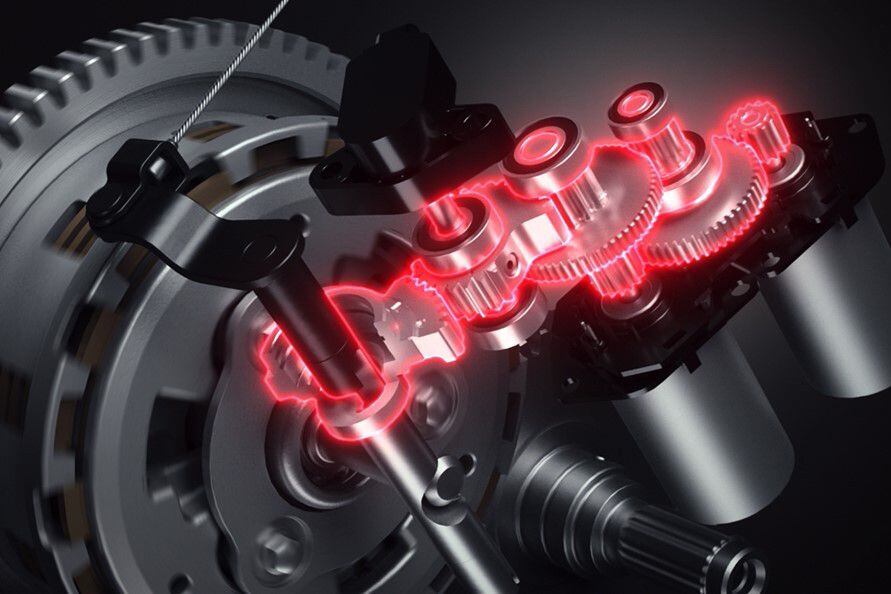
Honda is very close to bringing its E-Clutch to production. The ECU-controlled system uses a pair of motors to engage and disengage the clutch directly on the clutch-release shaft. (Honda/)Whenever new technology is added to motorcycles it tends to spark division between those who accept a step forward with open arms and riders who lament the onslaught of additional complexity and the potential unreliability it brings. Honda’s new E-Clutch—set to appear soon on production models—aims to skirt that problem by introducing the ability to completely automate the clutch of almost any bike without interfering with conventional mechanical components we’re all used to.
Don’t like the idea of computer interference? You can turn it off, and because the original mechanical linkage remains, the clutch will still operate as normal. The same applies in the event of an electrical or component failure in the system. But when it’s working the Honda E-Clutch promises a wide array of possibilities, ranging from the ability to make a conventional bike into a semi-automatic to adding advanced launch-control and anti-stall features.
Although Honda has announced the E-Clutch, the company has officially remained quiet about precisely how it works and what models it will be fitted to. Fortunately, we’ve found a host of patents that describe the system’s mechanical and electronic design, and the limited images that Honda has released already give big clues to the bikes that will be first to get the system.
Officially, Honda says the E-Clutch “uses electronic-control technology to provide instantaneous, fine-tuned clutch control for optimum performance in situations where the driving force changes, such as starting, shifting gears, and stopping, to achieve smooth starting, shifting gears, and stopping more natural than a rider’s manual clutch operation.
To meet a wide range of rider demands, the clutch can be operated like a normal manual motorcycle gripping the clutch lever, even when the clutch is controlled electronically.”
The company also says only that it “plans to apply Honda E-Clutch to its ‘fun’ motorcycle models over time.”
A close inspection of the photos and video released with the announcement reveals that the bike used for those pictures and footage is an updated CB650R. The casting shapes and bolt pattern around the clutch cover is a giveaway, and the standard frame of the current CB650R is also visible in some shots. Bar-mounted mirrors show it isn’t the CBR650R, but the same images also show new control pods on the bars and a full-color TFT dash that aren’t present on the current CB650R, confirming there are other updates coming as well as the E-Clutch.
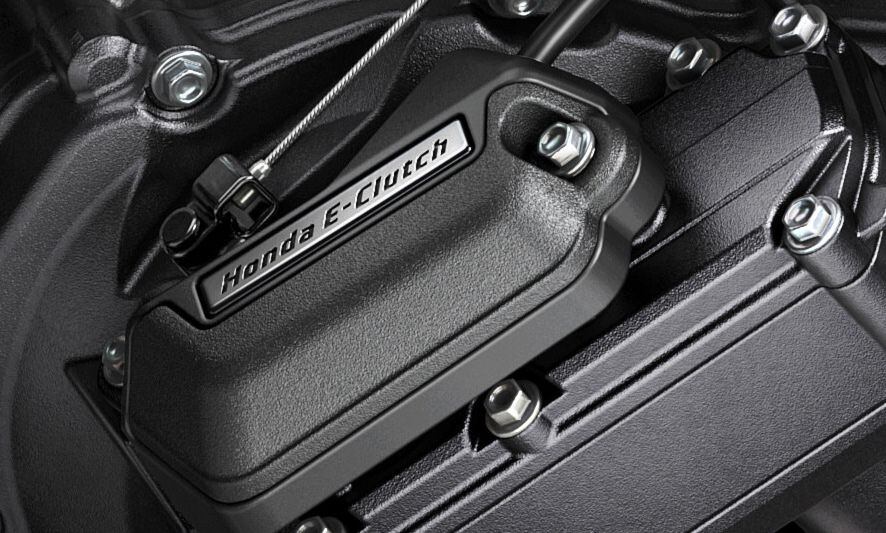
The external view of the clutch cover with the E-Clutch mechanisms underneath. (Honda/)However, the patents filed around the system reveal that it would be simple to fit the E-Clutch to any bike with a conventional cable or hydraulic clutch, all without any major changes apart from a new clutch cover to hold the E-Clutch system, plus an ECU to interface with the bike’s other electronics.
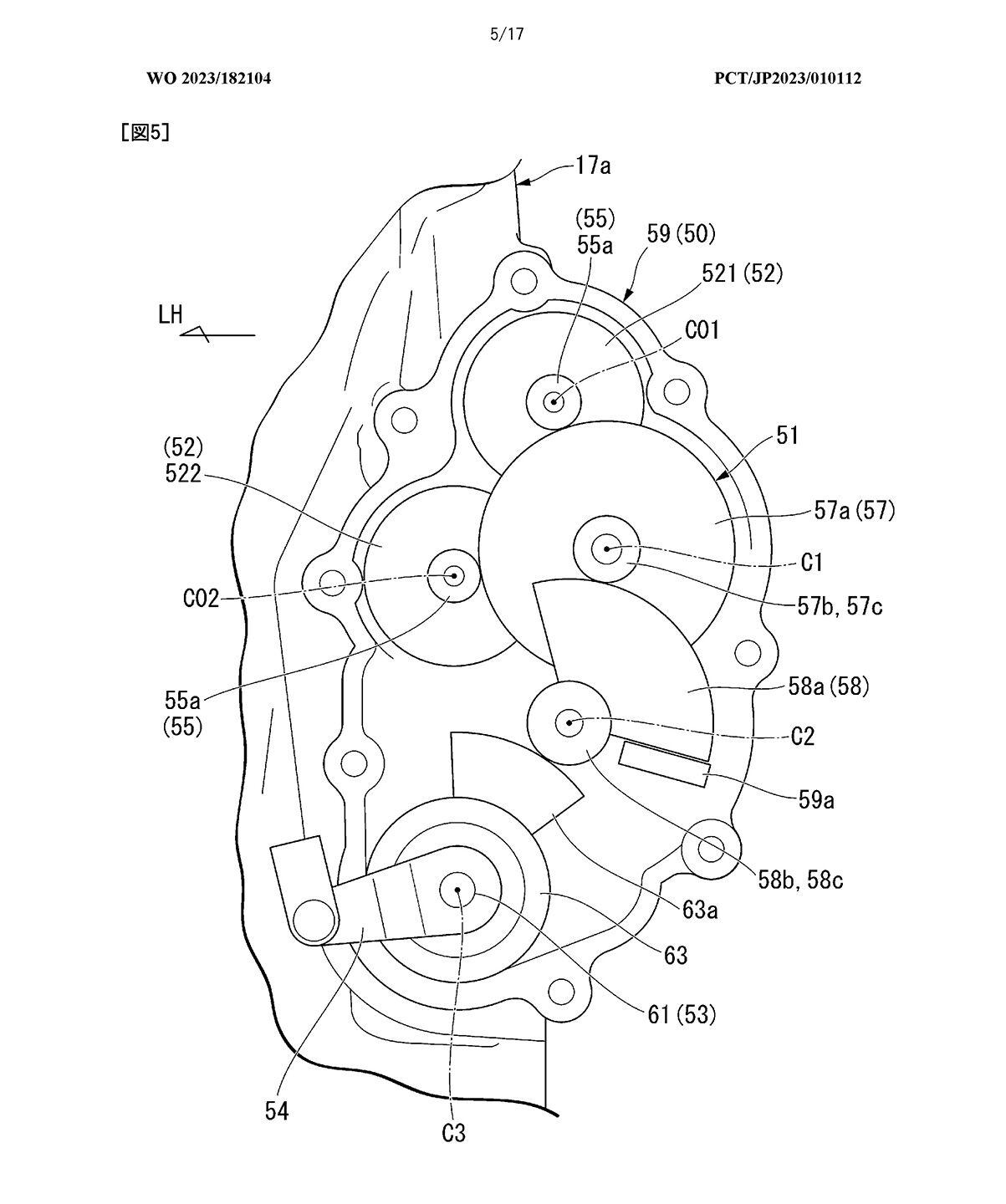
This illustration shows how the reduction and sector gears are laid out. (Honda/)Mechanically, the E-Clutch uses two electric motors geared together onto a set of reduction gears, all mounted in a pod attached to the clutch cover. Two motors appear to be used instead of one simply to keep the unit slim, so it doesn’t protrude too far from the cover on the side of the engine. The reduction gears are connected to sector gears that, in turn, act on the same clutch release shaft that the conventional, bar-mounted clutch lever is connected to (by a cable, in the case of the CB650R). The final sector gear acts on the release shaft via a cam that allows the manual clutch lever on the bar to override the electronic system. So when the electronics are turned off, the clutch operates as a conventional unit.
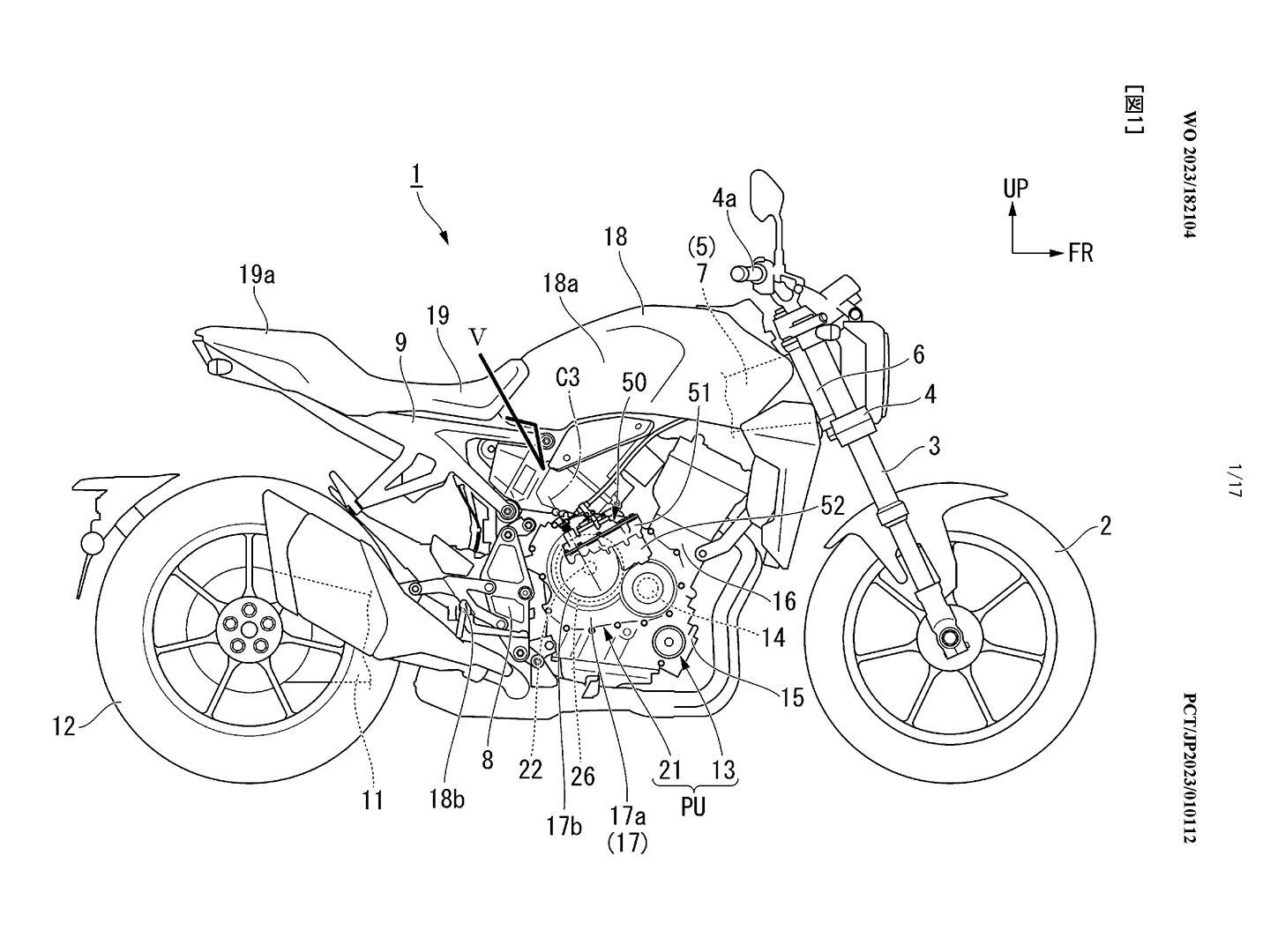
Here we can see that Honda has used the CB1000R in its patent drawings. Is that a clue for an early use application? (Honda/)While Honda’s photos show the E-Clutch on a CB650R, the patents illustrate it on an evolution of the CB1000R, updated to use the engine from the CBR1000RR. Our Japanese sources say that a new CB1000R—likely to gain the “CB1000 Hornet” name in some countries to match the CB750 Hornet that was launched a year ago—is imminent, and that it will feature the SC77 CBR1000RR engine with between 150 and 160 hp. The patents suggest it may also be offered with the E-Clutch.
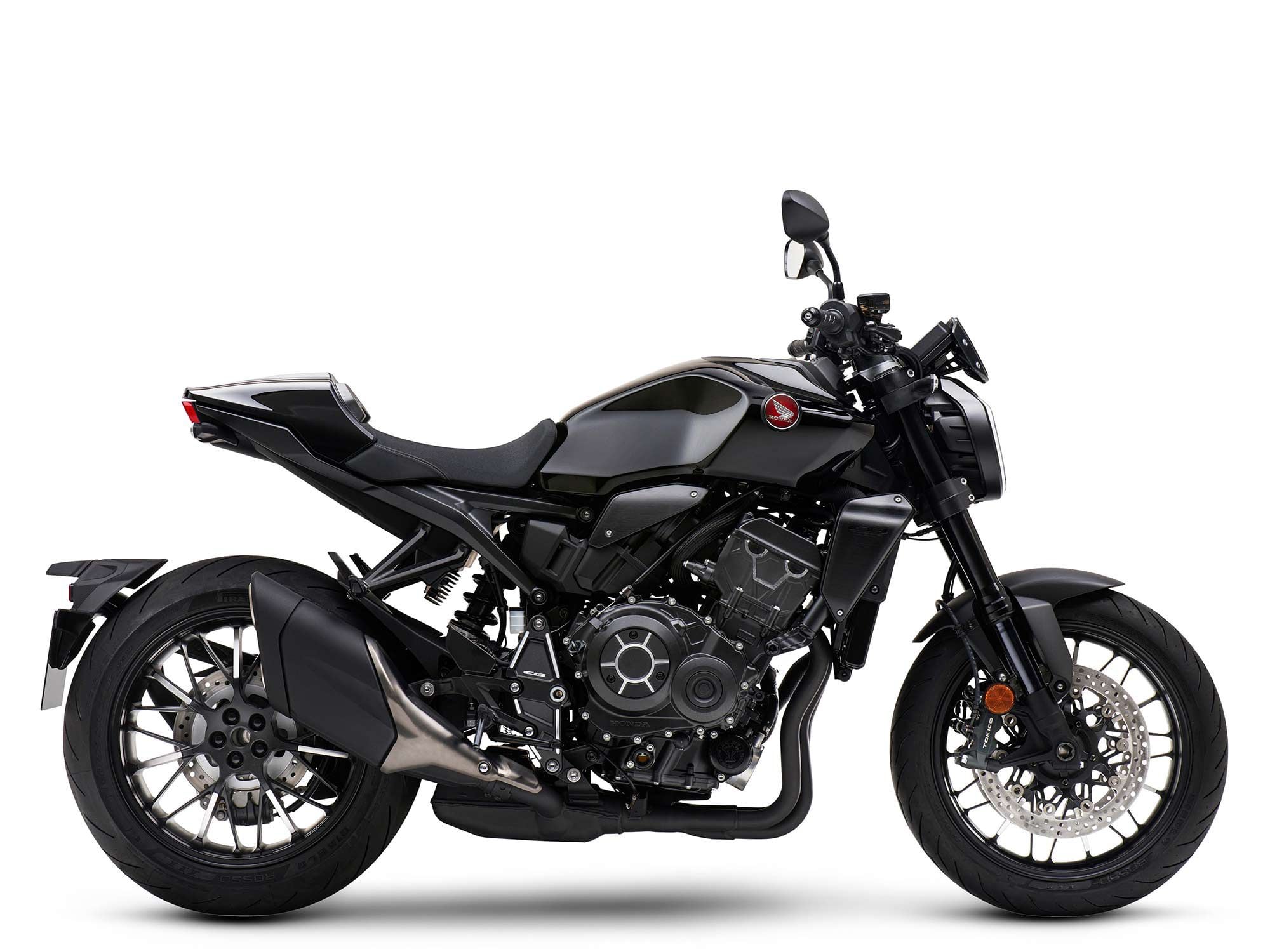
Honda’s CB1000R. (Honda/)When it comes to potential uses of the E-Clutch, there are several. In its simplest form it can be used to disengage the clutch when you come to a halt and to automatically engage it when you open the throttle, allowing you to pull away and stop without using the lever on the bar. It also operates, alongside a bidirectional quickshifter and auto-blipper, during gear changes up and down through the transmission. You still use your left foot to shift ratios, but again there’s no need to pull in the clutch lever, and the electronics promise to make the shifts at least as smooth as a human can manage.
However, there are other possibilities mentioned in the patents. These include multiple modes—selected alongside the bike’s riding modes—to alter the aggression of the clutch, for instance how fast it will allow you to pull away from a standstill and how rapidly it will operate during gearshifts. An anti-stall system is also described in the patents, allowing the E-Clutch to intervene (even when turned off) to disengage the clutch if the engine is about to stall due to ham-fisted use of the conventional clutch lever. Of course, that can also be tied in with the ride-by-wire throttle to balance the clutch and the throttle positions, preventing a stall and leading to a smooth getaway.
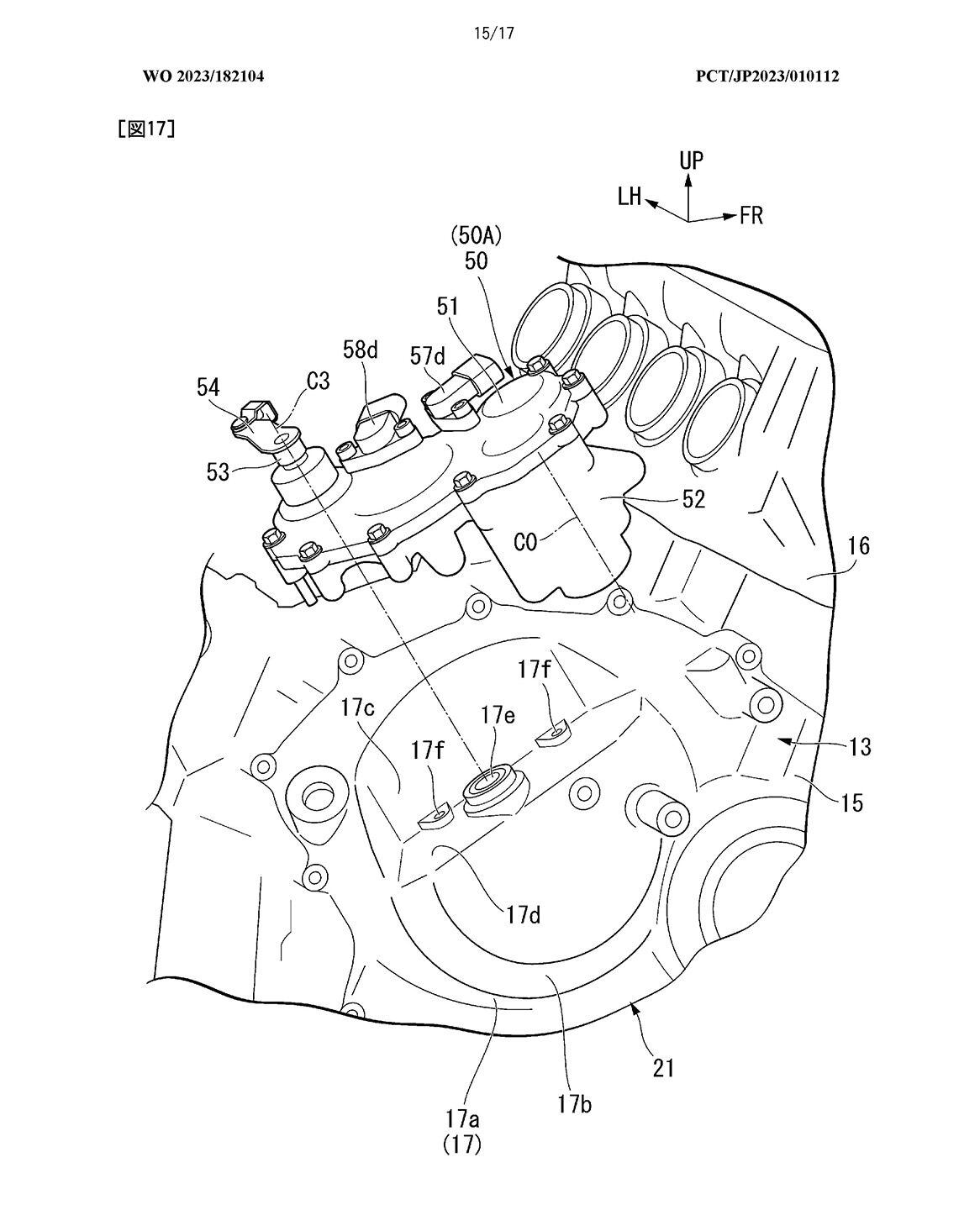
Here you can see how the unit bolts onto the clutch cover. (Honda/)The same patents also suggest how the system can be used with a launch-control system. If implemented, it would let you preselect launch control then simply wind on the throttle to get away as fast as the bike can manage—with the ideal combination of revs and clutch operation all achieved automatically.
On the flipside of the performance advantages that the E-Clutch might offer, Honda has also filed patents for an idea to use it to boost economy. Specifically, the patents suggest that the E-Clutch could be used to allow the engine to be stopped altogether when a bike is coasting, for instance down a hill, with the E-Clutch disengaging automatically to act rather like the freewheel of a bicycle. As soon as there’s a torque demand, whether to maintain speed or to increase it, the engine would be kicked back into life and the clutch reengaged.
At this stage we don’t know which of the systems will be incorporated into the production version of the E-Clutch. The semi-auto gear changes are confirmed, as is the ability to start and stop without using the clutch lever, and the anti-stall system and multiple riding modes are also likely to be adopted from day one. The economy-focused engine-stop system might be less likely to appear, at least on the initial versions of the E-Clutch system, unless it’s needed to help meet specific emissions or fuel-economy requirements.
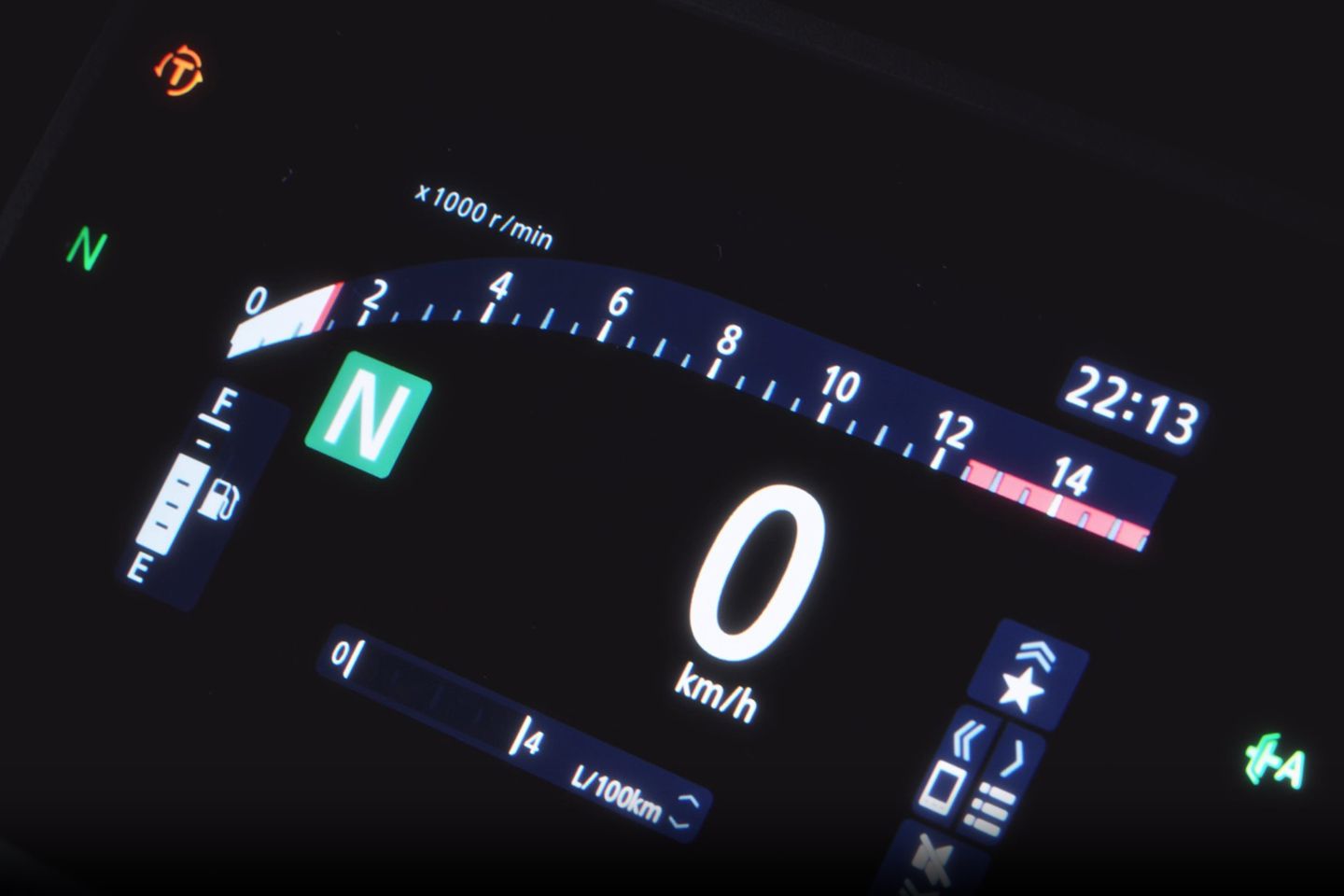
We believe that the symbol on the lower right shows that the E-Clutch is in its automated mode. (Honda/)Amid all these possibilities, those who don’t like additional complexity can ride in the knowledge that the E-Clutch can be simply switched off or overridden by manual use of the clutch lever.
-
 1
1
-
-
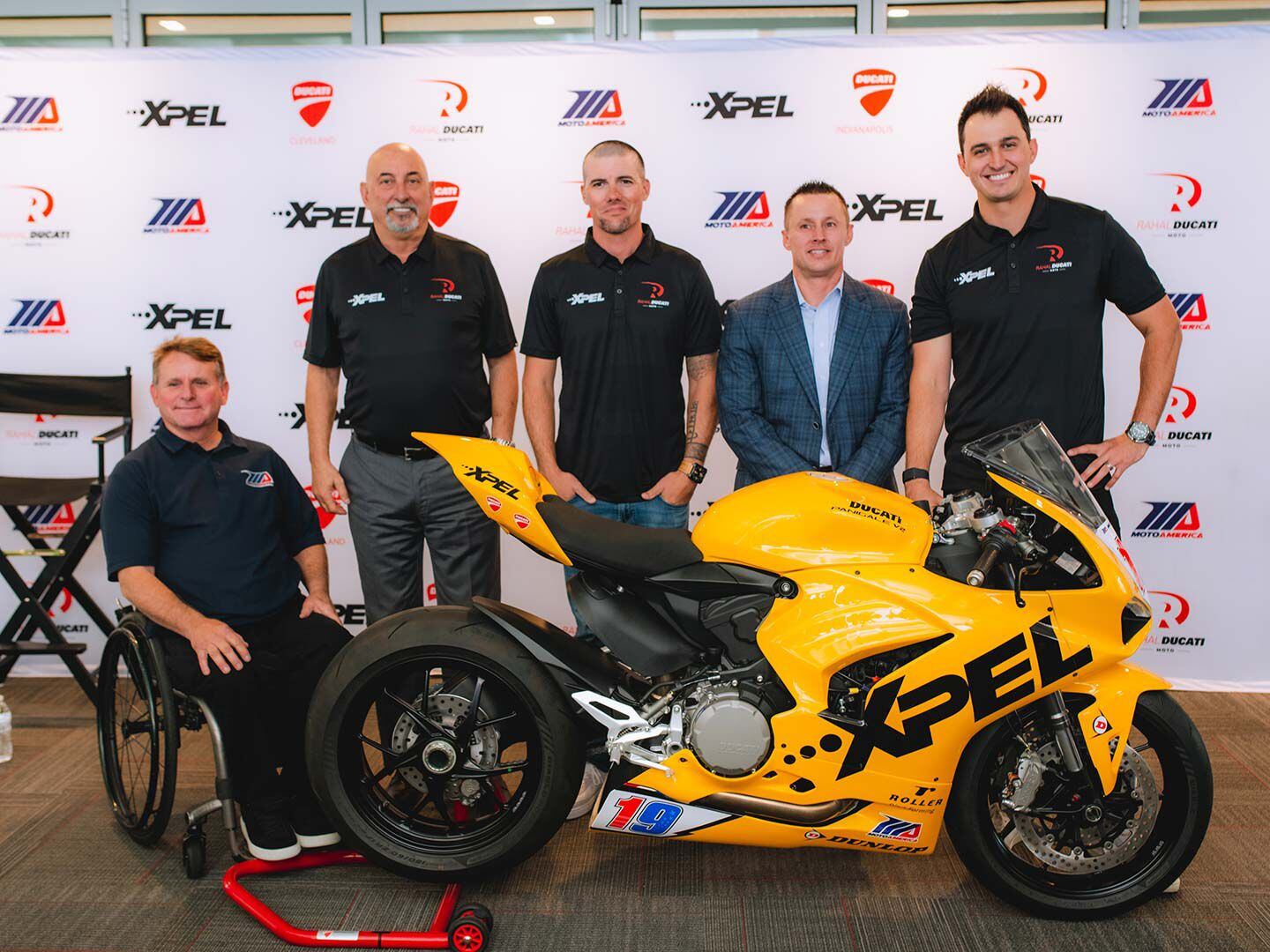
MotoAmerica Announces All-New Team Rahal Ducati Moto (MotoAmerica/)MotoAmerica Press Release:
Graham Rahal has been part of the auto racing world since before he was born but the six-time NTT INDYCAR SERIES race winner is branching out to the two-wheel racing world with the creation of Rahal Ducati Moto, a two-bike team with his father, 1986 Indy 500 and three-time INDYCAR champion, Bobby, that will compete in the Supersport class of MotoAmerica, North America’s premier motorcycle road racing series. The riders of the two Ducati Panigale V2s will be announced at a later date.
XPEL, a leading provider of protective films and coatings, including automotive paint protection film, surface protection film, automotive and commercial/residential window films, and ceramic coatings will be the primary sponsor for the bikes in a multi-year deal. The San Antonio-based company also has a relationship with Rahal Paint Protection and the Bobby Rahal Automotive Group.
For as long as Graham Rahal can remember, he has had a fascination with Ducatis. He purchased his first one in 2007 – a yellow 1098S – with prize money from his Champ Car rookie season and he continued to collect various models over the years but owning a Ducati dealership - or two - or especially a Ducati race team was beyond his wildest imagination.
To set the team up with the best chance of immediate success, Rahal Ducati Moto is bringing in five-time AMA Champion, 2009 World Superbike Champion and MotoGP winner Ben Spies as team principal. The bikes will be prepared for competition for the 2024 season at Rahal Ducati Indianapolis in Brownsburg, Indiana, and then move to the all-new GR Brands headquarters in Zionsville, Indiana, which Rahal broke ground on earlier this year and is scheduled to be completed in the winter of ‘24.
The 2024 MotoAmerica season begins with the 82nd running of the historic Daytona 200, a non-points-paying Supersport race that will take place at Daytona International Speedway, March 7-9. New to the MotoAmerica series will be a round at Mid-Ohio Sports Car Course, August 16-18, the home track for the Rahals, who previously resided in New Albany, Ohio. The 10-round Supersport schedule will be broadcast by MAVTV.
QUOTEBOARD:
GRAHAM RAHAL, Rahal Ducati Moto Co-Owner: “This has been a long time coming and something I have wanted to do since we got the Ducati brands. Having a couple of those stores now has been great and we want to continue to build our relationship. There is no better way to do that than through the racing program and I am excited to get going. None of this would be possible without XPEL, a brand that I have a long-term relationship with through Rahal Paint Protection and I’m eager to see what we can do as a group in the MotoAmerica series. The series has been experiencing impressive growth in recent years and I’m excited to be part of it.
“Having Ben Spies as general manager is a real asset to our program. He gives us a lot of legitimacy but also brings a lot of success and is someone we can lean on to set our riders and team in the best place for success. This is going to be a great adventure for our organization and Ducati and something we can grow into the future and hopefully have some success on the Ducati Panigale V2.”
BOBBY RAHAL, Rahal Ducati Moto Co-Owner: “I’m really pleased that Graham has been able to put this program together with XPEL in the MotoAmerica series. I have enjoyed working with (MotoAmerica founders) Richard Varner and Terry Karges through the Petersen Museum in Los Angeles and met Wayne Rainey a few years ago as well. I have always been a huge fan of motorcycle racing, particularly Grand Prix road racing, and have had the privilege to get to know Freddie Spencer, Eddie Lawson, Wayne Rainey and others over the years and have the greatest respect and admiration for what they were able to achieve all over the world. With Graham’s Ducati dealerships, it certainly seems to make sense for us to be involved. He has a tremendous amount of experience with XPEL through his businesses and we have a growing relationship through our automobile dealerships in Pennsylvania and know them to be a leader in the industry so to join with them for Rahal Ducati Moto is something we are very proud of and looking forward to expanding the relationship with them for years to come.”
MICHAEL MAYALL, XPEL Vice President of Corporate Development: “We are extremely excited to expand our partnerships in motorsports from four wheels to two with the Rahal Ducati Moto team and the MotoAmerica series. Joining forces with Rahal Ducati Moto and Ducati is a thrill for us. At XPEL, our motto is ‘Protect everything,’ and we’re ready to bring our world-class protection to the premier motorcycle racing series.”
BEN SPIES, Rahal Ducati Moto Team Principal: “I’m super excited about the project. I was approached a couple of months ago and asked if I wanted to be part of it to put my knowledge to use to help with the team and the riders and it was a no-brainer for me. Between bringing the Rahal name into the sport and partnering with Ducati, who is doing a great job globally, I think this is the perfect time for them to join forces and come into the series. The last two-to-three years have seen a pretty big uptick for MotoAmerica with the fans so there is a bit of a resurgence going on. The Rahals are coming in right now and will probably pull one or two other companies in to start a team and I look at that as a really good thing. I’m just excited to be back in the paddock and use some of my knowledge to help the team and definitely help the riders on the weekends with strategy and all of that. I’m looking forward to it.”
WAYNE RAINEY, MotoAmerica President: “The Rahals are legends in motorsports. We’ve been in discussion with them for a while to get their group involved in motorcycle racing with MotoAmerica. I’m really excited because we know they are going to be a wonderful addition to our paddock and the series. Bobby and Graham Rahal have been involved in auto racing for a long time and have been successful in many different series, and they’ve earned a lot of championships. All of us are super excited to have a team with the Rahal’s prestige in our motorcycle road racing championship. To me, it really shows how far MotoAmerica has come these last nine years.”

Planning To Ride In The Himalayas? Watch This Video First
in Motorbike news
Posted

If you plan to ride the highest mountain range in the world, you’re going to need a bit of preparation first.View the full article